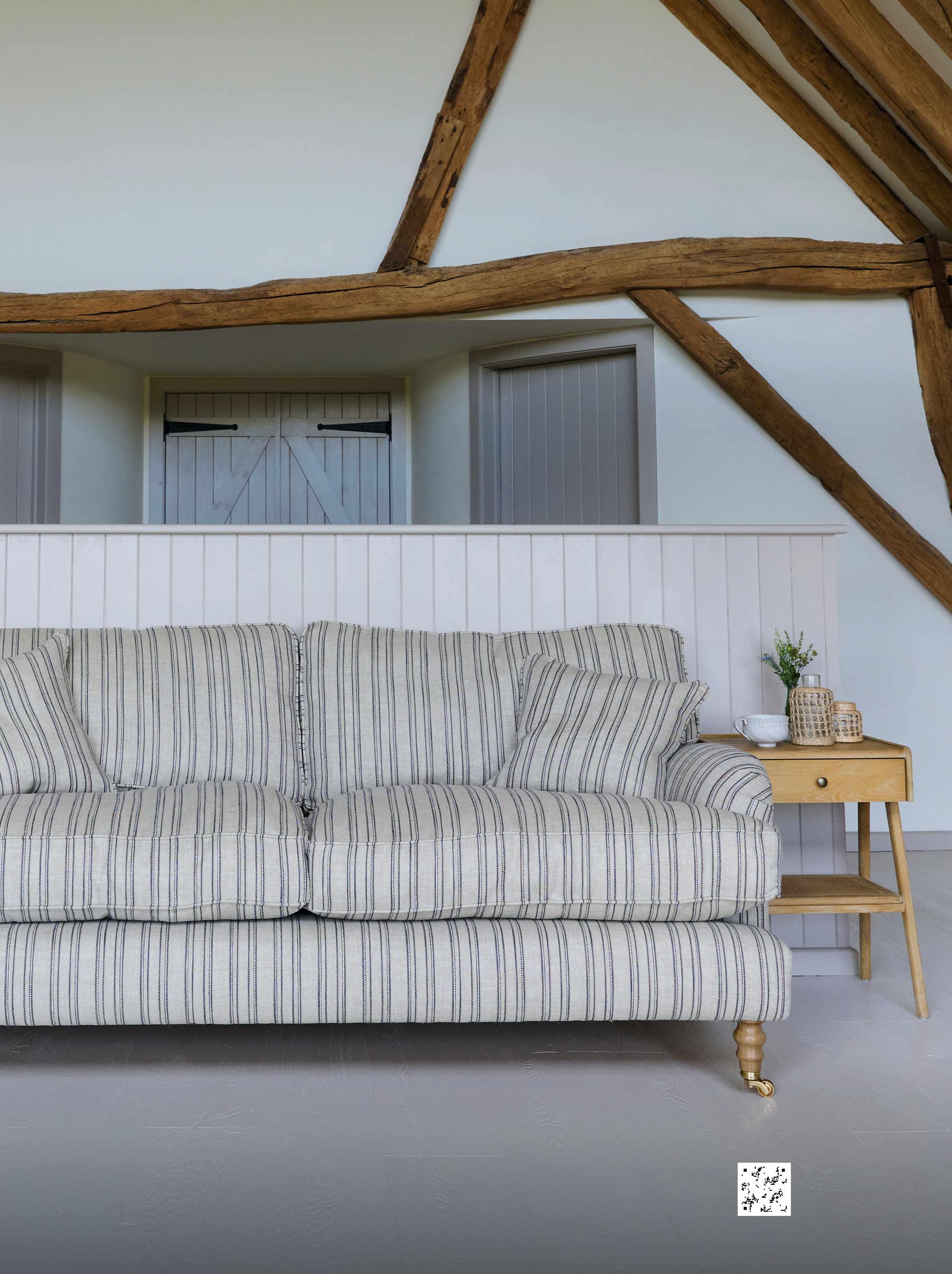GA R DENS



Plants to keep the show going into autumn
Design insights from her planting portfolio
Updating a small garden for year-round interest
Boomerang bulbs
Expert picks of perennial tulips that come back each year
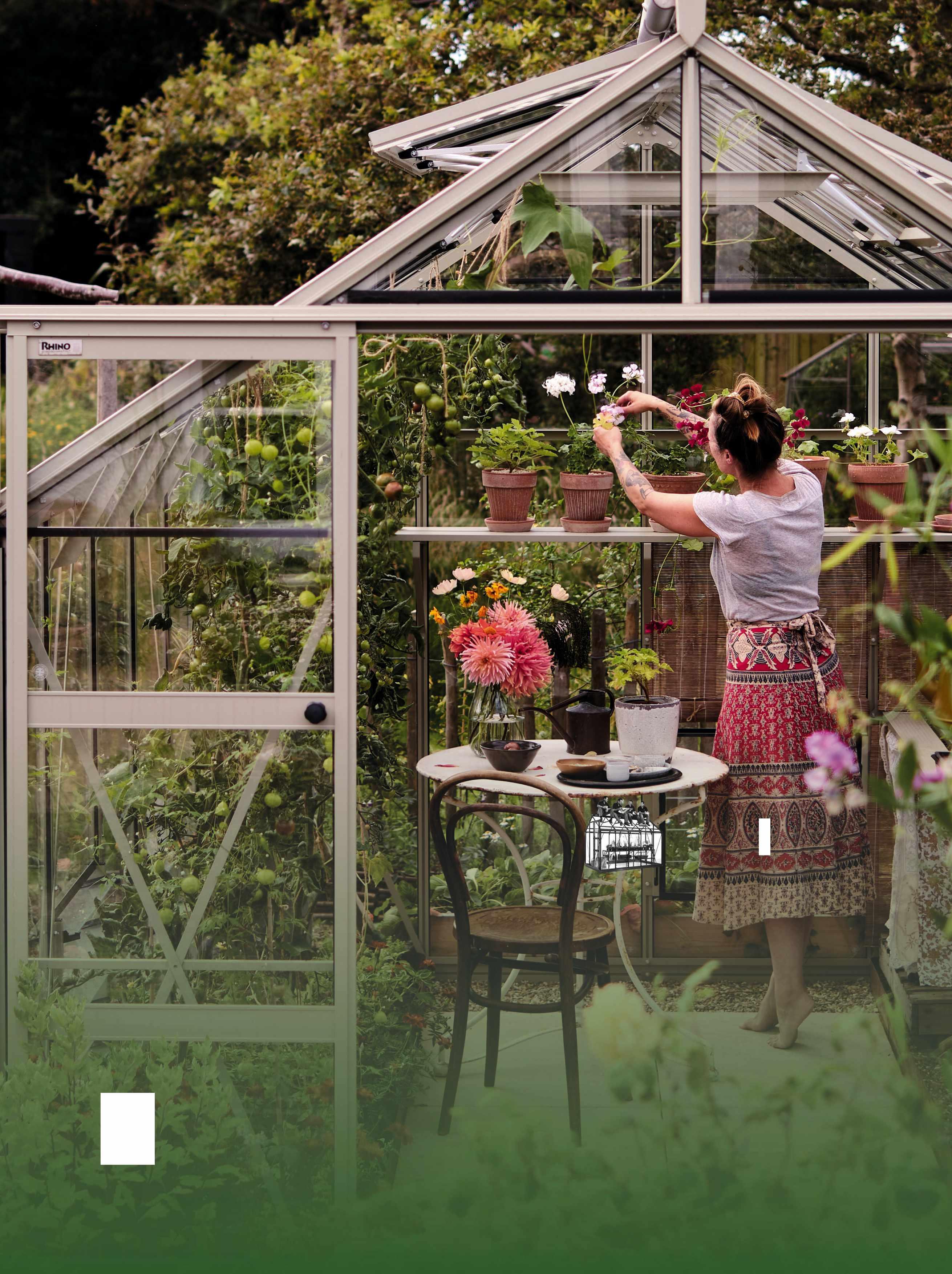

Autumn has crept in behind our backs as we were enjoying the last of the warmth and light of an Indian summer, but at this time of the year there is still plenty to excite in the garden. By using plants that flower late and long, we can keep the show going right up to the first frosts, for a grand finale, or perhaps just a brief but beautiful encore.
This issue we have plant picks from several expert plantspeople to help with this, including head gardener Åsa Gregers-Warg (page 20), nurseryman Neil Lucas (page 40) and plantsman Dr John Grimshaw (page 54). There’s inspiration from our featured seasonal gardens at Corsley House (page 30) and The Manor at Hemingford Grey (page 68) too.
Also this month, we discover which tulips and other perennial spring bulbs will come back reliably (page 76) and present our curated selection to buy (page 83). Jinny Blom offers analysis of three planting schemes from her portfolio (page 62) and we visit small designer gardens that have been simply but brilliantly updated in London (page 48) and Antwerp (page 94), plus an extraordinary project in the Australian wilderness created to withstand sun, wind and fire (page 84).
All this plus columnists Alice Vincent on gardening and motherhood (page 114) and Ken Thompson on good bad plants (page 25), as well as interviews with designer Marie-Louise Agius (page 52) and Royal Parks gardener Jay Rathod (page 39) – the growing season may be winding up, but we still have a bumper issue of great gardening ideas and advice for you to enjoy.




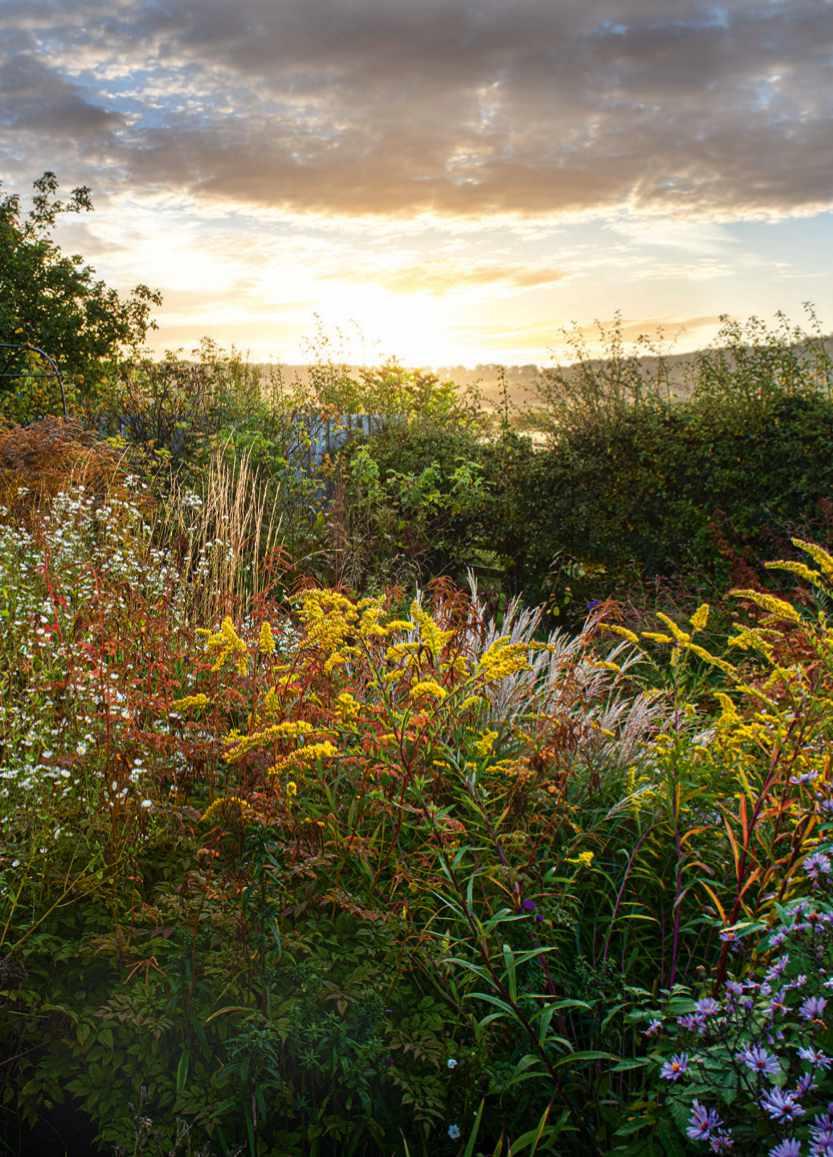
30 Naturalaffinity A relaxed, biodiverse-rich approach has given a neglected garden in rural Wiltshire a new lease of life
48 Lightandshade In this small, split-level garden, designer Stefano Marinaz has offset new planting with richly toned hard landscaping
54 Autumnshimmer Botanist Dr John Grimshaw experiments with rare species and cultivars among the layers of lush herbaceous planting in his private garden near York
68 Patchworkofcolour A historic garden in Cambridgeshire upholds the artistic spirit of its creator – the novelist and needlewoman Lucy M Boston
84 Senseofplace Designer Kathleen Murphy’s restrained planting connects a minimalist dwelling with the wider landscape in rural Australia
20 Plantsperson’sfavourites
Åsa Gregers-Warg, head gardener at Beth Chatto’s Plants & Gardens, selects her top ten plants for October
40 Plantprofile: Miscanthus Neil Lucas recommends the best of these robust and long-lived ornamental grasses
62 Plants make a garden
Designer Jinny Blom offers advice on creating good planting schemes
76 Boomerang bulbs Experts pick reliably perennial tulips, plus other beautiful spring bulbs
83 Readeroffer Get 15% off a curated selection of organic bulbs
39 Gardeningtalent Meet Jay Rathod, apprentice with the Royal Parks in London
52 Who’swho Designer MarieLouise Agius on working in harmony with the landscape
114 New beginnings Alice Vincent learns how to garden, and how to share her outdoor space, with her new baby
93 Designnews A public courtyard garden within a hotel complex in Cambridge, landscaped by Robert Myers Associates
94 High times Roof garden designers Bart Haverkamp and Pieter Croes create a cosy terrace 20 floors up in Antwerp
99 Sourcebook Nine of the best tree benches
3 Welcome 6 Contributors
9 Digin Apple Day celebrations, a new UK botanic garden accreditation and cautionary thoughts on AI in the garden
17 Kitted out For enjoying cosy autumn bonfires
25 Goodbadplants Columnist Ken Thompson sees the good in plants with bad reputations
28 Subscriptionoffer Save when you subscribe to the digital edition of Gardens Illustrated
103 Bookreviews From a Victorian botanical travelogue to murder in the garden
109 Crossword and back issues
113 Next issue What’s coming up in our November issue
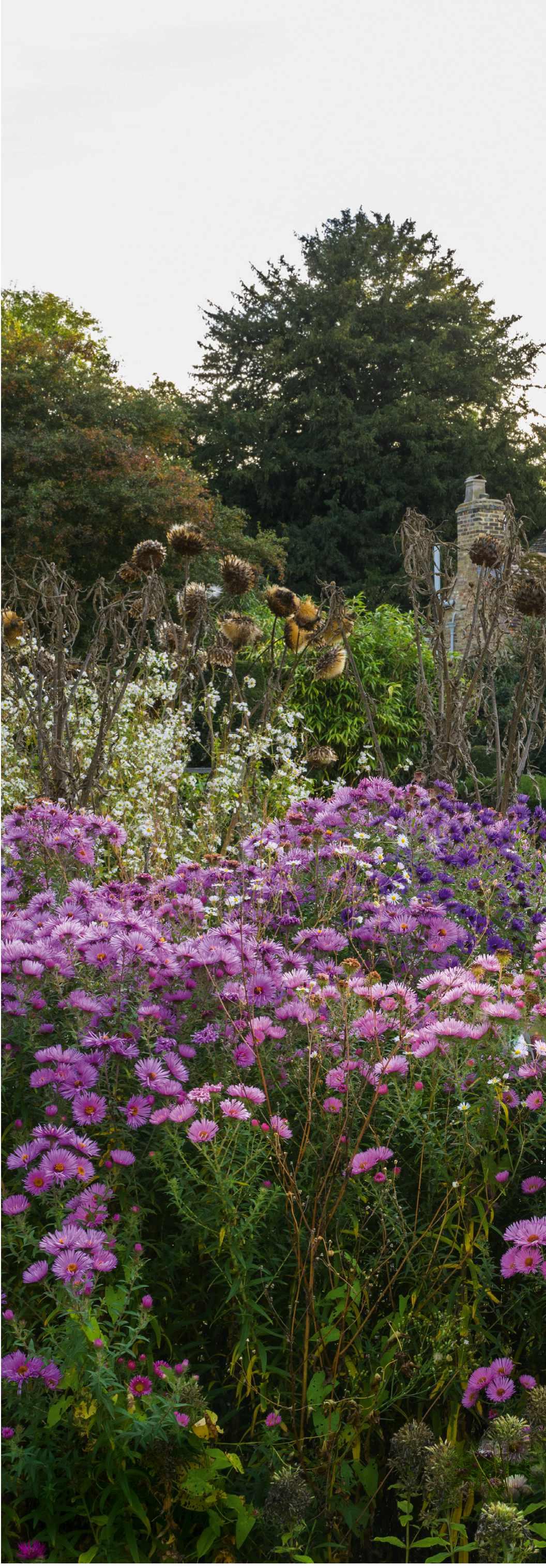
Explore the romantic gardens created by the late painter, patchwork creator and author of the Green Knowe children’s books, Lucy M Boston, page 68.
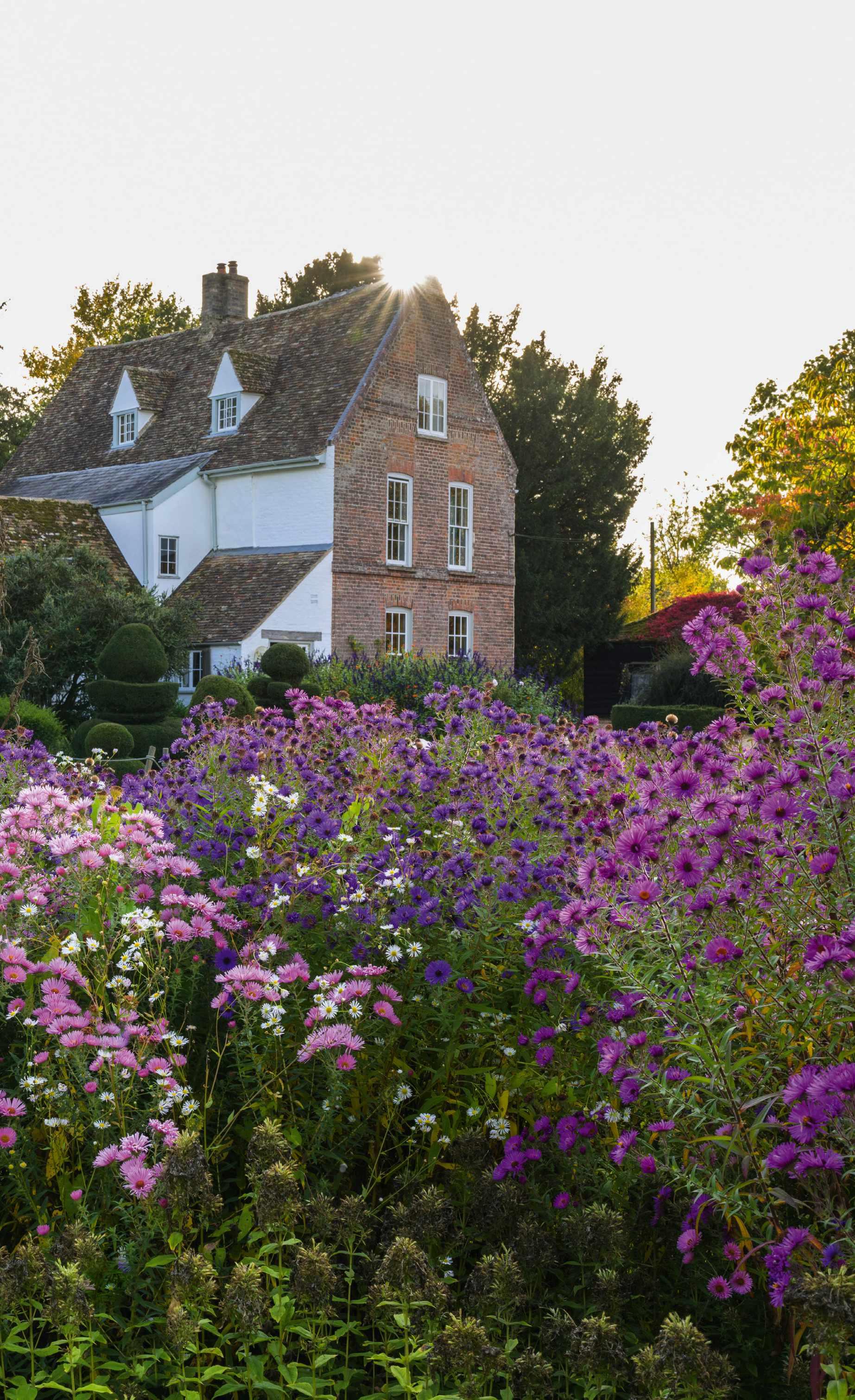
take out a digital subscription to Gardens Illustrated
SEE PAGE 28
Small London garden designed by Stefano Marinaz, photograph by Alister Thorpe (page 48)
Grand finale, pages 20, 40 and 54
Little gem, page 48
Jinny Blom, page 62
Boomerang bulbs, page 76
Organic Bulbs offer†, page 83
• Save 30% on our 2023 Masterclass series of online talks when you book all three – page 12
• Save money when you subscribe to the digital edition of Gardens Illustrated – page 28
• Save 15% on a selection of organic, spring-flowering perennial bulbs curated by award-winning designers Lulu Urquhart and Adam Hunt† – page 83
† Bulb offer available only to readers in the UK, excluding Northern Ireland
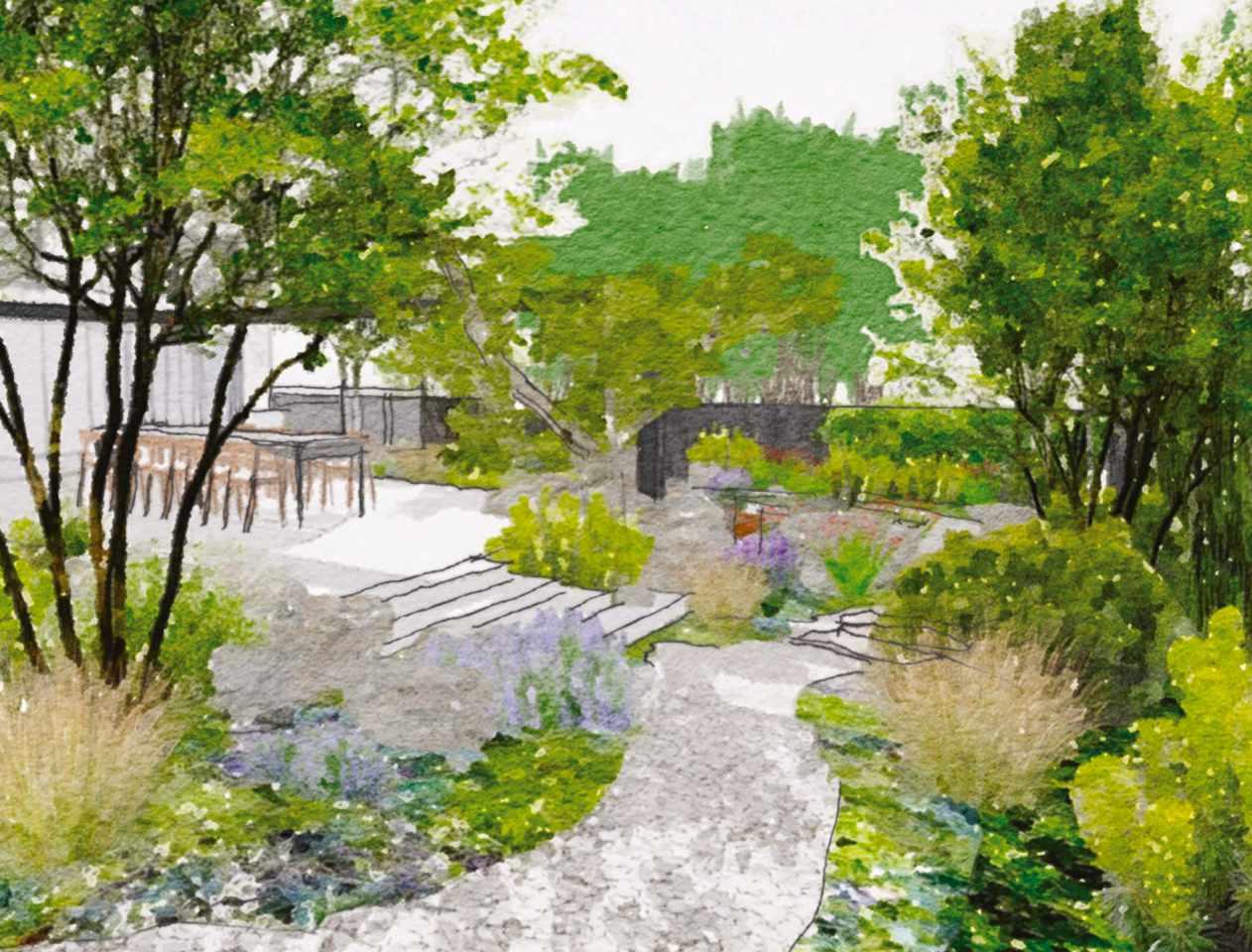
Findoutmoreaboutourinspirational designtrainingatRoyalBotanic GardensKew,RHSGardenWisley andonline.
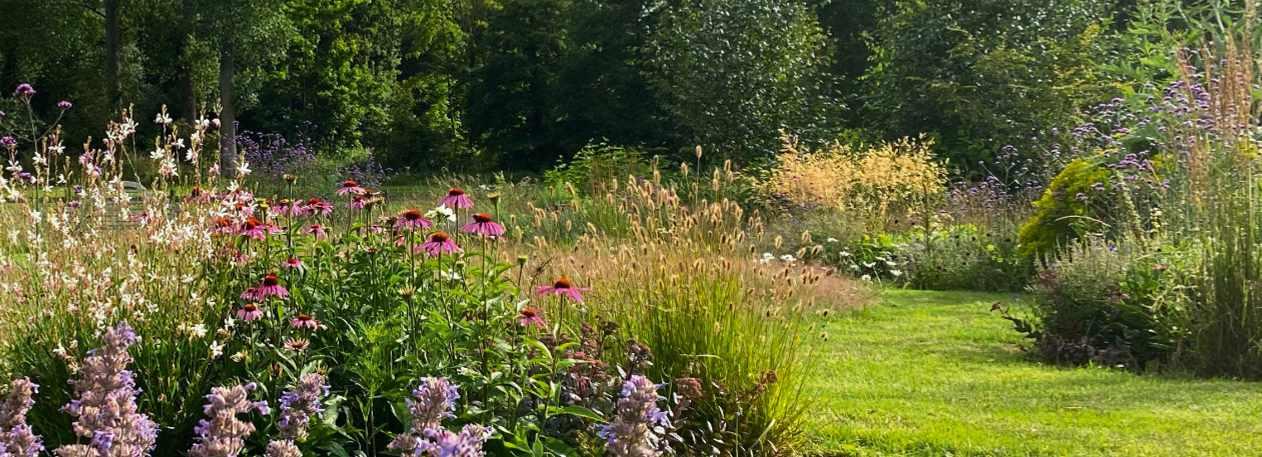
OurDiplomaandotherprofessional developmentprogrammesaredelivered fromourhomeinRoyalBotanicGardens Kewwithareal-time,onlineoptionfor thosewishingtostudywithusfrom home.In2023wealsohavean expandedshortcourseprogrammefor professionalsandgardenenthusiastsat allourtrainingcentresandonline.
Visitourwebsite lcgd.org.uk toseehow ourstudentsarecreatingsuccessful gardendesigncareersanddiscovera coursethatisrightforyou.

Neil Lucas Grass expert Neil recommends the best Miscanthus, page 40. “Miscanthus is a hugely useful group of grasses for our gardens, with autumn perhaps being their absolute peak of interest.”

Anna Omiotek-Tott
Anna photographs the garden made by the late author and needlewoman Lucy M Boston, page 68. “Such a treat to be in this enchanted place where nature meets history.”

Samantha van Egmond
Samantha visits an Australian garden, page 84. “It’s inspiring when a garden embraces its natural setting so beautifully, allowing it to soften into the wider landscape.”






Charlotte Harris
Charlotte co-founded the values-driven landscape design practice Harris Bugg Studio with Hugo Bugg in 2017. She has won three Gold medals at the RHS Chelsea Flower Show, as well as Best Show Garden in 2023.
Fergus Garrett
Fergus was appointed head gardener at Great Dixter by Christopher Lloyd in 1993 and is now the garden’s CEO. He was awarded an RHS Associate of Honour in 2008 and an RHS Victoria Medal of Honour in 2019.
James Basson
James lives in the South of France where he runs Scape Design, a practice for creating sustainable landscapes. The winner of four Chelsea Gold medals, he was awarded Best Show Garden in 2017.
Anna Pavord
Anna was The Independent’s gardening correspondent for 30 years and is the author of the bestselling book The Tulip. In 2000 the RHS awarded her the Veitch Memorial Medal. She lives and gardens in Dorset.
Dan Pearson
Dan is one of the UK’s best-known garden designers. Among his many award-winning gardens is the Tokachi Millennium Forest in Japan. He was awarded an OBE in the 2022 New Year Honours for services to horticulture.
Sarah Price
Sarah is one of the UK’s most sought-after garden designers. She won Gold at Chelsea in 2012, 2018 and 2023, and was GMG Garden Columnist of the Year in 2016 for her design series in Gardens Illustrated
+44(0)1483762955info@lcgd.org.uk
Subscription enquiries and back issues
UK 03330 162114
USA/CANADA 1 888-941-5623 (TOLL-FREE)
REST OF THE WORLD +44 1604 973722
EMAIL gardensillustrated@ourmediashop.com
UK/REST OF THE WORLD Gardens Illustrated, PO Box 3320, 3 Queensbridge, Northampton NN4 7BF.
USA/CANADA Gardens Illustrated, Immediate Media PO Box 40, Williamsport, PA 17703 USA.
Advertising enquiries
+44 (0)117 300 8547 rebecca.janyshiwksyj@ourmedia.co.uk
Editorial enquiries
+44 (0)117 300 8622 gardens@gardensillustrated.com
Gardens Illustrated, Our Media Ltd (an Immediate Group Company), Eagle House, Bristol BS1 4ST.
Syndication & Licensing
Gardens Illustrated is available for licensing and syndication. +44 (0)117 300 8787, emma.brunt@ourmedia.co.uk
App support
For App support please visit ourmediaapps.co.uk/digital-contact-form/
We abide by IPSO’s rules and regulations. To give feedback about our magazines, please visit ourmedia.co.uk, email editorialcomplaints@immediate.co.uk or write to Katherine Conlon, Our Media Ltd (an Immediate Group Company), Eagle House, Bristol BS1 4ST.

adviser Dr James Compton
Thanks this issue Hilary Brown
ADVERTISING
Sales director Laura Jones 0117 300 8509 laura.jones@ourmedia.co.uk
Advertising manager Rebecca Janyshiwskyj 0117 300 8547 rebecca.janyshiwksyj@ourmedia.co.uk
Commercial brand lead Tiffany Jackson 0117 300 8023 tiffany.jackson@ourmedia.co.uk
Advertising designer Parvin Sepehr
INSERTS
Laurence Robertson +353 (0)876 902208
CIRCULATION, MARKETING, PROMOTIONS, PRESS & PR
Newstrade manager John Lawton
Subscriptions director Jacky Perales-Morris
Direct marketing manager Aimee Rhymer
Buyer Karen Flannigan
PR & Outreach Manager for Comms Emma Cooney emma.cooney@ourmedia.co.uk
MANAGEMENT
Chief executive officer Tom Bureau
Group managing director Our Media Andy Marshall
Managing director Our Media Andrew Davies
Head of brand marketing and brand lead Rosa Sherwood
SYNDICATION & LICENSING
Director of licensing & syndication Tim Hudson
PRODUCTION
Production director Sarah Powell
Group production manager Louisa Molter
Production co-ordinator Lauren Morris




The tap that does it all
100°C BOILING, CHILLED AND SPARKLING WATER
With a Quooker in your kitchen you always have 100°C boiling water alongside regular hot and cold. Add a CUBE and you will also have chilled, filtered sparkling water – all from the same tap. Interested? Book a virtual experience with a Quooker expert. You control the appointment and what you see. For our latest offers and to book your appointment, scan the QR code or visit quooker.co.uk
You can find plenty more events to enjoy by going to our online diary. Scan this QR code with your phone camera or go to gardensillustrated.com/ events
What’s new, what’s growing and what’s going on this month
NEWS COMPILED BY MOLLY BLAIR
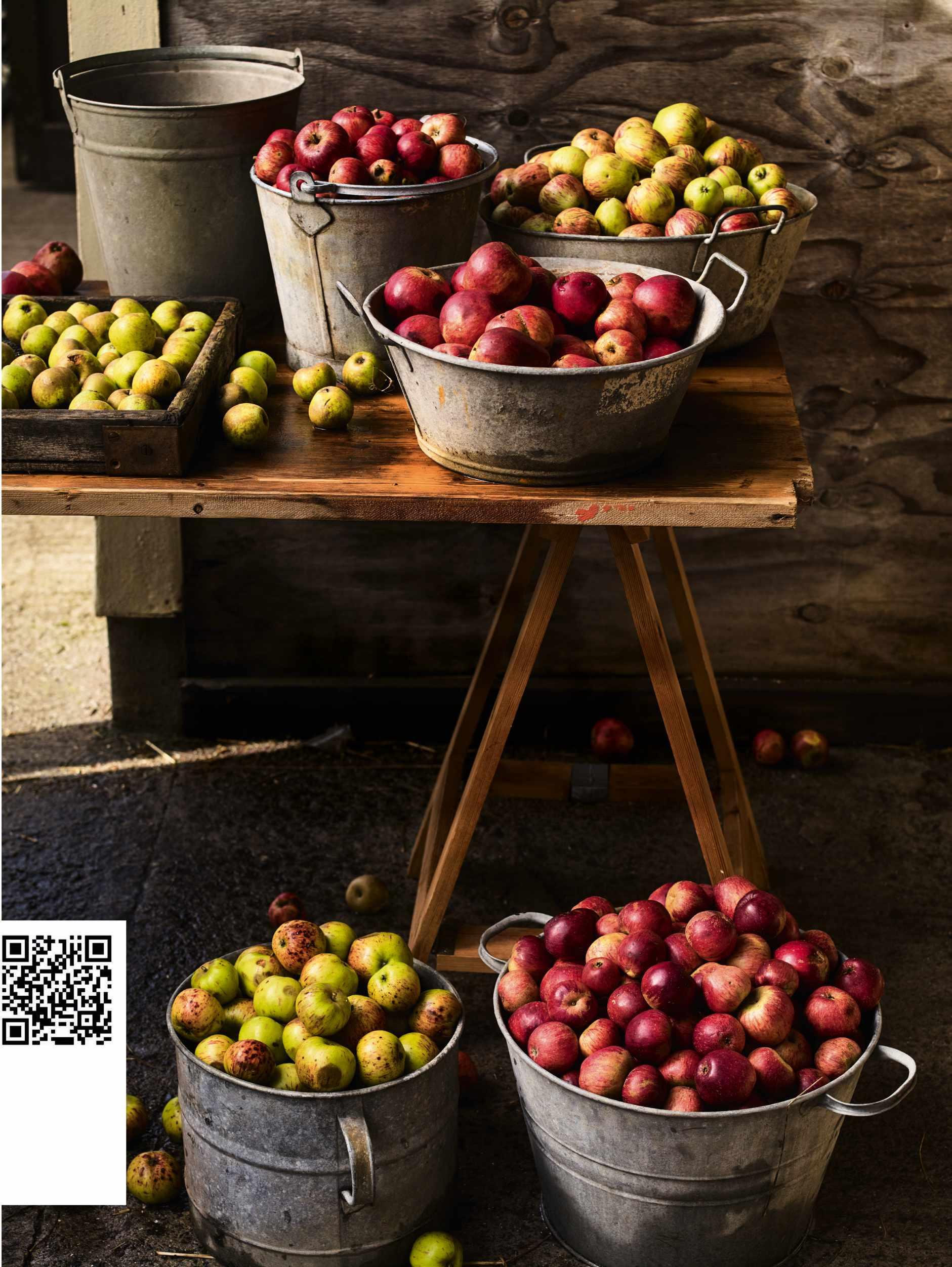
On 21 October, we mark Apple Day, a celebration of the fruit’s diversity and heritage. It’s a great opportunity to bring together friends and family to enjoy all that autumn has to offer. From apple bobbing and block printing with apples, to making toffee apples and mulled cider, there are lots of ways to celebrate. For inspiration, head to gardensillustrated.com/appleday
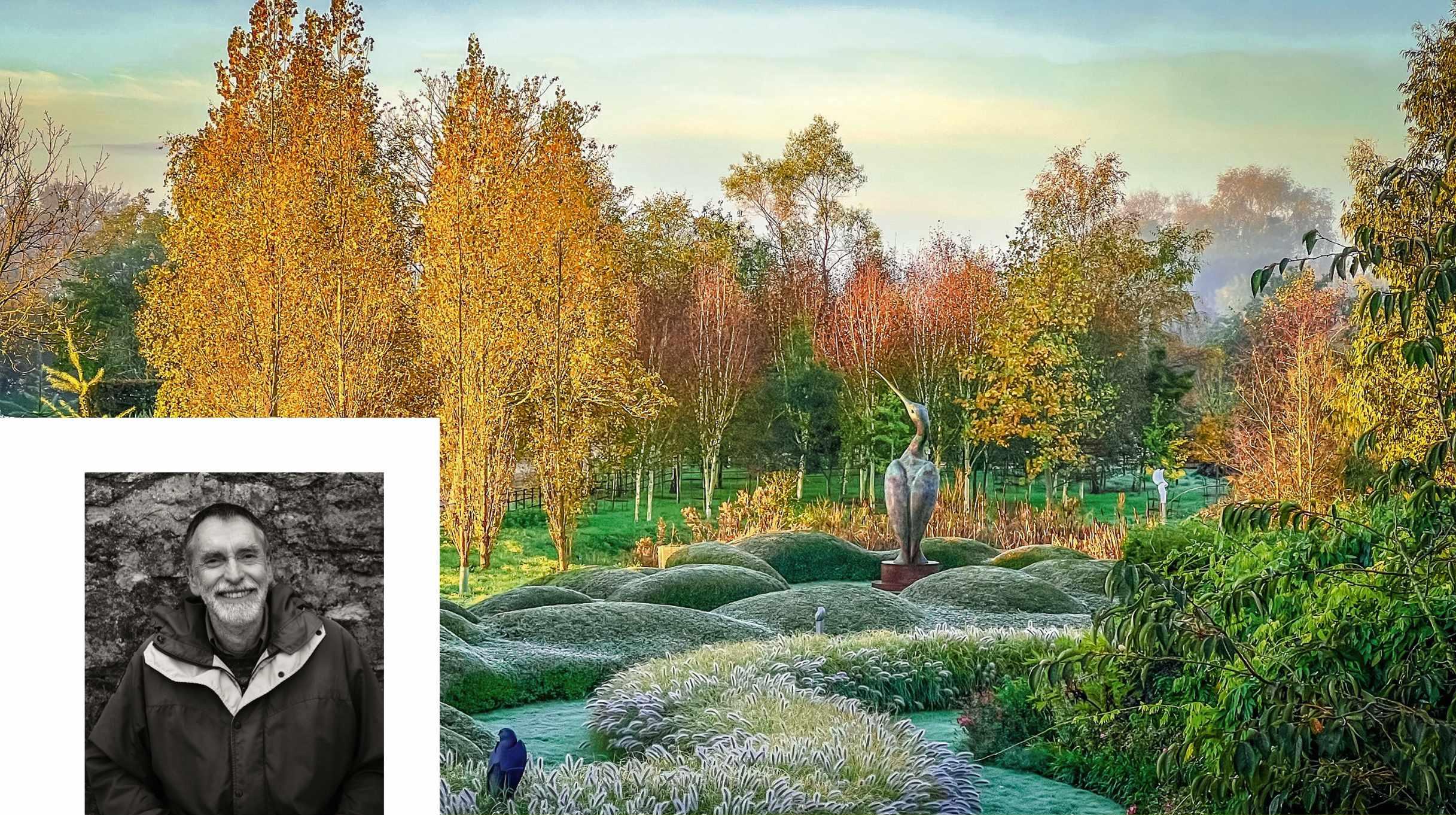
There is much talk about the advent of AI in many areas of our lives, and while you may think that it is hardly likely to have much effect on gardening, ecologist Ken Thompson suggests otherwise. Potential consequences of using AI and robots in our gardens include the need to simplify our outdoor spaces to accommodate their limitations.“Robots won’t be quite as clever as we would like them to be,” said Ken, and may not be able to distinguish between different plants. It may also affect health by reducing human-nature interactions. “Even if you spend as much time in your garden, I’m not sure it’s doing you much good if all you’re doing is reclining with a G&T while your pet robot is doing all the hard work.”
Scan below to read Ken’s piece at gardensillustrated.com/robots

Sculpture by the Lakes in Dorset has become the UK’s eighth accredited botanic garden after achieving official Botanic Garden Status. Botanic Gardens Conservation International (BGCI) recognises gardens that conform to the highest international standards and make significant contributions to plant conservation, sustainability and public engagement.
Among its achievements, Sculpture by the Lakes has a comprehensive collection of critically endangered conifers, including Picea koyamae – there are fewer than 1,000 specimens of this Japanese tree left growing in the wild. The garden is also home to a grove of Sequoia sempervirens, which originate in northwest USA and are under threat from urbanisation and logging.
According to Monique Gudgeon, the garden’s director: “The accreditation recognises many years of hard work in making our gardens the best they can be, and proves that Sculpture by the Lakes serves its purpose as a true asset to nature and the environment.”
To read more about the accreditation, visit gardensillustrated.com/botanicgarden
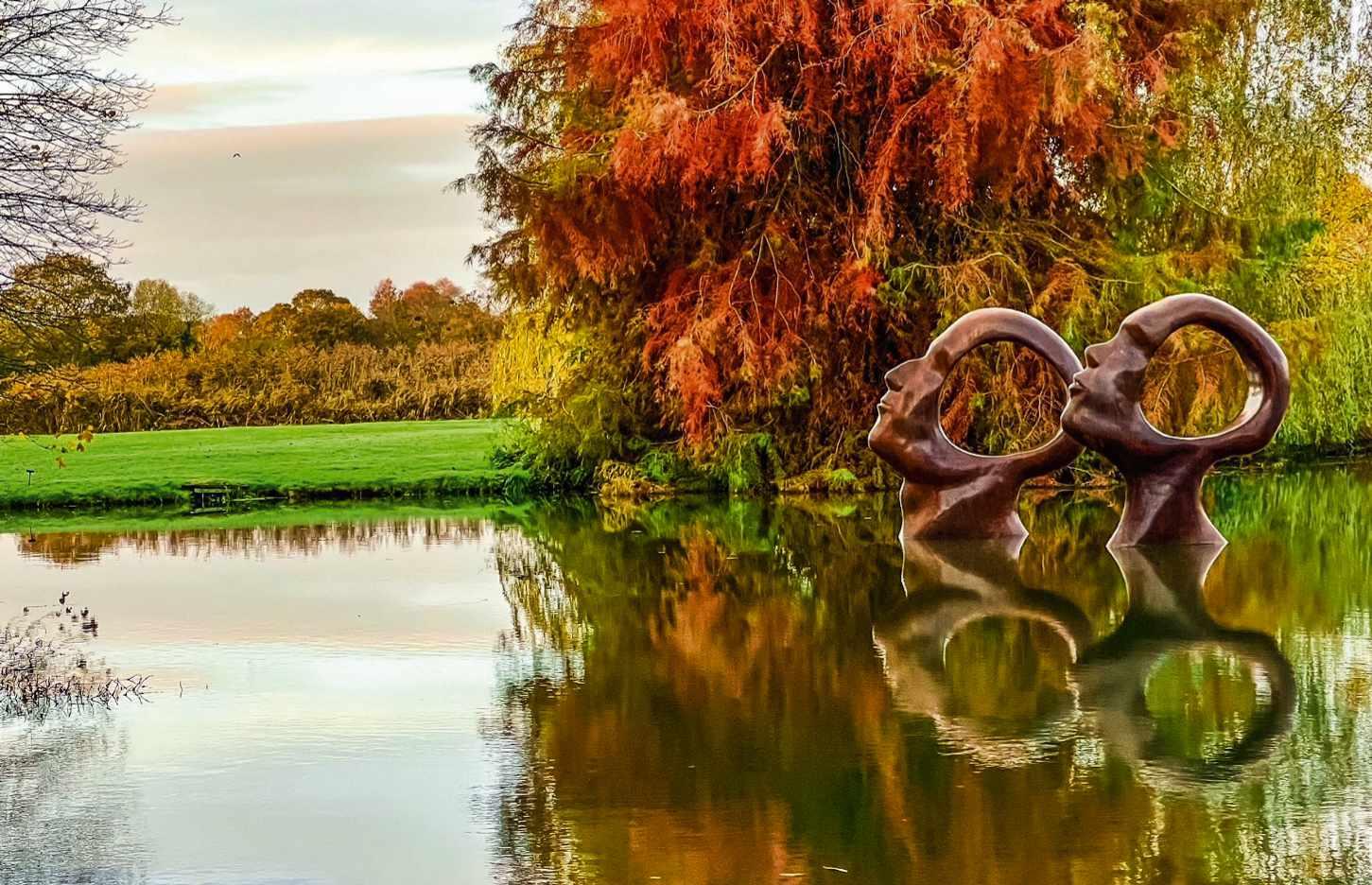
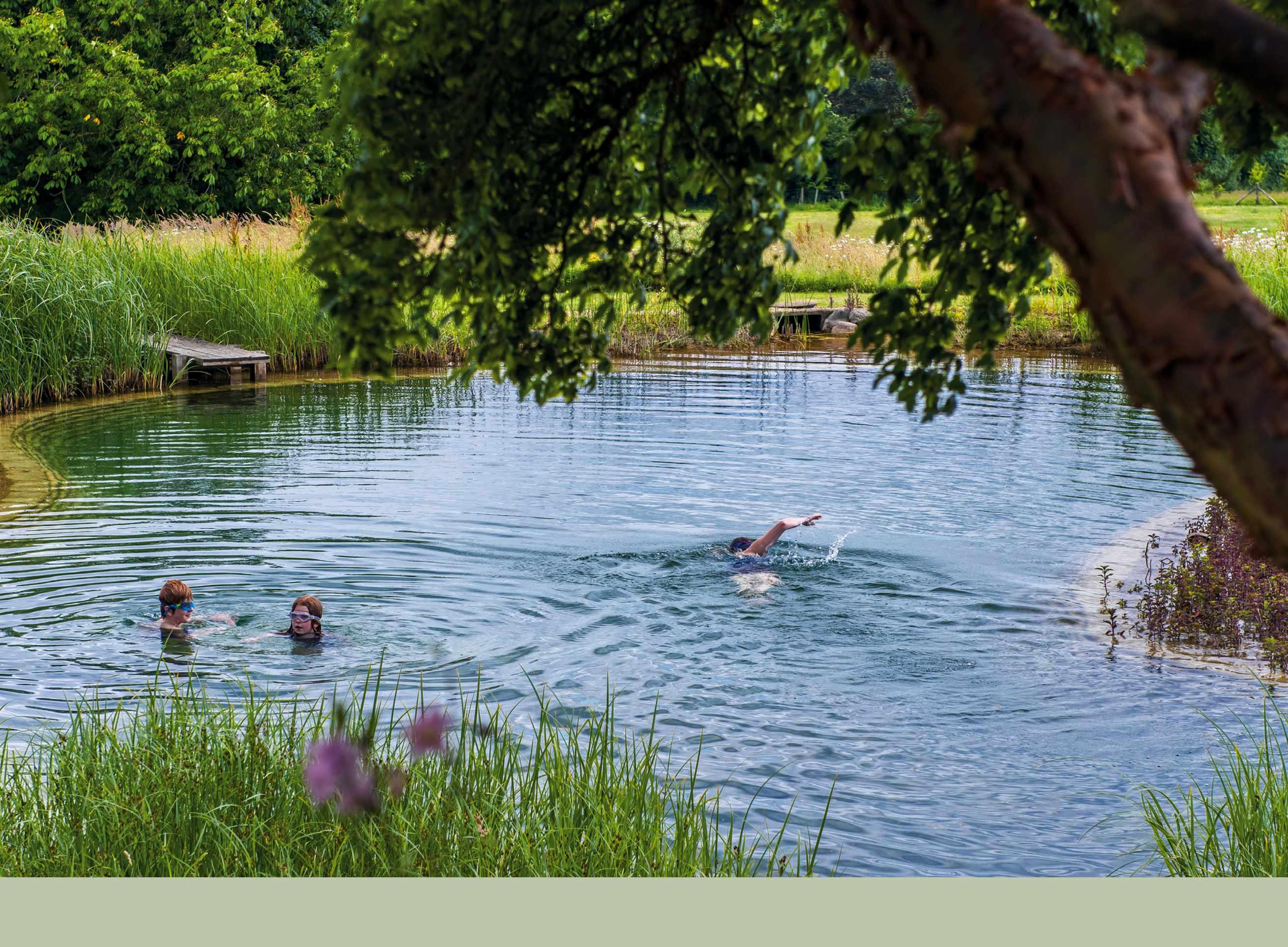
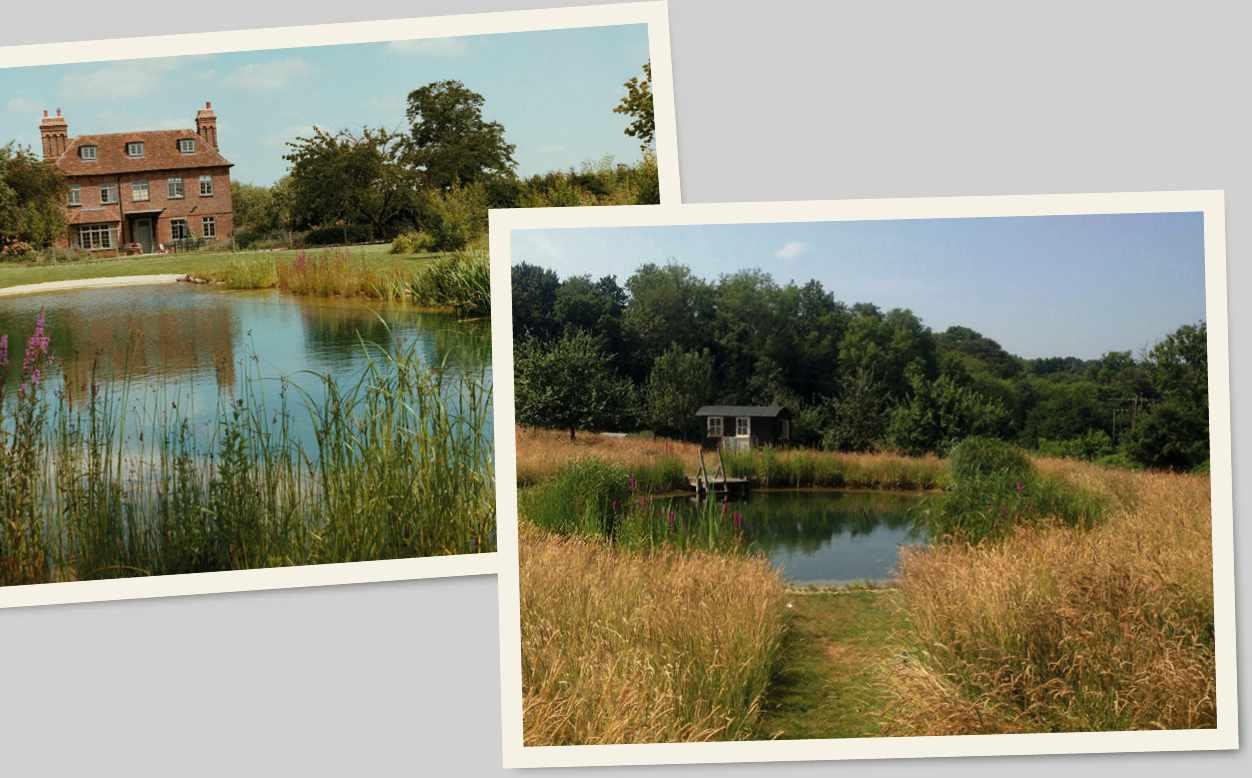
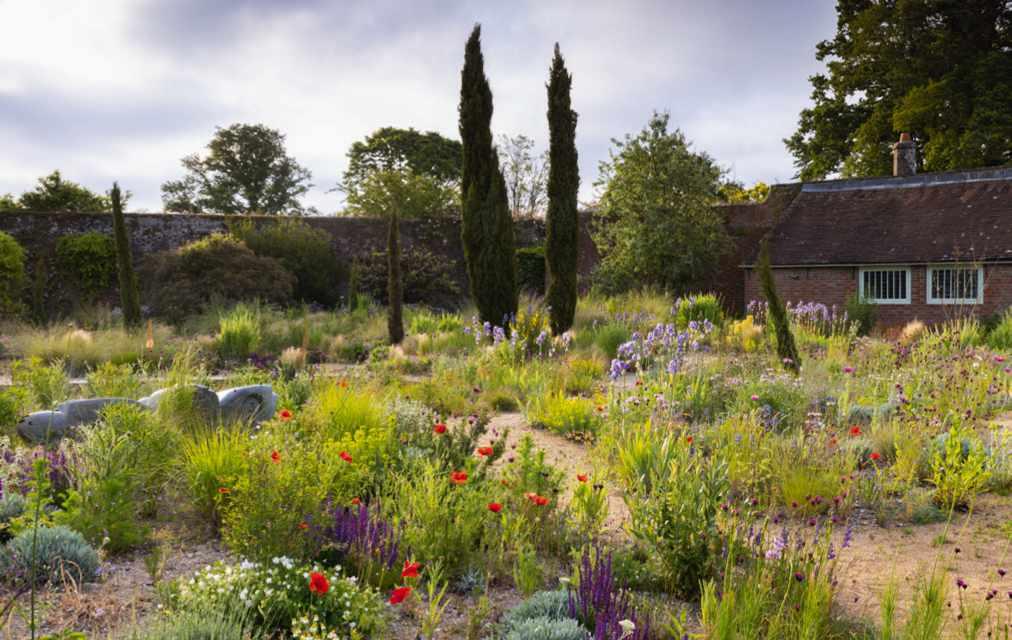


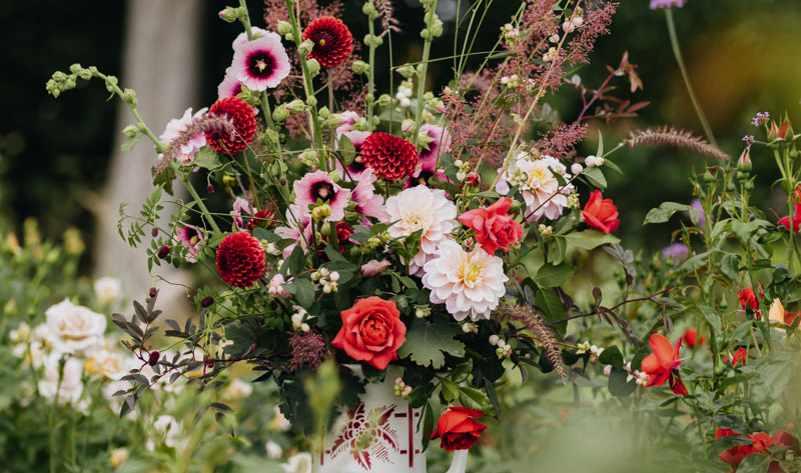

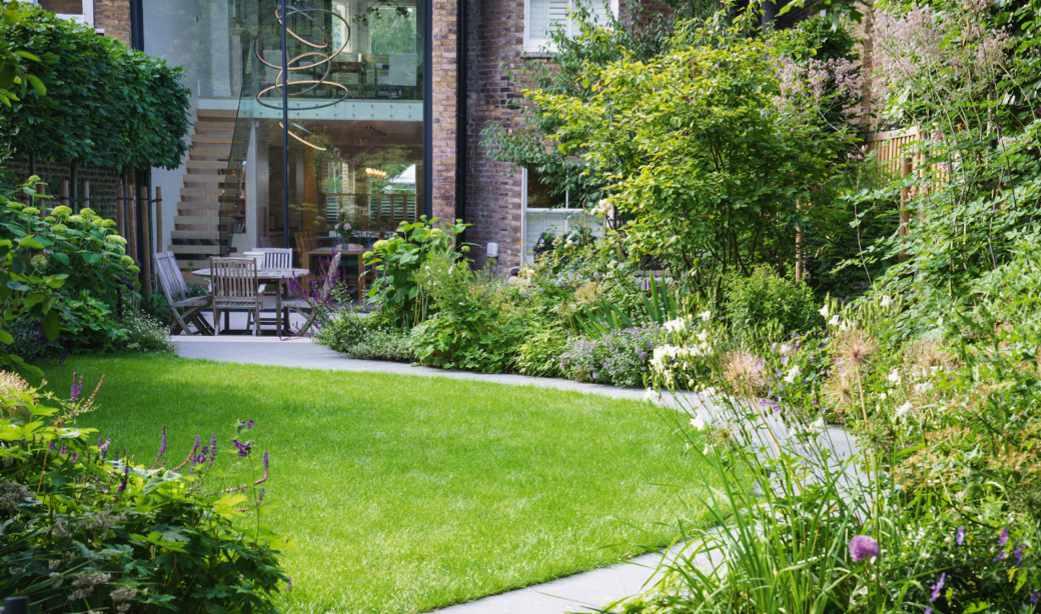

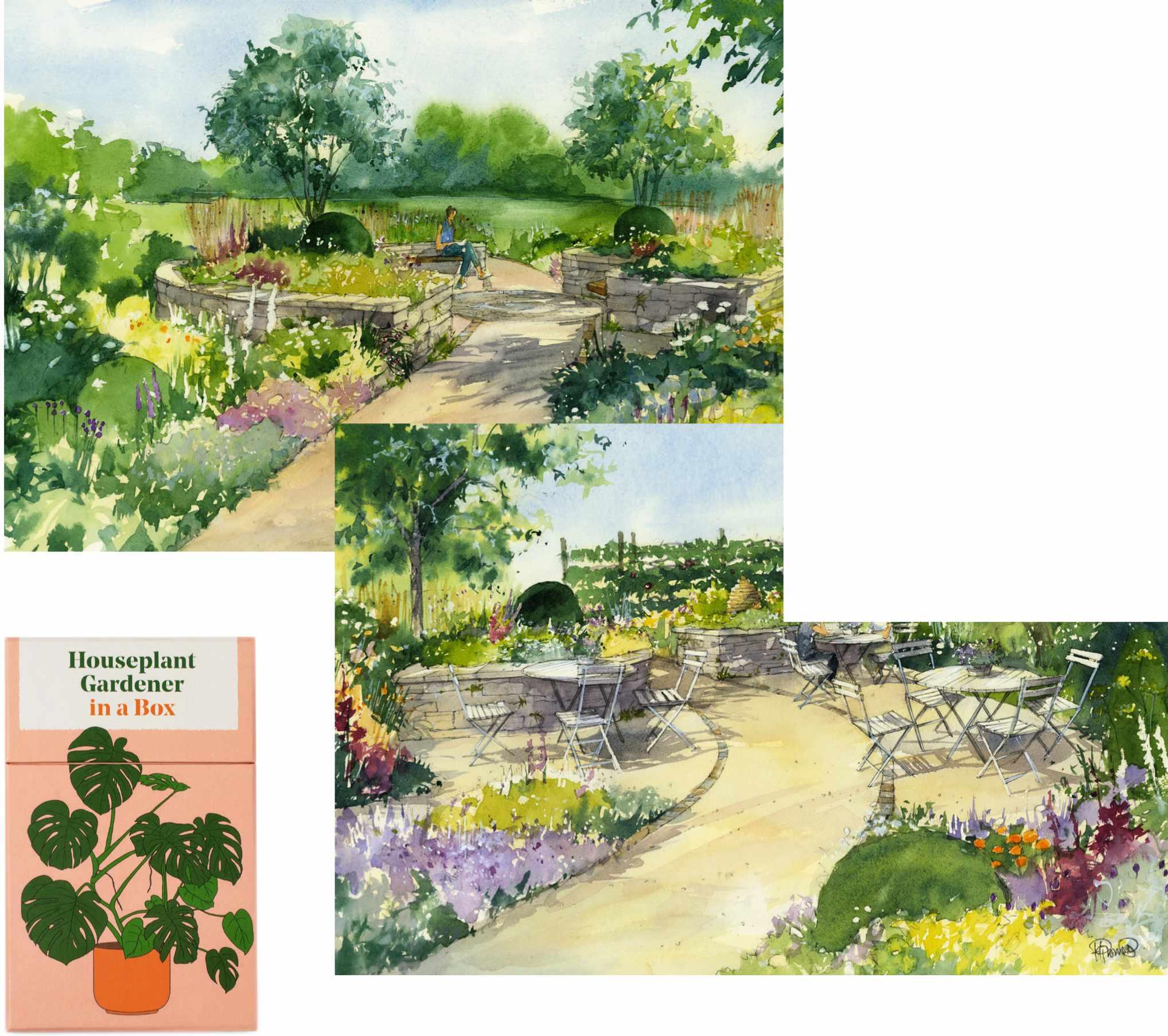
A new public garden at Treborth Botanic Garden in north Wales is to celebrate Welsh heritage and the folklore surrounding medicinal plants. The Welsh Herbal Garden, designed by Rutland-based Nicola Oakey and set to open in spring 2024, will take inspiration from the landscape and use local materials to tell the story of how people in Wales have used plants since the 12th century to treat ailments, from the use of distilled water of red roses for toothache to bruised saffron as a sobering tonic. Treborth Botanic Garden, which is a part of Bangor University, is open every day during daylight hours and is free to visit. For more information, head to treborth.bangor.ac.uk
Happy houseplants Houseplant expert Jane Perrone has produced a handy go-to guide for caring for a range of common houseplants. Houseplant Gardener in a Box features 60 illustrated cards with all the tips and tricks needed to help them thrive. Available from 11 October, the set costs £19.99.

7
An Introduction to Garden History in Ten Objects Visit the Garden Museum for an interactive talk on garden history. Saturday 7 October, 10am-3pm, £50. 5 Lambeth Palace Road, London SE1 7LB. Tel 020 7401 8865, gardenmuseum.org.uk

13-14
Queer Nature After Hours Gain exclusive access to Kew’s Queer Nature exhibition. Friday 13, Saturday 14, Friday 20 and Saturday 21 October, 6.30-10.30pm. £17. Royal Botanic Gardens, Kew, Richmond, London TW9 3AE. Tel 020 8332 5655, kew.org
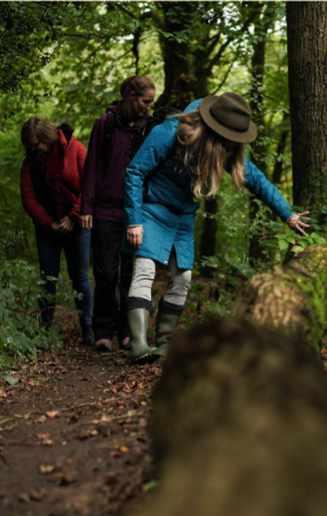
18
Forest Bathing and Mindful Photography Join Tansy Dowman and Paul Sander at Hever Castle for this forest bathing and photography workshop. Wednesday 18 October, 10am-2pm. £75. Hever Castle & Gardens, Hever, Kent TN8 7NG. hevercastle.co.uk
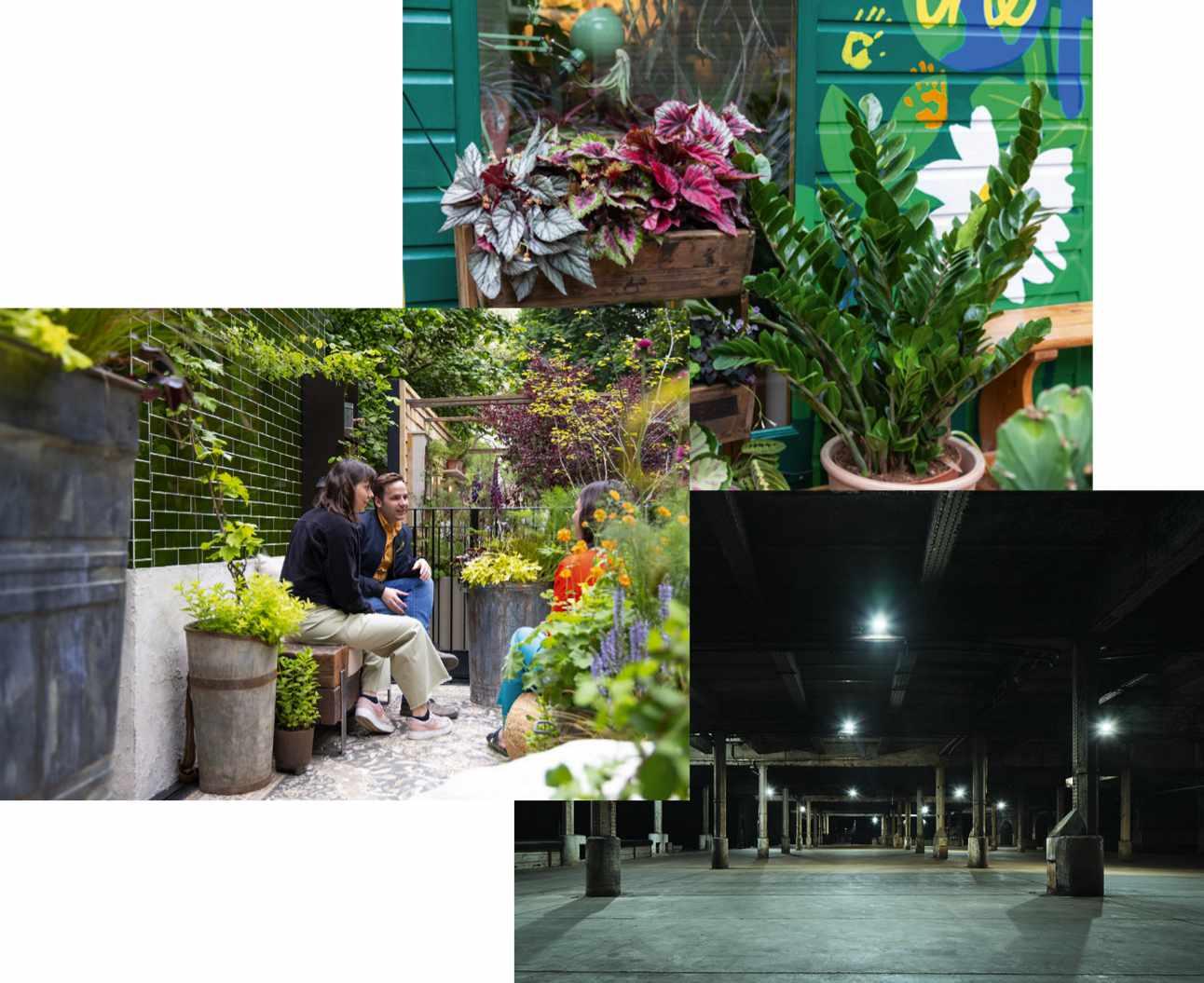
The Royal Horticultural Society is to launch an exciting new indoor gardening show in central Manchester in April 2024. The RHS Urban Show will take place in the city’s historic former railway station, Depot Mayfield, transforming the vast industrial space into an urban growing oasis packed with inspiration for city dwellers, and focusing on the connection between horticulture, wellbeing and sustainable living. Tickets for all RHS shows for 2024 are on sale now at rhs.org.uk/shows-events
PODCAST Talking Gardens, the Gardens Illustrated podcast, returns this month with fresh guests discussing their dream gardens, including food writer and keen gardener Nigel Slater and designer Piet Oudolf. New episodes drop each Tuesday from 17 October. Find out more at gardensillustrated.com/podcasts

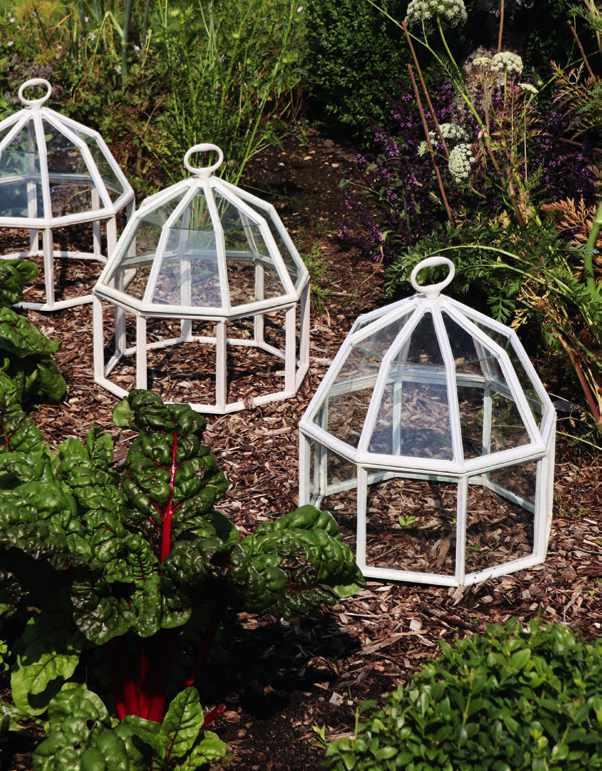
As the cooler months roll in, it’s time to start thinking about protecting tender plants in the garden. Claverton Cloches has launched a new design perfect for the job. Based on a rare antique shape that has not been produced since the Victorian era, the Victorian Octagonal Cloche is glazed with 24 panes of glass in an intricate, eight-sided, cast-iron frame, and will provide architectural interest in any garden. The new cloche costs £380 and can be purchased at clavertoncloches.com


Whalley, anthracite, £215, Lanx, lanxshoes.com


To discover more great options for gardening footwear, scan this QR code with your phone camera, or visit gardensillustrated. com/bestshoes
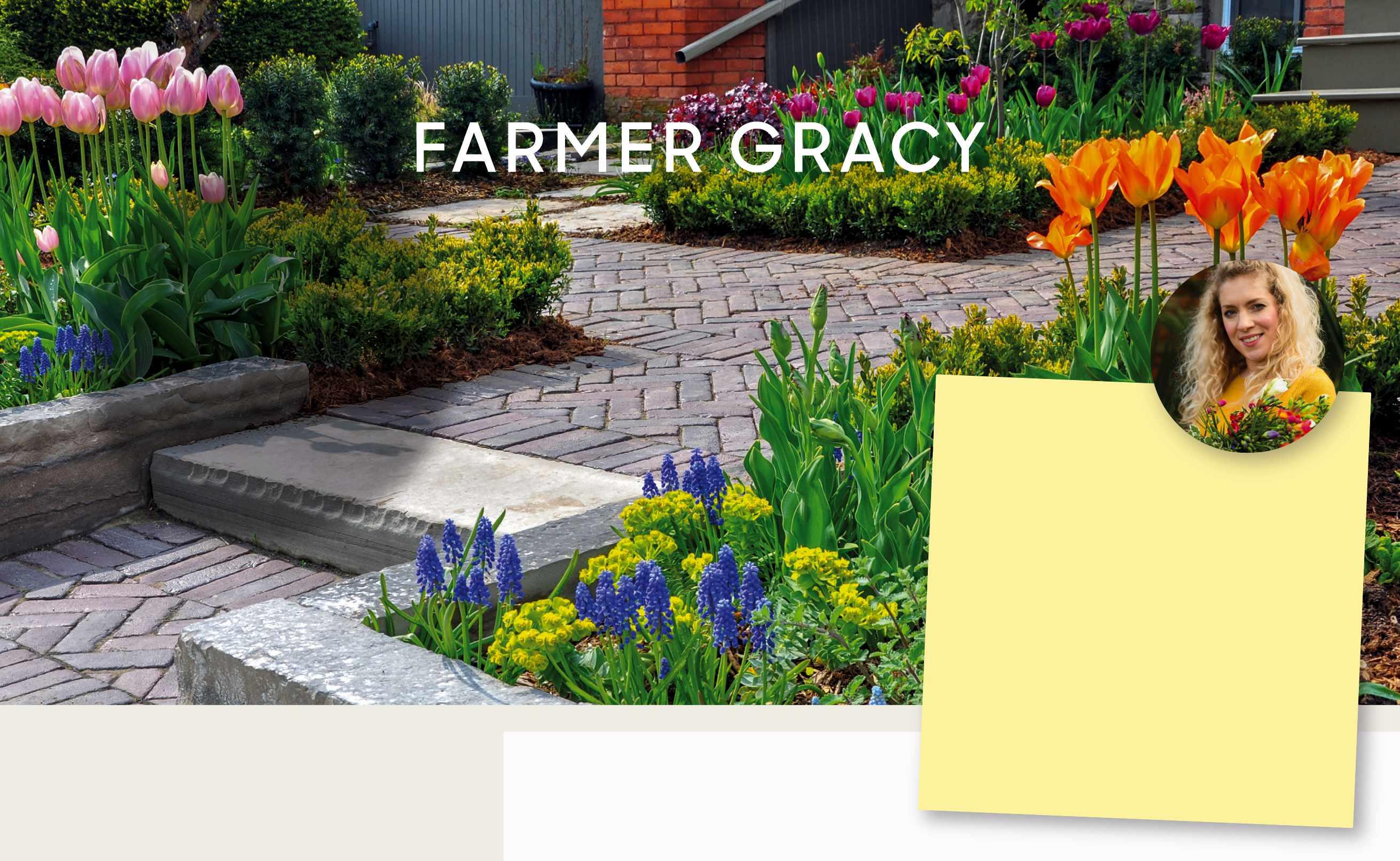


September 2023 – beg July 2024 BOOKING NOW
Covers the best in planting design while training in the more serious aspects of horticultural techniques. Practical sessions held at Arundel Castle under the guidance of head gardener Martin Duncan and at Sandhill Farm House, Rogate. Lectures by many leading gardening personalities and regular visits to outstanding private gardens. Students also learn to draw up planting plans. (1 day a week (Tues), 10.30am–3.15pm, over three terms)
GARDENING FOR BEGINNERS
4 days Wednesday & Thursday 17/18 April & 24/25 April 2024
One of our most popular courses, led by master horticulturist Ben Pope, which aims to take each student through all the practical elements of caring for a garden from soil, tools, maintenance, seed sowing and propagating, weed control and pests and diseases.The first 3 days will be spent with lectures at the Chelsea Physic Garden and the final day will be spent gaining practical experience in Rosemary Alexander’s much praised garden near Petersfield and another private garden nearby, where Ben is in charge. Participants will be given a chance to prune, plant, sow seeds and regular maintenance tasks will be discussed. A light lunch and refreshments will be provided daily.
THE ESSENTIAL GARDEN DESIGN
January – March 2025
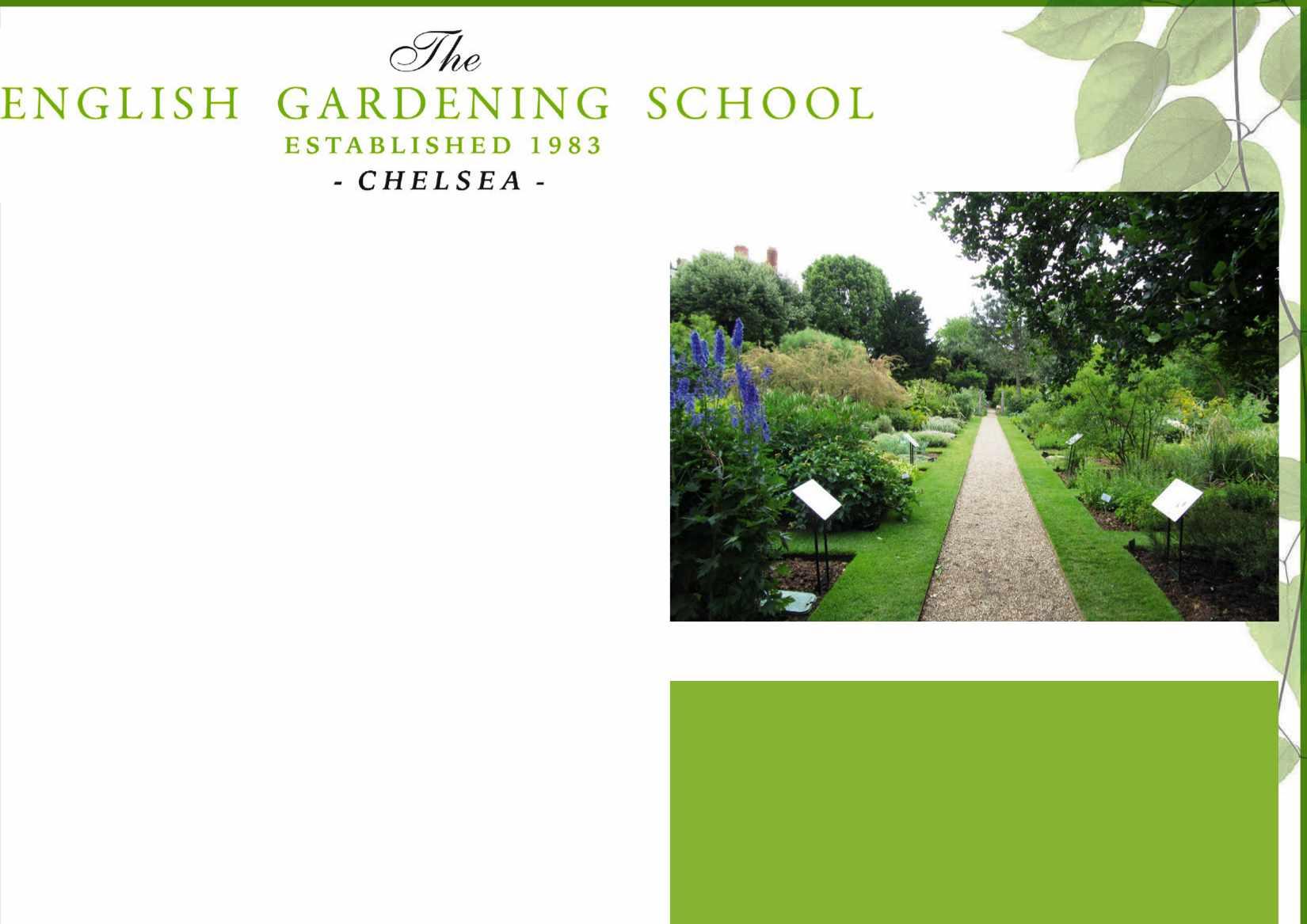
Based at the Chelsea Physic Garden and led by Rosemary Alexander and architect Catriona Rowbotham, the course is an overview of Garden Design, covering all the elements needed to rethink an average garden.Taking students step by step through site surveying, using the grid, horizontal and vertical features, garden layouts and planting plans, costing and specification, plus drawing tuition and homework on design and plant portfolios.Tutors are well respected in the industry and will guide students on how to succeed in this diverse profession. (2 days a week (Wed &Thu), 10.30am–3.15pm, plus 2 days homework)
GARDEN DESIGN & CARING FOR YOUR GARDEN
Distance Learning Courses study anytime, anywhere in the world
A stepping stone to a new career.These two correspondence courses are a step by step guide to either designing your own garden or learning how to plant and maintain an existing garden: drawing up plans, hard landscaping, site analysis, planting, month by month tasks etc.Taught through a comprehensive course book, with projects submitted to us. (1-3 years to complete and individual assessment)
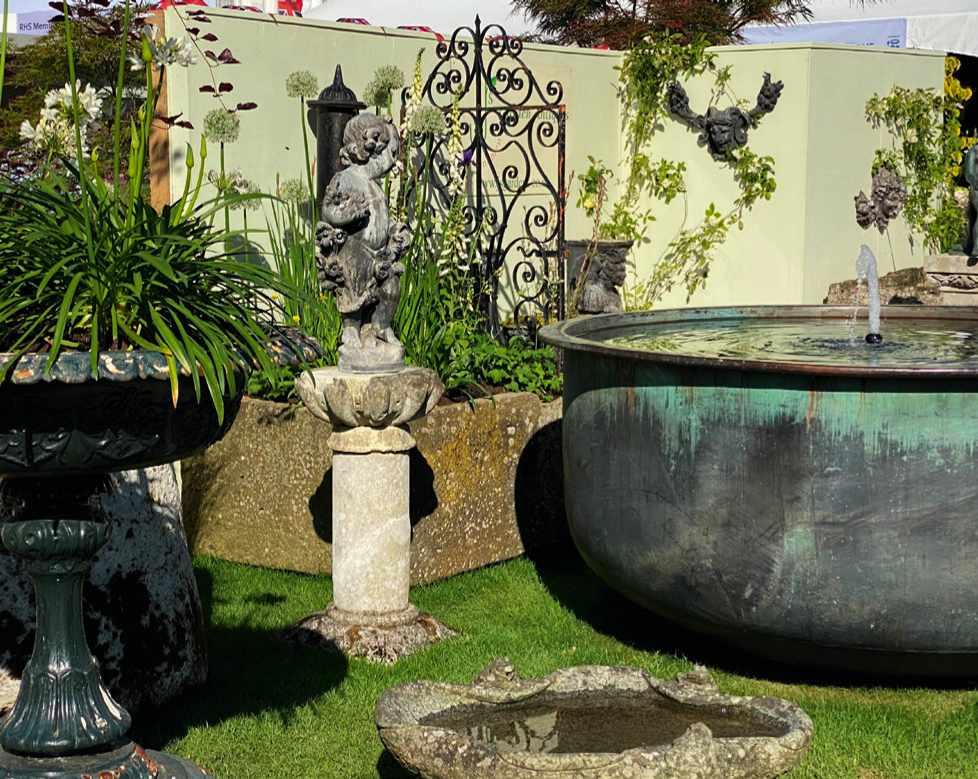

Not sure which Diploma course is for you?
We prefer potential students to attend an Information Session when Rosemary explains the course and you can see our work space.
JUST CONTACT US TO SET UP A DATE & TIME
www.englishgardeningschool.co.uk
Email: info@englishgardeningschool.co.uk Tel: 01730 818373

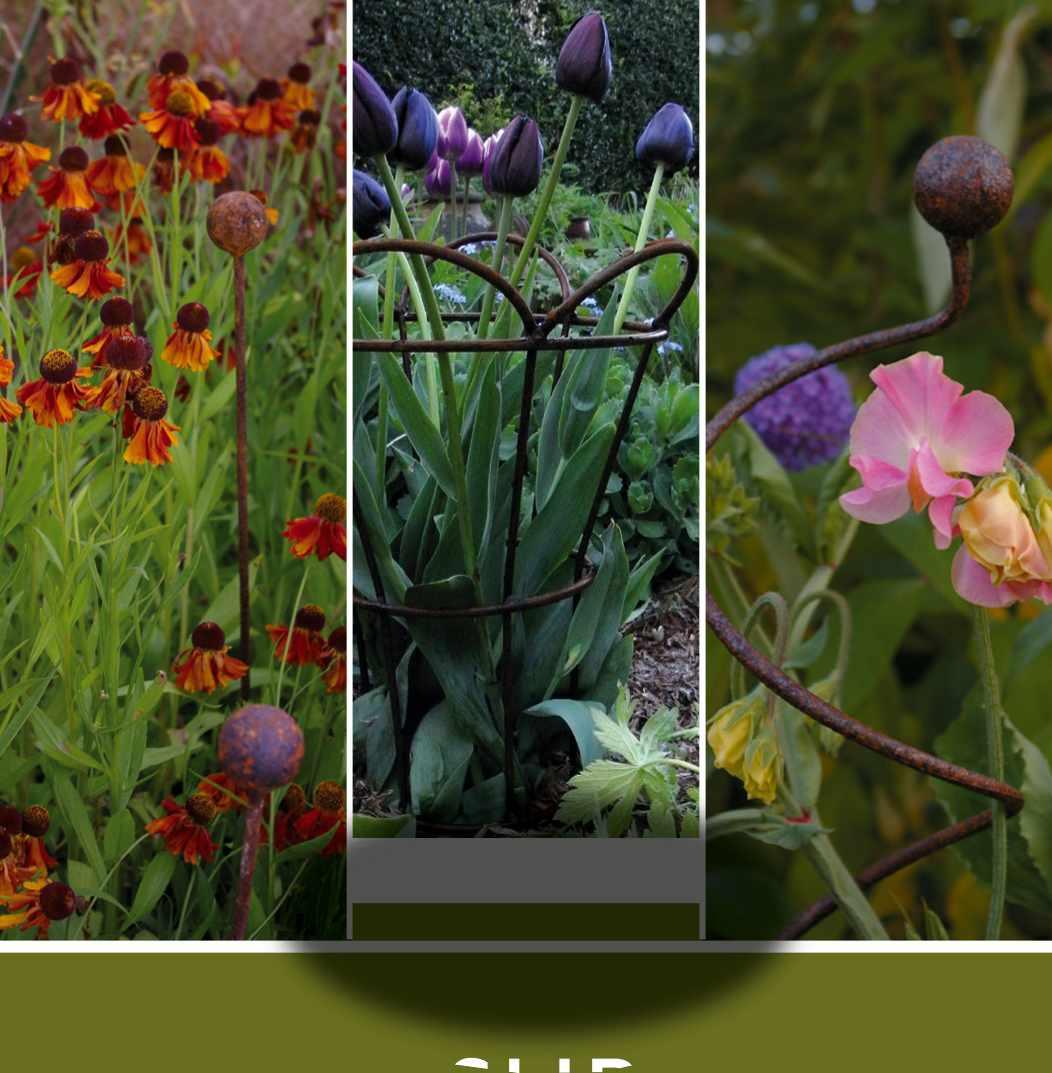

enjoying cosy autumn days outdoors COMPILED BY MOLLY BLAIR AND NIKI GOSS 1. Adirondack Chair, acacia wood, £149.99, vonhaus.com 2. Classic Edition Gourmet Marshmallow S'Mores Gift Set, £25, 01522 701630, nakedmarshmallow.co.uk 3. Ultimate 100% Dark Hot Chocolate, 300g tin, £22, 020 7734 8040, fortnumandmason.com 4. Burnished Merino Wool Oversized Blanket Scarf, £65.99, 0117 441 4412, thebritishblanketcompany.com 5. CUBE Fire Basket, rusty, £259, uk.hofats.com 6. Tramontina Churrasco BBQ Skewer, £10.99 (excl. VAT), 0117 316 5000, nisbets.co.uk 7. ProCook Double Walled Glass Coffee Cup, 270ml, set of four, £18.99, procook.co.uk 8. RB73 Corten Steel Blox Log Store, Bloxx Double Width (shown vertically), £355, 01932 850140, parkerandcoop.com



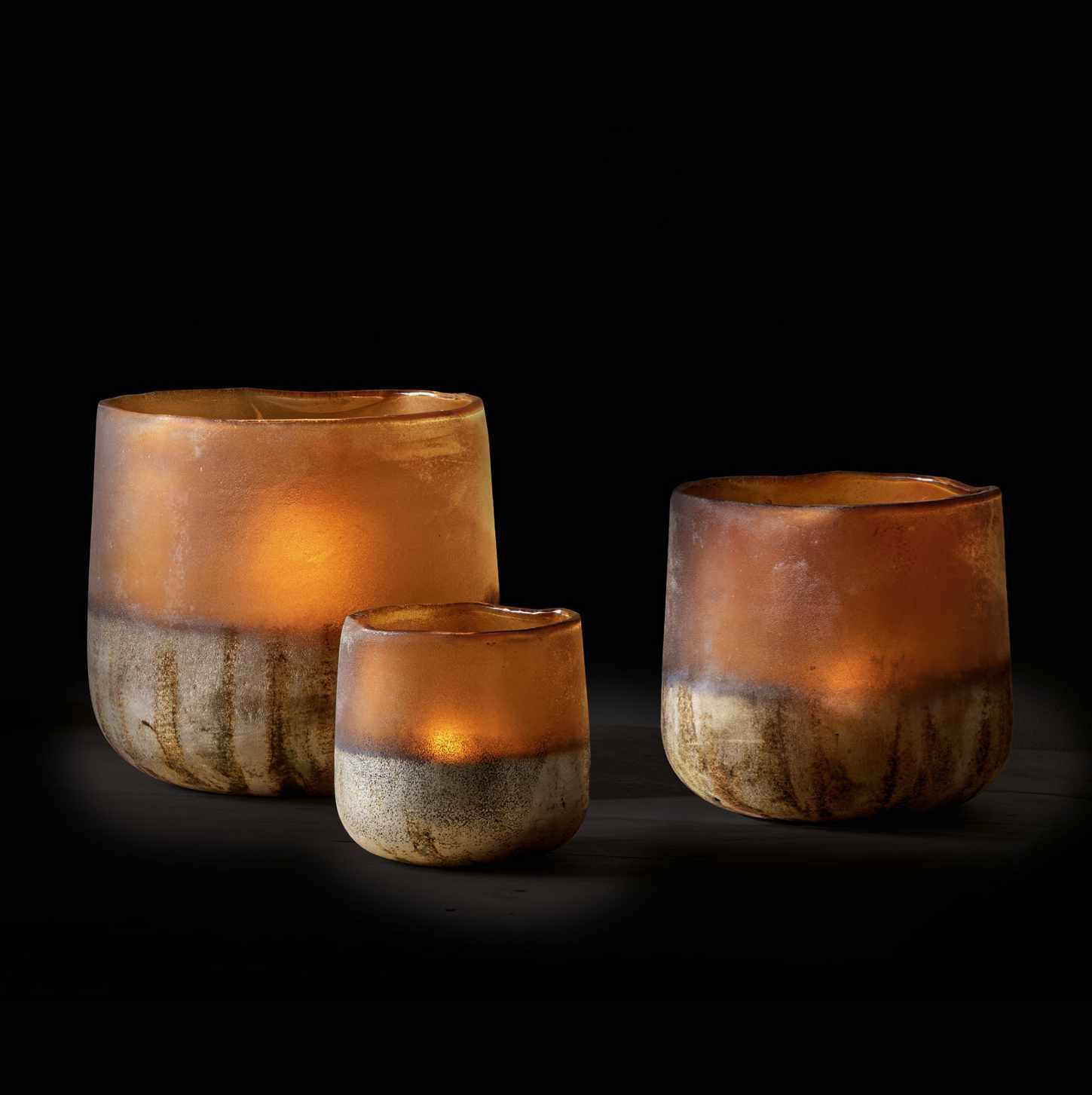


1. Ngolo Tealight Holder, antiqued amber, small 9cm, £20; medium 13cm, £35; large 16cm, £45, 0333 240 0155, nkuku.com 2. Women's Vardag Dungaree Trousers, green, reinforced knees, £185, fjallraven.com 3. Rechargeable Handwarmer, £27, 020 3617 1166, genus.gs 4. Women's Muck Originals Pull-On Ankle Boots, brown plaid print, £135, muckbootcompany.co.uk 5. Sorghum Stripe Short Handled Brush, cocoa, £30, 0333 400 5200, toa.st 6. Abrolhas Wrist Warmers, olive, £22, 01872 554481, finisterre.com 7. Waxed Canvas & Leather Handled Log Bag, £75, 01799 551813, lifeofrileyonline.co.uk

TIMELESS CLOTHING & EQUIPMENT TO CARRY YOU THROUGH THE SEASONS carriercompany.co.uk always made in the uk
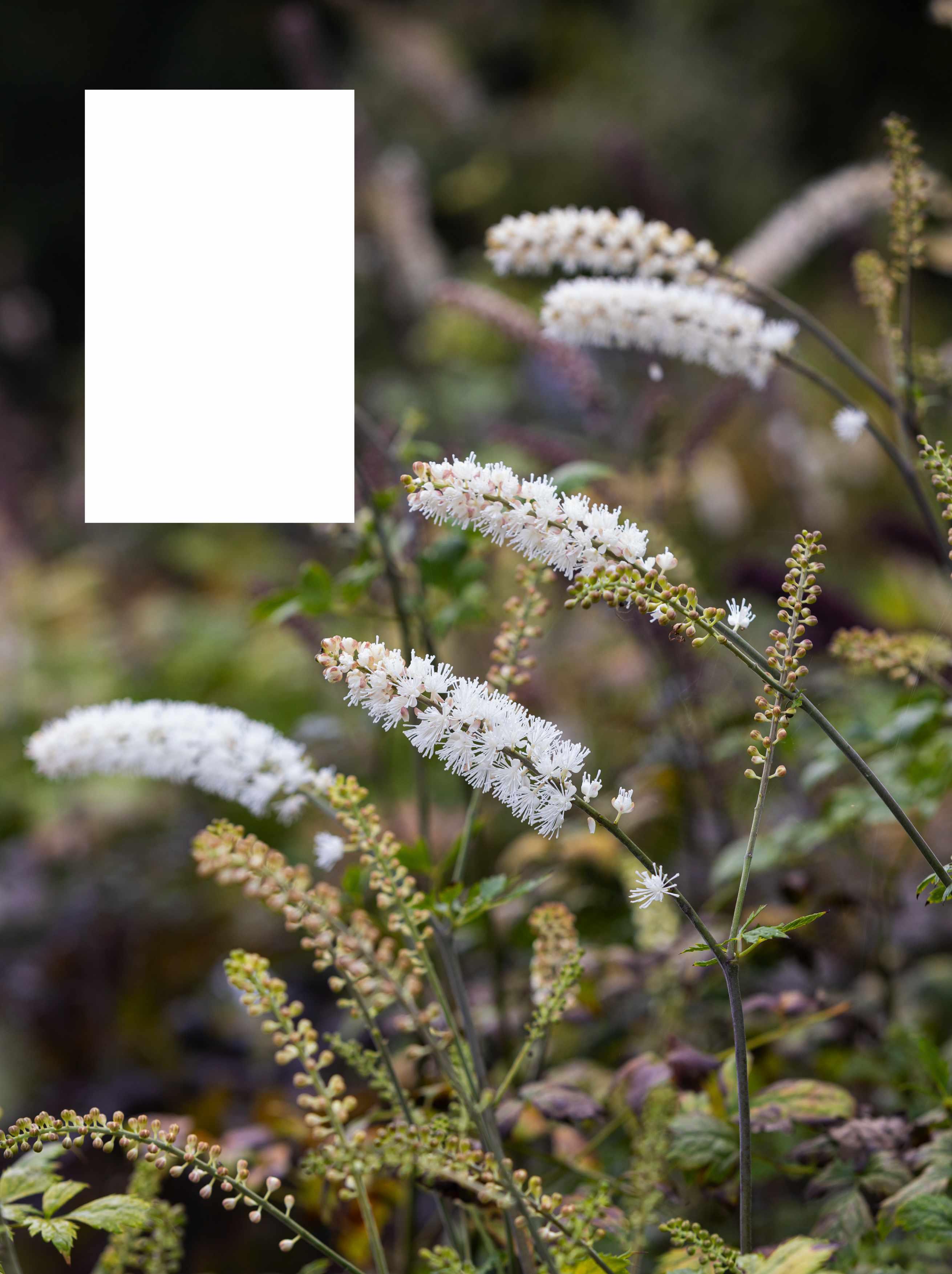
Beth’s friend and mentor, the great plantsman Graham Stuart Thomas, called this Japanese bugbane a real treasure and I agree. Arching spikes of white bottlebrush flowers are held on slender, purplish stems above a mound of green leaves, adding an elegant presence to the border late in the season, sometimes until early November. Flowers are followed by attractive lime-green seedheads. We grow it in dappled shade with hostas, Solomon’s seal and ferns. AGM*.
Height and spread 1.2m x 60cm.
Origin Garden (species Japan, Mongolia and eastern Russia).
Conditions Soil that‘s not too dry; best in partial or dappled shade.
Hardiness RHS H7, USDA 4a-9b†
Season of interest September –November.

To create a warming autumn vibe, Åsa Gregers-Warg chooses russet and bronze foliage plants, punctuated by late bloomers and a dramatic silvery-grey mullein
PHOTOGRAPHS RICHARD BLOOM
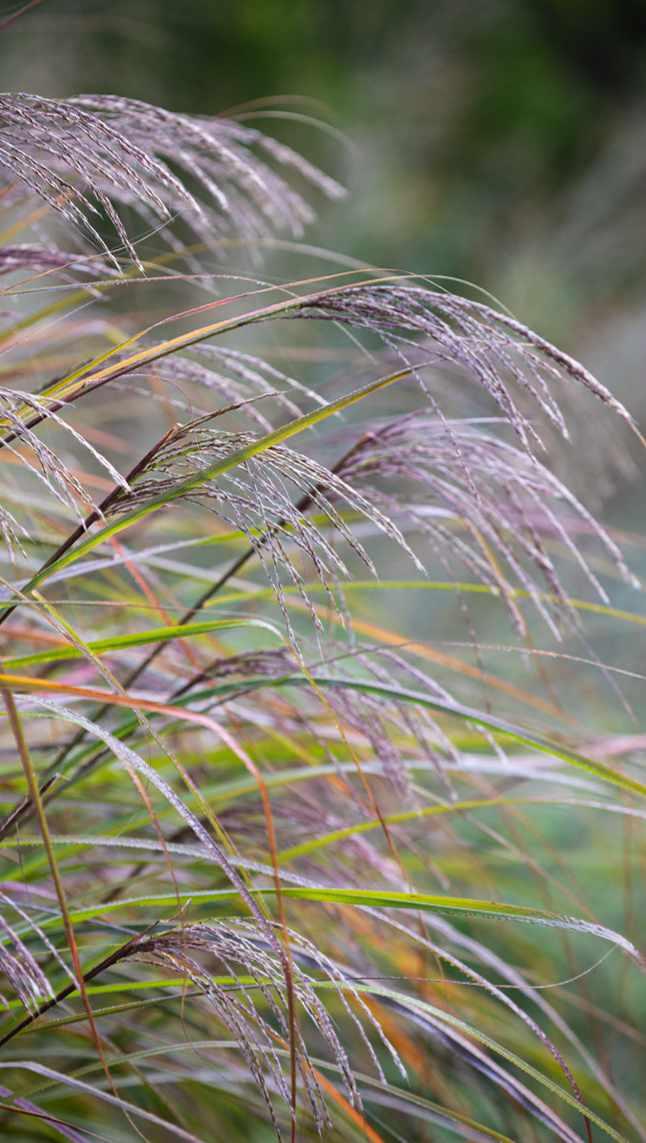
MISCANTHUS SINENSIS ‘BETH CHATTO’
This elegant Ernst Pagels selection forms an upright clump of narrow leaves, topped by graceful plumes on dark stems. Beth once visited Pagels’s nursery in Germany, while staying with a friend in the Netherlands. She forgot to take her passport, but managed to find an unmanned crossing and spent a wonderful day at the nursery before heading back with a car boot full of plants. This time, they were stopped by border police and held for hours – though luckily she was allowed to keep all her plants.
Height and spread 1.8m x 1.5m.
Origin Garden (species East Asia).
Conditions Moist but well-drained soil; full sun.
Hardiness RHS H6, USDA 4a-9b.
Season of interest September –November.
A compact selection of culver’s root, from the superb Hessenhof Nursery in the Netherlands; its name translates as cobalt candle. Flower spikes appear in early summer, just above the leaves, which are arranged in a typical whorl-like manner. The seedheads that follow last well into winter, giving the plant a long season of interest, and in autumn the foliage turns a wonderful shade of yellow. Both V. virginicum ‘Adoration’ and V. ‘Red Arrows’ are good alternatives.
Height and spread 1.5m x 50cm.
Origin Garden (species Japan, Korea, northern China, Sakhalin and east Siberia). Conditions Will tolerate most soils, but not too dry; full sun to partial shade.
Hardiness RHS H7, USDA 3a-8b.
Season of interest Flowers: June – July; seedheads: August – November.
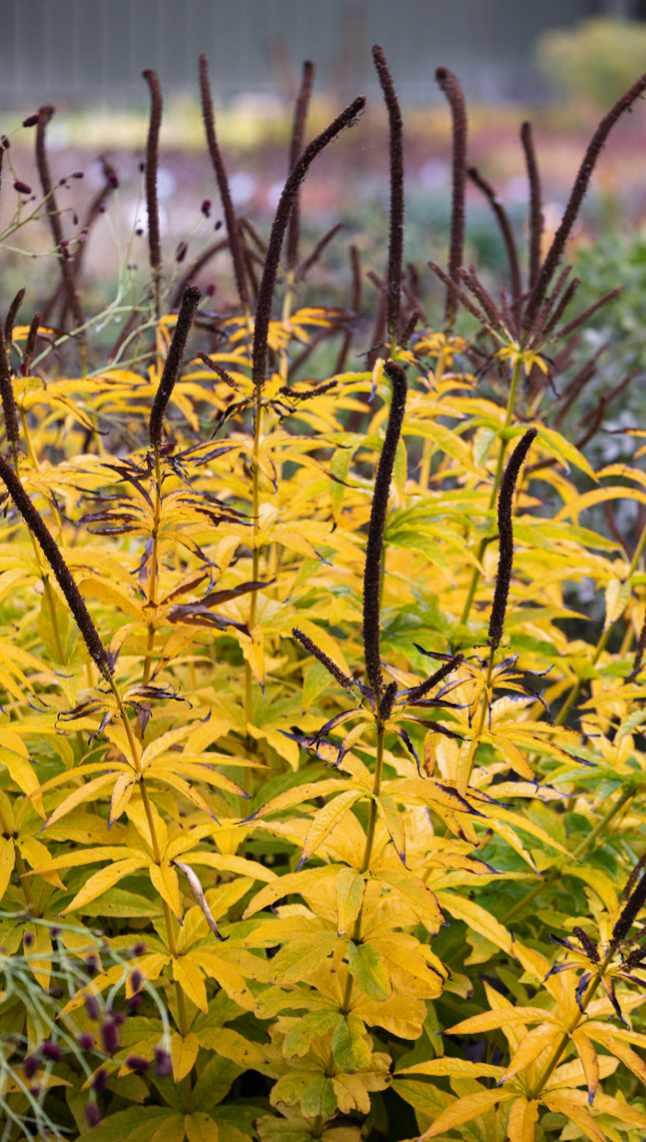
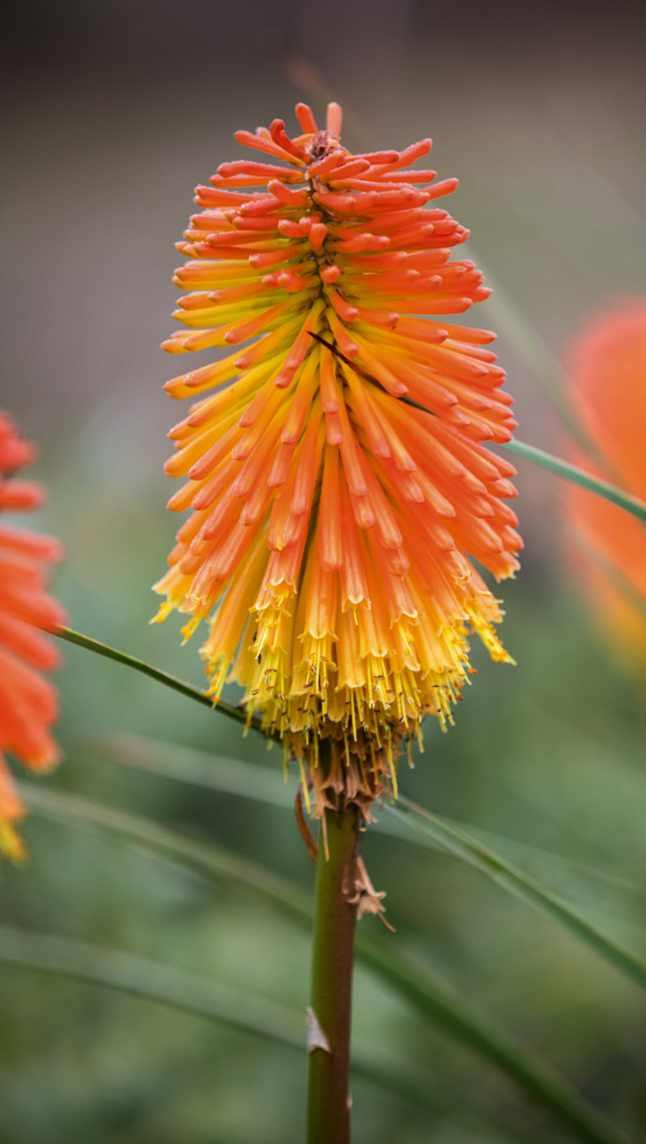
This late-flowering red-hot poker was named after Johann H Kniphof, a German physician and botanist, and Edward Rooper, a captain in the British army and a keen painter of flowers, who sent this plant to the UK while stationed in South Africa. The luminous, distinctively chunky flowers are held on stout stems above a large clump of tousled, evergreen foliage. Often said to require moistureretentive soil to thrive, ours sits next to a Leyland cypress hedge, in full sun and poor, sandy soil, so I think it’s safe to say it’s extremely tough and adaptable. AGM.
Height and spread 1.2m x 1.2m.
Origin South Africa.
Conditions Moist but well-drained soil; full sun.
Hardiness RHS H5, USDA 5a-9b.
Season of interest September –October.
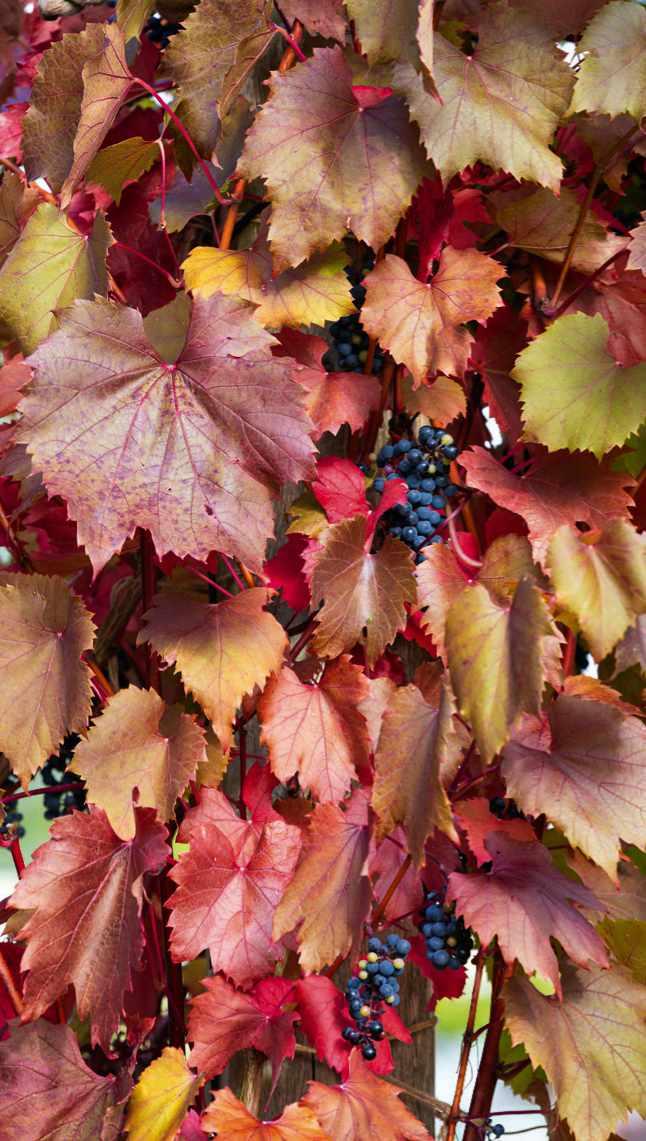
VITIS VINIFERA ‘SPETCHLEY RED’
Having planted this deciduous vine so it could drape itself across a structure above our nursery gate, I now regret not making the wooden posts taller. It really needs a large wall or sturdy structure to support its vigorous growth, even with regular pruning (in winter when fully dormant), and an additional summer trim. Its small, dark grapes are edible and said to produce good wine. In autumn, the green leaves turn the most brilliant red colour. Named after Spetchley Park in Worcestershire.
Height and spread 4-8m x 2.5-4m.
Origin Garden (species Mediterranean, central Europe and western Asia).
Conditions Moist but well-drained soil; full sun.
Hardiness RHS H5, USDA 6a-9b.
Season of interest Autumn colour: September – October.
Åsa’s recommendations for places to see seasonal plants at their best
Be sure to check opening times. Some garden visits may need to be pre-booked
Slender buds, dangling from the stem like delicate earrings, reveal exquisite, pendulous white flowers, which on closer inspection look like they’ve been dipped in green paint. Free flowering, with a vigorous, bushy habit. Hardy fuchsias are fantastic garden plants and surprisingly under-used. They may look delicate but throughout most of the UK they survive the winter in the ground, blooming non-stop from summer until the first frost and, apart from cutting the old stems back to ground level in spring, don’t require much attention. Best appreciated in shade. AGM.
Height and spread 1m x 50cm.
Origin Garden (species Chile).
Conditions Avoid excessively dry or wet soil; best in partial to full shade.
Hardiness RHS H4, USDA 10a-11. Season of interest July – November.

I always look forward to Great Dixter’s Autumn Plant Fair, traditionally held on the first weekend of October. The relaxed atmosphere, glorious gardens and the opportunity to meet so many plant lovers add to making this event so special. The fair itself is held on the field below Dixter’s nursery, with stalls made out of chestnut poles, corrugated iron and hessian.
A quick pit-stop at the cake stall is recommended, while browsing the selection of plants for sale from nearly 30 independent nurseries and expert growers. If you’re hoping to find something rare and unusual, I’d suggest you be there as the gates open on Saturday – there is only so much the nurseries can fit into a van and not everyone is able to go back home to restock. Great
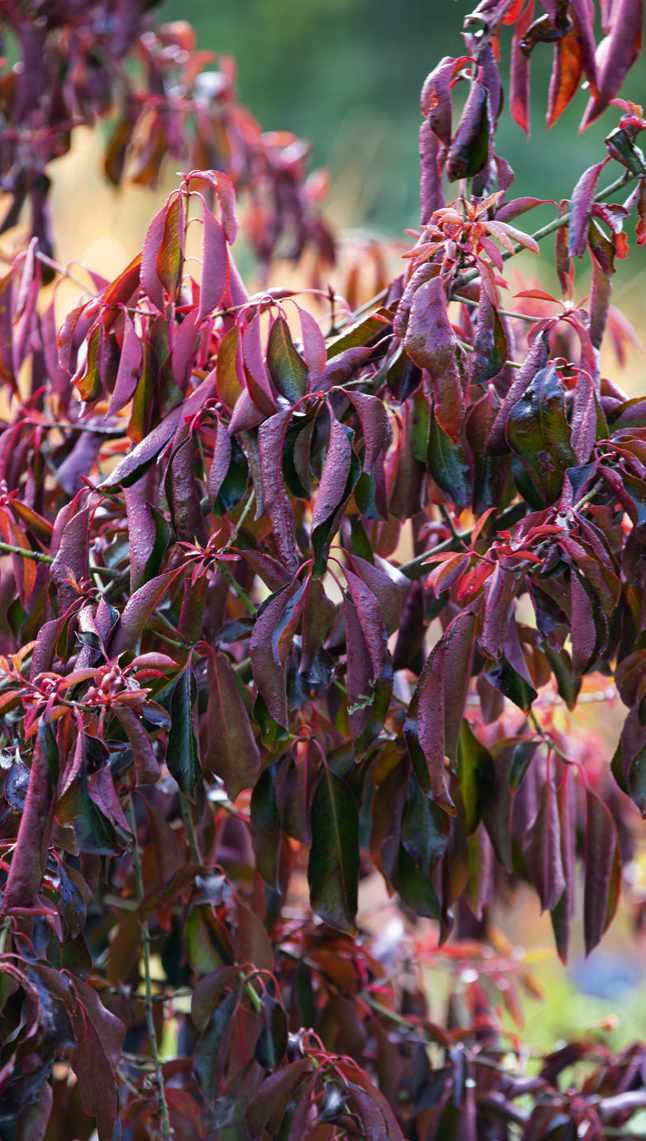
Most noted for its spectacular autumn foliage, often persisting into early winter, this selection brings a delightful display of creamy-white, four-petalled blossoms in summer, followed by yellow, later pink, fruit capsules. The dark-green, waxy leaves tend to fold up along the midrib, exposing a lighter-coloured underside. As summer gives way to autumn, the foliage turns a striking red, and eventually deep burgundy. In ten years, it has only reached a height of 1.5m, growing slightly wider.
Height and spread 2.5m x 2.5m.
Origin Garden (species southwest China, Taiwan and Japan).
Conditions Moist, well-drained soil; best autumn colour in full sun.
Hardiness RHS H6, USDA 4a-7b.
Season of interest September –November.
Dixter’s Autumn Plant Fair, 7-8 October, 11am-4pm. The £13 entrance fee also includes garden entry. Great Dixter, Northiam, Rye, East Sussex TN31 6PH. Tel 01797 252878, greatdixter.co.uk Knoll Gardens, near Bournemouth, is renowned for its ornamental grasses, naturalistic-style garden and adjacent nursery, which also offers a mail-order service. I find the website very helpful
when searching for new additions to our own gardens. Owner Neil Lucas (whose plant profile on Miscanthus you can read on page 40) is an expert in his field and I appreciate the pictures of plants in situ and information based on years of experience. Now is a great time to visit the garden to see the grasses at their peak, accentuated by choice perennials and the vibrant
From afar, this false aster looks like a giant baby’s breath, towering at the back of the border next to purple and pink asters and pale-yellow Helianthus ‘Lemon Queen’. Stiff, branching stems with narrow leaves carry an abundance of small, daisy-shaped flowers. If it grows too lanky, give it a Chelsea chop or place it among tall, supporting neighbours. B. asteroides ‘Snowbank’ is shorter and more compact, while Symphyotrichum pilosum var. pringlei possesses the same airiness, forming a 1.5m-high mound. Rhizomatous by nature, so will spread, but not in an invasive way.
Height and spread 1.8m x 1m.
Origin Eastern USA.
Conditions Most soils, can tolerate seasonal flooding; full sun to partial shade.
Hardiness RHS H7, USDA 3a-10b.
Season of interest September – October.

autumn foliage of specimen trees and shrubs. Knoll Gardens, Stapehill Road, Hampreston, Wimborne, Dorset BH21 7ND. Tel 01202 873931, knollgardens.co.uk
Beth’s husband Andrew Chatto was a fruit farmer. His apple orchards enclosed the land where the Chattos built their family home. In the early days Beth used to employ the local ‘fruit farm girls’ to help her in the
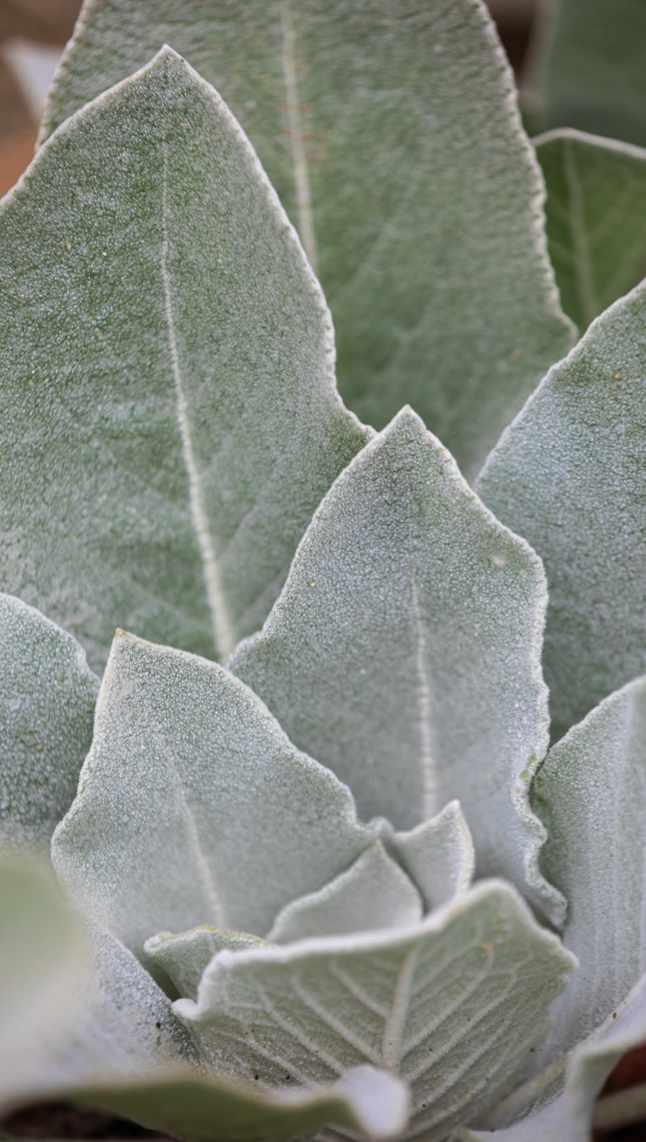
Beth loved using this beautiful giant mullein as an accent plant, to capture the eye and act as a focal point. It readily self-seeds around our Gravel Garden. As we ‘edit’ the borders, only two dozen or so of the tiny seedlings are allowed to stay. A biennial, it produces a huge, basal rosette of silver leaves, up to a metre across, in its first year, which sits like a huge, felted brooch on the ground. The following year, a thick flower stalk covered in woolly, white fleece shoots up, producing a dramatic candelabra adorned with sulphur-yellow blossom.
Height and spread 2m x 1m. Origin Turkey.
Conditions Well-drained soil; full sun. Hardiness RHS H6, USDA 5a-8b. Season of interest Foliage in its first year, flowering the following summer.
garden, when they weren’t busy picking apples or pruning the fruit trees. These trees are now long gone, like so many British orchards. Since the 1960s, Norfolk alone has lost 60 per cent of its apple production. But throughout October, and especially on National Apple Day on 21 October, events are held across the country to celebrate local fruit heritage and raise
A rarity, commonly known as fringed false hellebore, from the coastal region of northern California, endemic to wet meadows. A friend gave me a young plant many years ago, and like all veratrums it’s been slow to increase. Handsome, pleated leaves appear in spring, which turn rather moth-eaten by the time it blooms. Green, barely knee-high stems carry the most exquisite lacy-fringed flowers, each tepal adorned with two bright-golden glands. As they age, the pure-white flowers slowly become suffused with green.
Height and spread 50cm x 30cm (so far).
Origin Northwest California, USA.
Conditions Moisture-retentive soil; partial to full shade.
Hardiness RHS H4, USDA 5a-8b.
Season of interest September –October.
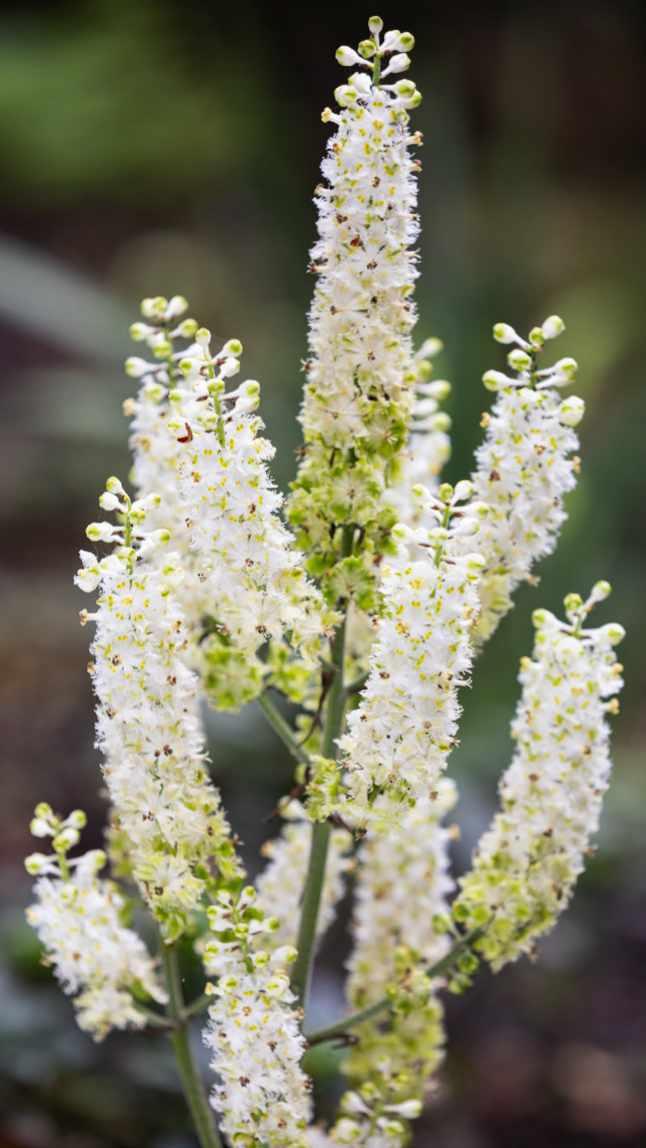
awareness of the decline in UK orchards.
East of England Apples and Orchards (EEAOP) is a charity promoting local fruit varieties and the preservation of orchards in the east of England. Its Norfolk headquarters are home to a collection of around 270 varieties of the region’s apples, pears, plums and cherries. While the collection is only open to the
public by appointment, you’ll find EEAOP at many of the region’s events, showcasing local apple varieties and providing a fruit identification service. Tel 01328 838403, applesandorchards.org.uk
One of the best places to see fruit trees is at Brogdale Farm in Kent, which is home to the National Fruit Collection and houses an impressive
collection of more than 4,000 different cultivars set in 150 acres of farmland. This month is a good time to visit to see its apples, pears, quince and medlars. Daily guided tours and self-guided walks (from April to November). Brogdale Collections, Brogdale Road, Faversham, Kent ME13 8XZ. Tel 01795 536250, brogdalecollections.org
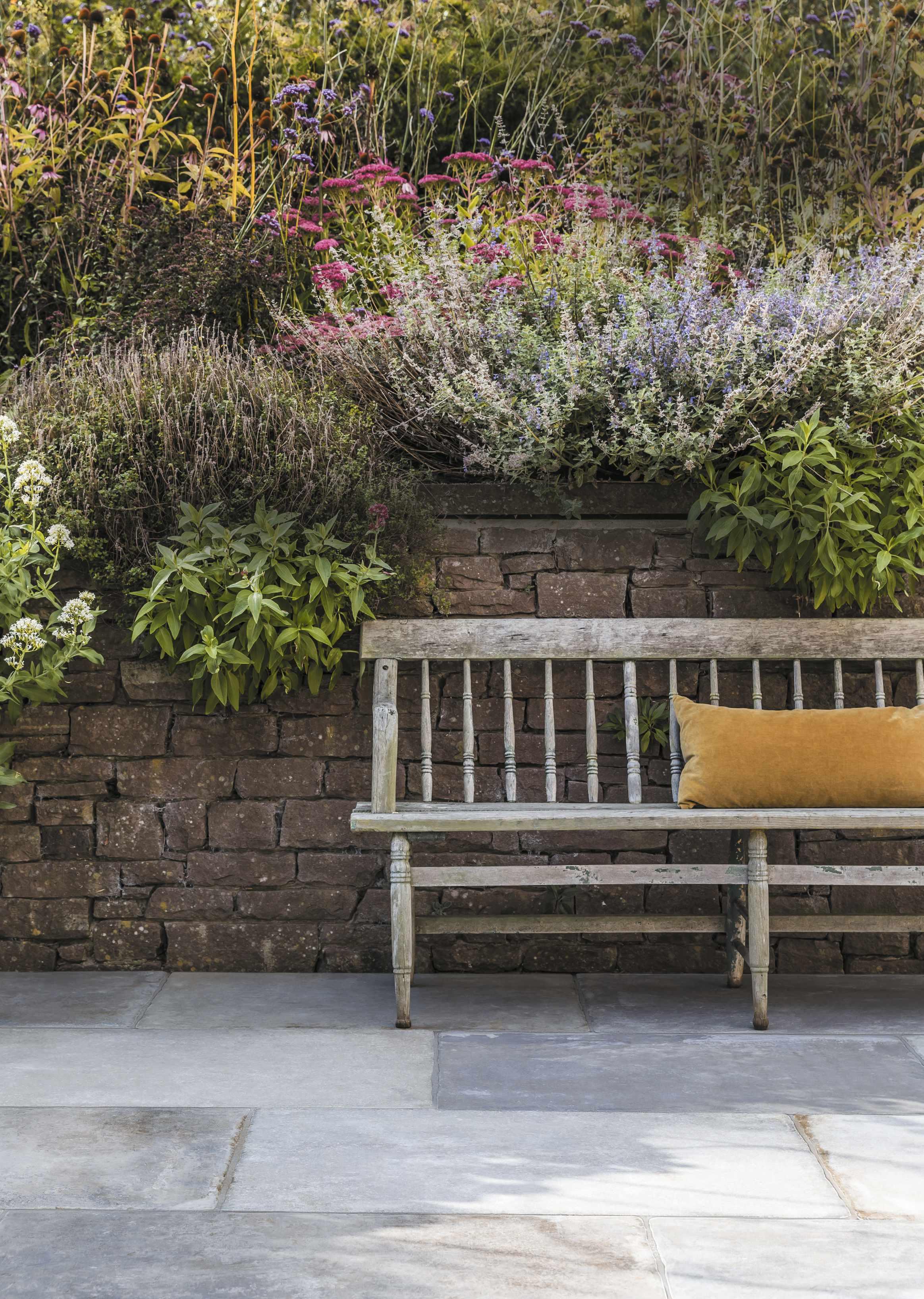
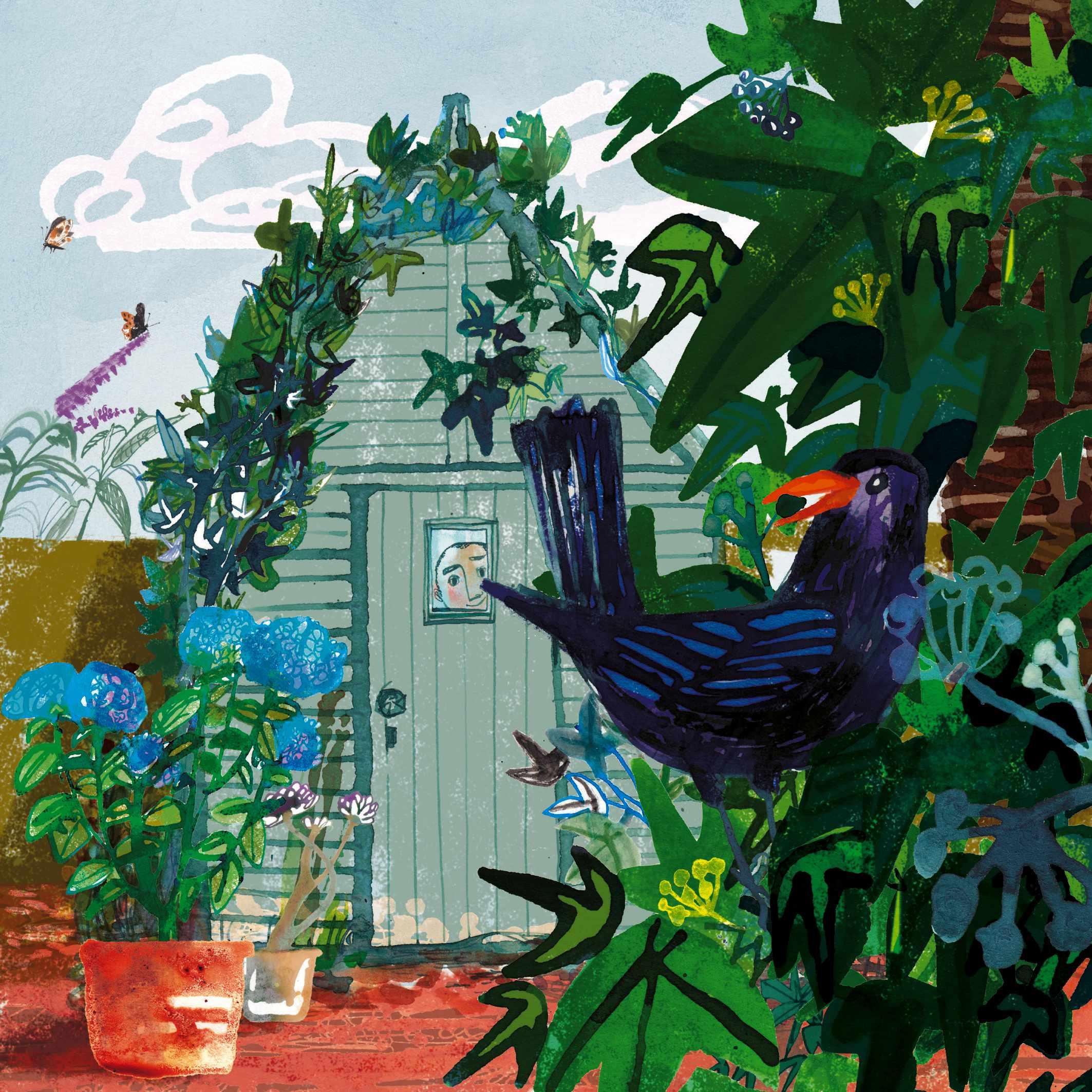
When it comes to plants with bad reputations – be that ivy, Leyland cypress or red valerian – we’d be better not to judge them too quickly. Live and let live, says Ken Thompson, and the wildlife will thank you for it
ILLUSTRATION JILL CALDER
We can argue about the definition of a weed, but part of it is surely a plant’s ability to make itself thoroughly, immovably at home, often despite your best efforts to persuade it to go away. Among native plants, there can hardly be a better illustration of this than ivy.
If you don’t like ivy, the bad news is that it’s also one of the main beneficiaries of climate change. As an evergreen climber of mostly subtropical affinities, ivy was never very fond of cold winters. But now that such things are increasingly rare, ivy is able to grow almost all year round in warmer parts of the country. In fact, right across Europe, ivy is now more abundant where it grows, and grows in more places, and climate change is certainly to blame.
And yet, despite a reputation as something of an unwelcome thug, it’s hard to imagine a plant that’s more valuable to wildlife throughout the year. In autumn, ivy provides the year’s last great nectar harvest. Ivy is so widespread that bees generally don’t need to go far from the hive to find it, and studies show that honeybees travel about half as far in September
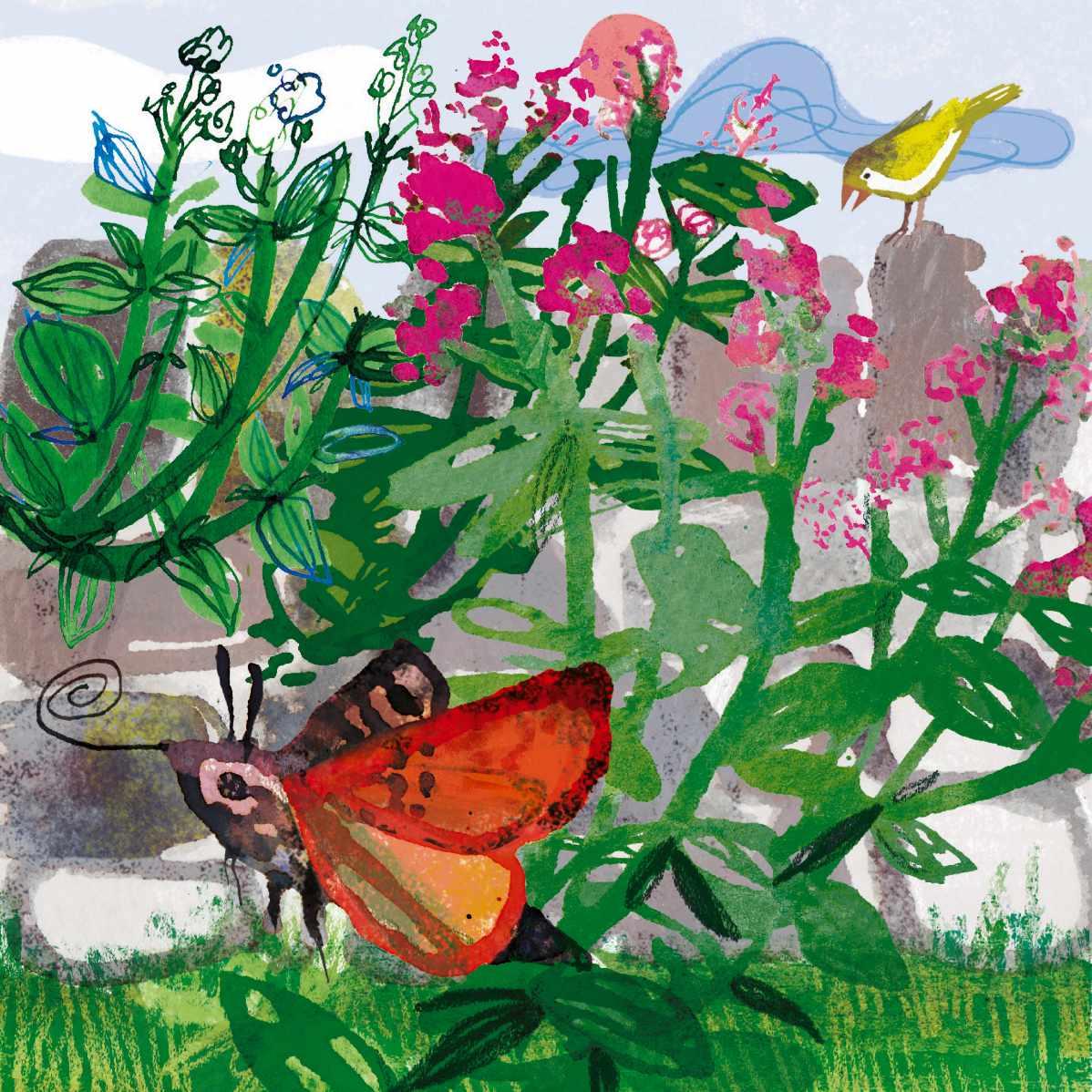
to find food as they do in the summer. In fact, hives with plenty of ivy around are more likely to survive the winter. Honeybees also need pollen to raise their young, and hives that end the year with healthy pollen stocks can get going faster in the spring. Most of that late pollen comes from ivy.
Ivy flowers are too late for most bumblebees, but they’re also visited by wasps (wasps are wildlife too) and by late-flying hoverflies and butterflies –a sunny patch of flowering ivy can be a magnet for red admirals and small tortoiseshells. Ivy also now has its very own bee: Colletes hederae (ivy bee) is a solitary mining bee that was first recorded in Dorset in 2001 and has now spread as far north as Cumbria and County Durham.
An ivy-covered wall, fence or shed provides winter shelter for no end of wildlife, including spiders, ladybirds and lacewings, and perhaps one or two of that hardy band of butterflies that overwinter as adults: red admiral, brimstone, comma, peacock and small tortoiseshell.
Fat-rich ivy berries are a vital winter food for blackbirds and thrushes, and in spring and summer, ivy provides ideal nesting habitat for many birds, including wrens, dunnocks and finches. Dense evergreens such as ivy are particularly useful for birds that want to make an early start on breeding and don’t want to wait for deciduous trees and shrubs to come into leaf.
Ivy is also one of the two food plants of one of our most common and most charming garden butterflies, the holly blue. In fact, there’s almost no end to the things that ivy can do for wildlife, especially if you stop persecuting it for long enough for it to grow up into the sun and flower.
When the Monterey cypress and the Nootka cypress, both from North America, accidentally crossed in 1888 to give us Leyland cypress, I doubt anyone realised the trouble it was going to cause. In fact, there’s nothing wrong with Leyland cypress also called leylandii – it’s a handsome, large (indeed potentially enormous) tree. The fault lies with people thinking it would make a good hedge, which it doesn’t – it’s too fast growing and too big. In fact, no one knows how big – the largest trees are now around 40m tall and still growing.
But hardly any plant is completely useless, and even Leyland cypress has its uses for wildlife. Rather like ivy, it provides good, dense evergreen cover – useful for birds to roost in over winter and nest in during the spring. It’s also one of the reasons, along with the expansion of coniferous
The hummingbird hawk moth is a good enough reason on its own to grow red valerian, even if these plants will then repay your kindness by trying to take over your garden
forestry, for the remarkable expansion of conifer-feeding moths in recent decades. Many British moths are declining, but species such as Blair’s shoulder-knot, spruce carpet, juniper carpet and pine beauty are all expanding rapidly. The biggest winner over the past ten years has been the cypress carpet, a new colonist moth from Europe that has spread rapidly after first being found in West Sussex in 1984.
Say what you like about Leyland cypress, it’s a sterile hybrid so at least it stays where it’s put, which is more than can be said for many garden plants. I’m not sure which is the most relentlessly persistent self-seeder in my garden, but red valerian (Centranthus ruber) is certainly a candidate. Which at least means that if you want to grow it, it’s just a question of waiting and it’s sure to turn up, probably sooner rather than later. You certainly shouldn’t need to buy it, although I’m astonished how often I see it for sale.
But the long-spurred red, pink or white flowers of red valerian are the favourites of one of our most charismatic garden insects: the hummingbird hawk moth. This day-flying hawk moth is a summer visitor to the UK from southern Europe, sometimes in large numbers. It’s such a lovely animal that I think it’s a good enough reason on its own to grow red valerian, even if these plants will then repay your kindness by trying to take over your garden. ■
• Dr Ken Thompson is a plant ecologist and myth buster, who is known for his scientific and practical approach to gardening. He is author of books on invasive species, biodiversity, wildlife gardening, weeds and compost making.

Save when you subscribe to the digital edition





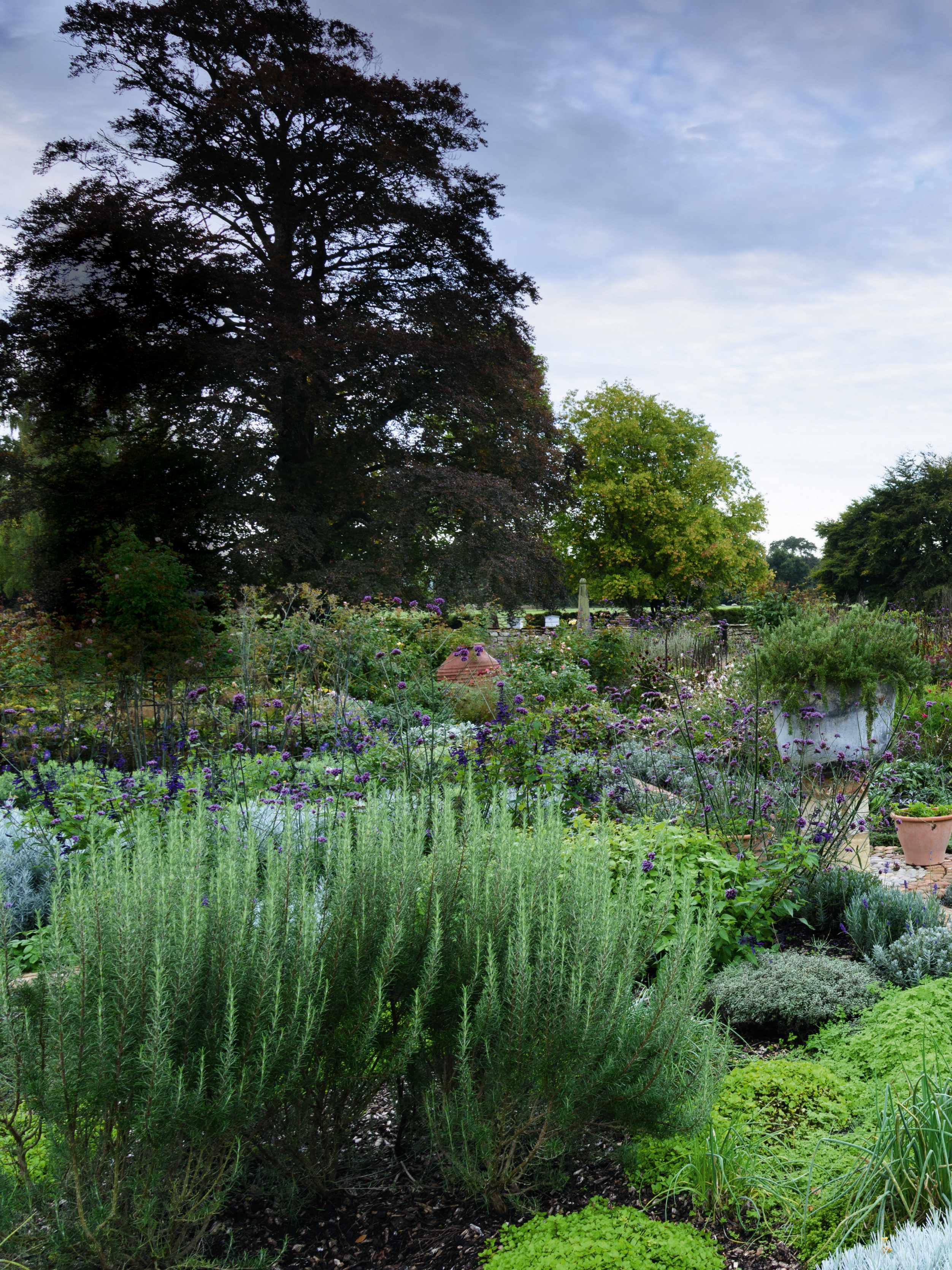
Name Corsley House.
What A relaxed and biodiverse garden, which has recently been brought back to life and now sits comfortably in its rural setting. Where Wiltshire.
Size Approximately 15 acres. Soil Free-draining greensand, improved with tonnes of organic matter.
Climate Mild. Hardiness zone USDA 9.
The Walled Garden, which you enter from the threshing barn on one side and the potting shed on the other, has been revitalised with head gardener Jo Downes’s design. It features eight sections, separated by brick and gravel paths, for productive fruit, vegetables and herbs such as rosemary ‘Miss Jessopp’s Upright’, and flowers for cutting. A repurposed wash tub, found in the potting shed and now filled with prostrate rosemary, forms the centrepiece of the herb garden.

The making of an immersive, biodiverse garden in rural Wiltshire has been a journey of discovery, recovery and reinvention
Corsley House, a handsome ashlar stone building set in wooded land below Cley Hill in rural Wiltshire, had its origins as a Jacobean farmhouse. Just as its Georgian and Victorian additions lend the house character and individuality, so the recent development of its garden, under the ownership of American anglophiles Keith Johnson and Glen Senk, has created an exciting series of spaces that connect to the landscape and celebrate the joy of gardening with nature.
When the couple bought the property in 2018, they found a garden that had been loved in earlier times, with elements they definitely wanted to keep: majestic trees (including copper beech, cedars and an Indian bean tree), yew hedging, topiary, a huge walled
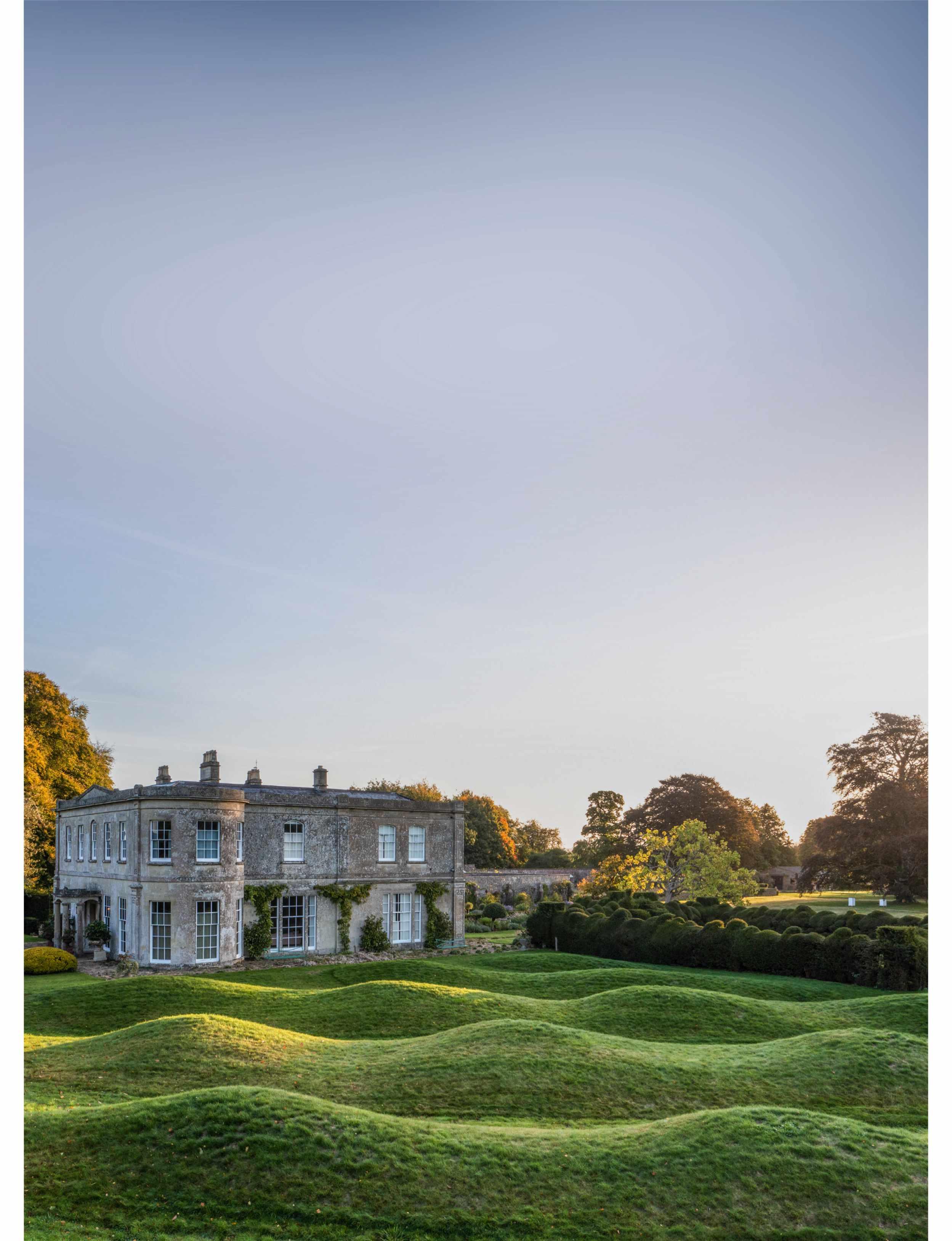
garden and several historic structures and outbuildings including a grain store, threshing barn, potting shed, apple store and greenhouse overrun with vines. With the arrival of head gardener Jo Downes, an experienced horticulturist and committed environmental scientist, their English gardening journey began – their previous garden in Palm Springs, California, had a very limited palette of plants due to summertime heat. Keith, former buyer-at-large for the retail store Anthropologie, took the reins in the garden and was quickly converted to Jo’s nochemicals/no-dig, biodiverse-rich approach.
The process of bringing the garden back to life has been a combination of uncovering (paths, plants, gates), reclaiming (timber and found objects on the land) and taming. One of the couple’s first interventions was to regain the view to Cley Hill, which was hidden by towering yew hedges and a backdrop of
The undulating landform, a series of wave-like peaks and troughs, was Keith’s brainchild. “I saw one on a much larger scale at Storm King Art Center [an open-air museum and sculpture park in New Windsor, New York] by the brilliant Maya Lin. Ours was designed by Gianni Alen-Buckley. Looking out over it, you definitely feel the waves rolling in.” It took two attempts to achieve the beautiful close-cut sward of each wave. When the carefully raked banks, which were made to uniform heights by using a series of string lines, were initially sprayed with grass seed, much of it was washed away by torrential rain. A subsequent period of drought dried off the tops of each mound, and weeds took hold. Random daffodils, moved around by the earth sculpting, also popped up. The seeding had to be repeated, and this time, the growth was successful. The grass is kept short with regular mowing. “At dawn and dusk you get amazing shadows across the waves,” says head gardener Jo, “and it looks spectacular in winter dusted with frost.”
Facing page
1 Three topiary beech anchor the plants in the recently planted grasses bed. Grasses such as Stipa gigantea and Panicum virgatum ‘Heavy Metal’ are mixed with Allium ‘Summer Drummer’, Persicaria and Dianthus for months of interest.
2 Keith mixes sculptural pieces acquired in antique sales and reclamation yards with materials and objects found on the land. This woven willow sculpture by Sarah Clarke, one of Corsley House’s three part-time gardeners, is fixed into timber from a fallen tree.
3 The wedding-cake yew topiary and box topiary shapes were planted to create a formal garden on the north side of the house. The finials, unearthed elsewhere in the garden, were reinstated on the low stone wall, as seen in an old photo.
4 The towering yew hedge has been gradually reshaped as a cloud hedge. The taller sections on either side of the gate will eventually be pruned as horses’ heads, to celebrate Glen’s show-jumping days.
5 Cardoons in the long border on the outer wall of the Walled Garden are left standing for their architectural seedheads, as are most of the perennials in the garden. Aster x frikartii ‘Mönch’, Helianthus ‘Lemon Queen’, Salvia nemorosa ‘Caradonna’ and Agastache ‘Blue Fortune’ attract beneficial insects.
6 The cobblestone and brick path in the Walled Garden features a circular motif repeated throughout the garden. This entrance to the Walled Garden has been filled with a dry-stone wall.“We have many walls with bricked-in doorways suggesting another time and purpose,” says Keith. “This lends a bit of mystery.”
hedge encloses a rectangle of grass, creating a calm, green space between the landform and the adjoining Jubilee Garden.
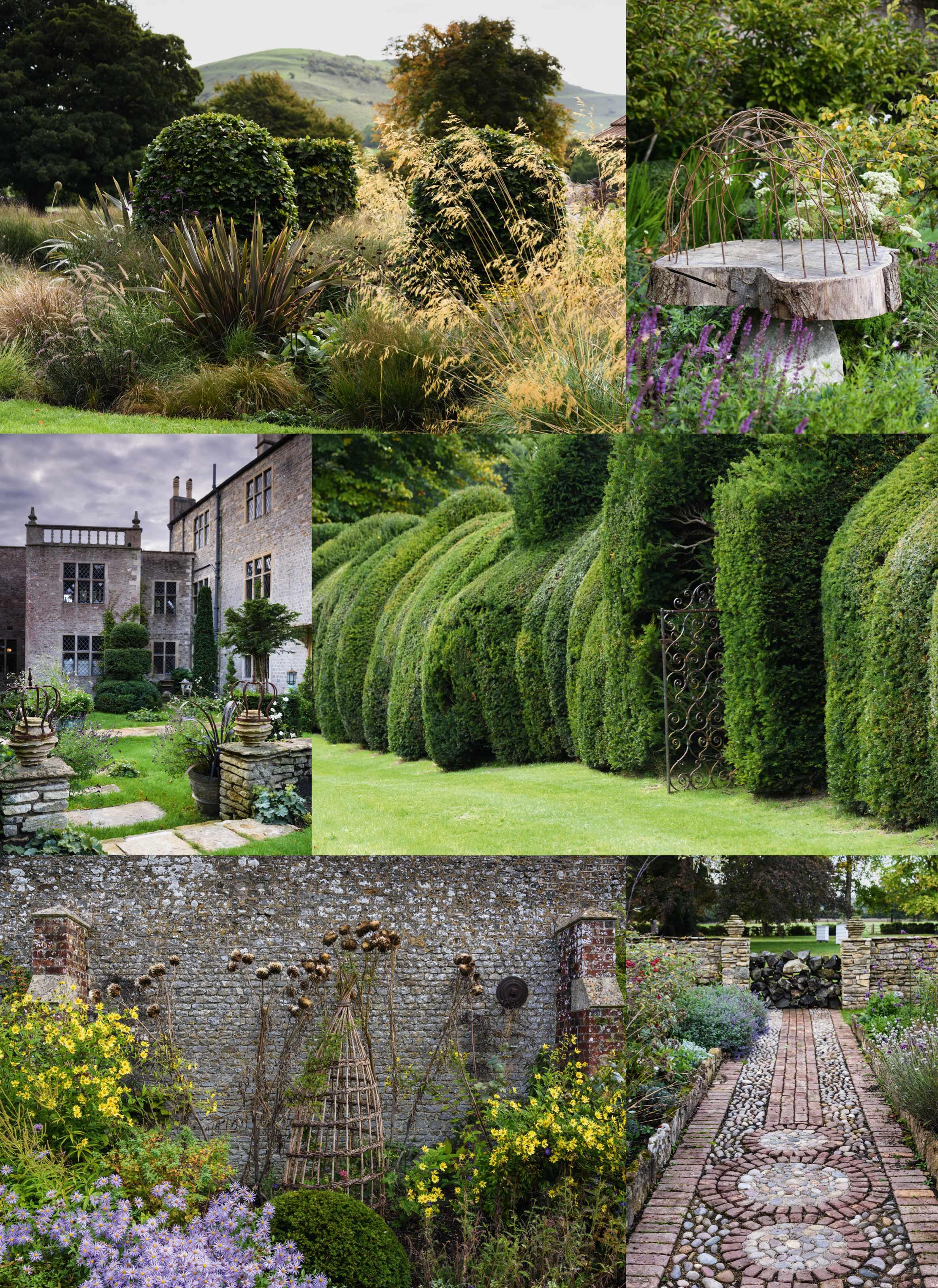
shrubs. “When we first saw the property,” explains Glen, “we fell in love with Cley Hill, and the fact that it was obscured was unbelievable to us.” The shrub bed was duly removed, the yew hedge lowered and the gap in the centre widened so that the gently rounded profile of the landmark hill can now be seen from the kitchen windows. The yew hedge has gradually been transformed into a characterful cloud hedge.
The view from the southern side of the house has also been enriched with a sculptural wave lawn made up of a series of undulating, grass-covered mounds, each nearly 2m high, that extend out into the landscape. On one side is a recent witty addition: a line of domeshaped frames, which are gradually being covered in beech leaves to make ‘beech huts’.
Having fully committed to managing the garden organically, the addition of the adjoining wildflower meadow, Keith explains, was a natural step in that direction. Now in its fourth year, and harrowed after cutting to open up patches of bare soil for wildflower seed germination, the meadow is a colourful mix of ox-eye daisies, knapweed, yellow rattle, rough hawkbit and musk mallow.
As well as opening up the various garden spaces to the landscape, the couple wanted to create more areas where they and their friends can sit and share meals. The newly planted Jubilee Garden in front of the kitchen is now a delightful expanded terrace, with numerous seats, quirky sculptures and drought-tolerant plants such as creeping thyme, Salvia nemorosa ‘Caradonna’ and Cota tinctoria ‘Sauce Hollandaise’, all of which attract bees and other beneficial insects.
The area that has seen most changes is the Walled Garden, a formerly neglected productive garden with high walls on two sides, a low wall overlooking the wildflower meadow and a hedge on the fourth side. Jo was given free rein here, and it has now become Keith and Glen’s favourite place. Once the pernicious weeds were cleared, the compacted soil improved with tonnes of compost and hose points installed, Jo divided the space into eight sections, with wide brick and cobble paths forming the main walkways and gravel paths for the secondary ones.
Two beds for cutting flowers are filled with delphiniums, peonies, Veronicastrum, gladioli, zinnias and Alchemilla mollis
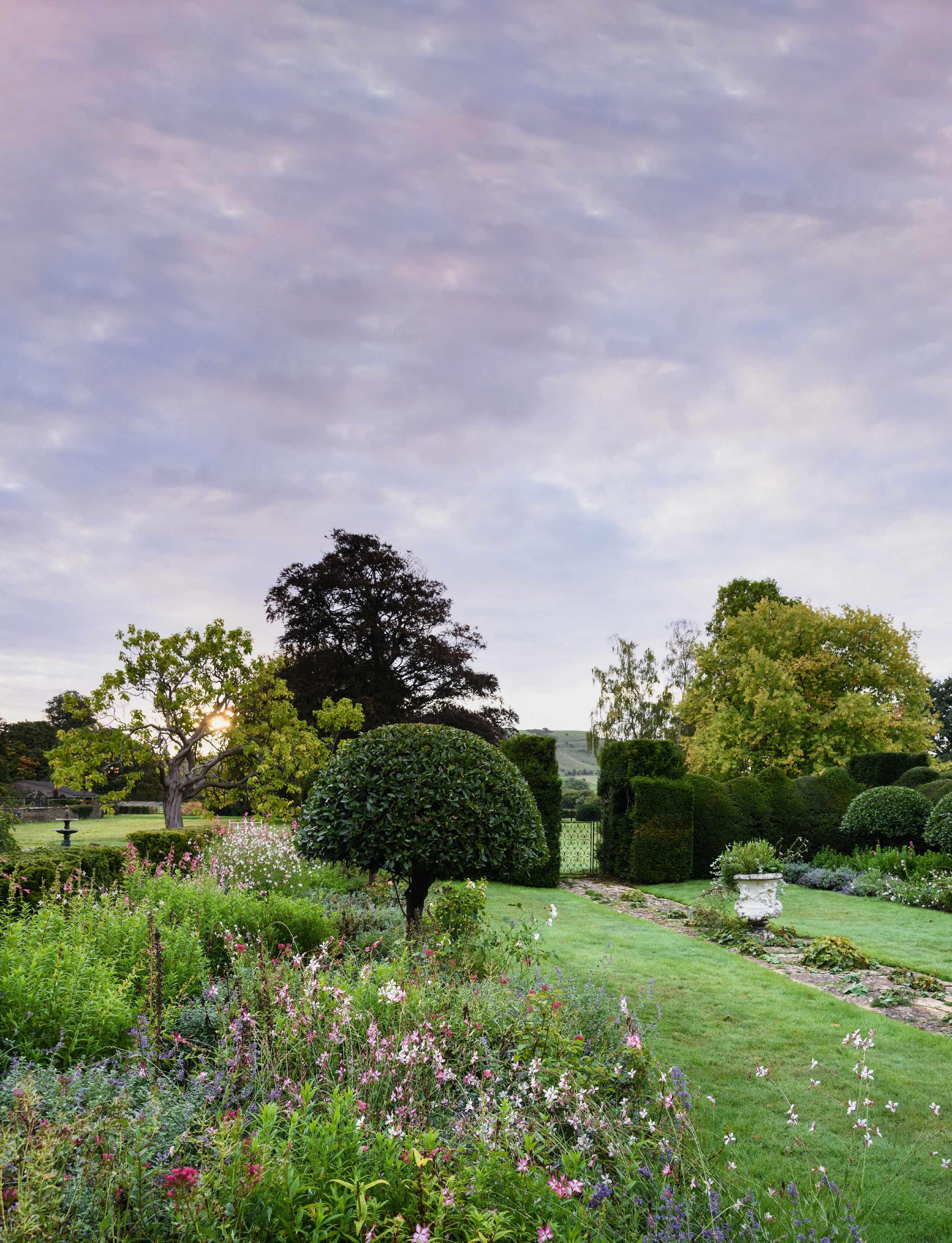
This page The Jubilee Garden was replanted in 2021 and features lollipop bay trees underplanted with a selection of drought-tolerant plants, including Oenothera lindheimeri ‘Whirling Butterflies’, Centranthus ruber and Nepeta racemosa ‘Walker’s Low’.
Facing page A new water feature was added to the Jubilee Garden, with spouts that create a constant sound of falling water. Euphorbia palustris and other plants, including Verbena officinalis ‘Bampton’, are encouraged to self-seed in the gaps between the paving stones.
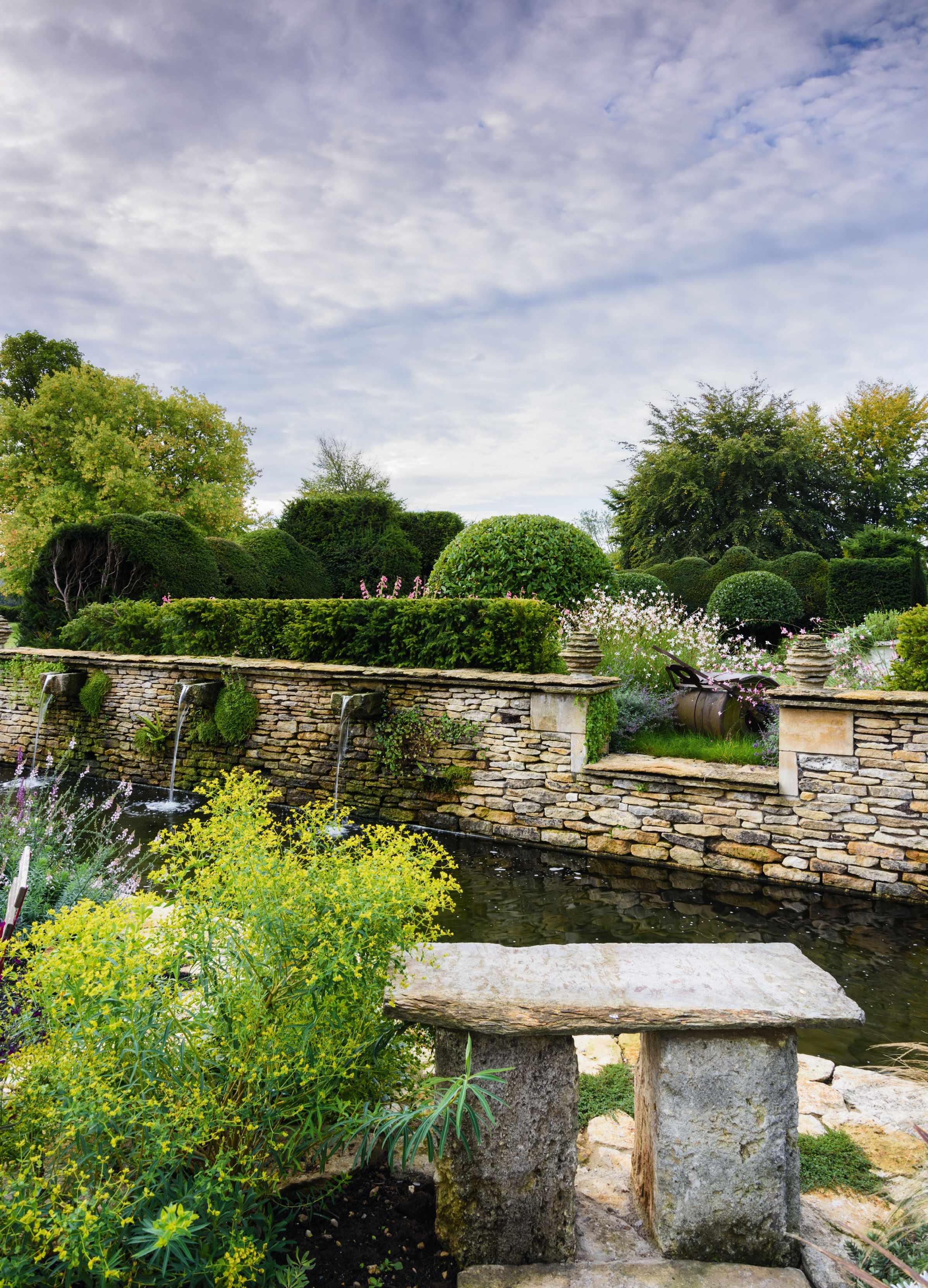
The newly planted Jubilee Garden is now delightful, with sculptures and droughttolerant plants, which attract bees and beneficial insects
In one bed, the flowers are grown in lines, while in the other, they are grown more ornamentally with paths cut through so that you can immerse yourself in the plants. The vegetables are grown in traditional lines and include plantings of asparagus, globe artichokes, sweetcorn, squash, sweet potatoes and kale. Tagetes, Calendula and nasturtiums are interplanted to repel insects, such as aphids and caterpillars, while attracting other pollinators. Fruits, such as blackberries, tayberries, blueberries, red and white currants and gooseberries, fill a fruit cage that is clad with an eye-catching tracery of sculptural branches. A section for scented roses is interplanted with hellebores, tulips and honesty for early interest followed by Gypsophila, geraniums and winter savory.
The Walled Garden is also where Keith and Glen have installed a stone pizza oven, and a steel grill inspired by the one at Hauser & Wirth’s Roth Bar and Grill near Bruton, Somerset. More intimate meals can be shared

Three rows of dahlias, in shades of claret, apricot and peach, are grown in the cutting garden and are protected with a deep mulch in winter. They include Dahlia ‘Chat Noir’, ‘Penhill Watermelon’, ‘Totally Tangerine’ and ‘Café au Lait’. The striking red structure was designed by Keith along with Jackson Woodcock of Cricket Landscaping.
in the orchard on the other side of the wall, where a selection of fruit trees including plum, greengage and apple have been planted on the site of a former swimming pool.
Beyond the orchard and the Walled Garden are the new American-style stables that house Glen’s retired show horses and some recently arrived brood mares. This is also where you will find a new Grasses Border, with seedheads left standing through winter to provide food and shelter for wildlife.
It doesn’t stop there. The next project is to create seasonal walks through four copses on the periphery of the garden. As Keith says: “It is so wonderful to focus on something so positive and future orientated.” ■
Address Corsley, Warminster, Wiltshire BA12 7QH. Open In late summer for the NGS (ngs.org.uk) and for local charities, including Corsley and Chapmanslade Churches community support fund.
Facing page
1 Dahlia ‘Zundert Mystery Fox’ Profuse flowers fading from orange to terracotta as they mature. Height and spread: 90cm x 75cm. RHS H3†
2 Phlomoides tuberosa ‘Amazone’ Tall stems bear lilac flowers in July and August, followed by robust seedheads. 1.2m x 90cm. AGM*. RHS H5, USDA 6a-9b.
3 Brassica oleracea ‘Redbor’ Great tasting kale giving colour and structure to the kitchen garden. 1.2m x 60cm.
4 Tagetes tenuifolia ‘Red Gem’ A great companion plant for vegetables. Deadhead regularly. 30cm x 30cm.
5 Dahlia ‘Totally Tangerine’ Compact dahlia flowering from July to November. 60cm x 70cm. RHS H3.
6 Rudbeckia fulgida var. sullivantii ‘Goldsturm’ Prolific self-seeder and an excellent pollinator. Full sun. 50cm-1m x 40-60cm. AGM. RHS H6, USDA 3a-9b.
7 Solanum lycopersicum ‘Indigo Rose’ A blue-black cordon tomato with a delicate plum flavour. Best grown in a greenhouse. 1.8m x 60cm.
8 Cucurbita pepo ‘Jill be Little’ Miniature climbing pumpkin that trails happily on an arch or pergola. Sow in late March to May, fruits July to November. 1.8m x 60cm.
9 Catanache caerulea ‘Alba’ White, papery petals with jagged edges and a violet centre from June to September, followed by striking papery seedheads. 50-70cm x 30cm. RHS H5.
*Holds an Award of Garden Merit from the Royal Horticultural Society. †Hardiness ratings given where available.


THE LXT 18V BATTERIES POWER OUR FULL RANGE OF GARDEN PRODUCTS. USE ONE BATTERY FOR 18V PRODUCTS AND TWO BATTERIES FOR 36V PRODUCTS.
18V LXT PRUNING SAW: DUC101
Bar Size 100mm, Chain Pitch 0.325”, Chain Gauge 0.043”, Chain Gauge 1.1mm, Chain Oil Tank 0.055L, Chain Speed 8.0m/s, Weight 1.6-2.0kg

18V LXT BRUSHLESS HEDGE TRIMMER: DUH507
Max Cutting Capacity 15mm, Length Of Blade 500mm, Tooth Spacing 28mm, Strokes Per Minute 2700 min-¹, Weight 2.7-3.0kg
18V LXT BLOWER: DUB187
No load speed 9,000-13,500 min-¹, Max. Air Velocity 64m/s, Air volume 4.2 m³/min, Sealed suction 33 mbar, Weight 3.7-4.0kg
A
Royal Parks apprenticeship was the opening for Jay to change careers and explore his appreciation of nature
PORTRAIT LISA LINDER
Earliest garden memory Running through rows of trees in my grandfather’s mango orchard in Jamnagar, Gujarat, in India, when I was 12. My grandfather loved his garden and knew how important trees and plants are for our planet. Who has inspired your career? My wife. She inspires me to take risks and venture out of my comfort zone. She supported me in my decision to leave my former career and apply for the Royal Parks apprenticeship scheme, which has opened up the world of horticulture to me. My wife showed me that nature is healing and forgiving, even if you make a mistake. Worthwhile tips Don’t be afraid to get your hands dirty. Use your hands to feel the earth, to feel what you’re planting, to feel the moisture or dryness and to realise that the plant is living and breathing. Don’t overcomplicate things: you don’t always need a lot of equipment. Sometimes a trowel and a pair of secateurs is all you need. Favourite planting style As wild as possible; scattering bulbs, plants and seeds to boost biodiversity. It is great working in such rich and diverse spaces as the Royal Parks. Visitors often regard the parks as very manicured spaces, but a lot of work goes into the creation and maintenance of natural habitats for wildlife, including wildflower meadows, deep shrub borders and woodlands.
Favourite ‘weed’ you’re happy to have in your garden
The pineappleweed, Matricaria discoidea, as it’s a great plant for pollinators and it also smells like my favourite fruit! Biggest challenge facing gardeners today Adjusting our gardening practices and plant selections to accommodate the changing nature of our climate. In the parks, we ensure that we plant more drought-tolerant plants and a variety of plants that flower at different times to prolong the flowering season and boost the food supply for pollinators.
In what direction do you see horticulture heading? I hope to see more rewilding in parks, cities and gardens to increase biodiversity and protect wildlife. I think there will be more diversity in the community of gardeners in the UK, which will hopefully bring different heritages and practices to life in horticulture.
Favourite gardening website, Instagram feed or book
The Metamorphosis of Plants written in 1790 by Johann Wolfgang von Goethe; greenroof and substrate growing expert John Little’s Instagram @grassroofco; growingcommunities.org is important in getting communities thinking about their food sources; and London co-operative growers OrganicLea – organiclea.org.uk
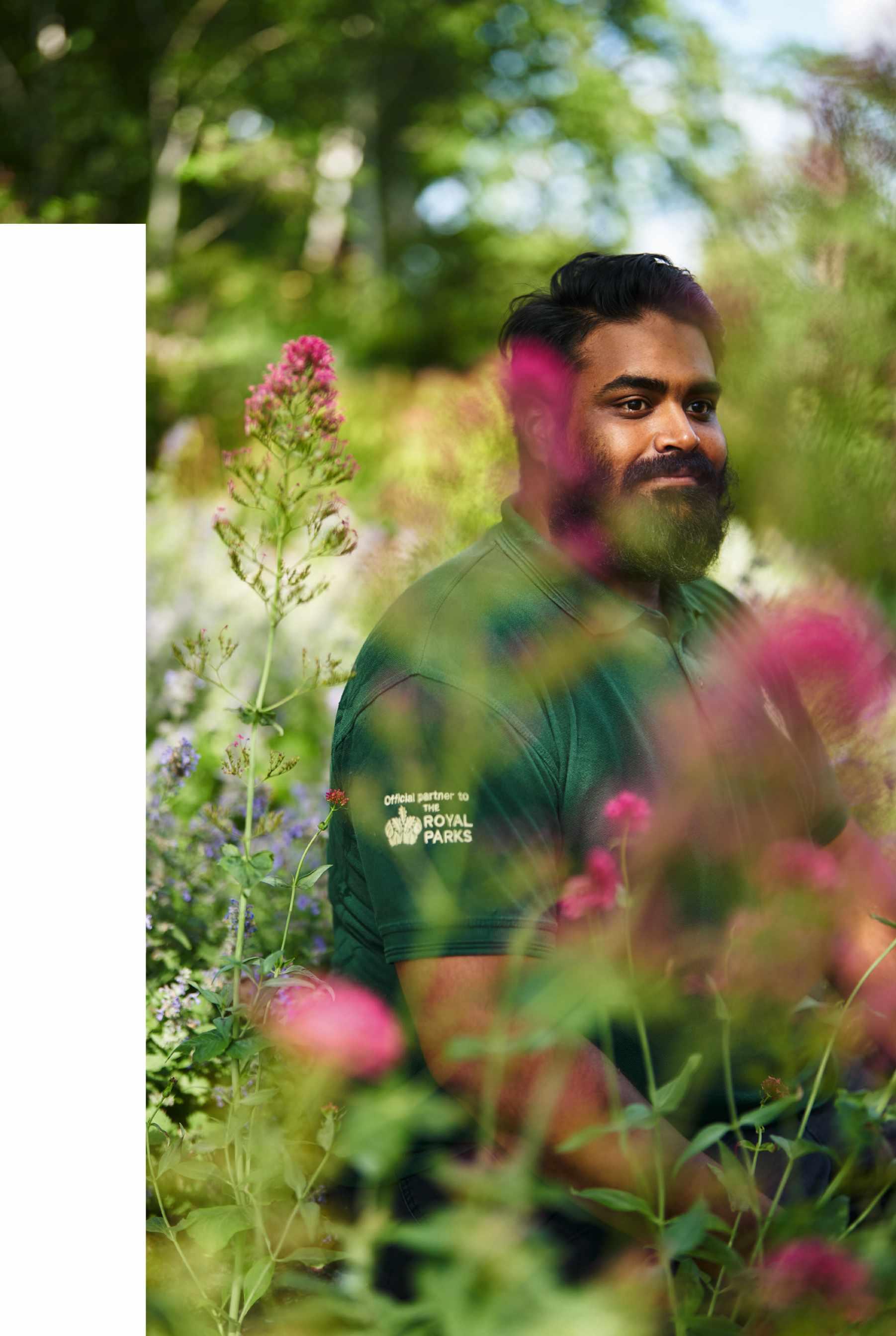
The next big project you’ll be tackling in the garden
Re-establishing shrub beds in Bushy Park, as well as installing a sustainable irrigation system. Aim in your gardening career To complete a sustainability management course and bring this knowledge and expertise into these wonderful green spaces of London. Contact Jay Rathod’s Instagram @bluejgardener
Find out more about the gardens managed by the Royal Parks at royalparks.org.uk
I think there will be more diversity in the community of gardeners, which will hopefully bring different heritages to life in horticulture
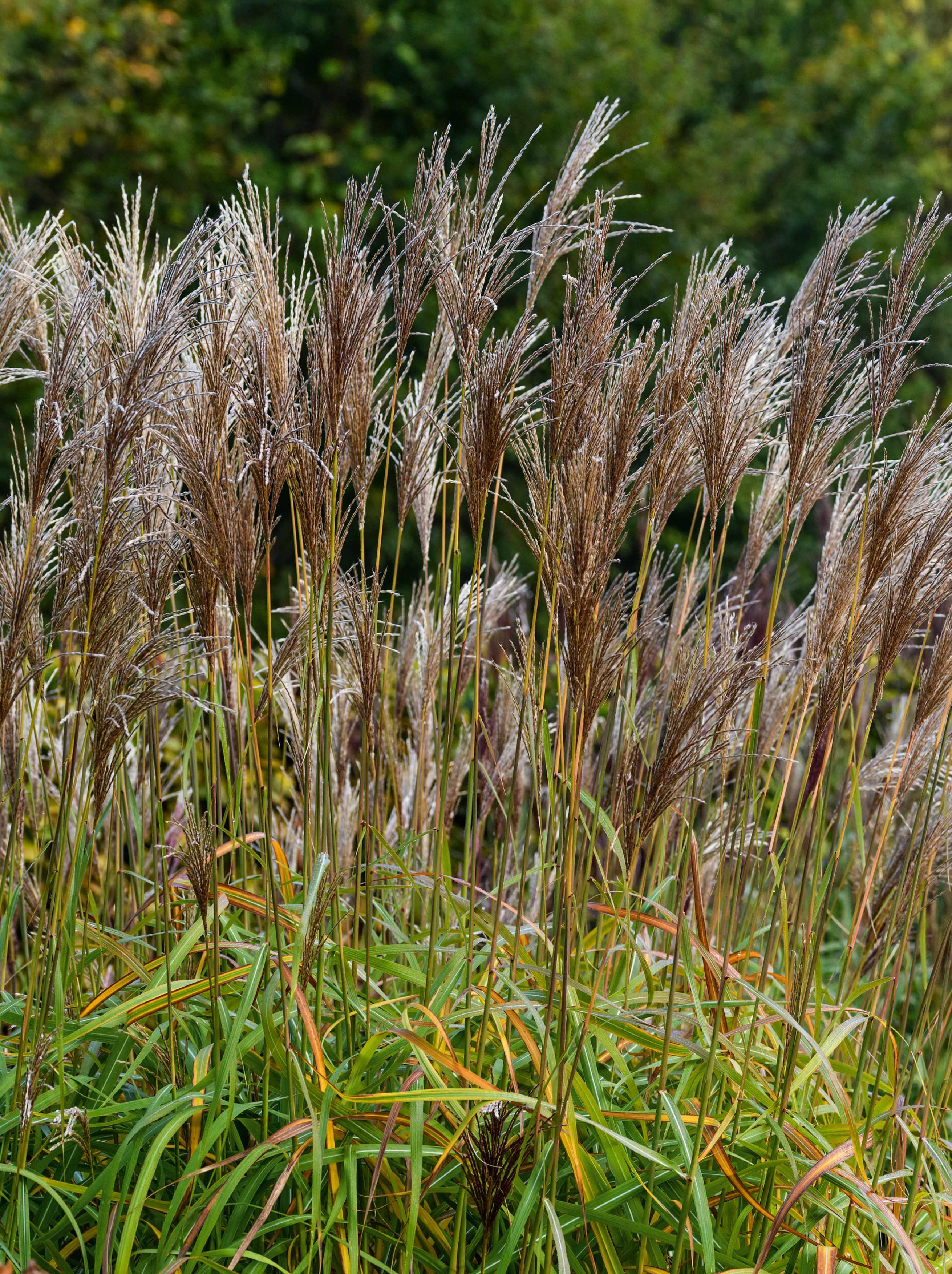
These enthusiastic ornamental grasses are superb performers, whether used in borders, prairie-style planting schemes or for bold, simple drifts in the garden
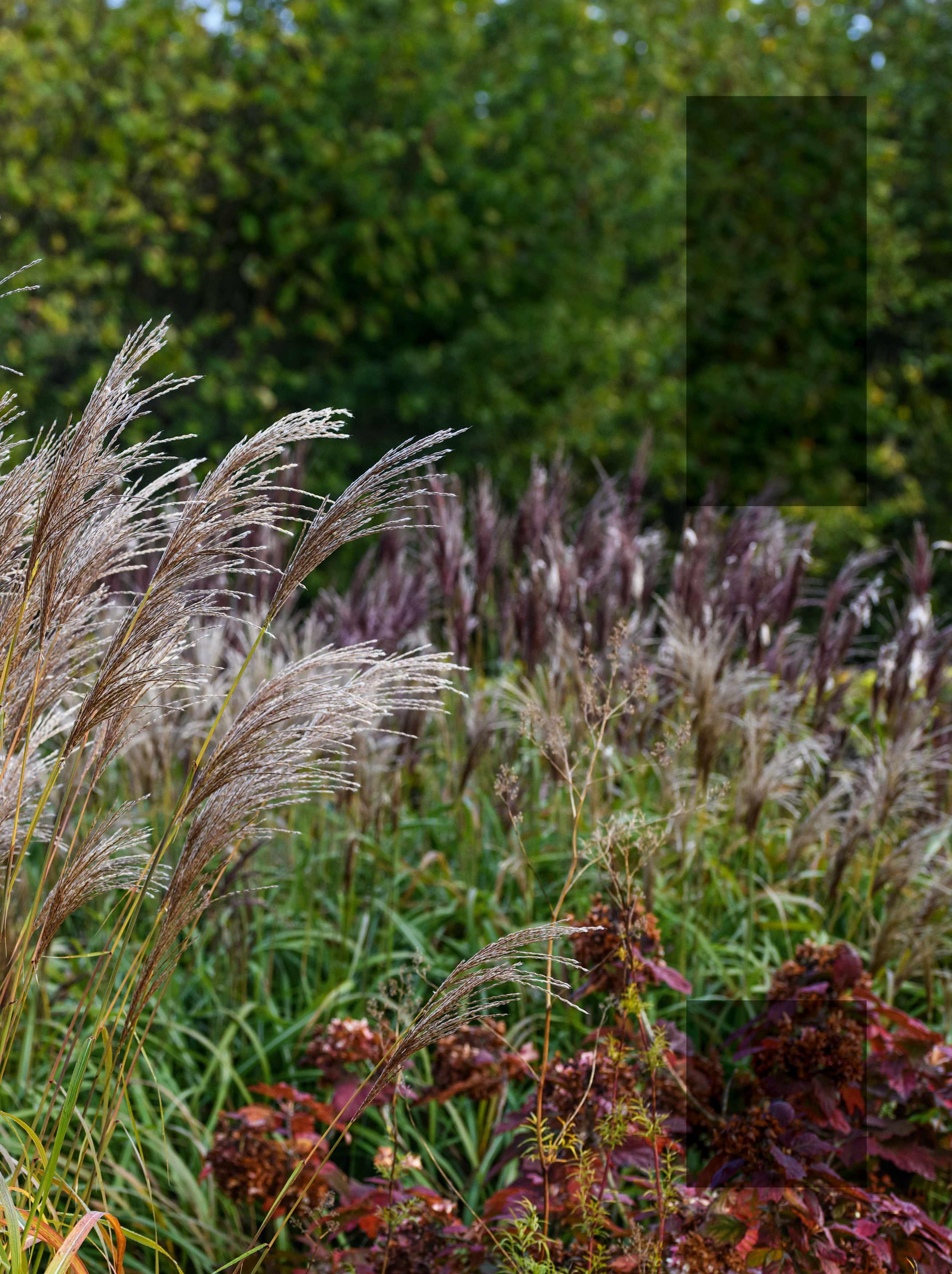
What Reliable, upright, deciduous grasses with feathery flowers in late summer to autumn.
Commonly known as silver grass and eulalia grass.
Origins Asia, China, Japan, Korea.
Season Summer to late winter.
Size 1.2-4m high, 1-2m wide.
Conditions Sunny, open position and with soil not too wet in winter.
Hardiness Generally hardy in the UK. Most have a hardiness rating of RHS H6, and are suitable for gardens in USDA zones 4a to 9b.
*Holds an Award of Garden Merit from the Royal Horticultural Society.
†Hardiness ratings given where available.
Miscanthus sinensis ‘Malepartus’
An old established selection and one of the best for garden use for its upright nature and wide green leaves, topped with purplish-red flowers in summer before its fabulous autumnal performance. Height and spread: 2.1m x 1.2m. RHS H6†
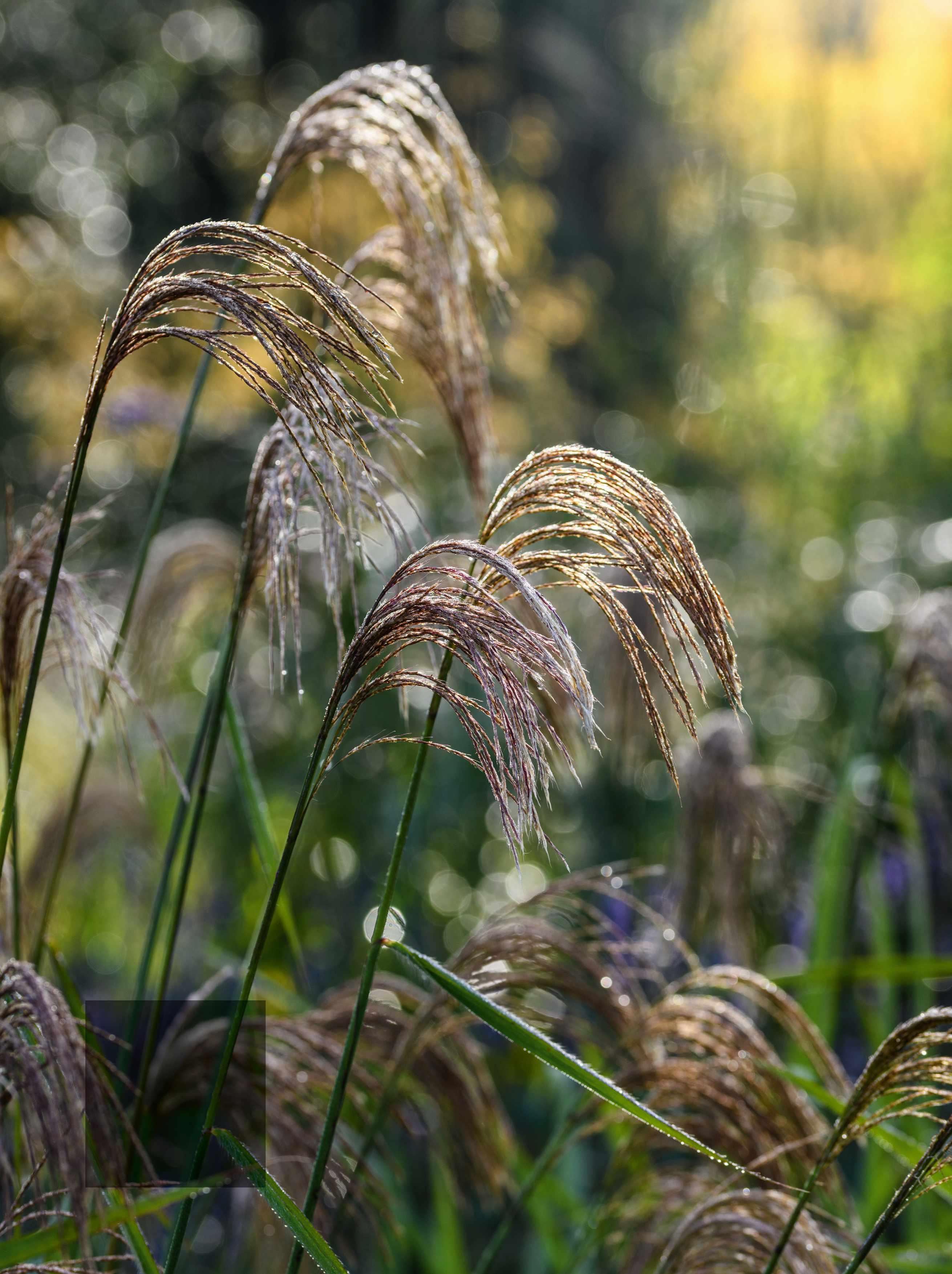
Unfading golden flowers produced on gently splaying stems arising from basal clumps of green foliage typify this species. Less hardy than other Miscanthus, requiring a sunny, well-drained and sheltered spot. Comes true from seed. 1.5m x 1m.
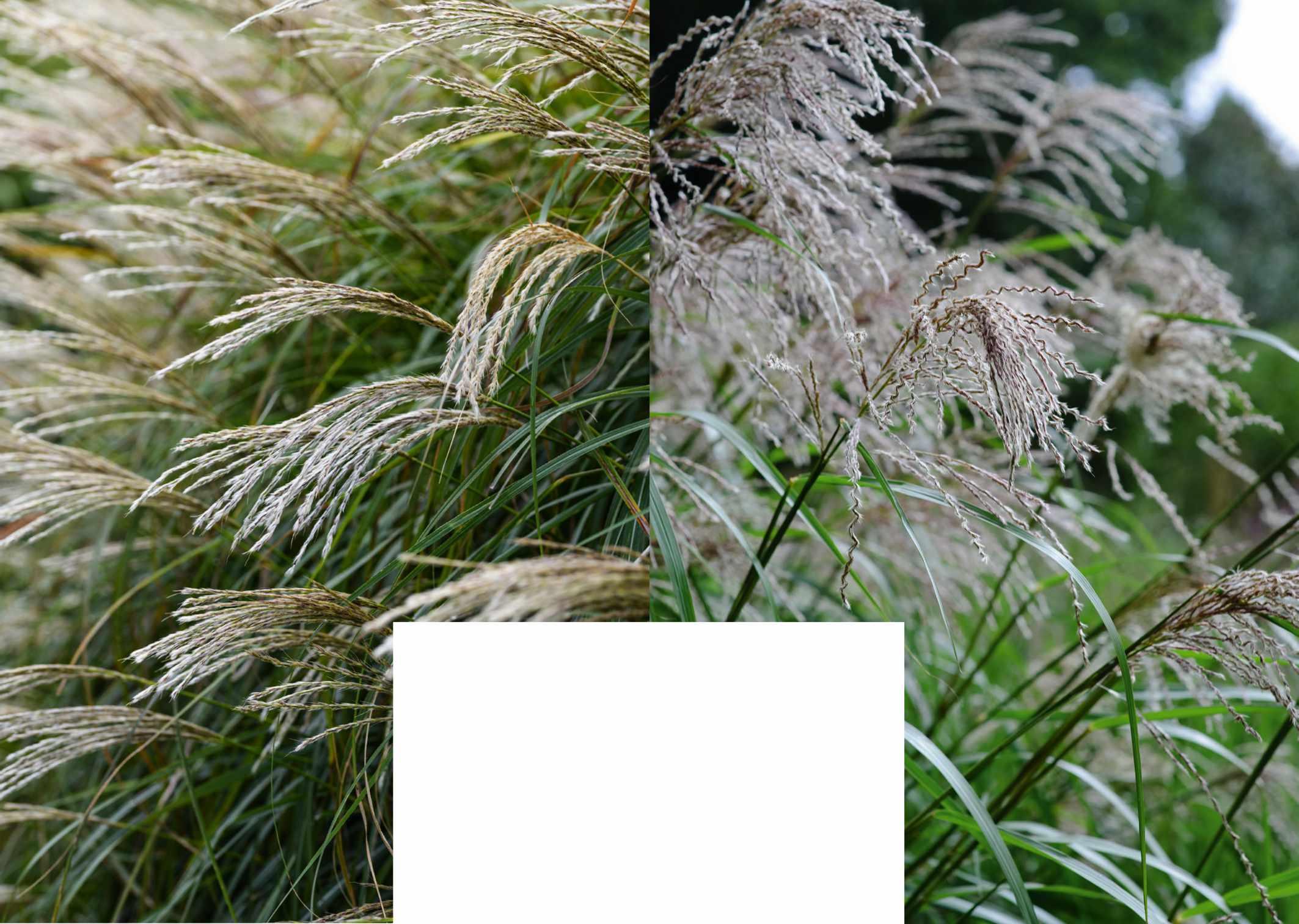
Miscanthus sinensis ‘Starlight’
A compact selection from the ‘Yaku Dwarf’ group and chosen for its rounded outline, relatively narrow foliage and extremely free-flowering nature. Excellent as a low screen. Initially slow growing. 1.2m x 1m. RHS H6.
Grown primarily for their masses of highsummer flowers, Miscanthus have been present in our gardens for a very long time. Victorian gardeners, for example, would use variegated forms such as Miscanthus sinensis ‘Zebrinus’ as ‘dot’ plants within their complex bedding schemes. Although this remains an excellent garden cultivar today, with its yellow, cross-banded foliage and occasional red flowers, the emphasis on Miscanthus in our gardens has since largely moved from foliage to flower.
Miscanthus can be characterised as tall, deciduous, generally upright, warm-season grasses. This simply means that in our climate they wake up comparatively late in the spring but then have the capacity, temperature permitting, to grow at a fast pace. Most flower initially around June to July, although – given the late springs we have recently been experiencing – flowering can be some weeks later.
Like many other warm-season grasses, such as Pennisetum and Panicum, the combination of fast growth, fresh flower and numerous, subtle, autumnal variations to both foliage and flower allow Miscanthus to be effective in our gardens for a large part of the year. Take, for example, the long-established and hugely impressive selection M. sinensis ‘Malepartus’, whose strongly upright habit and dark reddishpurple flowers remain the standard by which many a newer selection is judged.
Miscanthus sinensis ‘Roland’
Relatively large, almost hand-like, soft, silvery-pink flowers are produced during high summer at the top of tall, airy, slightly crinkled stems. One of the tallest in flower with comparatively large, wide leaves. 2.7m x 1m. RHS H6.
With the onset of cooler nights, and as the flowers gradually fade through silver and beige, the foliage turns from green to a deep, glorious yellow and then finally to myriad shades of brown, to stand resolute and largely intact deep into the winter.
There have been numerous selections over the years, mostly from the clump-forming Miscanthus sinensis, offering flowers that vary significantly in shape and colour, from dark purplish-reds through numerous shades of pink, silver and white. M. sinensis ‘Ferner Osten’ is another first-class, dark-red-flowered selection. At around 1.8m, it has a rounded habit and orange-tinted autumn foliage. Pinkflowered selections range from the jewel-like, silvery pink of M. sinensis ‘Emmanuel Lepage’ and the delicately pendulous soft pink of M. sinensis ‘Flamingo’, through to the darker, luscious pink of M. sinensis ‘Andante’. M. sinensis ‘Cindy’ is a more recent form, producing masses of soft-pink, pendulous flowers on relatively compact mounds. Most of these will fade to silvery white as they age but some, such as the elegantly tall M. sinensis ‘Silberfeder’, are a mix of silvers and white as they open.
Since Victorian times, the emphasis on Miscanthus in our gardens has moved from foliage to flower
While most Miscanthus are taller than they are wide, ranging in height from around 1.5m to over 3m, those selections from the island of Yakushima in Japan are noticeably more compact and present a more rounded outline that can be as wide as they are high, ranging from 1-1.5m. Producing masses of soft, silvery-white flowers, these are known collectively as
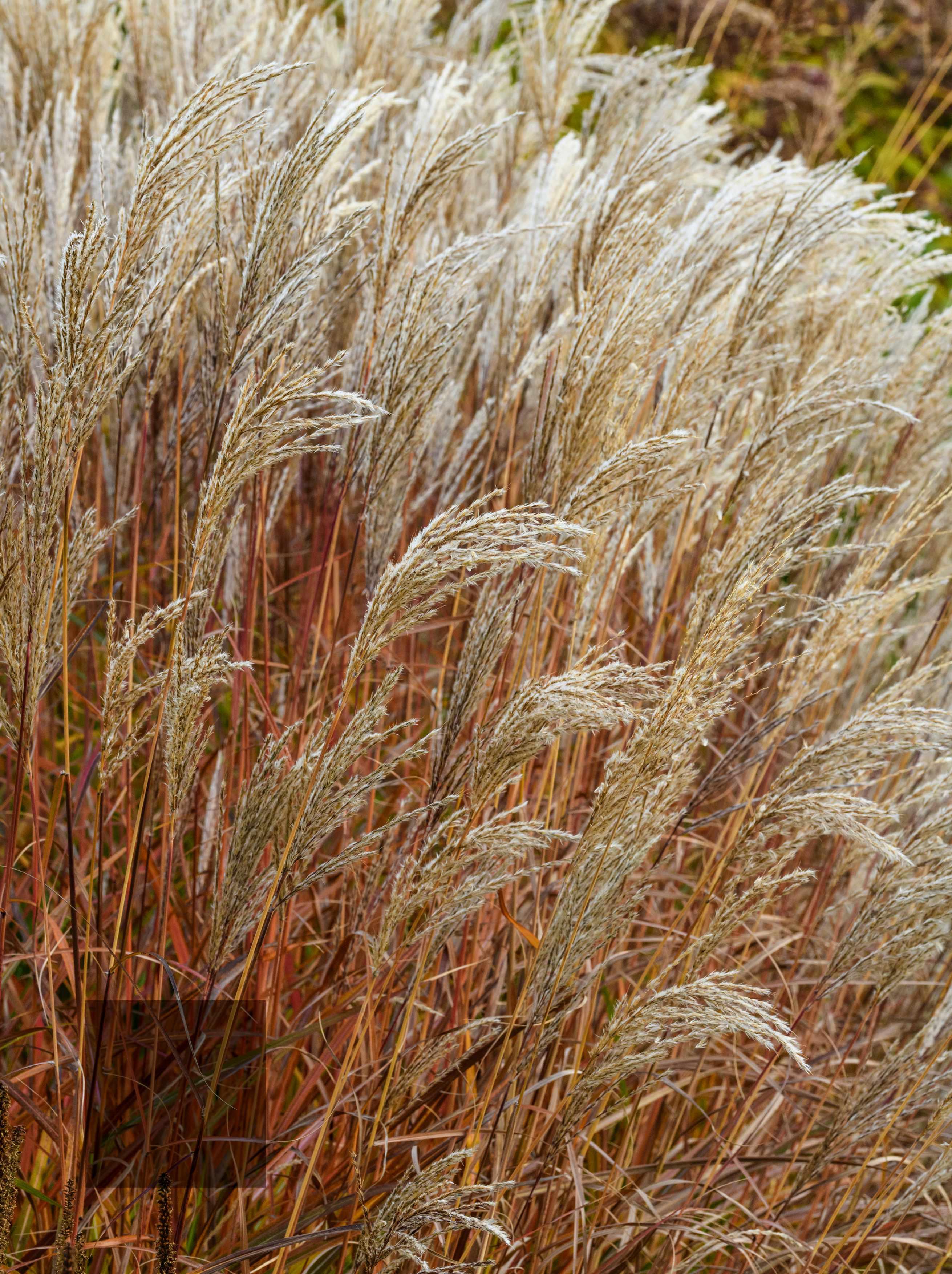
‘Ferner Osten’
A long-established, deservedly popular selection, offering dark purplish-red flowers in high summer, a rounded habit and impressive copper- and orange-tinted autumnal foliage. Excellent for general garden use. 1.8m x 1m. AGM*. RHS H6.
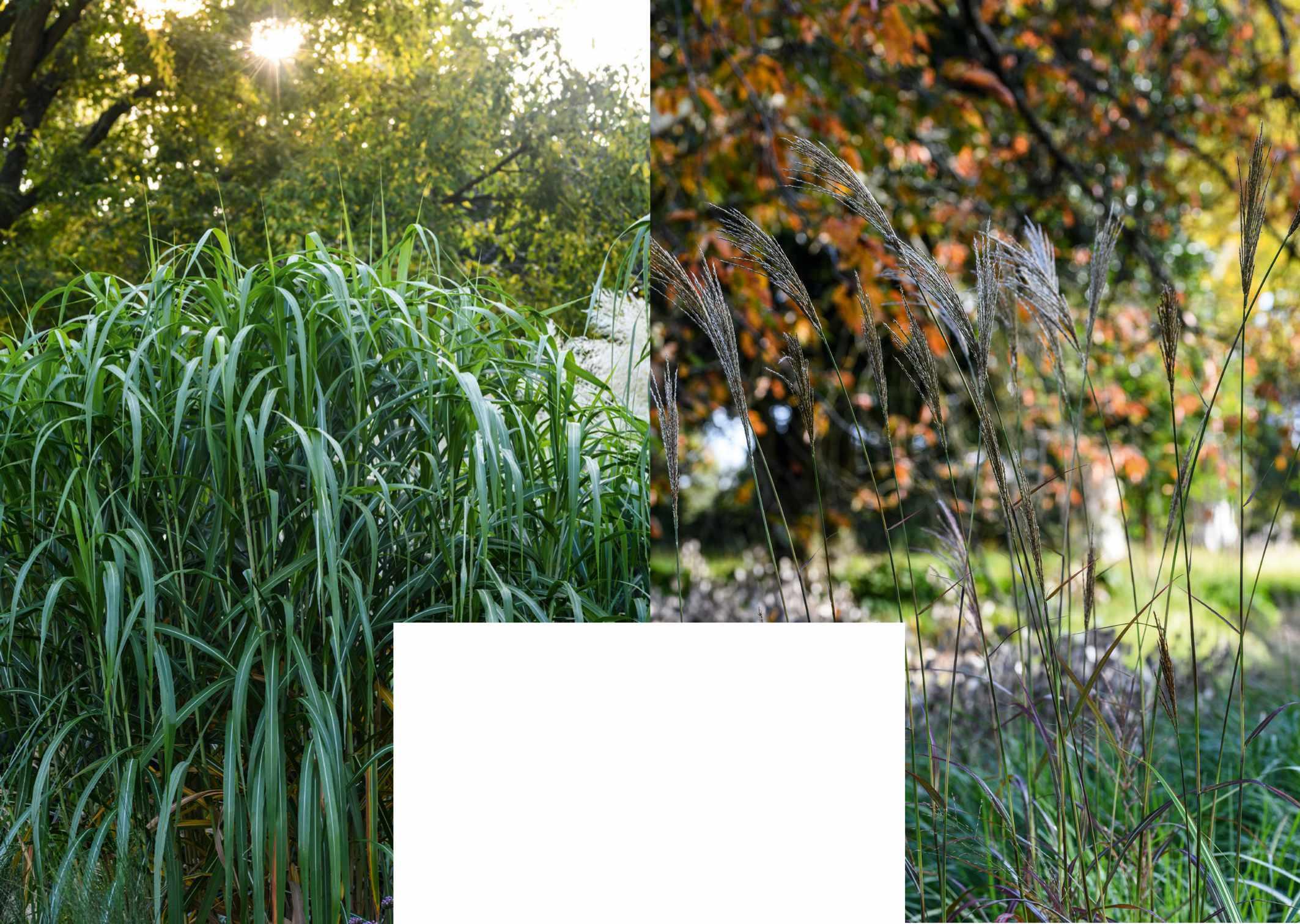
Miscanthus x giganteus
About the tallest grass to be grown in the UK, this giant, with its pendulous, dark-green leaves with pale, silvery midribs, is unrivalled as an informal screening plant or as a green-foliaged accent in mixed plantings. Seldom flowers in the UK.
3.5m x 1.2m. RHS H6.
• Like all tall, flowering grasses, Miscanthus put on a great deal of growth in spring and require the energy derived from direct sunlight to fuel this process. Consequently, they need an open, sunny position in order to grow and flower successfully in the long term. A few, such as the M. ‘Yaku Dwarf’ types, can be convinced to grow in something less than full sunshine, but as a general rule, the more sun, the more flower, and vice versa.
• Miscanthus will cope with a variety of soils, from sand to quite heavy clay. Wet winter soil can be an issue, especially in the short term, as the young grasses may simply rot before they have a chance to establish an adequate root system.
• Planting can be done at any time of year that the soil is ready to receive the plants. For winter-wet soils it may be best to plant in the spring, while for summer
Miscanthus ‘Red Spear’
A new selection from M. transmorrisonensis with a strongly upright habit. Produces tall stems topped with tight, spear-like buds that burst into bright-red flowers held clear above the foliage.
2.1m x 1m. RHS H6.
drought-prone areas, autumn might be the optimum time.
• A surface mulch after planting is good practice as it will be useful for controlling weeds and helping to conserve essential soil moisture. Any organic material will do, including compost, bark, stable manure or commercially available mulch products.
• Unless the soil is extremely poor, little additional feeding is required, especially if an organic mulch is being used. If an additional feed is felt to be necessary, any general balanced fertiliser should be fine.
• All Miscanthus are deciduous, with the dried stems and flowers of most standing more or less intact over winter. As winter draws to a close, the stems should be cut down to the base and either taken away and composted or kept in situ to act as a home-produced mulch. If left on the
surface, cut the stems into lengths of around 20-30cm for a more effective and pleasing cover. Timing depends a little on geographical area and weather, but ideally any time from February onwards.
• The Chelsea chop is a useful technique to reduce the height of a plant that might otherwise get too tall for its position. Simply cutting the new foliage down to the base in May reduces the time left for a Miscanthus to grow before it flowers and so shortens its overall height.
• Miscanthus are long-lived grasses that may not need any additional attention for many years. In some soils, the central section may gradually die away or otherwise fail to perform. Dividing the plants in spring, ideally just as they begin to wake up, is a well-established method for keeping plants healthy and vigorous, or simply when more plants are required.
Miscanthus sinensis ‘Silberfeder’
This tall selection has upright stems of deepgreen foliage with a silver midrib, and large, silvery, buff-pink flower plumes held clear above the leaves in late summer. 2.1m x 90cm. AGM. RHS H6.
Miscanthus sinensis ‘Morning Light’
Gracefully arching, finetextured, cream and green foliage gives this form a distinct lightness and shape. Topped with pinkish flowers in some summers. 1.8m x 1.2m. AGM. RHS H6, USDA 5a-9b.

Miscanthus sinensis ‘Flamingo’
A superb selection with a generally rounded habit. Produces many elegant, slightly pendulous, initially dark-pink flowers. The foliage generally turns golden-yellow in autumn. 2m x 90cm. AGM. RHS H6.
Miscanthus sinensis ‘Cindy’
A relatively recent selection with a noticeably rounded habit. Produces many dainty, soft-pink, slightly pendulous flowers on gently splaying stems held clear of the foliage. 1.5m x 1m. RHS H6.
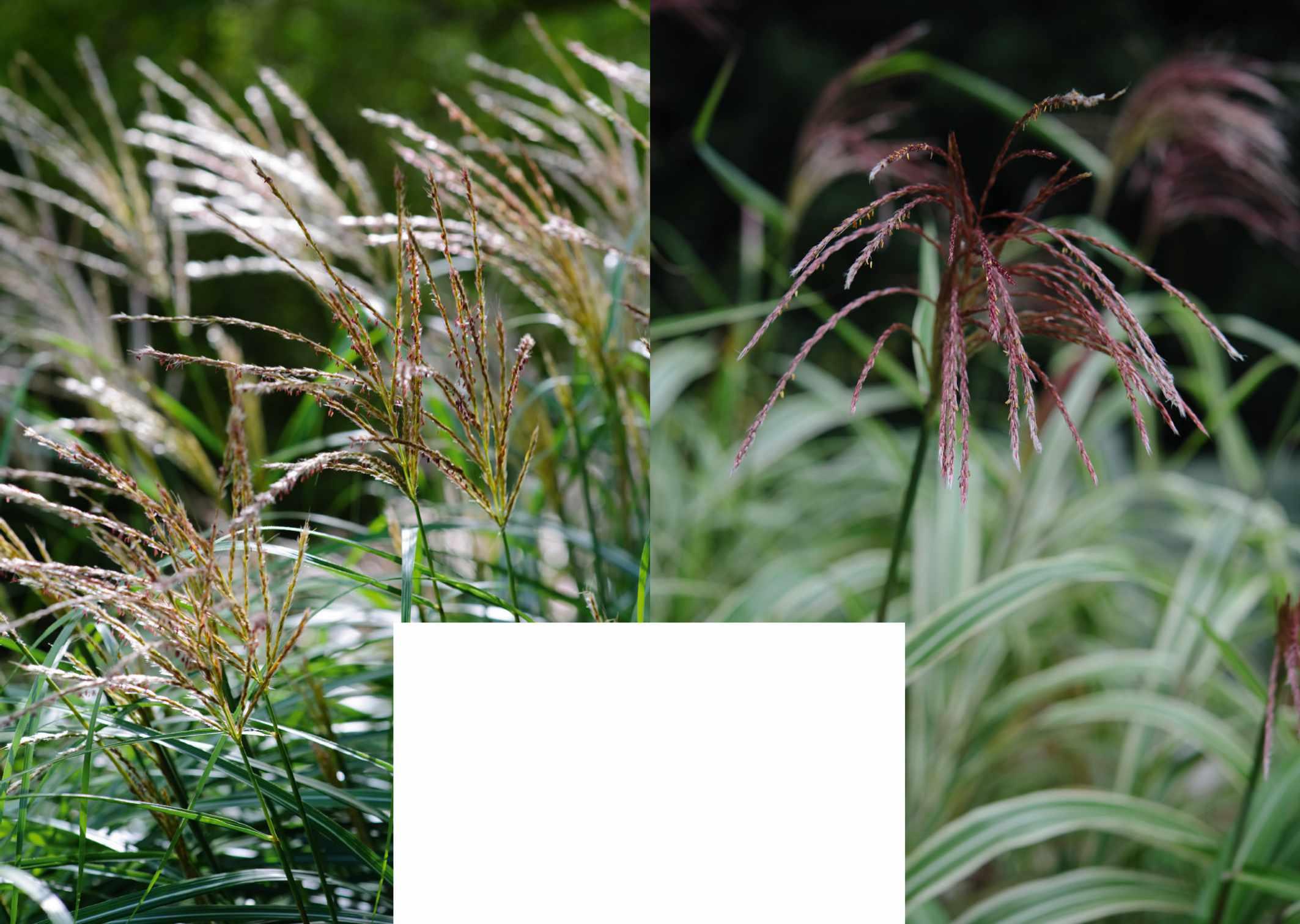
Miscanthus sinensis ‘Abundance’
This is one of the taller selections from the M. ‘Yaku Dwarf’ group and it offers a similar, distinctive, rounded habit. It produces masses of soft, silvery-buff to white flowers. 1.5m x 1m. RHS H6.
Miscanthus sinensis var. condensatus ‘Cosmopolitan’
A superb foliage plant with wide, ribbon-like, clear-green and creamywhite-striped leaves. May produce red flowers in some summers but choose it for its sumptuous foliage. 2m x 1m. AGM. RHS H6.
M. ‘Yakushima Dwarf’ or ‘Yaku Dwarf’ and are actually not one selection or cultivar but a mix of compact seedlings that can vary significantly. This has led to a number of specific selections including M. sinensis ‘Abundance’, ‘Starlight’ and ‘Gnome’, which, though subtly different from each other, retain the same compact, rounded and free-flowering nature.
All Miscanthus offer movement, their stems, leaves and flowers all moving gracefully in even a slight breeze, and rustling seductively with the stronger gusts. Many can be used as informal screening or hedging, which, while not evergreen and so not ideal as a permanent boundary screen, can offer seasonal seclusion and division of space. M. sinensis ‘Gracillimus’ is a shyflowering form with a distinctive rounded habit often recommended for such uses, but many others will serve, simply planted in a linear fashion at 1m spacing or slightly closer. The ultimate Miscanthus for screening is perhaps the hybrid Miscanthus x giganteus, or one of its parents, the very similar M. sacchariflorus. Both can reach upwards of 3m in a season and are also a source of biofuel. It is difficult not to be impressed with the simple magnificence of these super-tall grasses as their bright-green leaves gently cascade downwards in a veritable waterfall of foliage and movement.
All Miscanthus offer movement, their stems, leaves and flowers all moving gracefully in even a slight breeze
with very distinctive and generally upright flower stems topped by flowers that are held noticeably clear of the foliage. On some selections (that may be part M. sinensis), such as M. ‘Professor Richard Hansen’, the gap between foliage and flower can be 60cm or more. Such a clear gap creates a distinctive aesthetic effect, and with similar new selections, such as M. ‘Sunset’ and M. ‘Red Spear’, soon to be available, this elegant addition to the repertoire perhaps marks a further chapter in the continuing success story of Miscanthus in our gardens. ■
Neil Lucas is the owner of Knoll Gardens in Dorset, and a leading ornamental grass specialist.
Where to see and buy
• Ashwood Nurseries Ashwood Lower Lane, Kingswinford, West Midlands DY6 0AE. Tel 01384 401996, ashwoodnurseries.com
• Beth Chatto’s Plants and Gardens Clacton Road, Elmstead Market, Elmstead, Colchester, Essex CO7 7DB. Tel 01206 822007, bethchatto.co.uk
• Knoll Gardens Stapehill Road, Wimborne, Dorset BH21 7ND. Tel 01202 873931, knollgardens.co.uk
The less common Miscanthus transmorrisonensis offers a similar mound-forming habit to the more prevalent Miscanthus sinensis but
• Meadowgate Nursery Street End Lane, Sidlesham, West Sussex PO20 7RG. Tel 07736 523262, meadowgatenursery.co.uk
What Small, private, urban garden.
Where London.
Size Approximately 10m x 6m.
Soil Imported sandy topsoil to replace paved areas with planting beds.
Climate Temperate and southwestfacing, but partly shaded by trees and surrounding buildings.
Hardiness zone USDA 9.
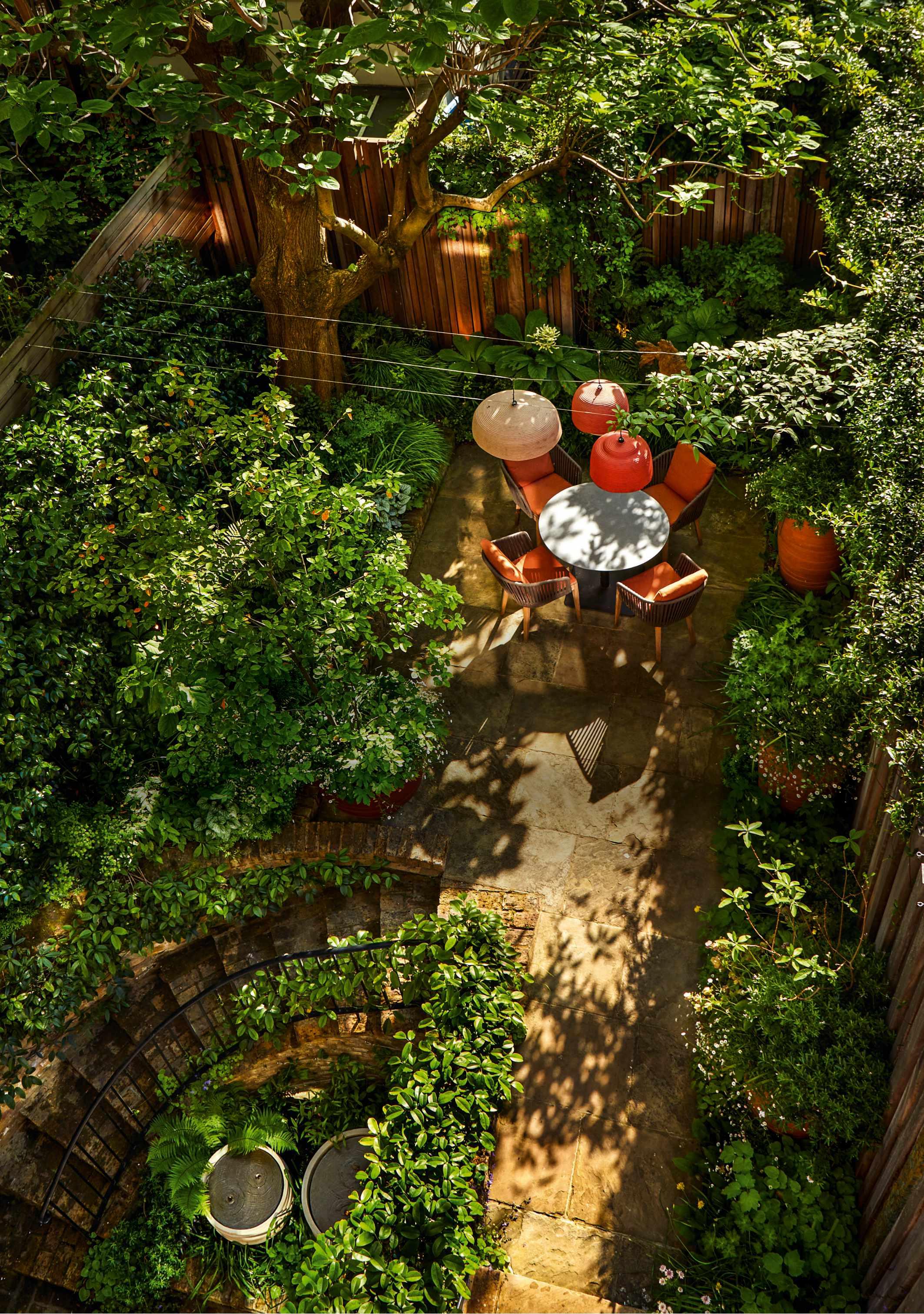
In this small London garden, designer Stefano Marinaz opted for dense planting lifted by the rich tones of the hard landscaping and furnishings
WORDS KATE JACOBS PHOTOGRAPHS ALISTER THORPE
Stefano Marinaz has dramatically increased the planted areas of this small, split-level garden. The existing York stone paving has been relaid in bands of varying widths to create enough space for a seating area. Shades of terracotta and off-white recur throughout the space via the pots, lighting and furniture.
Above The garden couldn’t accommodate another big tree in addition to the existing Catalpa bignonioides, so Stefano added a large pot with a multi-stemmed Amelanchier x lamarckii that filters the views of the garden from the conservatory.
Left Along one side of the garden, the planting is interspersed with tall Atelier Vierkant pots, creating a sense of rhythm. These are filled with plants including Erigeron karvinskianus and Daphne x transatlantica Eternal Fragrance (= ‘Blafra’).
Below At lower-ground level, two large, off-white pots illuminate this shady part of the garden and create a water feature, fringed by planting including ferns Dryopteris affinis and Athyrium niponicum var. pictum ‘Silver Falls’.
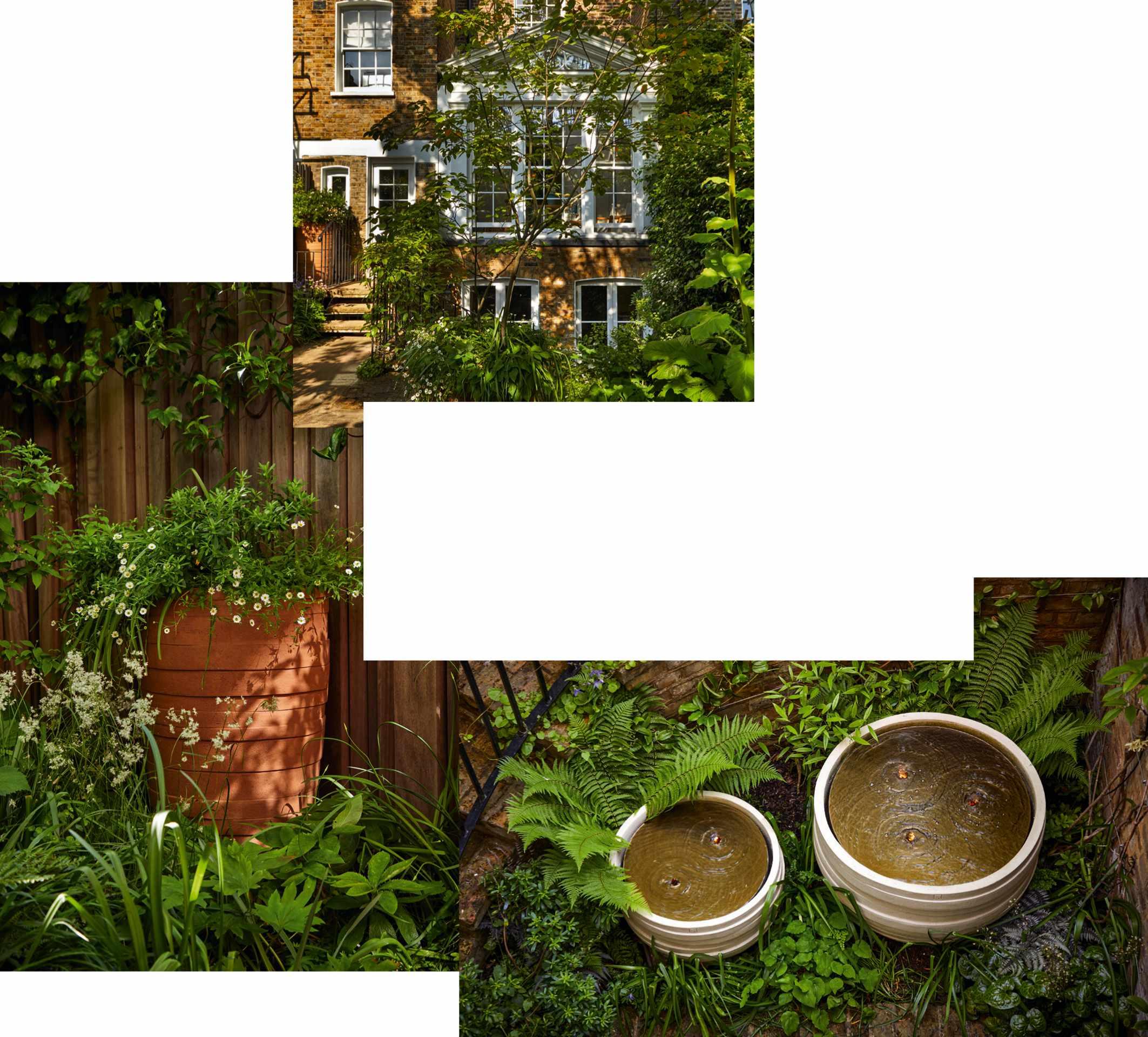
Landscape architect Stefano Marinaz does not believe in change for change’s sake. When he was asked to work on this back garden in London’s Chelsea for the couple who live there, he was keen to evaluate its existing strengths and weaknesses. “On every project, I always ask myself why we need to change existing features. If there isn’t a good reason, then we don’t,” he explains. Back then, in 2016, the garden was given over to York stone crazy paving, with only a skinny border of planting around its edges. The boundary fences were mismatched, while a curving staircase of grimy London stock bricks led down to a small pond at lower-ground level. “The flat fence drew your eye right to the end of the long, narrow plot rather than contributing to the beauty of the garden,” says Stefano.
The whole space was shaded by a mature Catalpa bignonioides tree, which Stefano was keen to preserve, “because of its aesthetical value”. It is now pollarded back to a height of five metres every three years. The Catalpa and the shade it provides inspired the woodland planting scheme here. “A shady garden has become more welcome during our increasingly hot summers,” says Stefano. He dramatically increased the planted areas to cover more than half of the garden, with deep beds along one side – around the base of the tree – and at the back of the garden, so that the owners feel immersed in greenery. “I like to keep the hard landscaping simple and maximise plant diversity. I’m always keen to celebrate the beauty and variety of nature; it’s good for the owners to have interest through the seasons and for biodiversity too.”
Starting the growing season with “spring ephemerals”, from Galanthus nivalis to Narcissus ‘Thalia’, Stefano relies on emerging perennials such as Epimedium x rubrum and Epimedium x warleyense ‘Orangekönigin’ to hide the bulbs’ yellowing leaves. Then there’s the interest from lime-coloured bracts of Euphorbia amygdaloides var. robbiae and Luzula nivea flowers as well as foliage plants such as Brunnera macrophylla ‘Jack Frost’. Cardiocrinum giganteum, with its tall spikes of trumpet-like flowers, is planted
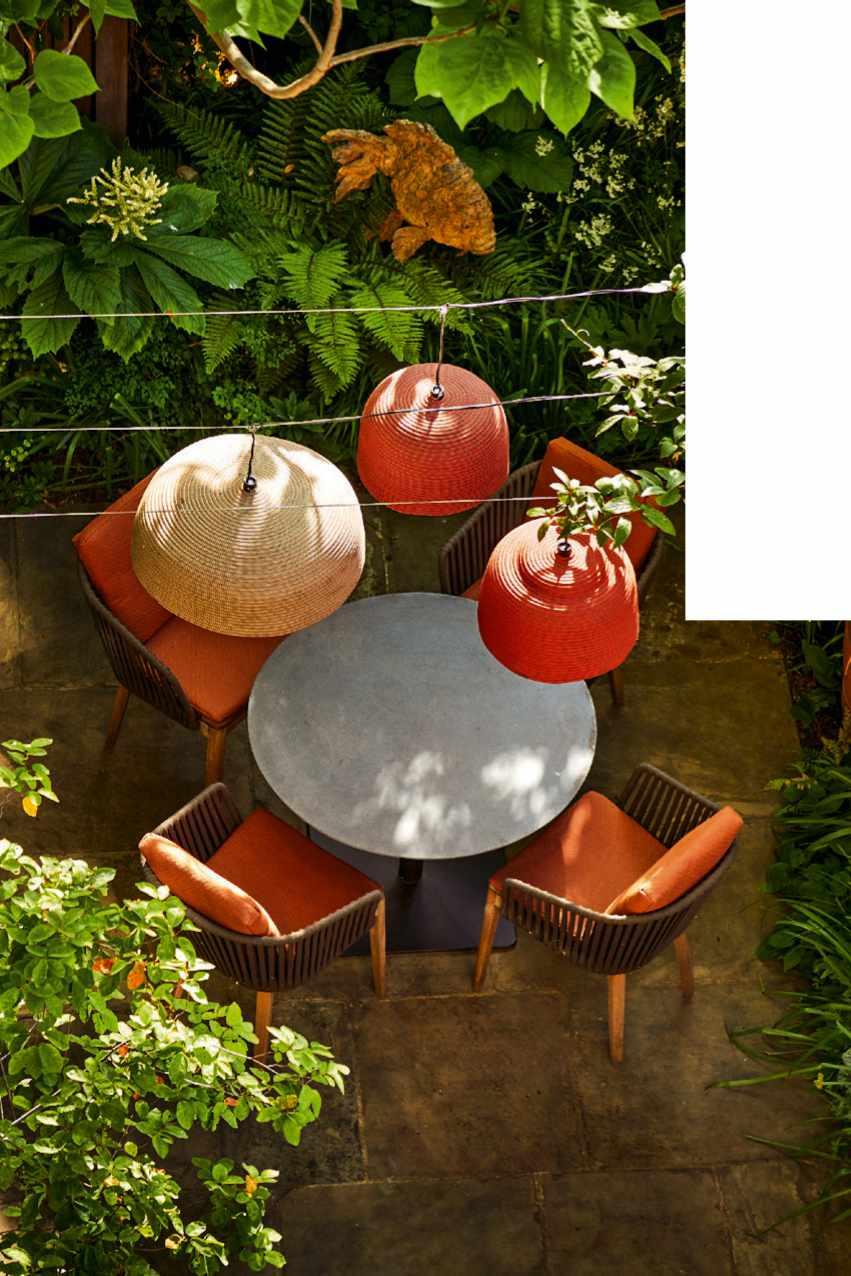
Left The small size of this garden made it easy to run overhead wires across the space, allowing for the suspension of outdoor pendant Taiki lights by Paola Lenti in different colours and sizes, to bring light to the seating area, which is sited away from the house.
Right Two of the boundary fences combine Iroko slats of varying widths and depths with bronze uprights, cast using intricate timber moulds, to create rich but subtle visual interest.
Below A fish sculpture mounted on a simple, black-painted steel plinth appears to float above the textural perennials to the rear of the garden, including Rodgersia aesculifolia Luzula nivea and Mukdenia rossii
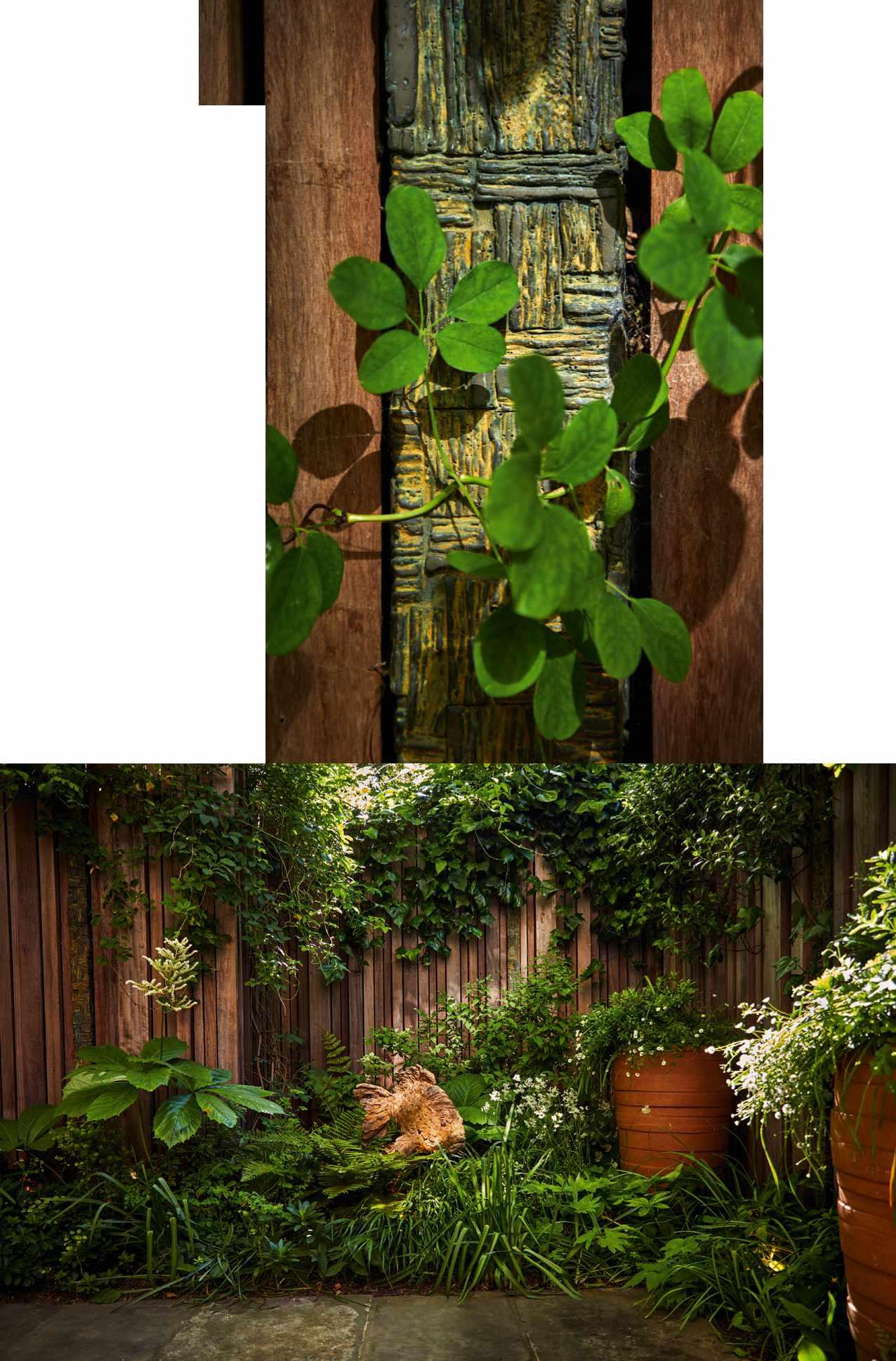
in clusters of three. “They don’t flower every year, so I plant them in a clump and hope that one will flower each summer.” Mukdenia rossii was chosen for both its autumn colour and spring flowers, and Rodgersia aesculifolia for the way its foliage catches the light. As the garden is overlooked by the house, there’s an emphasis on evergreen planting with Daphne odora ‘Aureomarginata’ and Trachelospermum jasminoides, while winter scent comes from shrubs such as Sarcococca confusa and Edgeworthia chrysantha ‘Red Dragon’.
The materials palette is full of rich but subtle texture and patina. The York-stone paving was taken up and partially relaid – in bands of differing widths – with just enough paving to comfortably site a table and to access the steps. The brick around the steps needed only a good clean to restore its mellow tones, with the gloomy pond replaced by a pot-based water feature, nestled among lush ferns.
The boundaries needed careful attention. Stefano opted for Iroko, with four different widths and depths of timber, to disrupt the contours of the garden, disguising an awkward ‘L’ shape at the rear of the plot. Set into the fence at irregular intervals are sculptural bronze uprights, imprinted with the form of the timber mould used in their construction – creating an intricate but low-key textural detail.
The rich tones of the Iroko, bronze and terracotta are picked up in the garden furniture and lighting, bringing a sense of warmth to this shady space. The table, sited away from the house, needed its own light source. Stefano opted for a cluster of pendant lights that make the garden feel enclosed and private. “Given the small size of the garden, we were able to tension three stainless-steel cables to attach the lights, each with a different size, colour and hanging height, so there’s a sense of movement.” The colours and curving forms echo those of the pots, adding to the pleasing sense of coherence in this small garden. ■
USEFUL INFORMATION
Find out more about Stefano’s work at stefanomarinaz.com
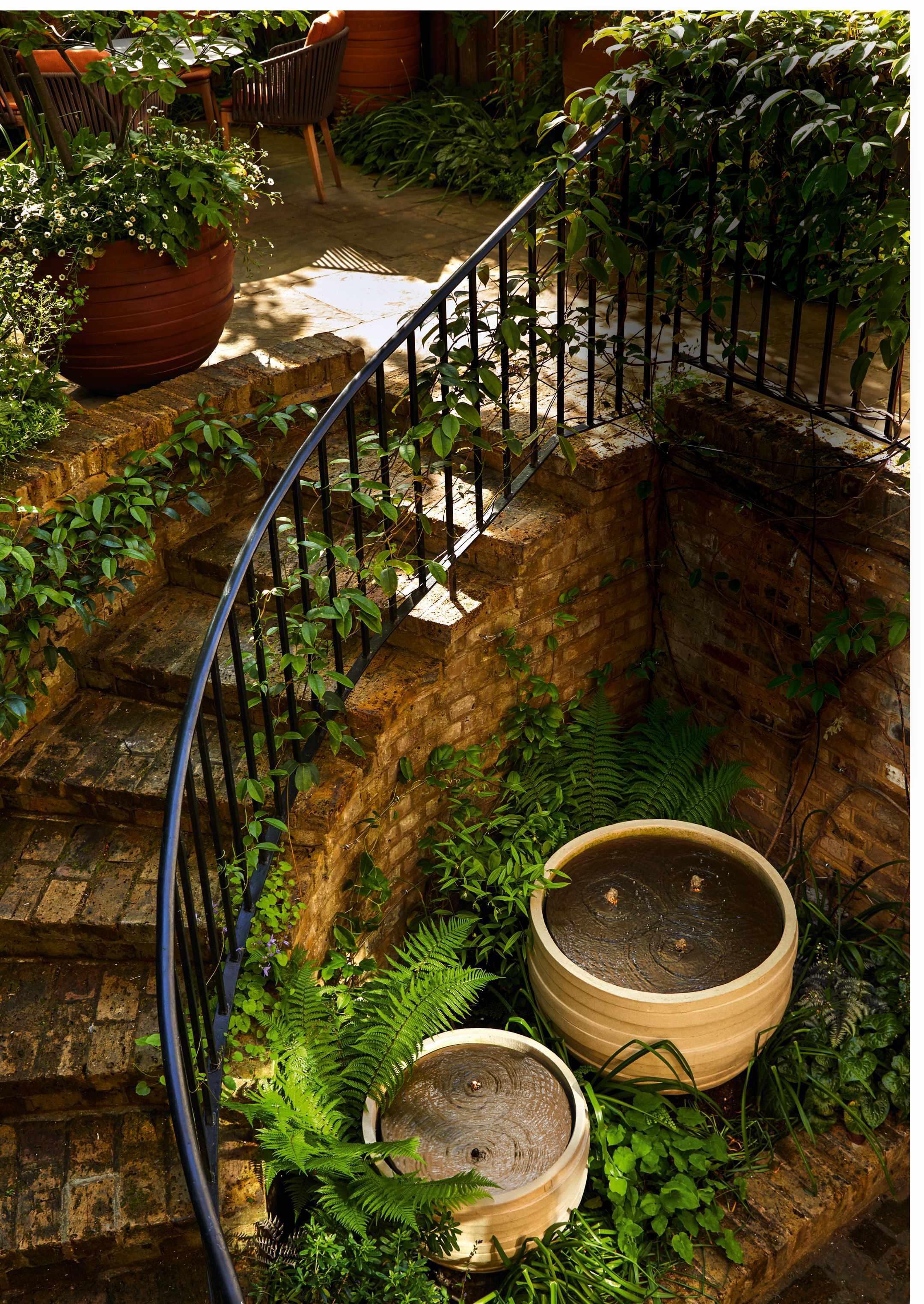
Water features can do so much for a small garden; they create focal points, and encourage wildlife, and the soft murmur of water brings a sense of tranquillity. Here, Stefano has created a water feature using two Atelier Vierkant pots, which the Belgian pottery waterproofed specially. These are the same shape as the terracotta ones used in the main garden, but with a white finish to brighten this lower-ground level area. On to these, Stefano has set two custom-made Rimex discs, with a textured bronze finish, punched with holes through which the water bubbles up, each with a little LED light to give them a subtle glow after dark.
A simpler option, which Stefano chose for his own garden, is to use a fibreglass pot, without drainage holes, with a pump and LED light. He advises positioning it in full sun or part shade, with a minimum depth of around 55cm, to allow waterlilies to flourish, while marginal plants can be elevated using an upturned pot. Stefano likes to set such containers among the planting, but the pot should be sited on a concrete base if not on a hard surface. A pump is essential to avoid mosquitoes, which dislike running water, but it can be connected to a timer that creates water movement two or three times a day, Stefano sets his pump to come on for al fresco breakfasts and in the evening, when the lights ensure it remains a focal point.
The landscape designer on a childhood spent running wild in Exbury Gardens, a serendipitous choice of post-university study and a deep-seated love of drainage
WORDS ANNIE GATTI PORTRAIT PHILIP HARTLEY
For landscape designer Marie-Louise Agius, last year’s period of drought left her feeling scared. “Everything was curling in on itself, leaves were shedding and gardens were looking miserable.” This summer’s plentiful rainfall, however, has made her much happier as managing water is absolutely central to all her design schemes. “I always joke that my epitaph will say that I tried to be a landscape designer and all I ever did was talk about drainage. But if you manage the water, you can manage the land. It’s absolutely fundamental.”
Marie-Louise – whose great-grandfather was Lionel de Rothschild, creator of the 200-acre Exbury Gardens in Hampshire – has been immersed in managing landscapes for more than 20 years, since she joined landscape architect Michael Balston’s studio in Wiltshire. The practice has a range of projects but, she explains, large country estates and landscapes are their bread and butter. “I love large landscapes. With Exbury as an example of what can be done, they don’t scare me.”
Horticulture runs through her veins on both sides of her family. She grew up spending weekends and holidays at Exbury, which became a giant playground. “My happy place was outside, and with my younger sister and an older cousin I’d have adventures in the woods, make camps, tramp round the gardens.” She also loved art, and was an art scholar at school, but didn’t have the courage to study fine art at university and chose sociology instead.
With no idea what she wanted to do as a career, she signed up for a one-year garden design course at KLC School of Design in London, as a way of postponing the decision. But from the first day she discovered she loved every single part of the course. “When I look at it retrospectively, it seems obvious that this was my destiny, even though I didn’t know it at the time.” Three years in the landscape department of Clifton Nurseries co-ordinating and overseeing the implementation of projects gave her the groundwork for her future career as a designer. “Probably five per cent of what we do as designers is creative; the other 95 per cent is delivering it.”
FIVE PER CENT OF WHAT WE DO AS DESIGNERS IS CREATIVE; THE OTHER 95 PER CENT IS DELIVERING IT
An example of their inspired collaborative response to a challenging site is the landscape they designed for the cancer charity Maggie’s, at St James’s University Hospital in Leeds. The site for the building, which was to be designed by Thomas Heatherwick, was a small patch of green that had become a wind tunnel between the high-rise oncology department and the car park. Marie-Louise and Michael visited in winter. “It had a few plants dotted around, trying to brace themselves against the wind, but there was one plant, Viburnum opulus, that was heavy with berries and full of bounce. Here was the clue to reading that landscape: a native shrub that was happy as a pig in muck in such inhospitable conditions. That’s why we went down the route of a native woodland scheme for both the ground landscaping and the rooftop garden.” The native woodland concept also works on other levels. It’s an evolving landscape that offers seasonal moments (bluebells in spring, leaf colour in autumn) for the cancer patients who make repeat visits to the hospital, and it’s also what Marie-Louise describes as a “forgiving” landscape, which tolerates the odd weed appearing as long as it’s not pernicious.
As with all of Balston Agius’s projects, collaboration with the architects and all the other specialists involved was key to its success, and Marie-Louise loves this part of the job. She is clearly open to ideas and suggestions from clients, from nurserymen, from landscapers. When she was designing the Centenary Garden for Exbury, of which she is now a director, she was looking for an alternative to yew topiary or hornbeam columns to provide vertical elements in the middle of the four borders. Robin Wallis of Hortus Loci suggested fastigiate dwarf ginkgos, which Marie-Louise linked with a wave of Miscanthus sinensis ‘Graziella’. A perfect solution, she says, as the grasses and ginkgos turn wonderful shades of buttery yellow and oat in autumn.
At Michael Balston’s practice she found her design wings. “Michael trained as an architect, and as a design mentor he is second to none,” explains Marie-Louise. She recalls that when she first looked at his portfolio, what struck her was that every project was different; there was no set style. Each job was designed uniquely for that particular client and that particular site.
The importance of site analysis and of working in harmony with the landscape continues to be a mainstay of the practice, which is now run by Marie-Louise with Michael as a consultant.
Marie-Louise shares a passion for propagating with her father –they both stuff their pockets with seeds when they are walking through the garden. She loves the camaraderie between owners of other private gardens and collections, as they swap seedlings of rare and unusual plants. “People have such depths of knowledge,” she says. “I am continually humbled.”
But her most impressive classroom is Exbury itself. “Every single time I go into the gardens I notice something I’ve never seen before. It’s bonkers. You’d have thought by now I’d know these gardens inside out, but they are so vast and extensive; every day is a school day.” ■
USEFUL INFORMATION
Find out more about Marie-Louise’s work at balstonagius.co.uk

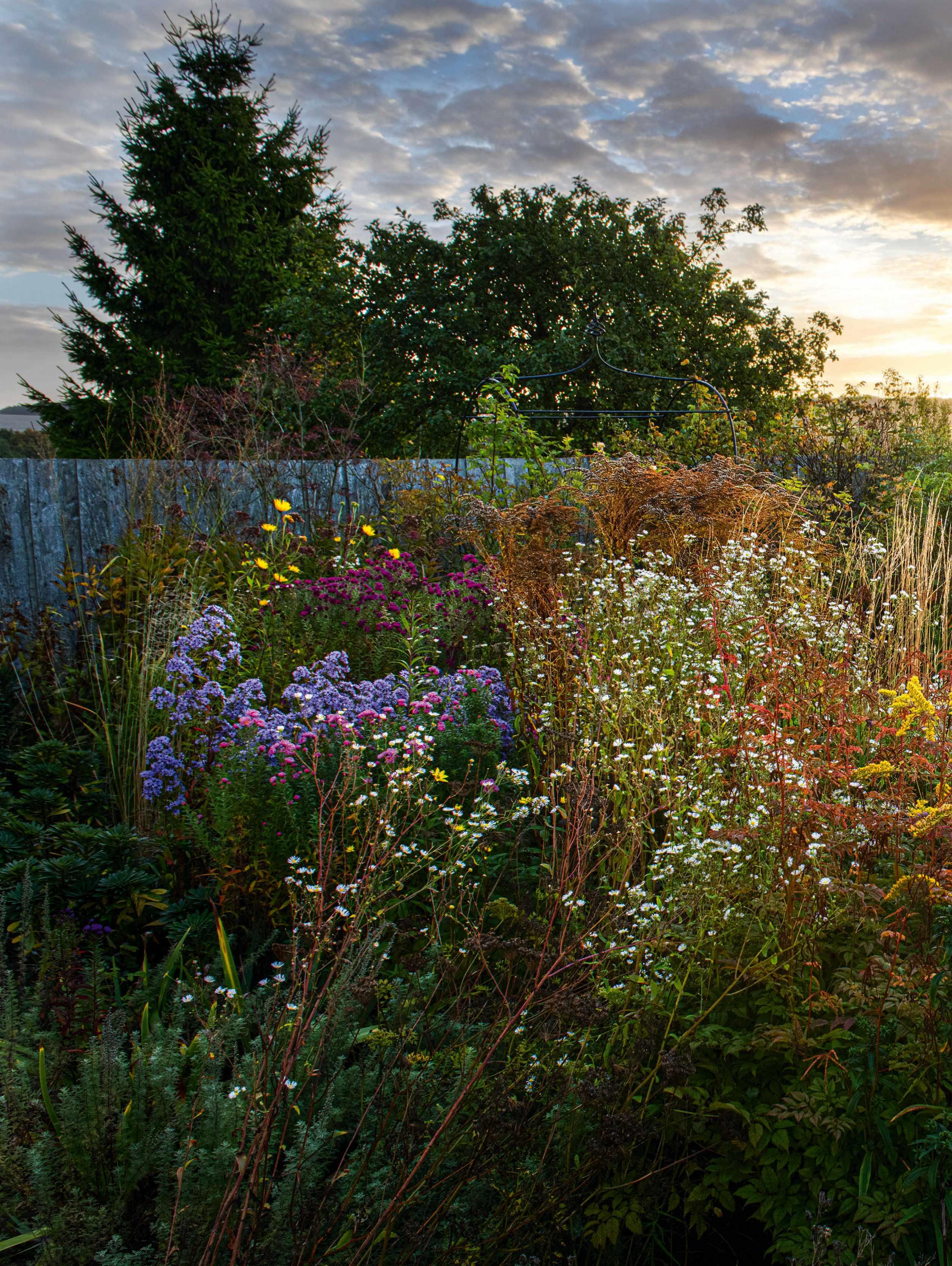
What A plantsperson’s collection of unusual plants.
Where North Yorkshire.
Size Less than a fifth of an acre. Soil Clay-loam on one side, drier limey soil on the other.
Climate Temperate; the site is exposed, windy and in full sun. Hardiness zone USDA 8.
Situated in eastern North Yorkshire, Dr John Grimshaw’s garden is a combination of experiment, considered plant design and rare collections. To see it in October is a wonder, for borders at their fullest, but he has made sure there is colour and interest from as early as February right the way through the year.
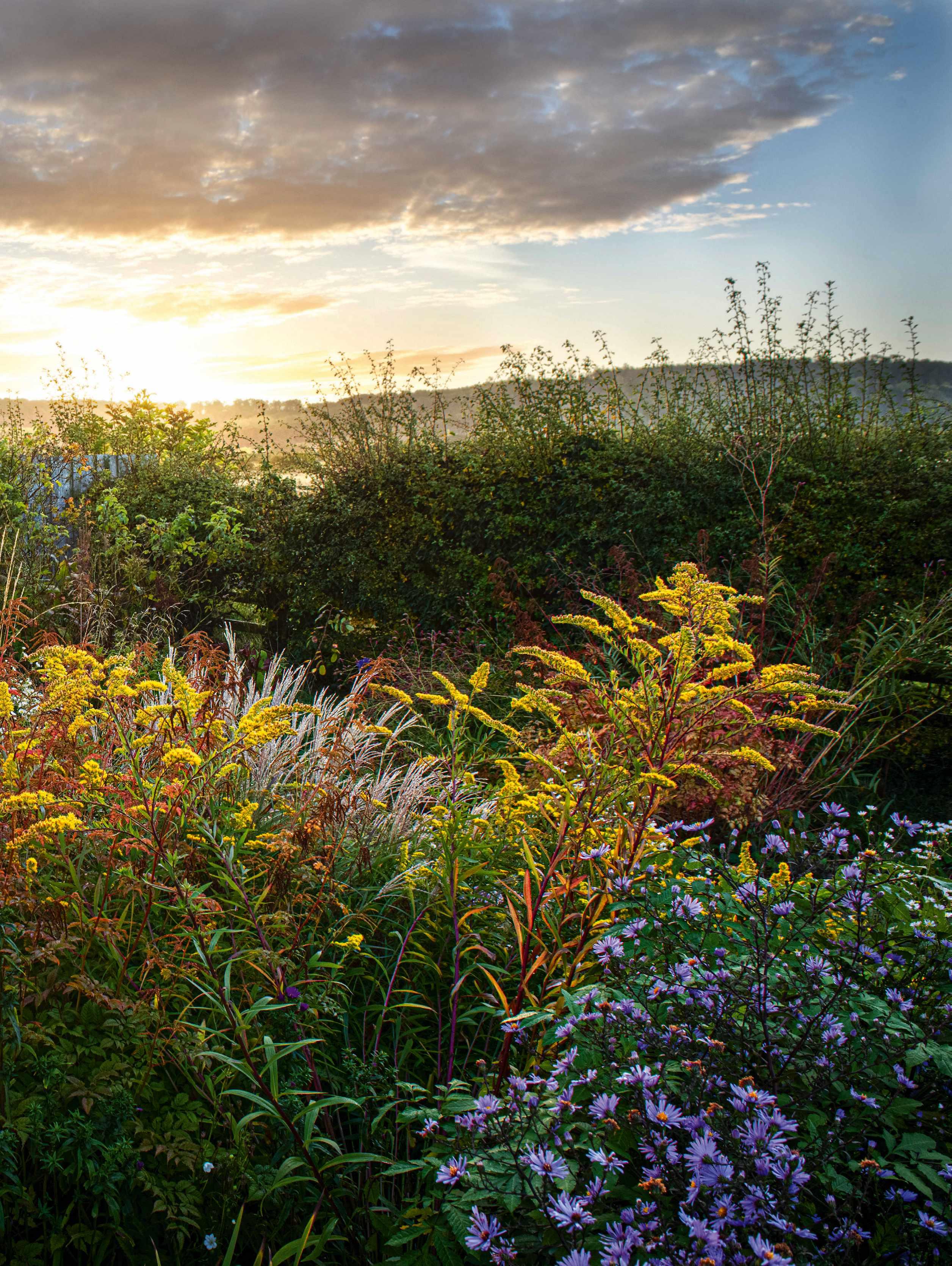
Well known for his tree and shrub expertise, botanist Dr John Grimshaw allows his herbaceous side to run riot in his own small, glittering gem of a garden near York
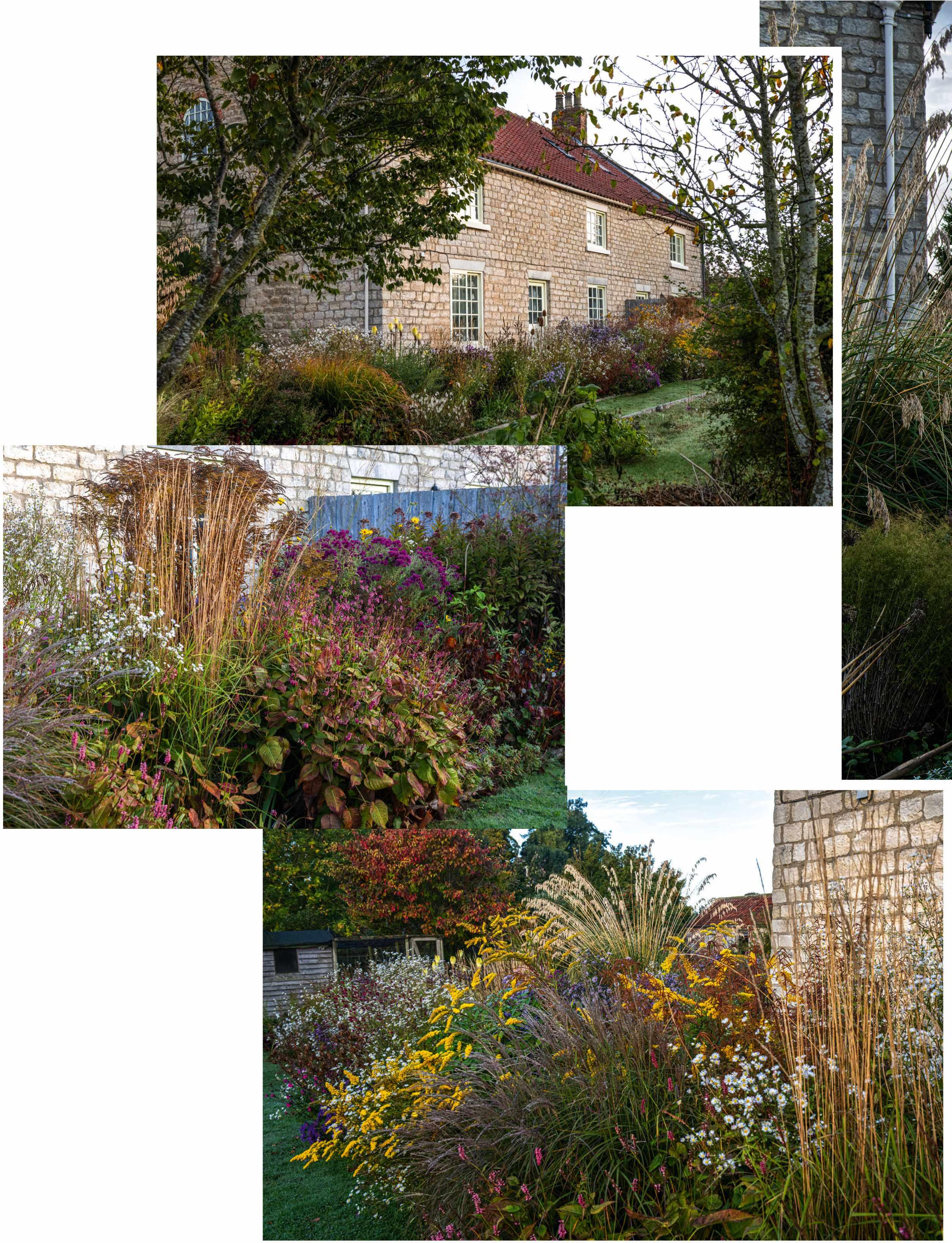
Above Two parallel long rectangular borders, packed full of perennials, annuals and rare bulbs, run along the front of the house.
Left Calamagrostis x acutiflora ‘Overdam’ creates a strong vertical and structural punctuation point surrounded by tall, daisy-like Erigeron annuus to the left and, to the right, Bistorta amplexicaulis ‘Dikke Floskes’ and Symphyotrichum novaeangliae ‘Septemberrubin’.
Below Fountain-shaped Ampelodesmos mauritanicus forms a key focal point with bright-yellow Solidago ‘Dennis Strange’ in the foreground. The colours of late-flowering perennials and buff grasses mirror the autumnal tints of the leaves on trees.
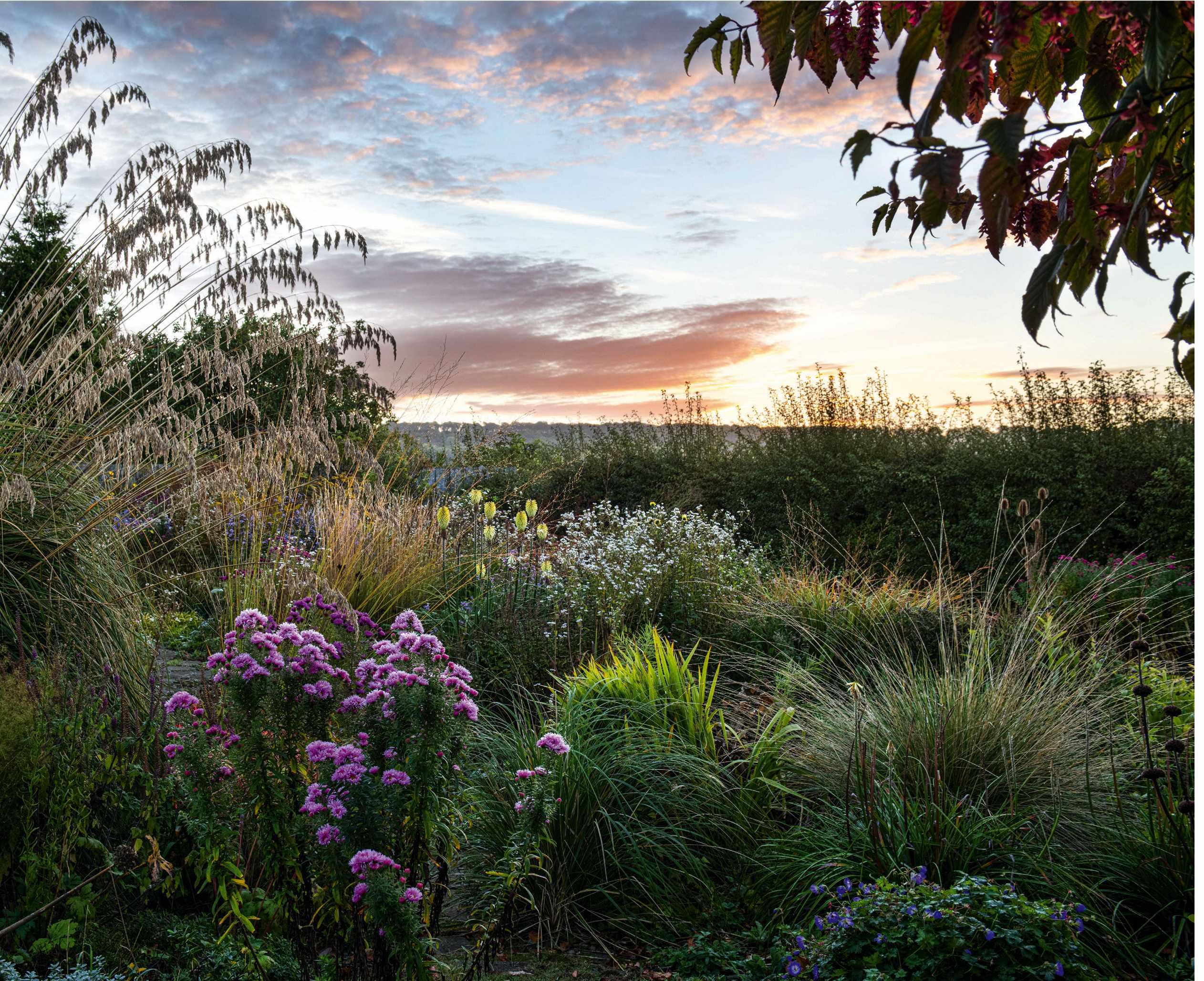
In the soft light of October, in Dr John Grimshaw’s garden, colourful Michaelmas daisies and yellow Solidago glow among gentle ornamental grasses; a sea of colour and texture overseen by wandering Silver Sebright bantam chickens, peacocks and golden pheasants, for an added air of exotica. This is a garden full of treasures waiting to be discovered, packed with top-performing plants and featuring the experimental use of rare species and cultivars.
John is the director of the Yorkshire Arboretum, with 120 acres of trees and shrubs to play with at work, but his home garden is relatively small, at just under a fifth of an acre. The wraparound plot is a year-round gem that overflows with layers of herbaceous planting from February right the way through to late autumn. There are, however, many hidden challenges.
“The first thing you need to know about this garden is that everything’s really stocky because of wind and the sunshine,” he says. “It’s like being on a cliff top: everything is condensed and compact.” The garden sits in the middle of a vast, flat basin surrounded by agricultural fields, making it surprisingly exposed.
Strong winds rush in from the coast just 20 miles east, and sun blasts every inch of the garden as it moves from the front to the back of the house through the day.
“Nothing is staked; I think it looks unnatural,” says John, who has turned the harsh conditions into an advantage by selecting plants that can cope, including Eutrochium maculatum, and robust, upright grass Calamagrostis x acutiflora ‘Overdam’. They all grow that little bit chunkier and tougher, thanks to constant wind movement – something John recommends can be replicated on seedlings by brushing hands over them while in trays.
When John moved here in 2012, he was told he could rent the house for a couple of years. As a temporary measure, he filled the two existing main beds, running parallel to the front of the building, with his extensive bulb and perennial collection, brought with him from the Cotswolds. Two years have become 11, and John’s natural curiosity has seen the garden transform in a fluid way as plant after plant has been added.
Half of an old lawn has become a mini-meadow. “I’ve always been interested in wildflowers and I’ve thought To continue turn to page 61
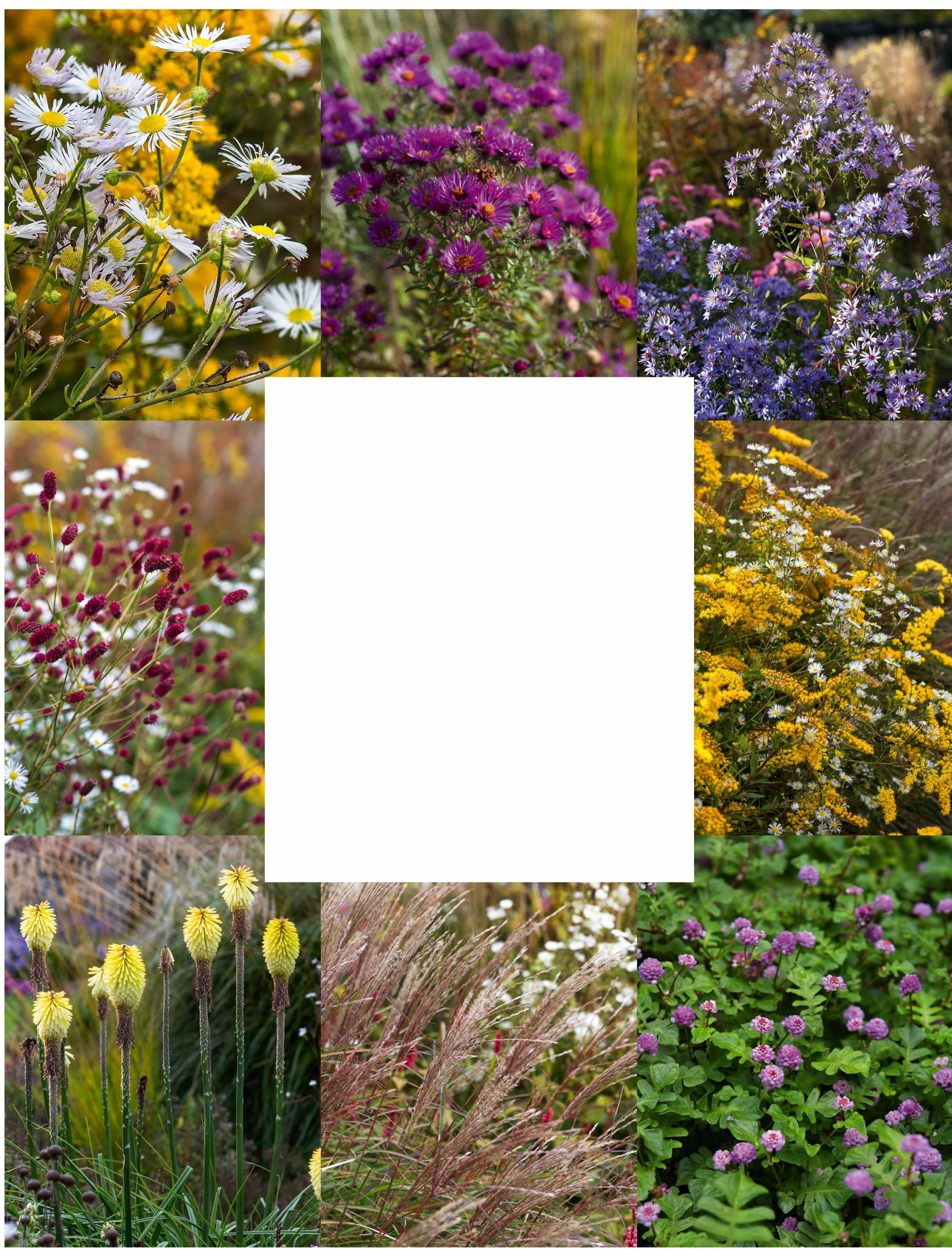
1 Erigeron annuus Short-lived daisy, at best biennial, that flowers its socks off all summer, the white petals fading to pink with age. It comes with a health warning from John, as it self-seeds so freely. Height and spread: 1m x 60cm. RHS H7†
2 Symphyotrichum novae-angliae ‘Primrose Upward’ Shocking-pink aster on strong, tall stems for a real pop of colour heading into autumn. Perfect among large grasses. 1.5m x 90cm. RHS H6, USDA 4a-8b.
3 Symphyotrichum ‘Little Carlow’ A reliable, mid-height aster with fresh green foliage through summer followed by pale-blue daisies until the frosts. 60cm x 45cm. AGM*. RHS H7, USDA 4a-8b.
4 Sanguisorba (self-seeded seedling) The small button flowers of this burnet demonstrate the pointillist look John encourages in his planting, shimmering as they move in the breeze on wiry, stiff stems. 1m x 40cm. RHS H6.
5 Solidago ‘Dennis Strange’ A late-flowering goldenrod with sprays of small, bright-yellow flowers opening from lime-green buds on rigid stems. Strong winter seedheads. 2m x 90cm. RHS H7.
6 Kniphofia ‘Cool Knip’ Strong stems of pale-green flower spikes emerge in autumn from linear, grassy, evergreen leaves. 60cm x 60cm.
7 Miscanthus ‘Yakushima Dwarf’ A short Miscanthus but with the recognisable fluffy seedheads that start with a hint of red before turning pale, which can be left through winter. 80cm x 30cm. RHS H6.
8 Persicaria sinuata ‘Edward Needham’ A particularly unusual groundcover form with almost fern-like leaves and masses of small, pink flower bobbles for months through to severe frost. Reported as annual but does grow perennially. 20-30cm x 30cm.
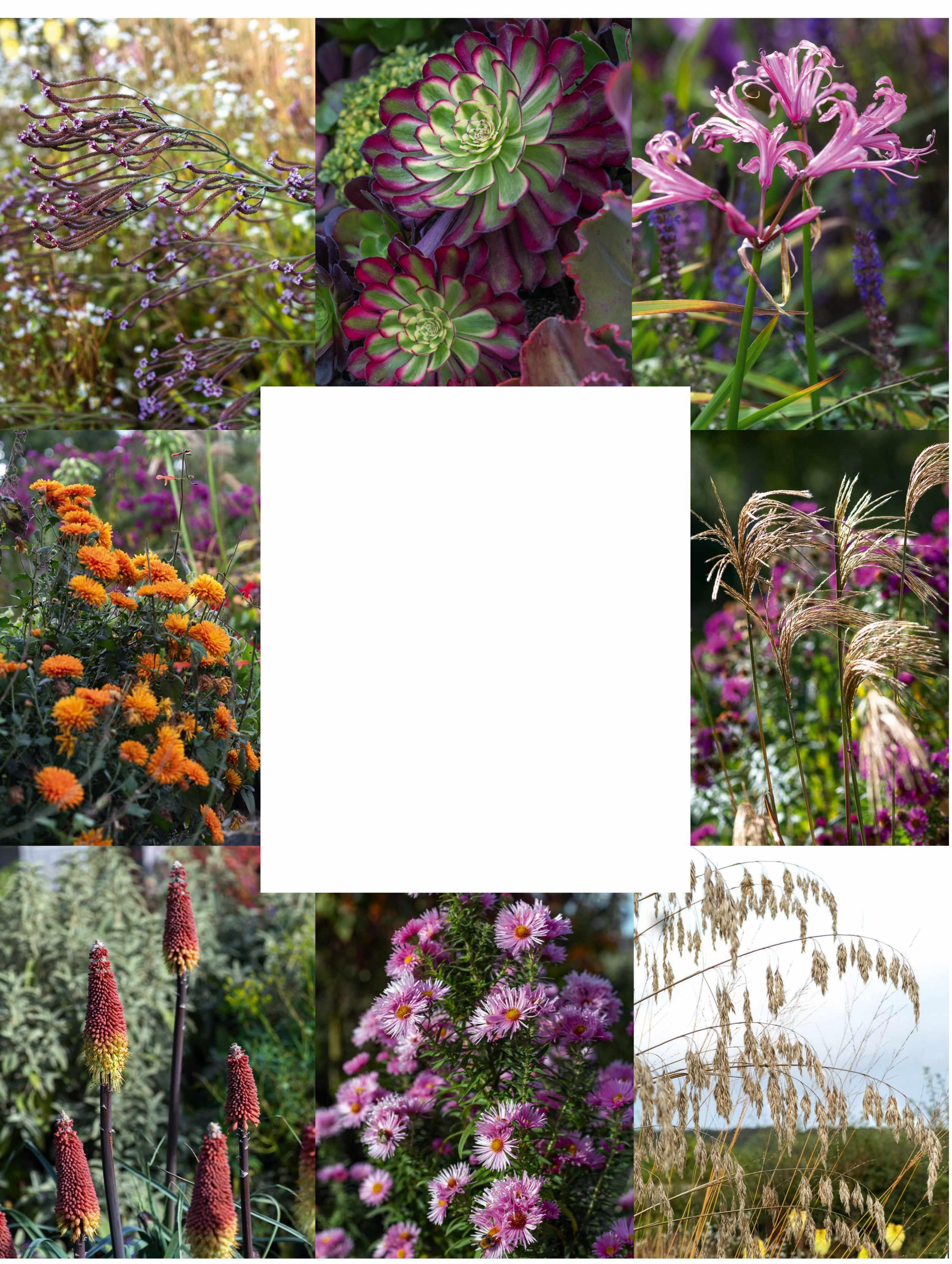
9 Verbena macdougalii ‘Lavender Spires’ Upright, slightly bushy verbena with long, narrow flower spikes that bloom over a number of months before forming good winter seedheads. 1.5m x 60cm. RHS H5.
10 Aeonium ‘Mardi Gras’ Variegated tender succulent. Green emerging leaves turn rose through to a deep, dark purple at the tips. Will branch with age. 30cm x 90cm. RHS H3.
11 Nerine bowdenii ‘Mollie Cowie’ Spectacular cerise trumpets over rare, variegated leaves on one of the latest bulbs of the year to flower. Easy in a sheltered spot in full sun. 40cm x 10cm. RHS H5.
12 Chrysanthemum ‘Dixter Orange’ Gorgeous double flowers of rich, burnt orange that start in July and will continue producing new buds until the frosts if deadheaded. 60cm x 60cm. RHS H4.
13 Miscanthus nepalensis Attractive, delicate, golden flower plumes in summer, held above arching, linear green leaves. 1.5m x 1m. RHS H6.
14 Kniphofia caulescens ‘Oxford Blue’ Superb, waxy, grey-blue foliage topped with yellow and salmon-red flowers in October. 1m x 60cm. USDA 6a-8b.
15 Symphyotrichum novae-angliae ‘Rosa Sieger’ Tall, upright aster producing sprays of rose-pink flowers with golden-yellow centres. 1.2m x 1.2m. AGM. RHS H7.
16 Ampelodesmos mauritanicus Tall, open, pendent grass, with feathery, drooping cream or purple flowerheads on one side. 2m x 1.5m. RHS H3.
*Holds an Award of Garden Merit from the Royal Horticultural Society. †Hardiness ratings given where available.
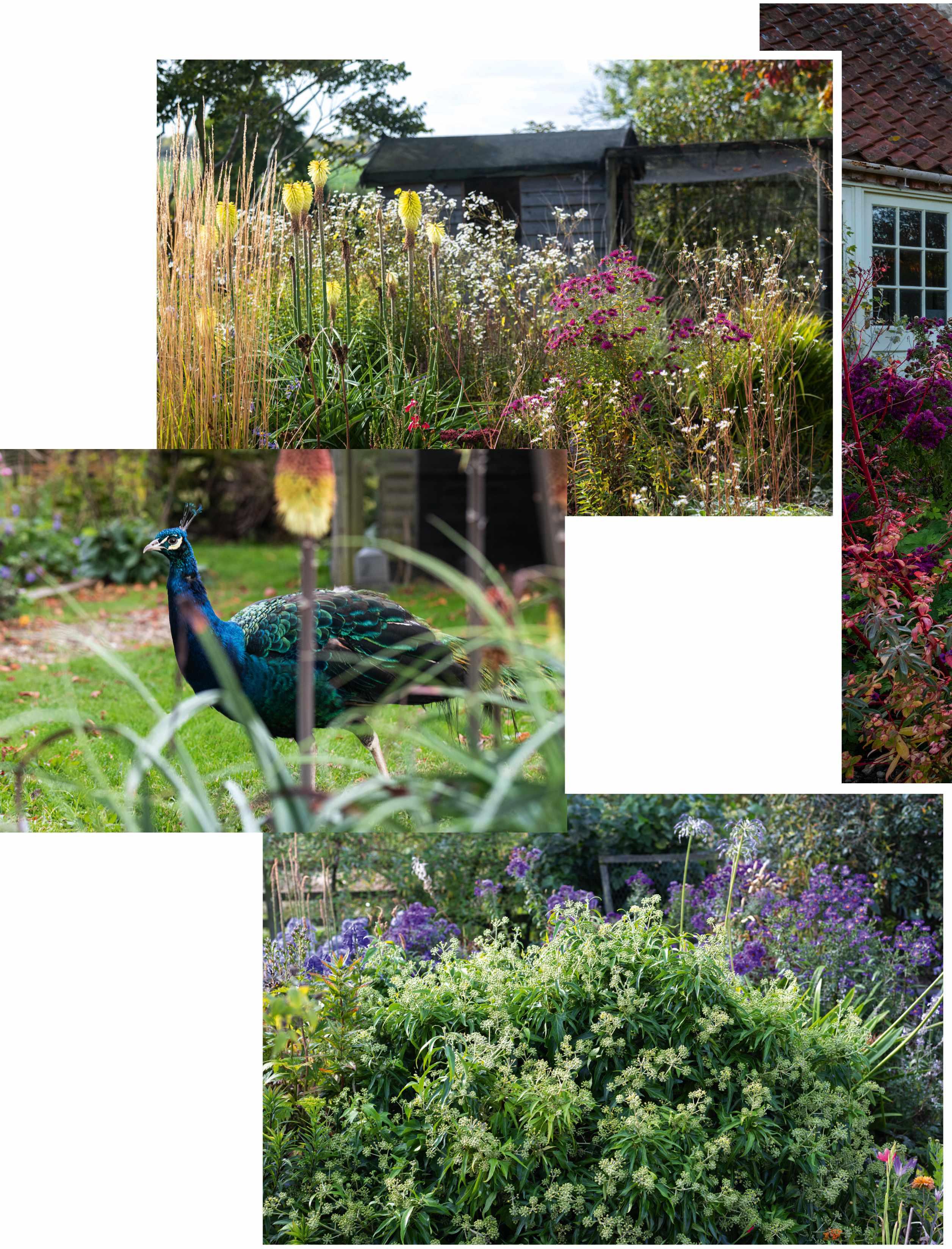
Above Kniphofia ‘Cool Knip’ with its lemonygreen pokers seems to glow in the soft autumn sunlight, living up to the common name of torch lily. White-flowered Erigeron annuus, which can self-seed a little too easily for some, is a key linking plant used throughout the garden.
Left Percy the peacock is one of several birds that share John’s garden, along with Silver Sebright bantam chickens and golden pheasants.
Below It took two years for John to get this new cultivar of Hedera helix to root from a cutting. ‘Simon Savage’, with its irregularly lobed leaves, now forms a spectacular mound within the autumn borders.
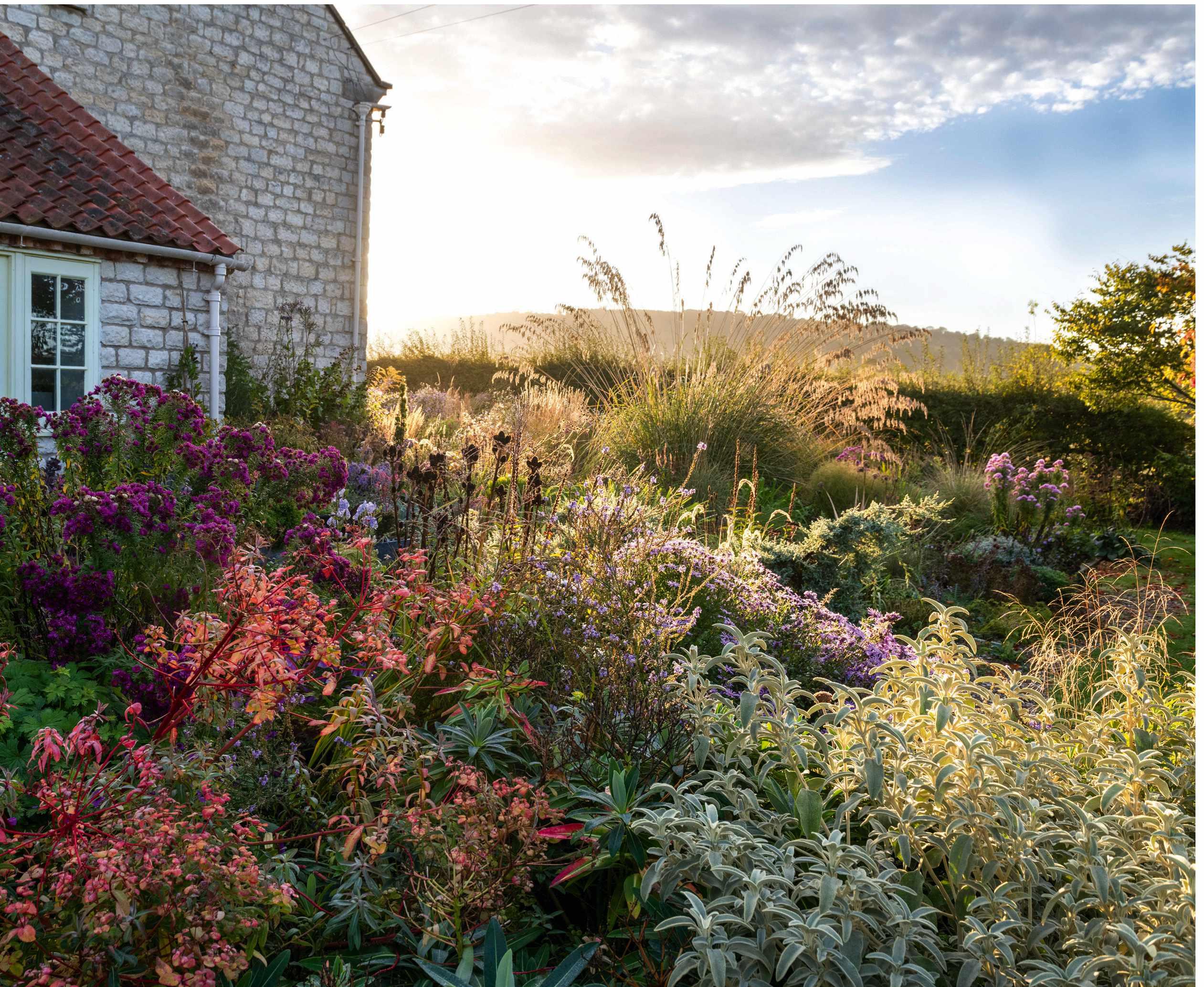
they were very important in the garden, so why exclude them?” The other half, closest to the house, is now a gravel area for alpines and his long-term interest of South African plants, such as Kniphofia caulescens ‘Oxford Blue’. The area at back of the house is used for unique ferns, including an original, vegetatively propagated Athyrium filix-femina ‘Victoriae’ and other shade-loving plants, though they have to tough it out with a blast of direct afternoon sunshine.
John’s love of plants was fuelled by his mother, a field botanist who took him botanising in his pram. “Then my parents gave me an area of garden when I was four or so. I’ve been immersed in plants from a very young age and never stopped.” The wonder of the garden comes thanks to his obvious joy of being around and discovering new plants, knowledgeably positioning those that he’s seen growing in habitats around the world that match his garden’s conditions and climate. In doing so, there is something of interest in every season, and yet all of this alchemy feels cohesive and unified, because of his eye for colour, repetition and combinations.
Over time, the garden has evolved from more traditional, regimented planting into something John
describes as “ecosystem-like”, with layers of interest that come and go in waves through each season. Starting with bulbs, such as snowdrops, it builds gradually to a peak in autumn. Plants are allowed to move around, with seedlings kept in case any grow into something interesting. This mix and mingle of modern perennials, seen in low autumn sunlight, gives the garden a dynamism John describes as a “wafty shimmer”.
Part of this ecosystem-driven, low-maintenance approach has been down to the realities of life. “I have two hours a week in the garden if I’m lucky,” says John. Would he go back to the regimented look, had he more time? John pauses. “I prefer this,” he says. “It’s evolved in the right way.” ■
Address 1 Kirk Hill Farm, Settrington, North Yorkshire YO17 8NT. Web yorkshirearboretum.org
Open Sunday 8 October, 1-4pm. Advance booking via website strongly recommended.
Find John’s tips on extending planting interest into autumn at gardensillustrated.com/autumn
Above The garden’s wraparound nature allows for different zones in a relatively small space, with areas for big bulb displays, the autumn perennials and a South African-focused gravel corner, with minimeadows squeezed into every space in between. All link together to form a unified whole, thanks to John’s curation of colour and texture.
Designer Jinny Blom offers advice on creating good planting schemes that suit their setting, using new examples from her own portfolio
Perhaps the most complicated aspect of making a garden is designing the planting. Every one of us approaches it in unique ways, and there is no right or wrong way of doing it. Designing planting involves having a good vision of how you’d ideally like things to look. This is the most brilliant bit about gardening – seeing how other people do it.
It is best to start with the structural elements of larger trees, hedges, topiary and shrubs, then the infilling of smaller plants can begin. This should take time to put together, with lots of mulling, leafing through books and catalogues. Internet scrolling is, of course, de rigueur these days, though I personally find books much easier to use and more informative. Given this is what I do for a living, and that people seem to like it, it’s probably more useful for me to discuss and deconstruct my own planting – see three examples on the following pages. I can then show how I go about responding to a place, demonstrating my own way of building up the story and showing the end results.
Garden planting that can semi-naturalise a space is my personal preference. It seems to give a relaxed quality that I enjoy. Some say it’s ‘messy’, and perhaps it is, although this is – like most things in gardening – a subjective view and bothers me little. Gardens are not the best places for being judgemental; that gift is best left at the door.
Gardens are to be enjoyed exactly for their uniqueness. Having always had a very strong affinity with nature, I’ve looked a lot at how plant matrices work in the wild. There are wonderful sporadic outbursts and then quieter areas where more jewel-like plants emerge to surprise us.
Once, driving across grasslands in Africa, I screeched to a halt. There, in the vast acreage of grass, shone a pyjama lily, Crinum macowanii. This great, voluptuous, pink amaryllis with its rich-green, fleshy leaves looked incongruous in a vast savannah of dried tawny grass. But that’s nature. It’s probably still there, looking and smelling gorgeous, to attract a sexy beast.
I find it possible to get a sense of order into a garden through the built structure and the structural planting, so my gardens are highly civilised. I am not trying to emulate nature. I am making a garden and using ‘garden’ plants – namely those we have tried and trusted – to paint a picture of something loose and relaxed. ■
PHOTOGRAPHS BRITT WILLOUGHBY DYER Turn the page for more ideas from Jinny’s designs
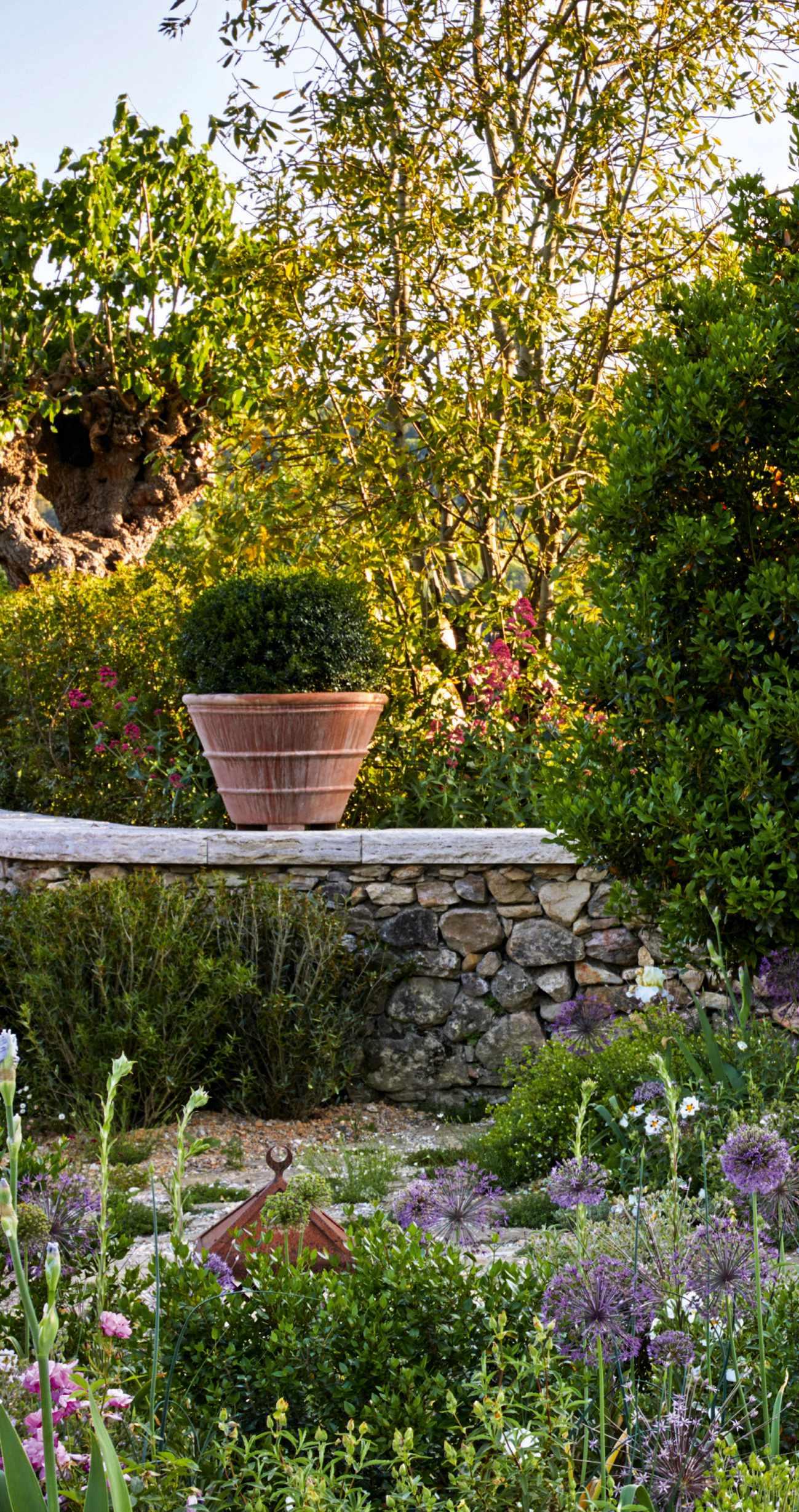
This was a really fascinating garden to create. The site is an ancient hilltop settlement typical of this part of Italy. It was completely dilapidated and had last been occupied some years previously by a local farmer. Traces of many centuries of occupation were there, yet the place was uninhabitable. The garden I created surrounds the castle and flows down its terraced slopes, before giving way to olive terraces and recreated wildflowers so typical of the area. There is a tendency to think that Italy only has a Mediterranean plant palette because it is hot,
This is a garden of texture so I introduced, from left to right, Morus alba pollards with their wonderful craggy trunks, a rather tall, stringy bay tree and, in the foreground, Arbutus unedo for its winter flowering and wonderful scent.
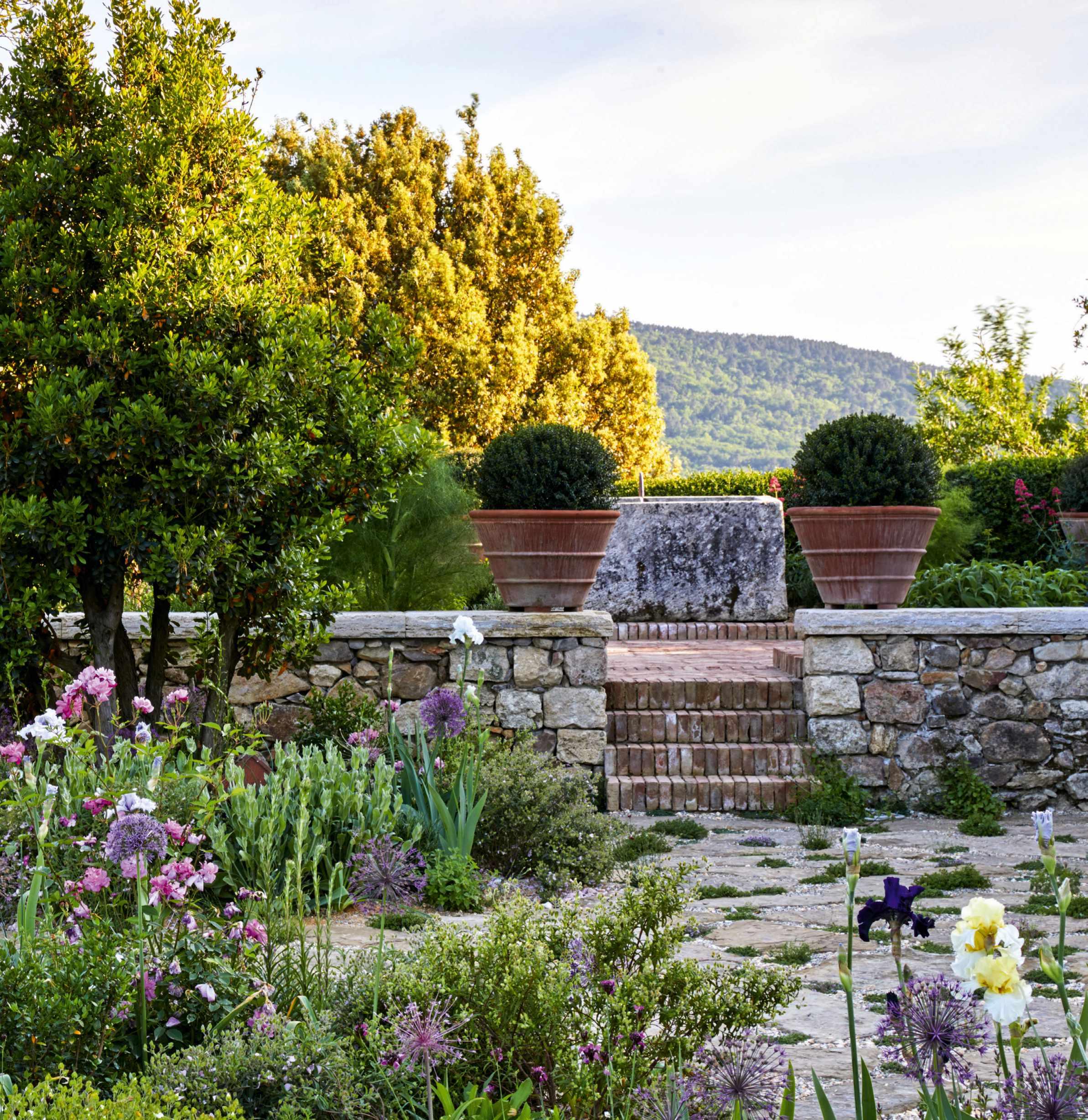
but this is not the case. I worked with a local landscape historian to make sure that I chose planting, specifically the trees, that suited the area’s unique character.
Obviously, I am not returning the place to its Etruscan past, yet my design does need to settle gently into the wider landscape as it can be seen across the plain on its commanding hilltop. These hilltops are a visual indicator of the local typology of the landscape and protected by law. I chose simple sweeps of shrubbery that we topiarised into loosely corrugated waves. This is a decorative garden, though the manner of planting is relaxed. In support of the age of the place, I included lots of herbs, fruit trees and edible plants that will naturalise into their setting.
There was nothing here at all when I started, just a vague suggestion of a level change with no walls. I created a raised orto botanico – a little herb garden with the myrtle, Myrtus communis subsp. tarentina, in pots. The distant Quercus ilex was already there, but terribly overgrown, so I had it reshaped.
Things begin to get flowery at ground level. The paving is planted with many different varieties of prostrate thyme. At the edges, where the paving meets the beds – all of which were mulched in gravel after planting to keep them cool – I introduced slightly taller thymes and helianthemums, which then support the deep-blue Aquilegia alpina and Dianthus carthusianorum. All these plants are prolific self-seeders.
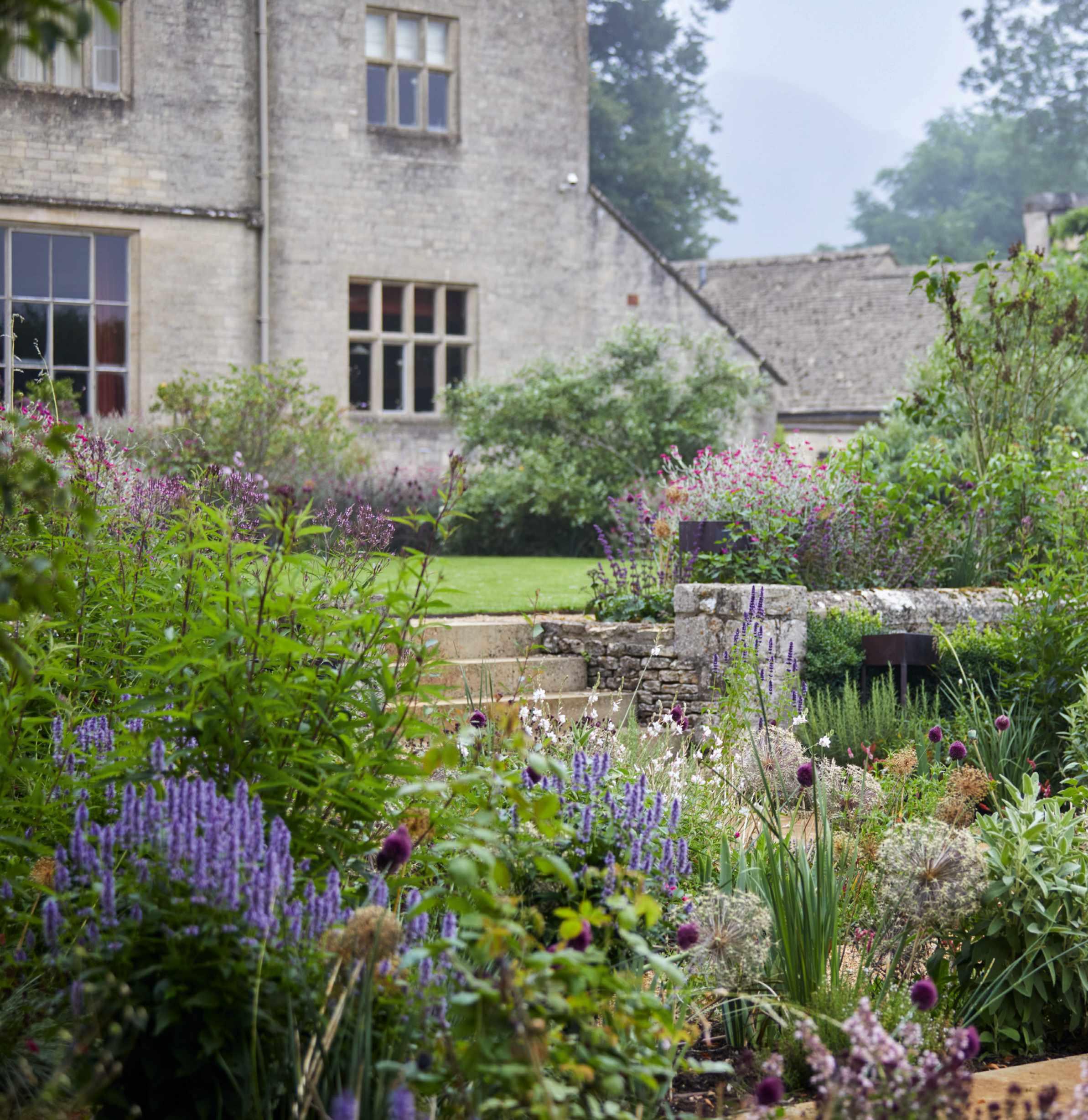
There literally wasn’t a single plant in this garden when I met my clients. No flower beds, nothing. They had just bought the house and the previous owner had imported a highly conceptual international designer for the place, but had subsequently never lived there. The garden had deconceptualised quite quickly!
My aim was to bring as much life as possible back into the garden and wider landscape, while retaining the existing hard landscape. There was no good reason for ripping out all the
laborious work that had been done. It was a wonderful prospect for me as usually we build for years before the planting starts. Apart from reconfiguring the spaces and making flower beds where none had existed, this was all pure planting.
The aspirations were high. As well as lots of beautiful flower gardens there would be arboretums, foraging gardens, orchards, vegetable gardens, a greenhouse or two, composting areas, meadows, lakes and wetlands and huge native, fruit-rich hedgerows. All of it was designed to tie the land, which is very steep and quite exposed, to the house in a commanding spot at the top, and then back into the local landscape.

The soil was absolutely appalling. It quickly became clear that most of the builder’s rubble had been levelled and topped with grass. This gave us an opportunity to solve the mess and create wonderful new beds full of compost-enriched soil. The planting is generous. I chose a top layer of flowering shrubbery, including Syringa vulgaris ‘Madame Lemoine’, Malus ‘Evereste’, Cercis siliquastrum and Arbutus unedo against the house, and many others, giving a long flowering season through the year. Abundant rose banks give nesting opportunities for birds and plentiful supplies of hips for mice in winter. The borders are all colour themed and wash into one another on your walk through the gardens. The return of wildlife in all its forms was instantaneous.
Left The house looked incredibly severe when I arrived, stripped of any green. We planted the garden in October and this image was taken the following June, so this planting in its entirety is eight months old. There was quite literally nothing here before I started. All the flower beds are new, allowing us to make up proper soil, which has enormous benefits. The planting is unstable inasmuch as the shrubs and roses will take a while to catch up with the herbaceous plants, including Silene coronaria, Allium sphaerocephalon and Agastache ‘Blackadder’. In the short term, therefore, it all looks very frothy.
Below I used cosmos as an annual filler while everything else got itself settled. Here we have Achillea millefolium ‘Cerise Queen’, Salvia ‘Amistad’, the reed-like leaves of Dierama pulcherrimum ‘Blackbird’, Penstemon ‘Andenken an Friedrich Hahn’ and my favourite, Hylotelephium ‘Matrona’.
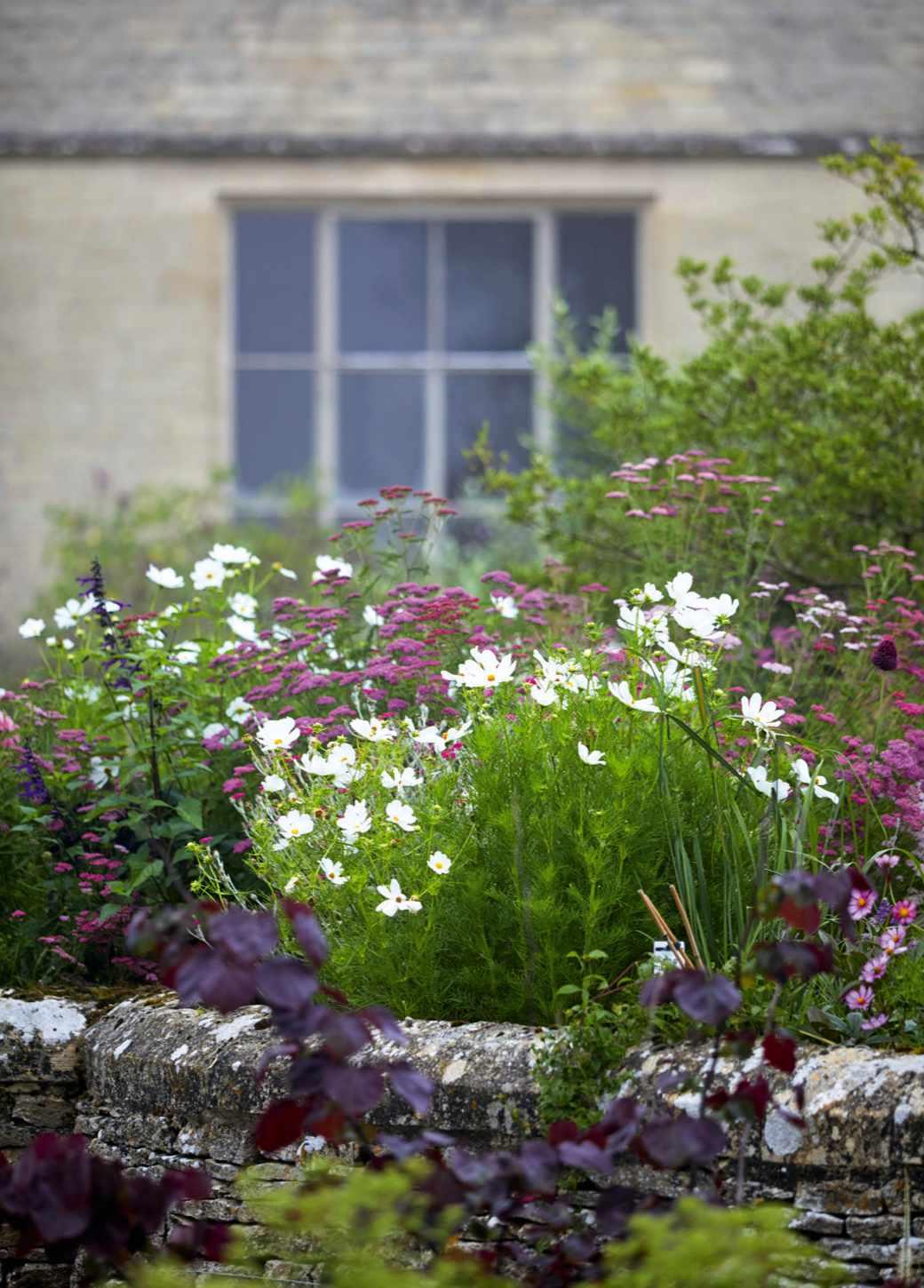
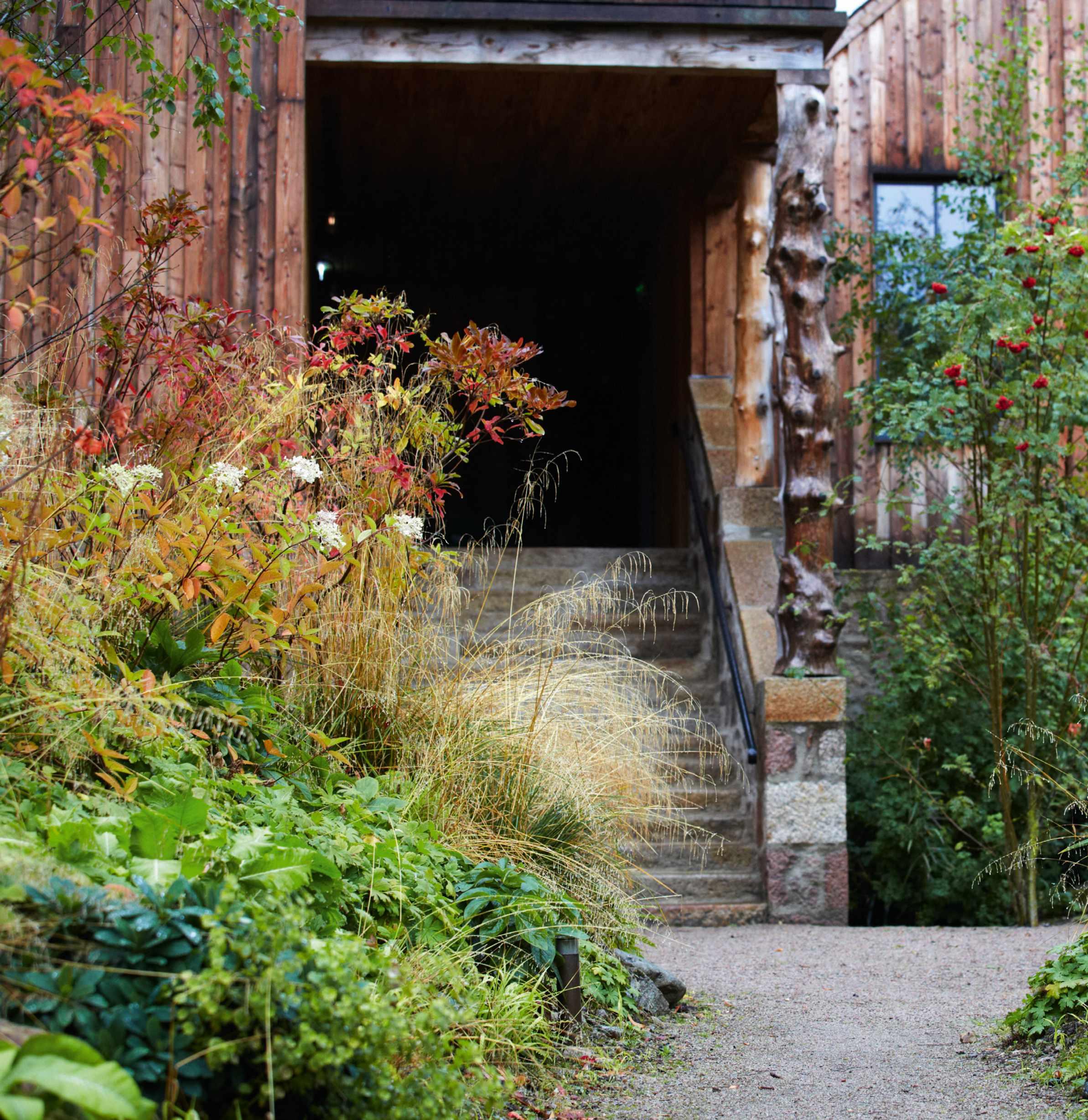
This magnificent place is high in the Cairngorm Mountains in Scotland. I wish I could show you what it looked like before we started. There were piles of old fridges, a half-smashed concrete curling rink and mountains of builders’ rubble 3m tall. The hedges were overgrown, the trees were sad and there were weeds everywhere.
Yet this is a whimsical spot with wonderful, natural character. The old Fife Arms Hotel is a glorious Scottish baronial granite building sitting proudly on the rocky banks of the tumbling
Clunie Water. It is in the centre of Braemar in Royal Deeside, only moments away from Balmoral Castle. Owners Iwan and Manuela Wirth are great fun to work with. They are interested in ideas and after our initial animated conversations they let me loose. The site is quite complicated, and like any hotel, the demands on a garden space are legion.
The idea for the drumlins came not just from my love of the natural forms in Highland landscapes – I’ve worked in Scotland a lot now – but they solved a practical problem. I needed to create elevation in the garden to present the planting well. It’s far too small to keep as a flat plane. There was a need to screen views
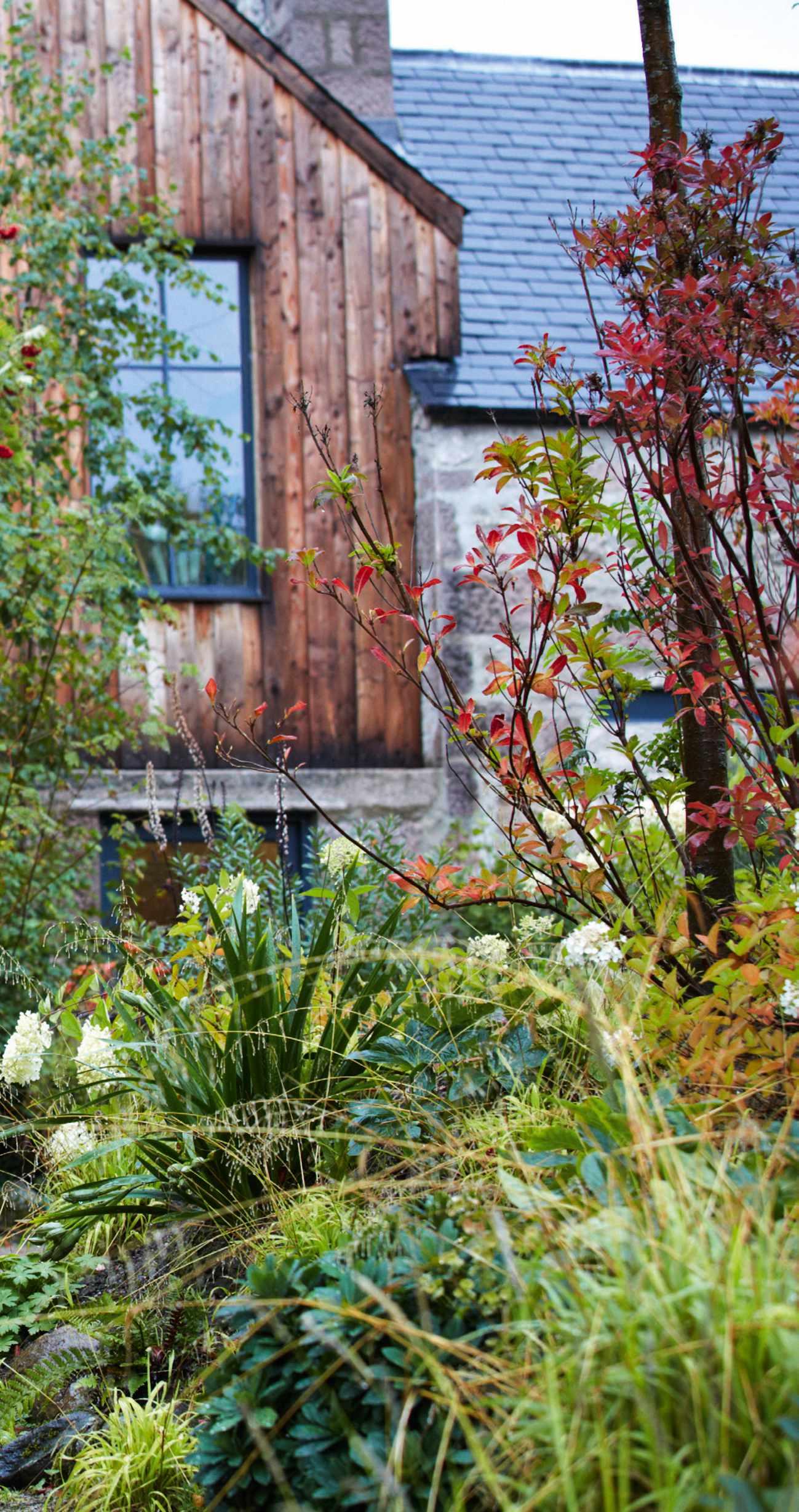
from one another to give differing experiences of outside when viewed from inside. I also wanted to create little routes and discoveries through to the lower area where we had a flat meadow lawn.
I chose a planting palette that was redolent of both Highland folklore and also the Victorian plant hunters. Native rowan, Scots pine and downy birch are the trees, interspersed with bog myrtle shrubs, to keep the midges away, and wild broom. I used loads of Rhododendron luteum for its glorious, scented, yellow flowers and fiery autumn colours. Scotland is all about autumn colour, so this garden is packed with it.
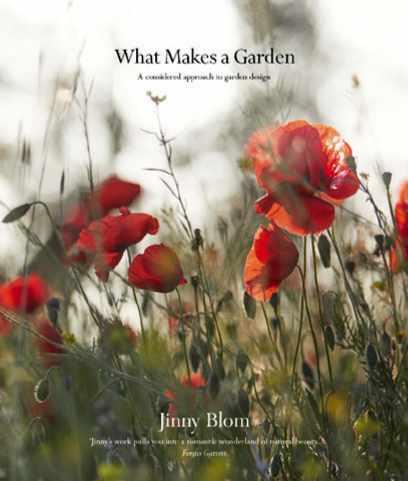
This is an edited extract from Jinny Blom’s new book, What Makes a Garden: a Considered Approach to Garden Design (Frances Lincoln, £35), which is published on 19 October. Order now or receive a copy of the book when you subscribe to Gardens Illustrated this month (see page 28 for details).
Left To confirm the spirit of the place, this photograph was shot in heavy drizzle. Scotland performs well in rain, and I love to see everything weighed down with glistening droplets. This juvenile planting scheme is settling in well in its Highland home. I wanted all the trees to have resonance to the place so chose rowans, Scots pine and downy birch. The whole garden is filled with a muddle of native plants such as bog myrtle alongside Victorian favourites such as hydrangea, Rhododendron luteum and potentilla, which I used in prodigious quantities. A sturdy bank of Euphorbia amygdaloides var. robbiae, Deschampsia cespitosa and Geranium macrorrhizum holds everything together.
Below I installed these steps to separate the lower meadow from the ‘banks and braes’ of the main gardens. Besides a lavish use of coppery Rhododendron luteum, I used a huge quantity of the wonderfully acidic-yellow grass Sesleria autumnalis. In the low light of the Highlands it is illuminating, giving lift and luminous accents to the garden.
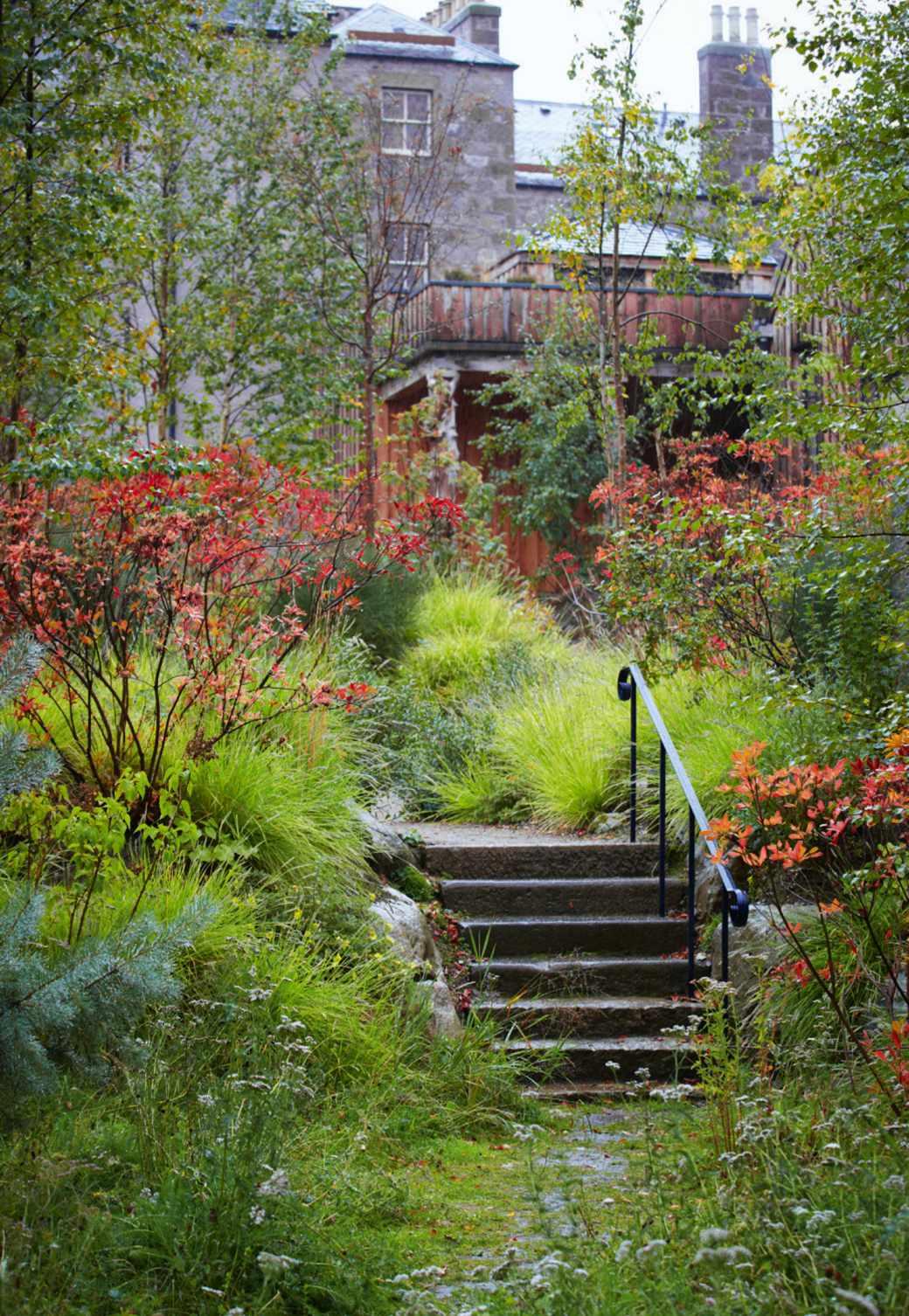
What A cottage-style garden including mixed borders and traditional and modern rose gardens within the formality of topiary and geometric borders and lawns. Where Cambridgeshire.
Size Three-and-a-half acres in total, with large areas of naturalised meadow to increase biodiversity.
Soil Alluvial with a high percentage of river gravel, easy to work but poor as it is very free draining and hungry. During winter, water moves up from below and the ground becomes boggy.
Climate Lower than average rainfall for the UK, with icy-cold winter winds. Hardiness zone RHS H8.
The parallel borders are filled with seed selections of asters and close relatives, while the dead stems of the teasel Dipsacus fullonum and Cynara cardunculus, the globe artichoke, create a bold architectural statement through autumn.
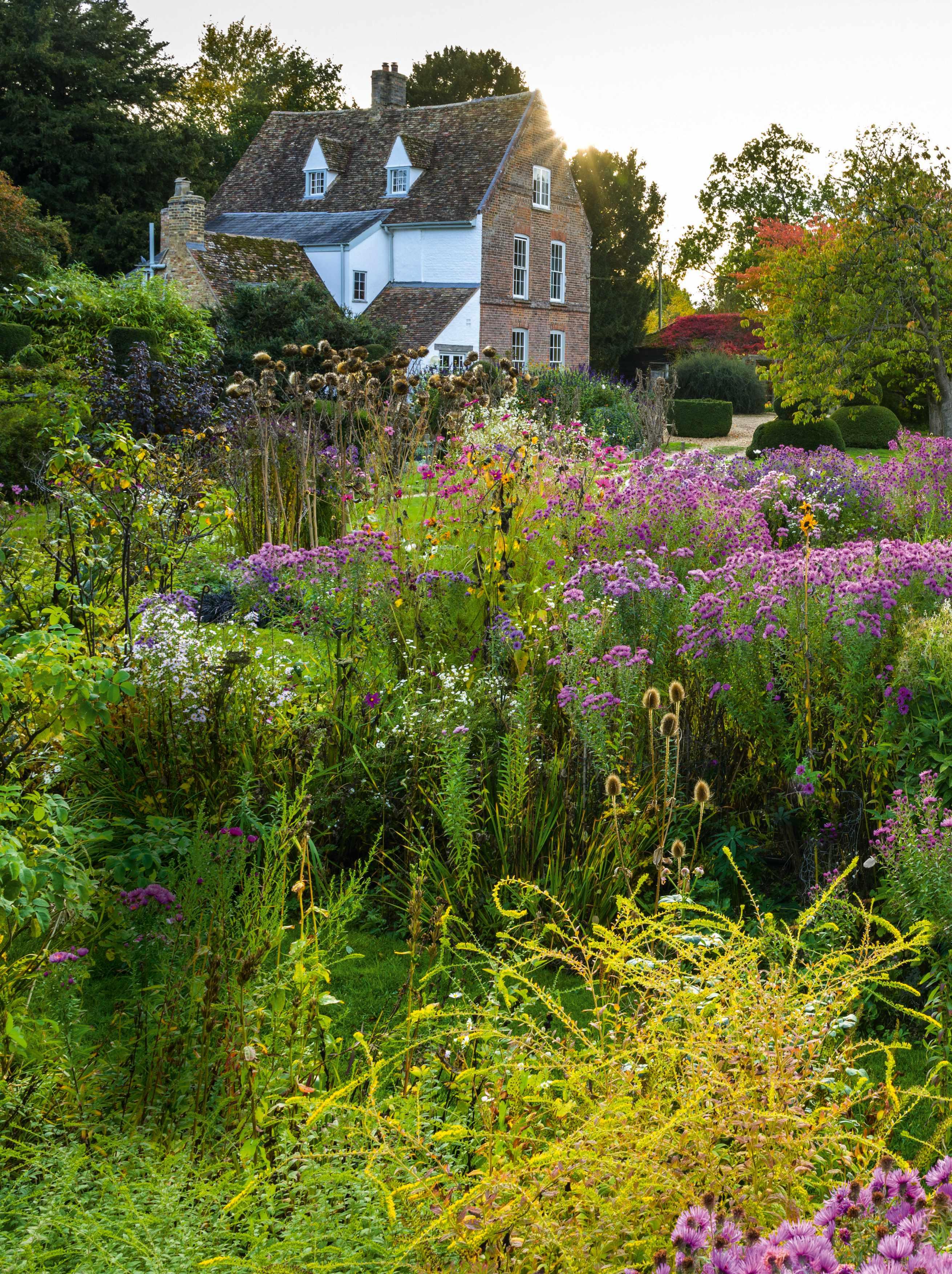
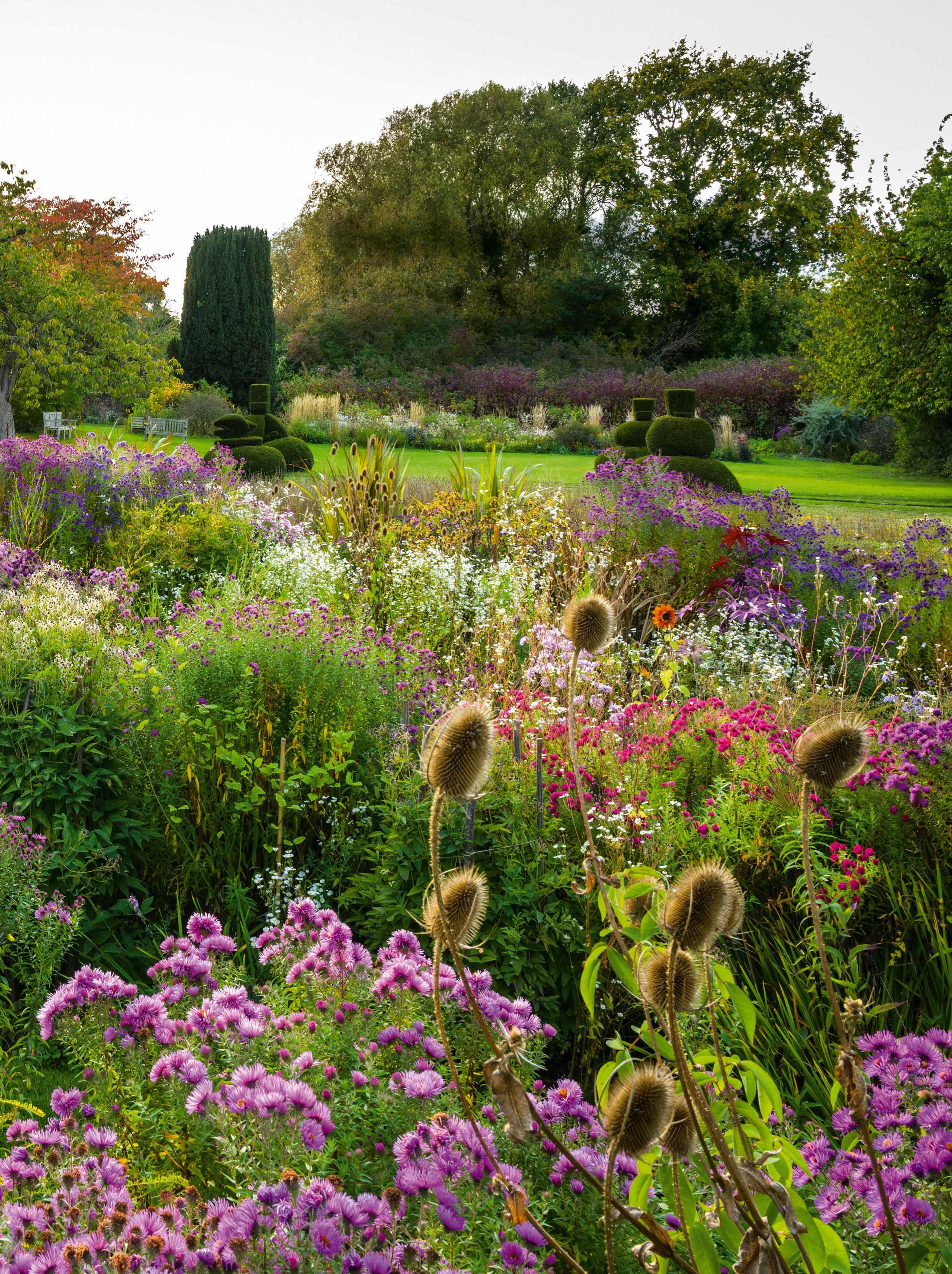
This historic manor garden continues to evolve, while upholding the spirit of its creator – the author, artist and needlewoman Lucy M Boston
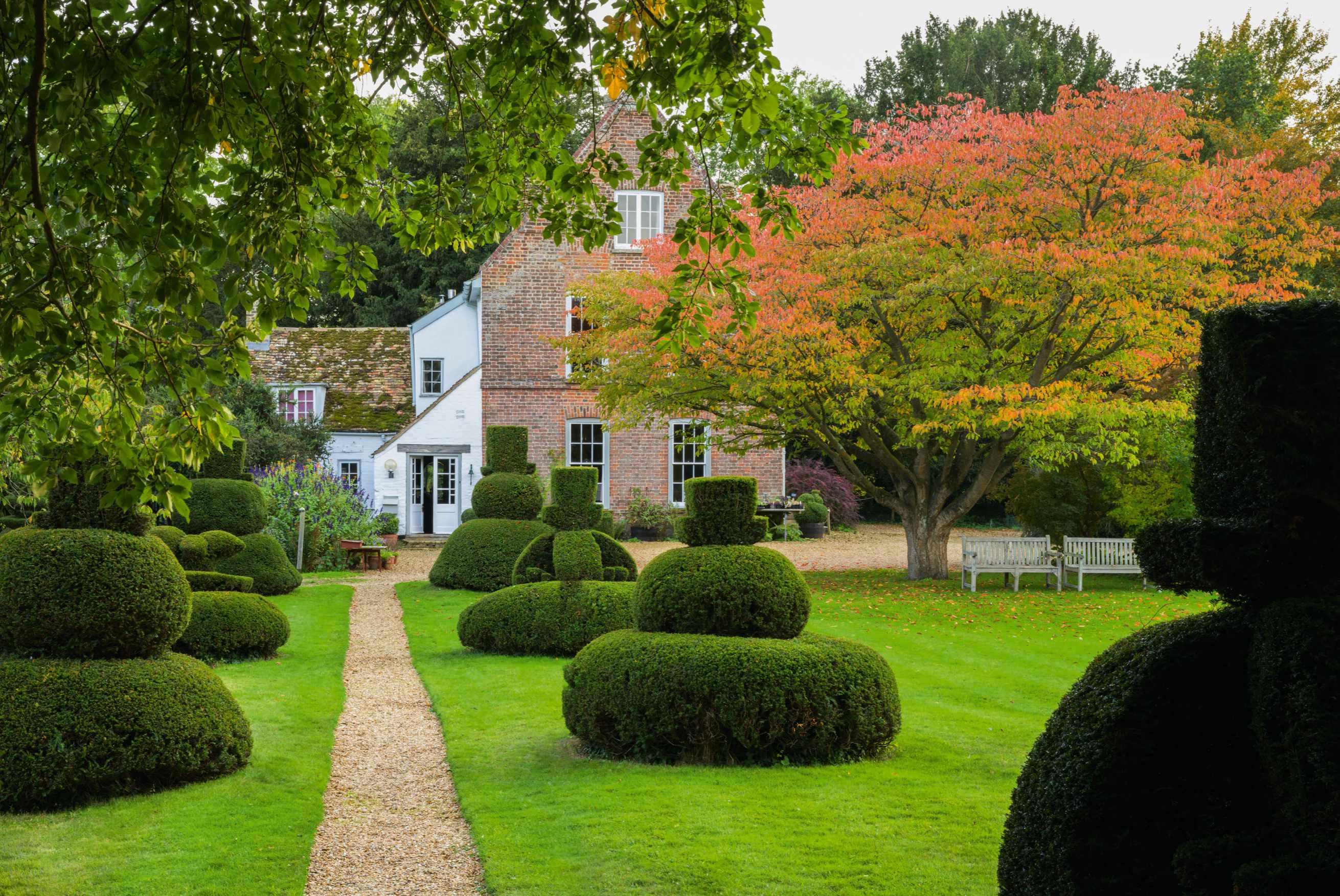
Lucy M Boston, the late author, painter and patchwork creator, first saw the Manor at Hemingford Grey while punting with her brother.
One of the two oldest inhabited dwellings in Britain, dating from the 12th century, it is Norman with Tudor and Georgian modifications and is moated on three sides. Lucy thought it ‘tranquil and unloved in its field beside the river’ and the memory never left her. It became so etched in her mind that 24 years later when a friend mentioned there was a house for sale in the village, she assumed it was the Manor. Taking a taxi from Cambridge, she knocked on the door; the owners were shocked –they had only discussed selling over breakfast.
Lucy, best known for the Green Knowe children’s books, bought the house on 31 May 1939, gardening from just after the Second World War until she died aged 97, on 25 May 1990. Inspired by childhood visits to Levens Hall in Cumbria, Lucy planted eight yews either side of a path down to the river. Topiary balls metamorphosed into cones, then pairs of orbs, crowns and the dove of peace from the old sceptre, with pieces of yew tied in to create the correct shapes for the coronation of Elizabeth II. “I think of them as coronation women,” says Diana Boston, Lucy’s daughter-in-law and the current custodian. “With their dowager humps and bunions, they
appear to be busy looking round each other to see what’s happening up at the house. They look particularly beautiful in the snow.”
With the help of her gardener, Lucy dug three long, rectangular borders, and when the garden flooded in 1947, she imported clay to raise the beds, though the lorries often became stuck in the waterlogged ground. Later flooding washed the clay deep into the subsoil, rendering her determined efforts futile. “Lucy just wanted to grow her favourite plants, mainly iris and old roses, as she loved fragrance. If a plant disliked the conditions or looked out of place, she would move it,” says Diana. Lucy became friends with rosarian Graham Stuart Thomas, who often visited the garden and sent her the best irises and old roses from Sunningdale Nurseries, mainly ramblers, bourbons and damasks. “At one time there were about 150; now we are down to around 50,” says Diana. Several originals remain, including Rosa ‘Tour de Malakoff’ with its magenta-purple flowers; R. ‘Sombreuil’, boasting creamy-white blooms; and R. ‘Duc de Guiche’, which “only flowers for a fortnight but the flowers are gorgeous, fragrant and it never has blackspot”. Irises remain prominent, with dedicated displays in the former vegetable garden and part of a long border, including the Cedric Morris cultivars ‘Benton Opal’, ‘Benton Deidre’ and ‘Benton Olive’.
To continue turn to page 74
Above The procession of so-called dowagers and other topiary in the garden is restyled once a year using a combination of shears and small electric trimmers. The whole process takes around ten days to complete.
Right In the borders flanking the grass path, autumn interest is provided by late-flowering asters and the foliage of herbaceous plants as they gradually change into myriad colours. During this time of transformation, structure gradually becomes prominent.
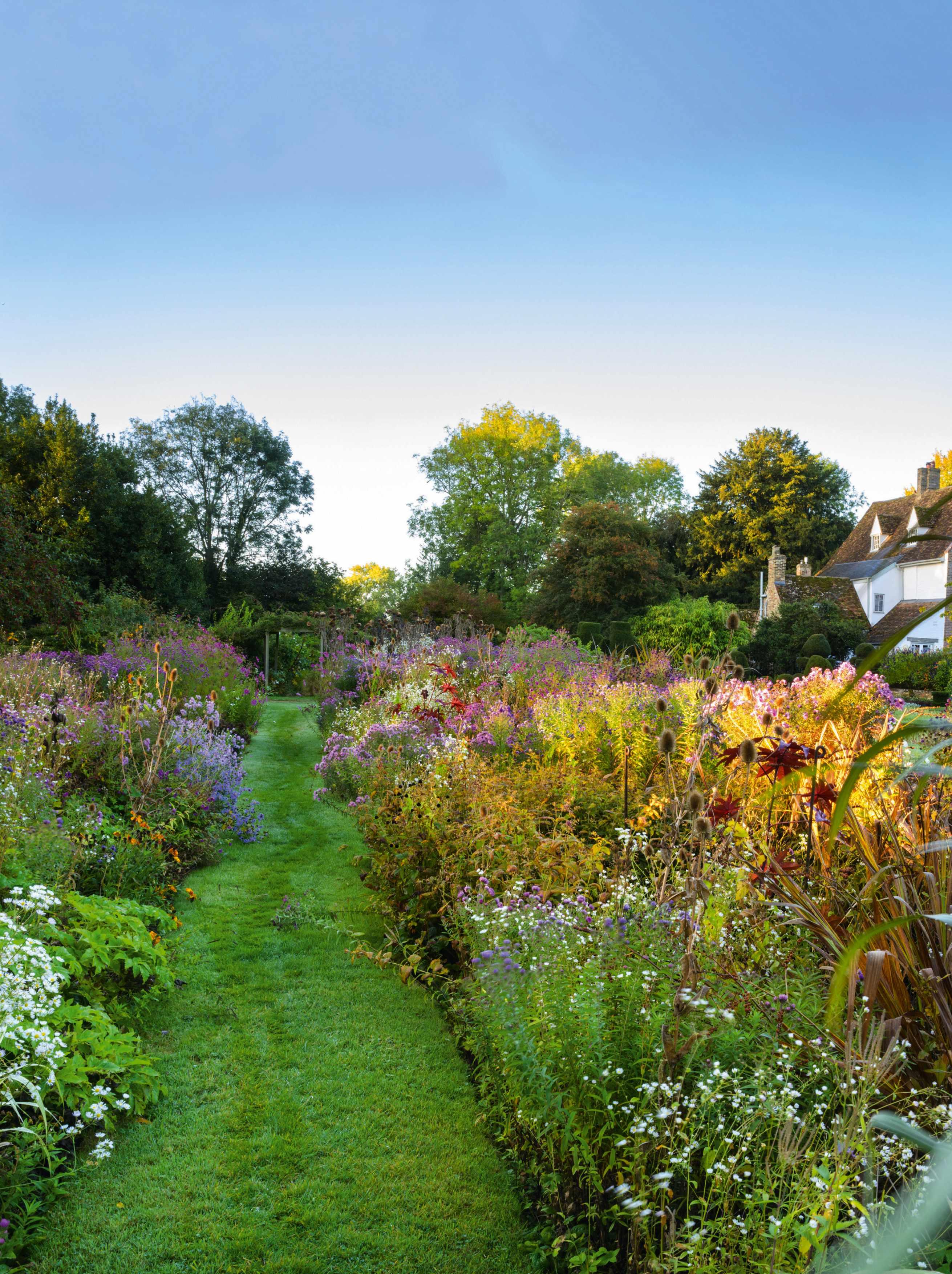
There
is always something that needs doing, but the garden gives back – there is always something having its special moment
The foreground to the old cart shed is a patchwork of subtle colour in autumn. This characterful building is the perfect support for vigorous rambling roses such as the almost thornless, pink-flowered Rosa ‘Léontine Gervais’ and the rambling musk rose Rosa moschata, with single white flowers followed by orange-red hips.
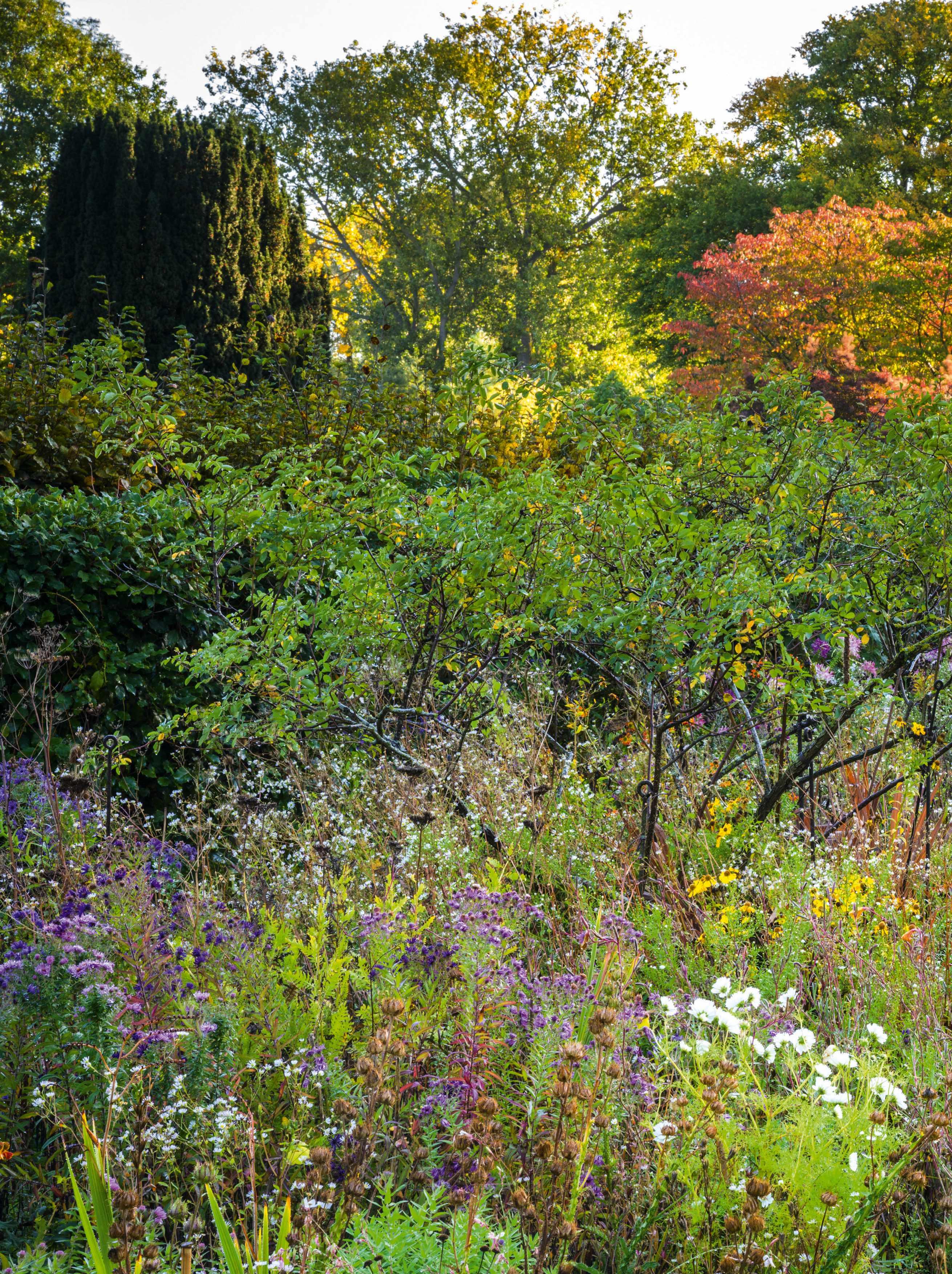
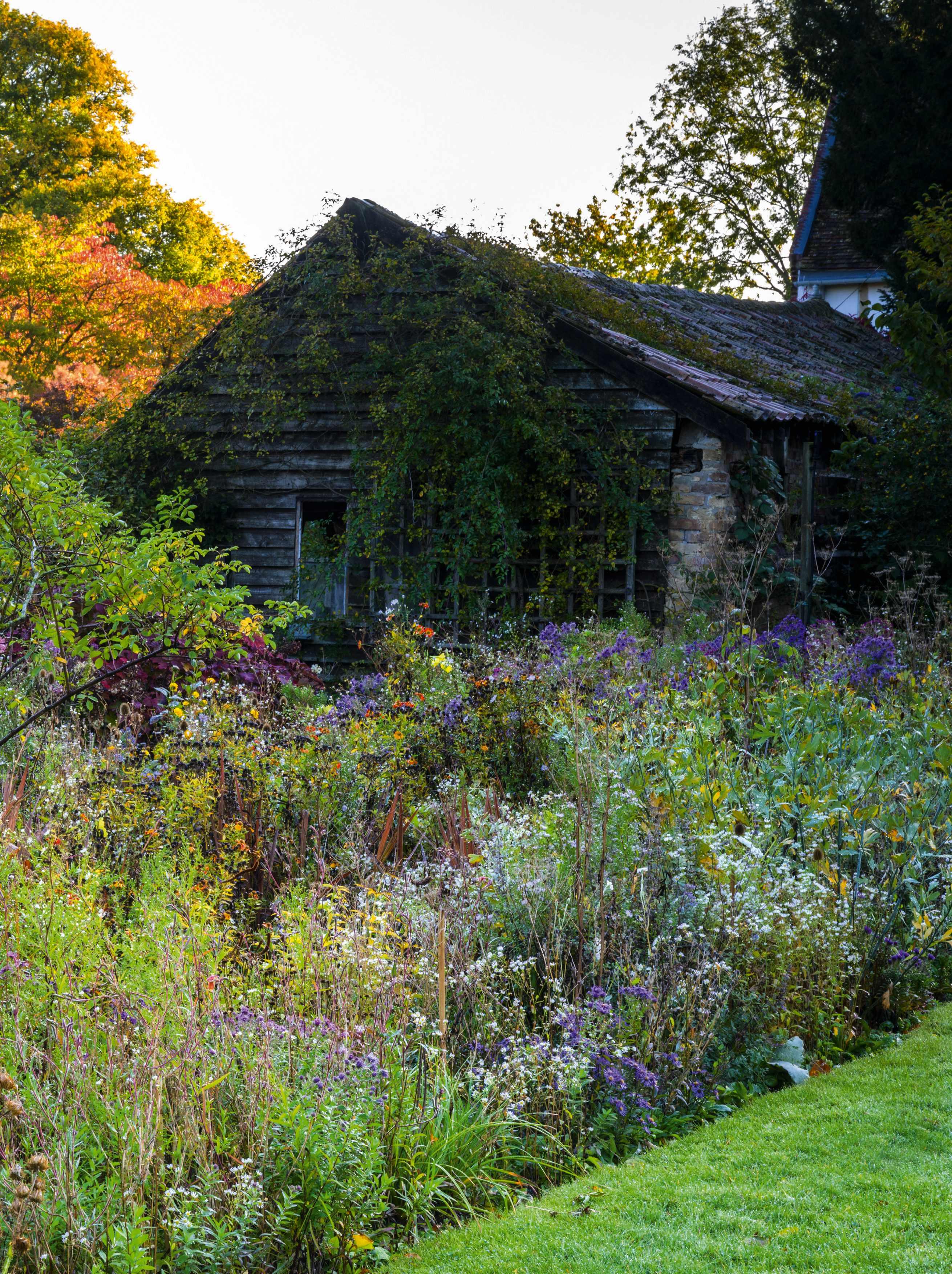
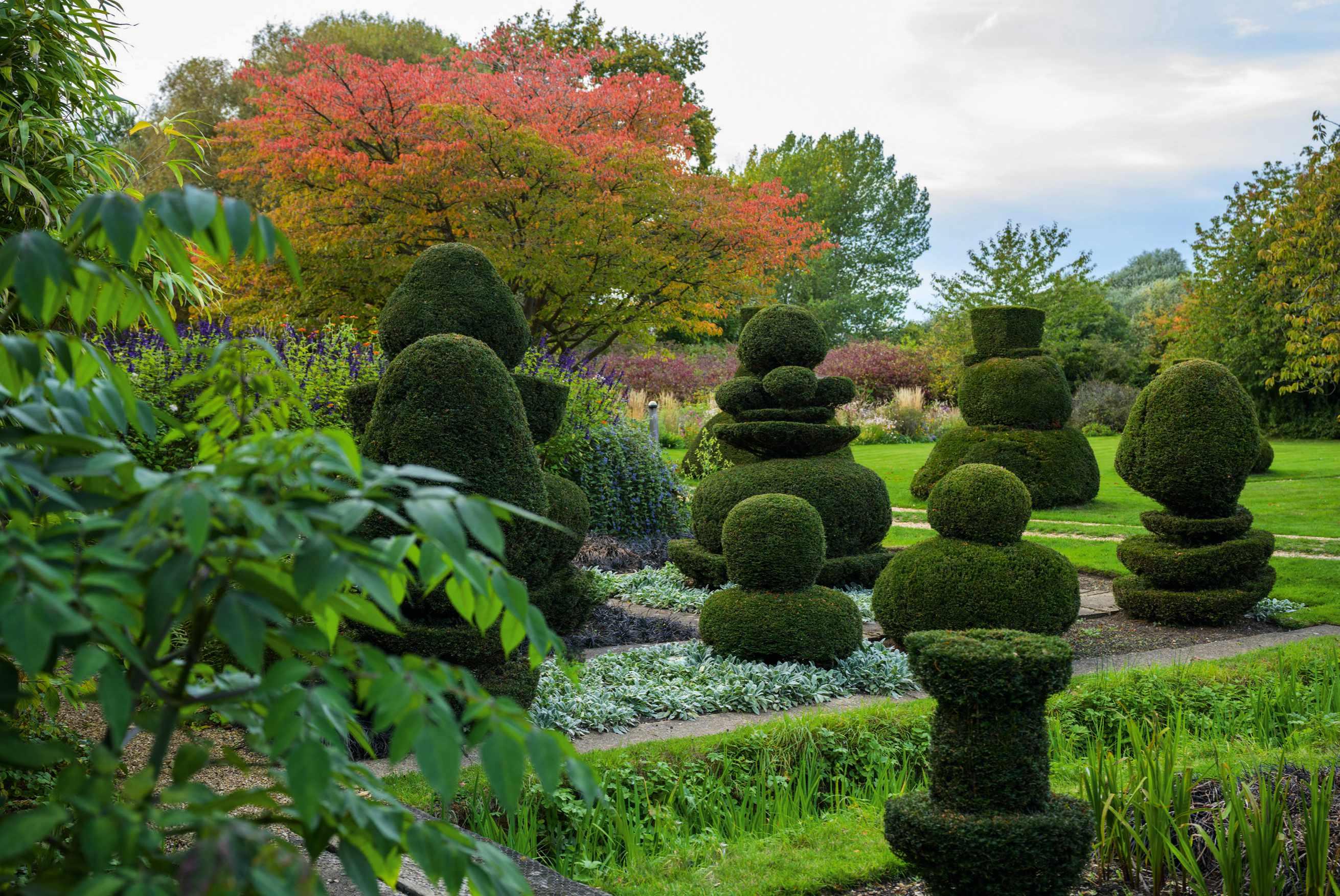
Lucy planted for winter interest and scent. Waxy, yellow-flowered Chimonanthus praecox, with its spicy fragrance, is now a huge bush. Fragrance floats from Lonicera fragrantissima and pink-purple flowered Daphne mezereum adds its glorious perfume. Late winter and early spring brings Galanthus nivalis with predominantly native and double Narcissus, both naturalised and in borders.
One day, towards the end of her life, with her eyesight failing, Lucy stood in a doorway, overlooking her garden. “What can you see?” she was asked. Lucy smiled and said: “I can see blue.” It was the sea of Scilla sardensis covering the earth among the topiary chess pieces and Rose Garden. Diana cared for her mother-in-law towards the end of her life, then took over the house and garden, and almost immediately opened it to the public. “The idea was slightly overwhelming, as it needed a lot of attention. I have since discovered that there is always something that needs doing, but the garden gives back – there is always something having its special moment, whatever the season. Thanks to our gardener, Kevin Swales, we keep up to date with new plants and ideas while maintaining the atmosphere of the garden as a very special place.”
The garden peaks from mid-May when the irises and traditional and modern rose gardens are filled with colour and bloom. Gardener Kevin has been hugely influential, extending the season of interest
by adding tender plants grown from cuttings and seeds. Salvias, such as purple ‘Amistad’ and velvetyred S. confertiflora provide later colour while gaps are filled with ‘exotics’ such as bronze Canna ‘Musifolia’, dark-leaved Saccharum officinarum var. violaceum and Cosmos galore. Lucy’s granddaughter Kate also looks after the garden.
The first meadow was created in 2013 when a group of marsh orchids appeared in the lawn –there are now well over 300. Fritillaria meleagris with its white-and-purple chequerboard blooms, and dainty, pink-flowered Silene flos-cuculi were added to the mix, and then a drier meadow was created, filled with the white-and-yellow flowers of Leucanthemum vulgare, the ox-eye daisy, adapting the garden but maintaining its spirit.
Lucy gardened from spring to autumn, and wrote books and created patchworks in winter. Her artisan’s hands with their broad, square fingers planted roses and clipped topiary, yet retained the dexterity and sensitivity to hold a fine needle to stitch. A remarkable and versatile woman, with a legacy of a remarkable and versatile garden. ■
Address The Manor, Hemingford Grey, Huntingdon, Cambridgeshire PE28 9BN. Tel 01480 463134 Web greenknowe.co.uk Open Daily, 11am-5pm; and the house by appointment.
Above Chess pieces created by Lucy in the 1950s sit on a chequerboard of Ophiopogon planiscapus ‘Kokuryu’ and Stachys byzantina, planted by gardener Kevin Swales in 2010, the latest incarnation in decades of different ideas.
Right Erigeron annuus and selected Symphyotrichum cultivars express themselves freely in a relaxed, cottagegarden style, while Ricinus communis ‘Gibsonii’ provides bright, bold foliage and structure.
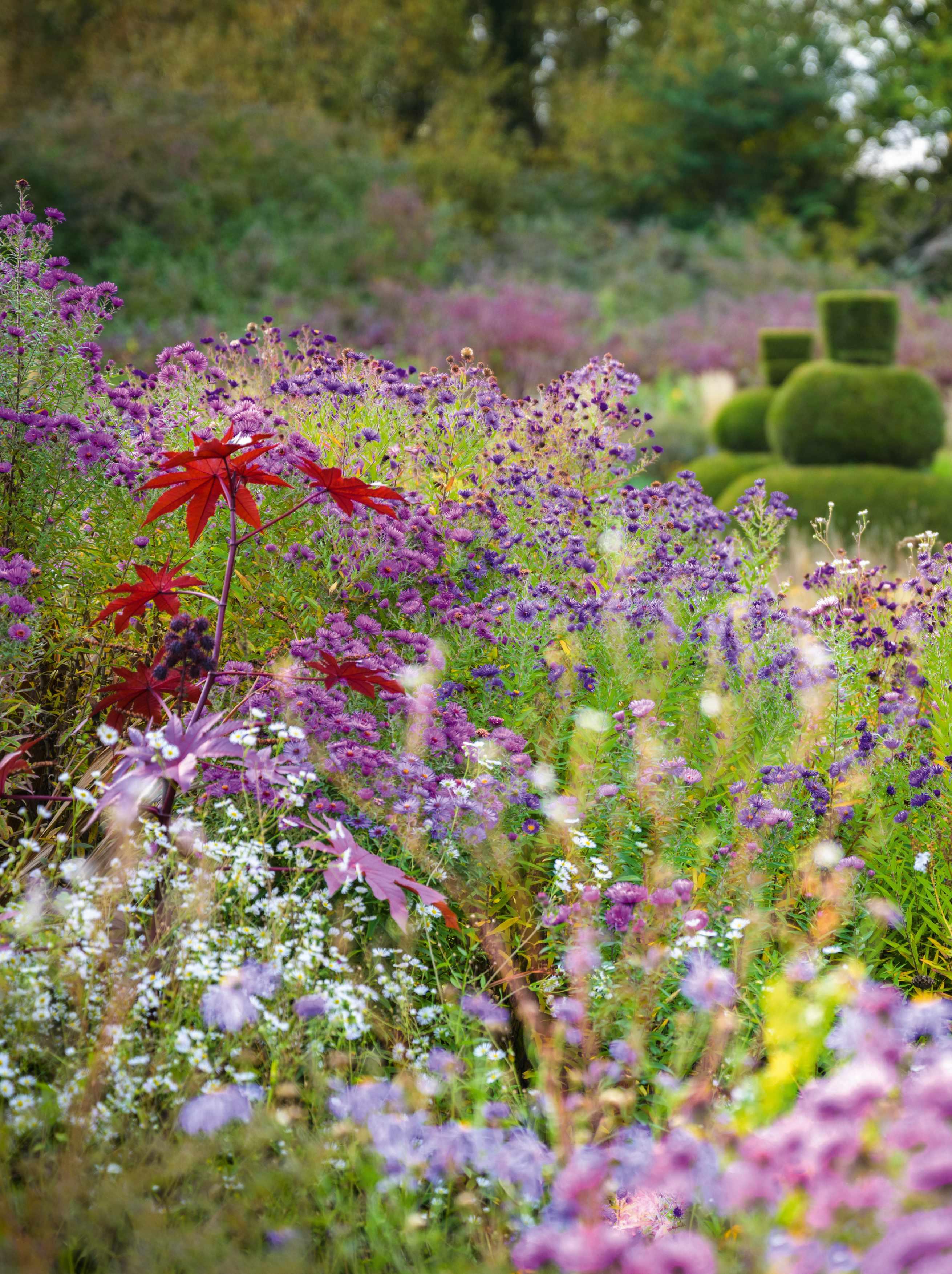
We keep up to date with new plants and ideas while maintaining the atmosphere of the garden as a very special place
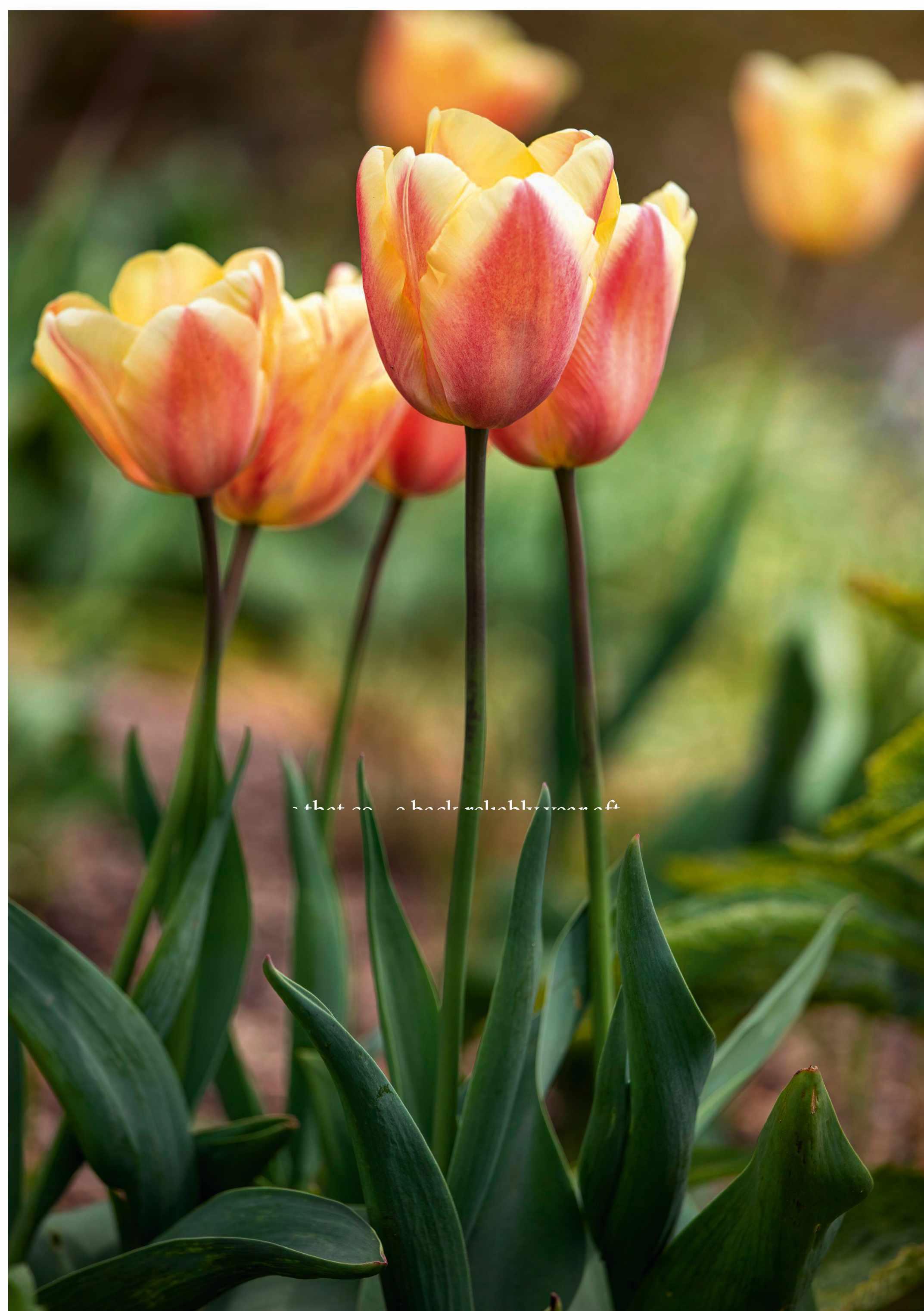
Looking for bulbs that come back reliably year after year? We asked plant experts and growers for their advice on reliably perennial tulips, plus other beautiful spring bulbs to grow with them
WORDS VERONICA PEERLESS s aft
Concerns around sustainability – not to mention our increasingly restricted wallets and time – mean that many of us are looking for longer-term, reliably perennial spring bulb displays. Tulips are, of course, a must for spring colour, but hybrids (the tall, showy types that give the best display) have been bred to perform well for just one year. So how can we achieve brilliant spring displays without having to buy fresh bulbs every year?
One option is to choose a naturally perennial tulip. These include species tulips and their primary hybrids such as Tulipa greigii, T. kaufmanniana, T. praestans, T. tarda and T. turkestanica. However, they are generally short in stature, with smaller flowers, so tend not to work well in borders. Not all species tulips last well in British gardens, either, thanks to our wet climate – in the wild, they hail from very well-drained spots in hot climates. They therefore grow best where they have good drainage, for example in raised beds, gravel gardens or rockeries, or where they are sheltered from rain, such as under a tree or hedge.
Viridiflora tulips have chlorophyll in their flowers, which are tinged with green. Because the flower photosynthesises too, the bulb has extra reserves of energy, and so is more likely to bloom year after year. Viridiflora tulips include T. ‘Spring Green’, ‘Groenland’ and ‘Artist’, and the new ‘Orange Marmalade’.
Darwin hybrids, a cross between T. fosteriana and more conventional hybrid tulips, are also reliably perennial. They have huge flowers and very large bulbs, and
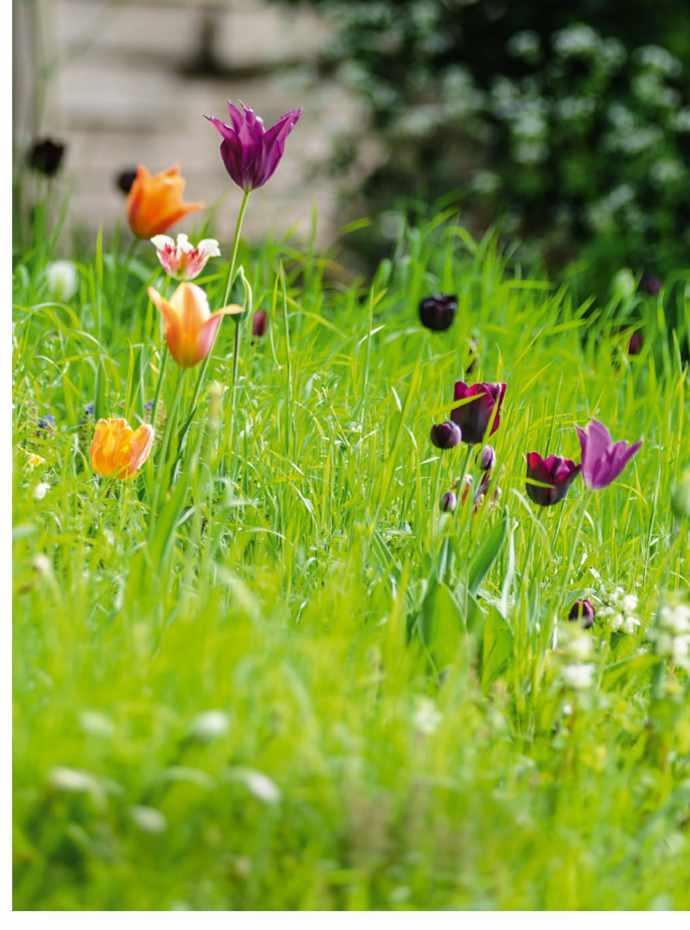
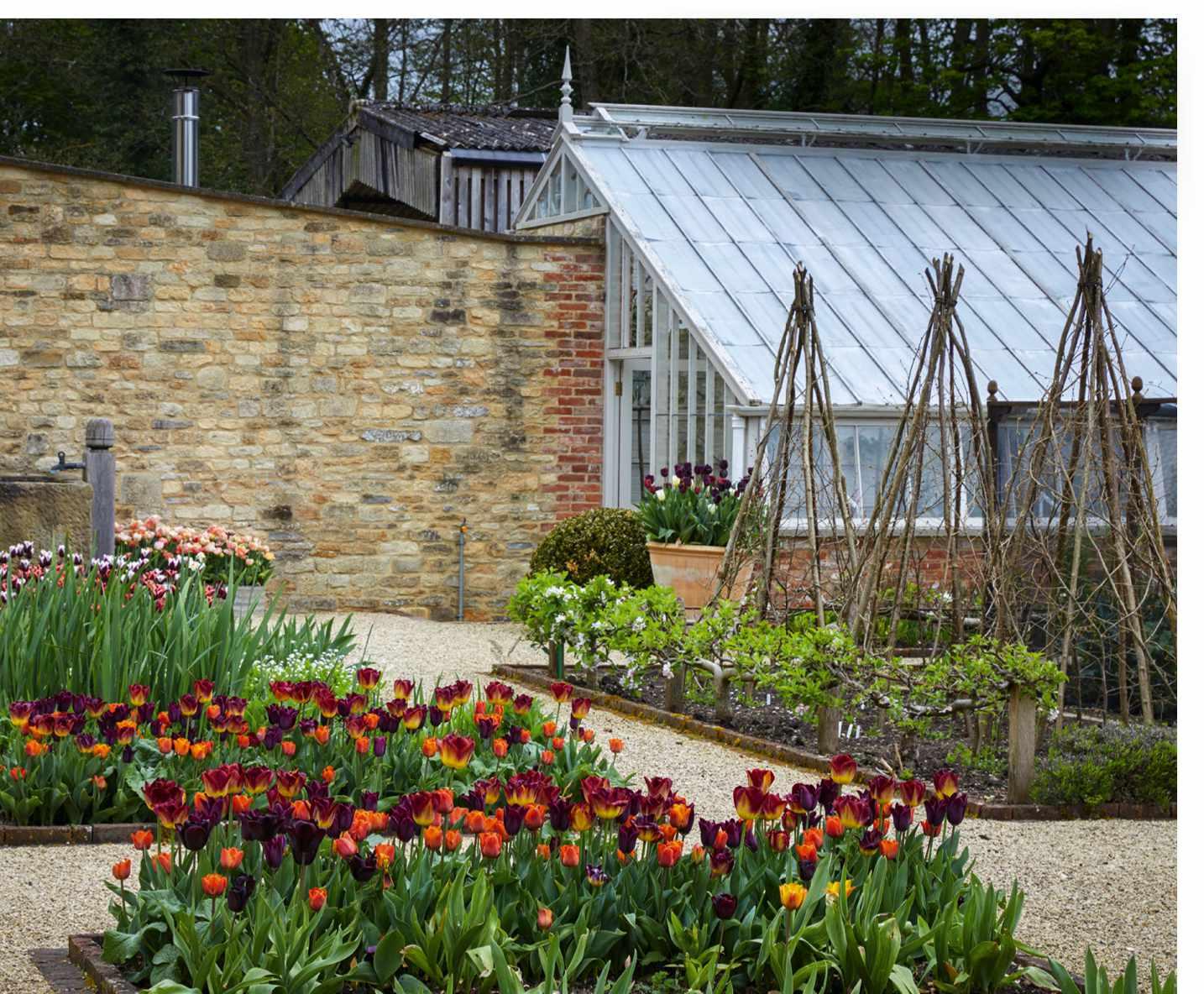
“I’ve found that with perennialising tulips, it’s down to variety, but also site and situation. We’ve found that it’s under hedges and below fruit trees that tulips have perennialised effectively” SARAH RAVEN
usually come in red, orange, yellow or pink. They include the bright-red ‘Apeldoorn’ and the Impression Series.
We’ve probably all noticed tulips that come back year after year in our gardens that fall outside of these categories. “We have extensive plantings of annual tulips that are grown as perennials in our walled garden and naturalised in grass,” says Polly Nicholson, expert tulip grower and owner of Baytun Flowers in Wiltshire. “Over the years we have developed a master list of those that perform most reliably for us year on year,” she says, but suggests experimenting to see which tulips work best for your soil, aspect and personal taste. She recommends the Purissima Series of tulips, including T. ‘Purissima’, ‘Flaming Purissima’, ‘Mystic van Eijk’ and ‘Greenstar’.
Bulb expert and supplier Sarah Raven says: “T. ‘Mistress Mystic’, a grey-pink Triumph tulip, has totally perennialised under a fruit tree at Perch Hill and ‘Jan Reus’, ‘Apricot Foxx’ and ‘Request’ have perennialised for us under a hawthorn hedge.” The deep-red ‘Kingsblood’ is reliably perennial at both Arundel Castle in West Sussex and Forde Abbey in Dorset.
“Tulips are the most demanding of all bulbs, so they need perfect circumstances to be able to perform well,” says Dutch bulb expert Jacqueline van der Kloet. “They should be planted in November when the soil has cooled down a bit. They should be planted deep (at least at 15cm depth) in a well-drained, not too poor soil in a sunny spot. They need lots of sunlight and warmth. And they are greedy, so I use organic fertiliser when they start to grow, in February to March.”
And if you want your bulbs to perennialise, Dutch designer and bulb expert Carien van Boxtel suggests copying Dutch bulb growers: “Deadhead first; take away the petals as they can infect the bulbs; dig them up after the stems have died and store them dry. Then plant them in the autumn again. But never exactly in the same spot” – because of the risk of tulip fire (see over page).
Sarah Raven has found that with perennialising tulips, it’s down to variety, but also site and situation. “Gardeners tend to put them in ‘overfed’ beds where
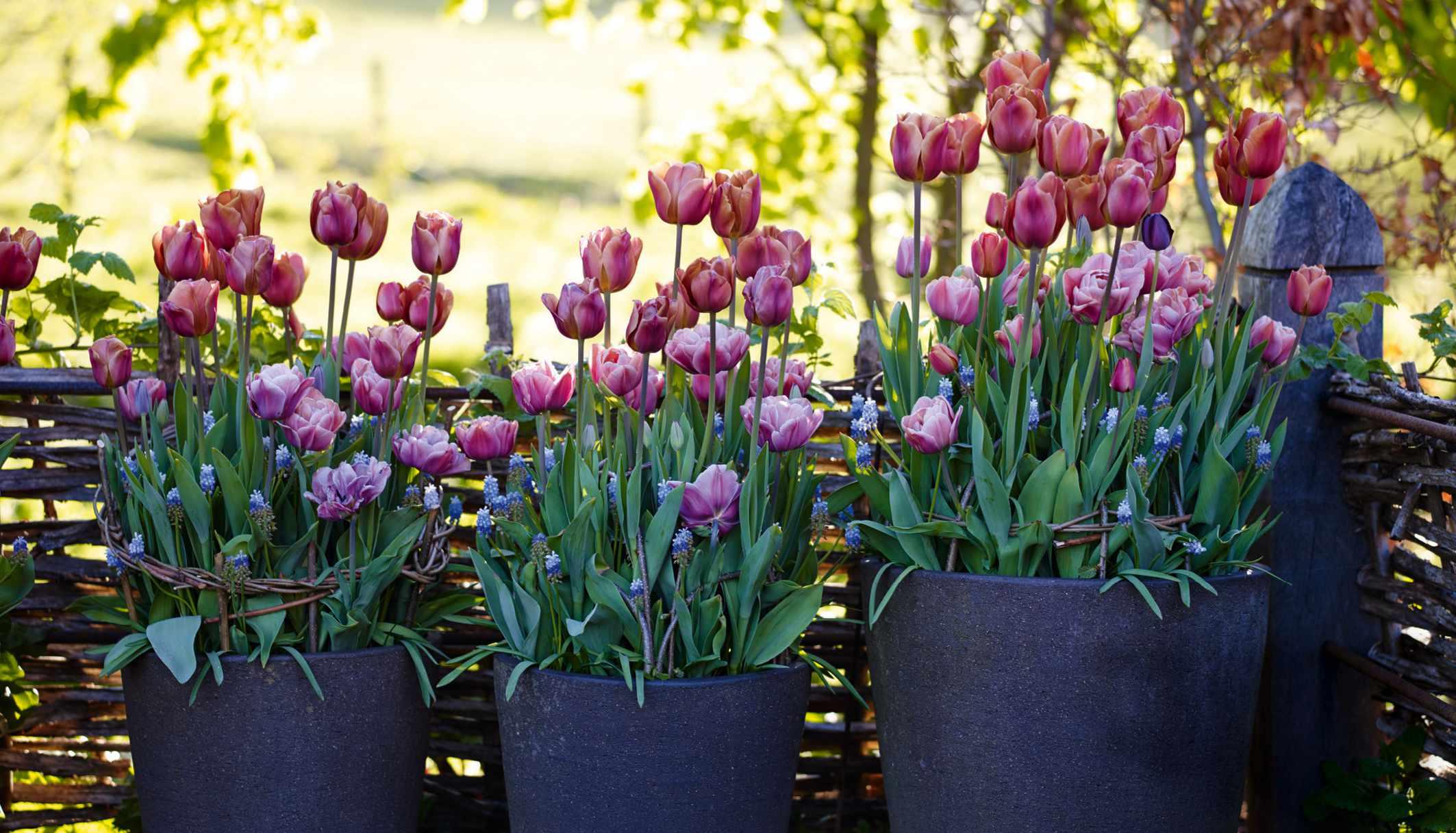
there’s tonnes of organic matter. But in the wild, they’re on top of a boulder with 3cm of organic matter that has built up over millennia. That’s where they thrive. We have found that under hedges, under fruit trees and below artichokes, which are famously quite hungry and thirsty, are where tulips have perennialised very effectively.”
“Don’t be greedy and create plantings that are too dense,” advises Polly Nicholson. “You will find that the tulips stop performing for you and disease is more likely to spread.”
Sissinghurst Castle Garden in Kent will not have any tulip displays in 2024, following an outbreak of the fungal disease known as tulip fire (Botrytis tulipae) this spring. Head gardener Troy Scott Smith and his team have dug up every infected tulip bulb in the garden, and are not planting any more this autumn, even in pots. Sarah Raven has also dug up thousands of infected bulbs at nearby Perch Hill and is only planting in pots this year. She is trialling the use of a home-made organic fungicide made from bicarbonate of soda, sunflower oil and liquid soap that has been used successfully to treat mildew on Ranunculus growing in the greenhouse.
However, she points out that this spring was particularly wet, and that she previously hadn’t been affected by tulip fire for many years. She adds: “We’ve had really good success with growing the species varieties in grass. In grass, you don’t get the fungal spores of tulip fire spotting upwards
as you do from soil We had no tulip fire at all on various species varieties.”
Polly Nicholson points out that not all tulip problems this spring were due to tulip fire. Incessant rain and warm temperatures in March, a critical time of growth, made this a tricky year for tulips.“Many growers feared their crops and stocks had been struck by the dreaded tulip virus, but much of the damage was simply weather related When I harvested bulbs in July I inspected them very carefully for signs of damage (usually presenting as black spots under the bulb tunics) and they were nearly all lovely and clean,” says Polly. “Any suspicious-looking ones were thrown on the bonfire, rather than the compost heap.”
She adds: “I recommend planting a little further apart than normal, to allow air
“I recommend planting a little further apart, to allow air circulation and to prevent diseased parts of one tulip from touching another” POLLY NICHOLSON
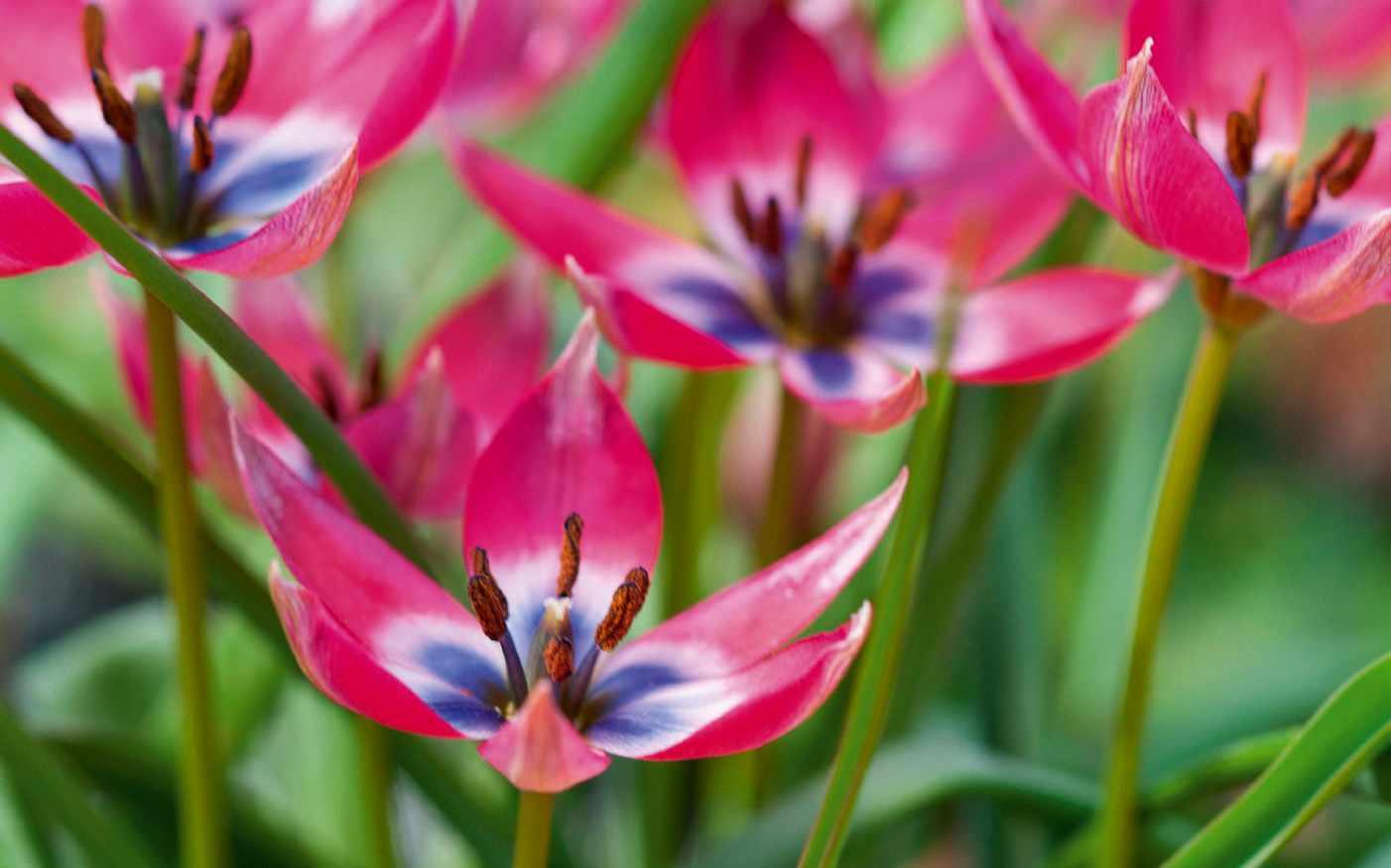
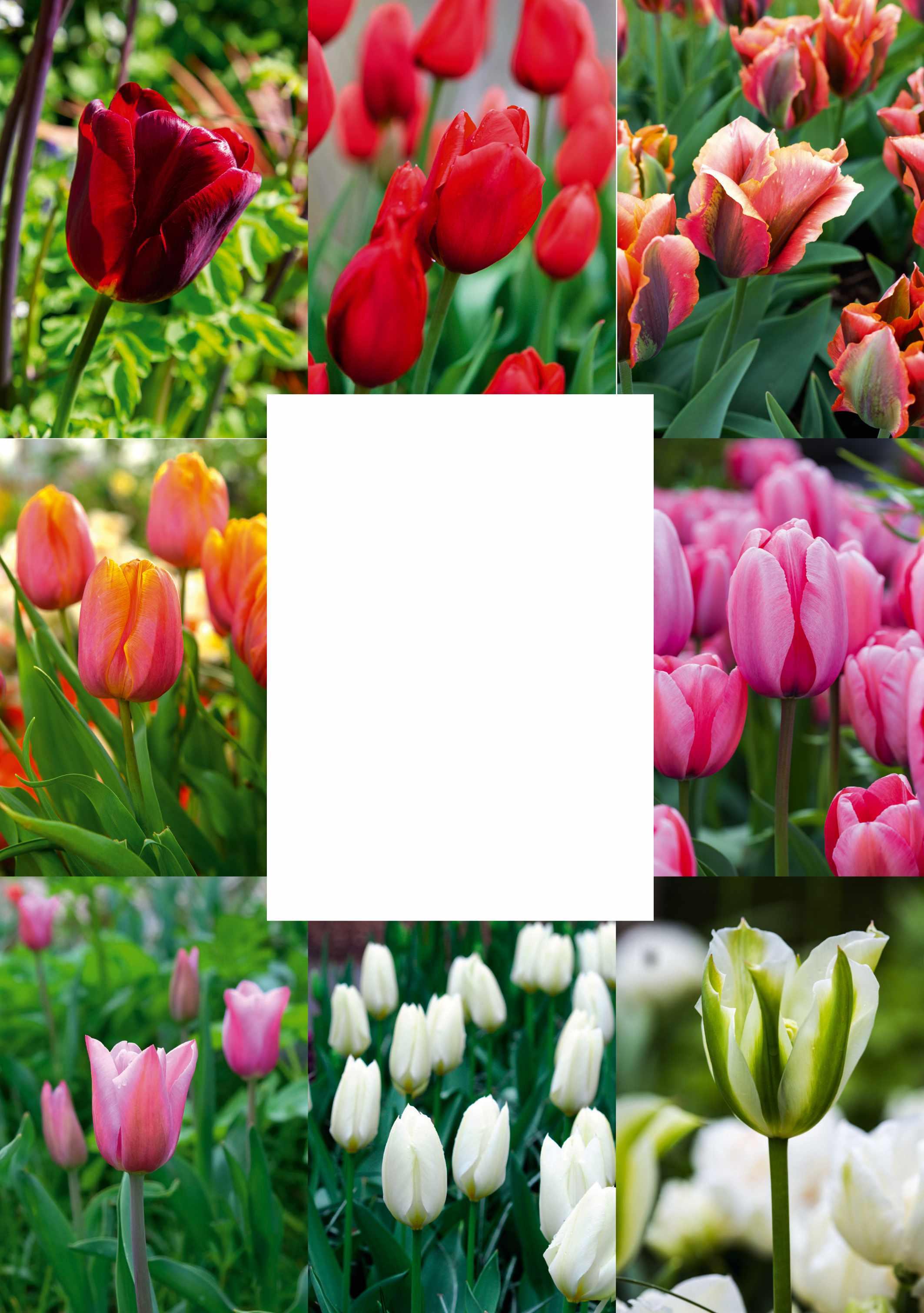
These cultivars are reliably perennial, provided that they are grown in optimal conditions
1 Tulipa ‘Jan Reus’ A mid-season Triumph tulip that has perennialised under a hedge for Sarah Raven. 50cm. RHS H6.
2 Tulipa ‘Kingsblood’ Single late cultivar that comes back reliably at Forde Abbey and Arundel Castle. 60cm. AGM*.
3 Tulipa ‘Artist’ Viridiflora type ranging in colour from orange to dusky pink, tinged with green. 30cm. AGM. RHS H6.
4 Tulipa ‘Mystic van Eijk’ Darwin hybrid, with large flowers, streaked red, on a cream background. 60cm. RHS H6.
5 Tulipa ‘Pink Impression’ Charming Darwin hybrid, with deep-pink flowers. 55cm. AGM. RHS H6.
6 Tulipa ‘Mistress Mystic’ Smoky-pink Triumph tulip, reliably perennial under a fruit tree for Sarah Raven. 45cm. RHS H6.
7 Tulipa ‘Purissima’ Sometimes sold as T.‘White Emperor’, this is a large, creamy-white Fosteriana tulip. 30cm. AGM. RHS H6.
8 Tulipa ‘Spring Green’ Elegant green and ivory Viridiflora tulip. 45cm. AGM. RHS H6.
*Holds an Award of Garden Merit from the Royal Horticultural Society. †Hardiness ratings given where available. Find more perennial tulips at gardensillustrated.com/tulips
Many spring bulbs are, of course, reliably perennial. We asked some top gardeners what they will be planting this year
Sissinghurst Castle
In the absence of tulips the team is focusing on narcissi, hyacinths, fritillaries and alliums to enhance spring displays of Erysimum, Lunaria and Hesperis. “Older cultivars that reflect the early 20th century are preferred to give a more authentic feel,” says Helen Champion, assistant head gardener. In pots, hellebores with a succession of snowdrops, crocuses, Muscari and Iris reticulata are planned for early winter and spring, to be followed by heritage daffodils such as Narcissus ‘White Lady’, N. ‘Cragford’, N. ‘Avalanche’ and N. poeticus ‘Plenus’.
Polly Nicholson
“I also grow a wide range of narcissi, favouring the smaller, heritage types. This year I am trying a few interesting, old cultivars in pots – N. ‘Irene Copeland’ (1915), thickly ruffled with scented, creamy petals; and N. ‘Elvira’ (1902), a bright-white and late-flowering tazetta. We are also favouring naturalised plantings of the Tenby daffodil and poeticus hybrids. And fritillaries too,
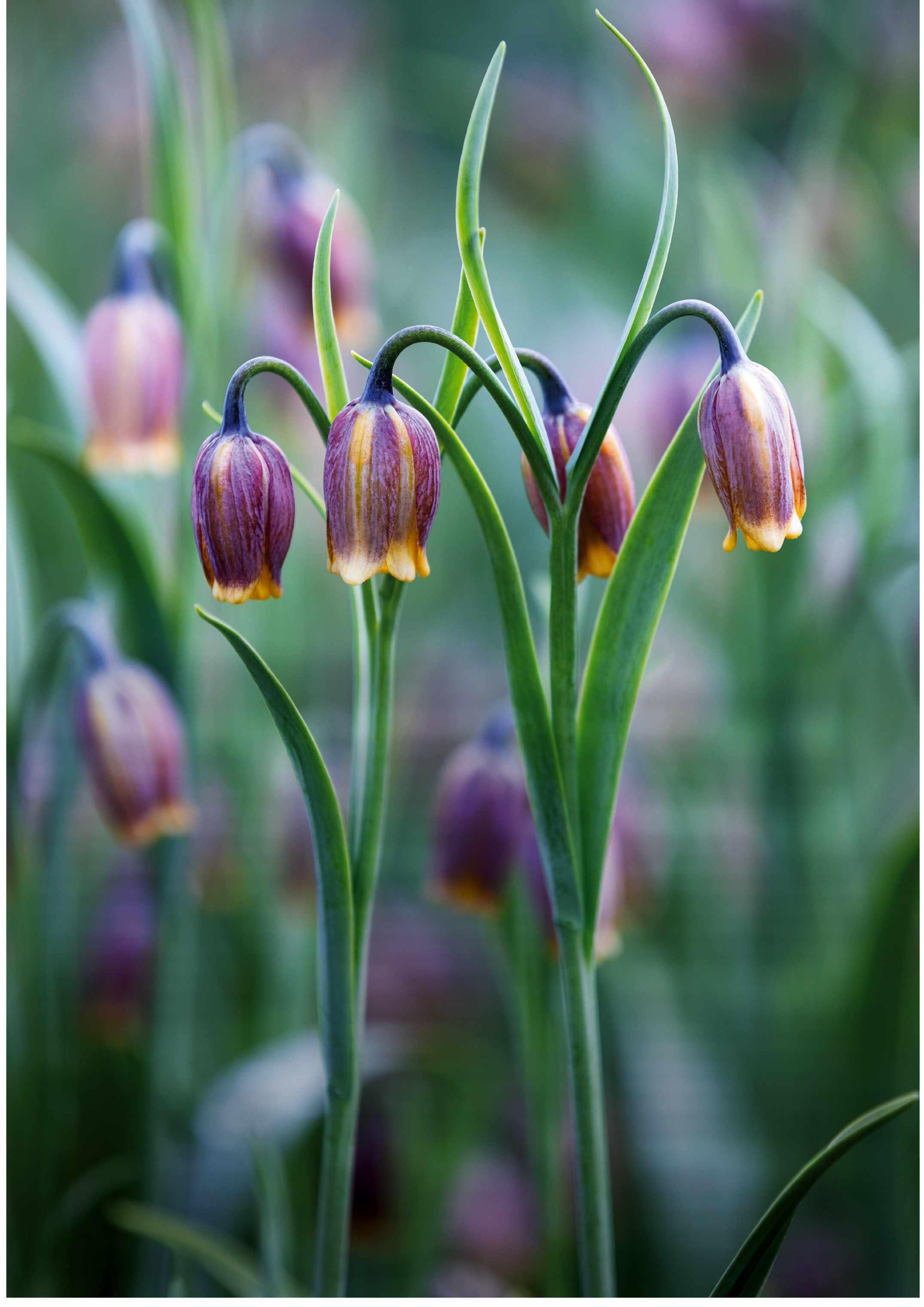
of course, with the classic snake’s head happily spreading through a lawn-turnedmeadow, Fritillaria uva-vulpis (above) dotted through the gravel of the walled garden and F. acmopetala in rough grass at the further reaches of the garden.”
Jacqueline van der Kloet
“I like spring displays with a long flowering period, so I try to use species in a sequence of flowering periods. Tulips especially go well with crocuses, Scilla, Muscari, delicate daffodils such as N. ‘Lemon Drops’, ‘Thalia’, ‘Sailboat’ and ‘Geranium’, and early ornamental onions such as Allium nigrum. Besides that we’ll be planting pansies, wallflowers, Bellis, Brunnera, Aquilegia, Lunaria, Hesperis and early ornamental grasses such as Milium effusum ‘Aureum’.”
Arundel Castle
The mix of bulbs and bedding plants includes hyacinths, narcissi, Myosotis, Scilla, Muscari, crown imperials, camassias, Fritillaria meleagris and wallflowers.
Forde Abbey
Tulips are used in conjunction with wallflowers, daffodils, honeysuckle, Euphorbia, Hesperis and woad.
RHS Garden Wisley
Curator Matthew Pottage uses camassias heavily for spring displays (planted through lawns) and these are left as perennial. “We’ve done a similar thing with Leucojum aestivum ‘Bridesmaid’, crocuses, narcissi and alliums.”
Hever Castle
“Our first Spring Celebration event will follow the snowdrops and daffodils, and trumpet the tulips, hyacinths and blossom that will be out across the estate,” says head gardener Neil Miller. In the entirely blue Blue Corner, there will be hundreds of ‘King of the Blues’ hyacinths.
Rachel Siegfried
“I always focus on narcissi, anemones and Ranunculus for spring,” says cutflower grower Rachel. “ The anemones and Ranunculus produce more than one flower per bulb over four to six weeks.”
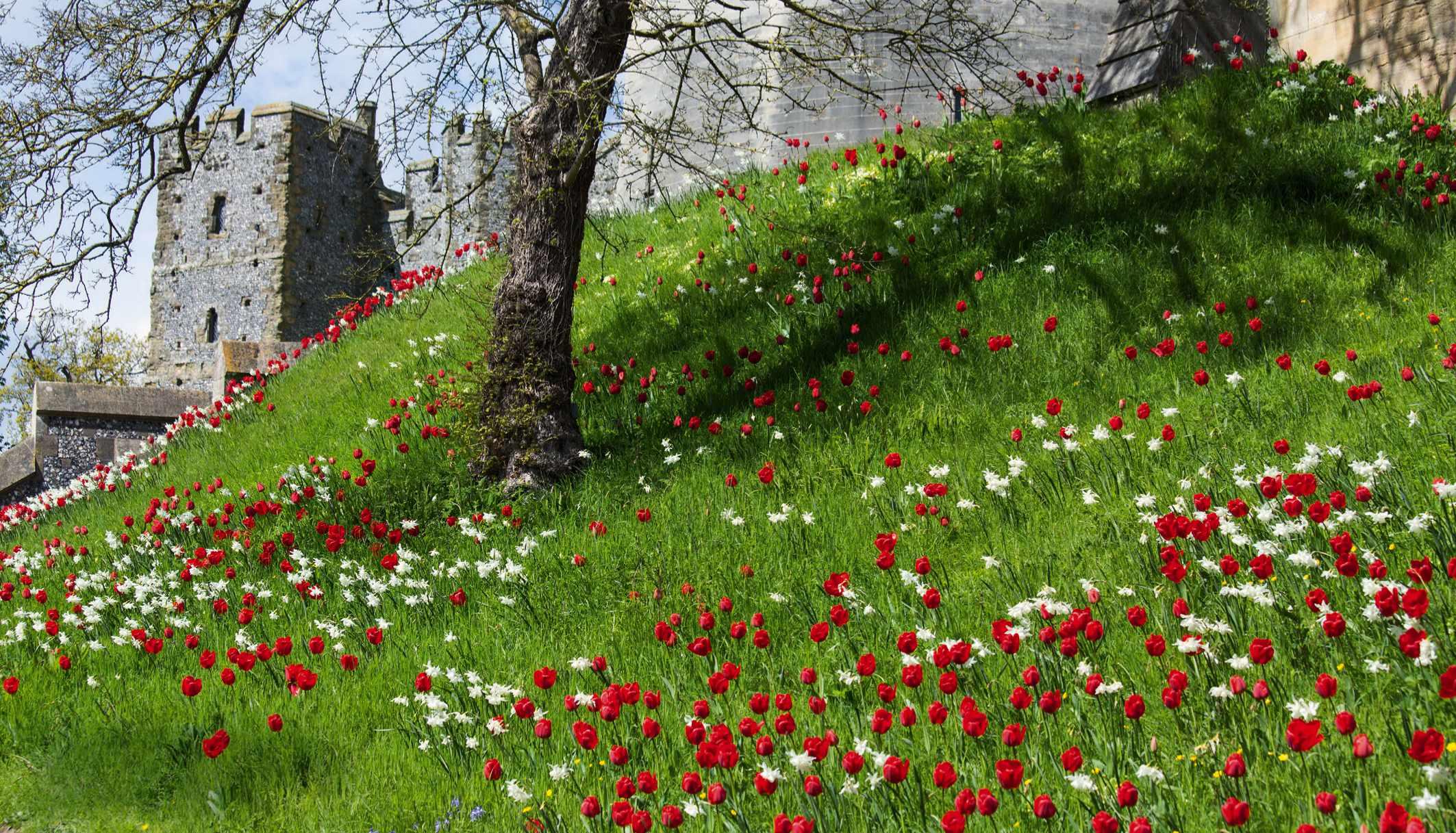
“The number of tulips I purchase each autumn has reduced dramatically”
POLLY NICHOLSON
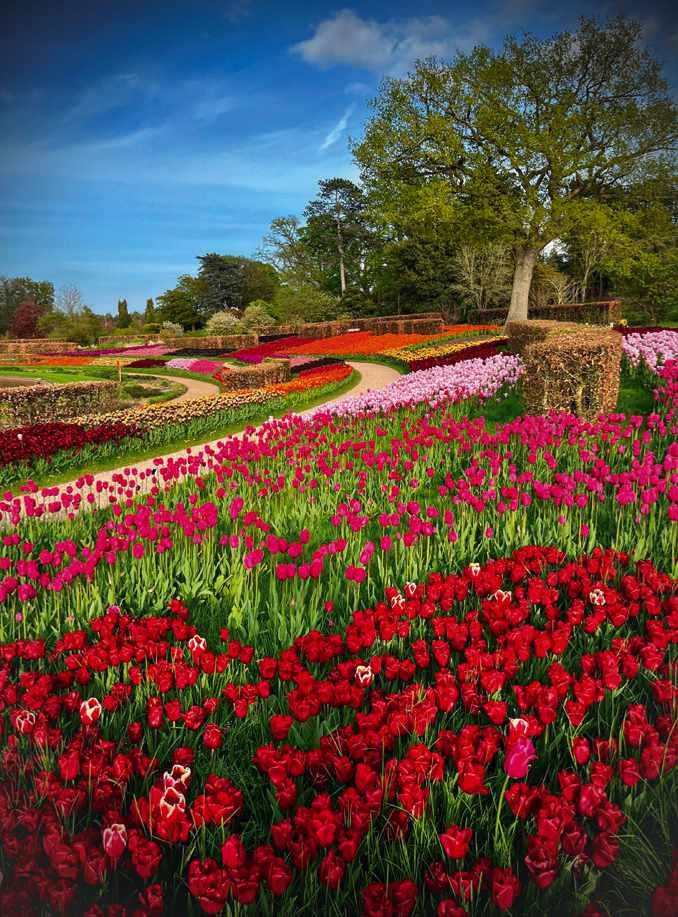
circulation and to prevent diseased parts of one tulip from touching another. Carefully remove any that are spotted and mouldy, making sure to disinfect tools afterwards, and don’t let spent petals build up on the soil. We operate a four-year rotation in our flower field, so that a bed which has been planted with tulips for cutting remains tulip-free for three years, to allow any pathogens lurking in the soil to dissipate.” Rotation is also followed by other gardens, including Arundel Castle.
However, if you’re worried about tulip fire, Guy Barter, chief horticulturist at the RHS, offers some reassurance.“There is no reason to forswear tulips this autumn except in areas where the disease has occurred in the previous year or two,” he says.“But gardeners of a nervous disposition may wish to grow them in containers.”
“The number of bulbs I purchase each autumn has reduced dramatically,” says Polly Nicholson.“I recycle many of the bulbs I grow – bulbs are purchased new for container combinations, lifted, dried and replanted as perennials to fend for themselves. I am passionate about species tulips and would encourage others to try them.”
Many gardens are also now lifting tulips less. Jacqueline van der Kloet says: “I have always planted tulips as a part of all the ingredients that make a border, rather than in blocks (which I think looks unnatural). And I never take the bulbs out after they have flowered (deadheading them at the right moment, leaving the foliage until it has turned
yellow) so they can come back year after year.”At Forde Abbey, owner and head gardener Alice Kennard is also lifting less and planting fewer tulips each year and making use of species tulips T. turkestanica and T. sprengeri, plus T. ‘Kingsblood’. At Arundel Castle, head gardener Martin Duncan is doing something similar: “In the Tropical and Herbaceous borders along with areas of the castle landscape we keep the tulips in situ, topping them up occasionally.” Meanwhile Carien van Boxtel now only plants hybrid tulips in large pots or raised beds, relying on naturalising bulbs elsewhere.“Every year I make new combinations – and yes, I buy new bulbs. It allows me to enjoy my most favourite flower in the world.”
Many large gardens, including Arundel and Hever Castle, now plant tulips in grass.“We did this by using a mechanical bulb-planter which was advantageous to wildlife as there was less disturbance to the ‘residents’ and insects,” says Neil Miller, Hever’s head gardener. At RHS Garden Wisley, 100,000 bulbs were planted in grass for the tulip festival this year.“We’ve removed all areas of bedding display from Wisley, but we planted the bulbs through the lawns, then mowed them off and composted them afterwards,” says curator Matthew Pottage.“It involved little soil disturbance and no extra fertiliser or water. The response from visitors was phenomenal – people love ‘massed’ tulips and a sea of colour, no matter what the ‘good-taste brigade’ stipulates.” ■
Find out more about tulip fire at gardensillustrated.com/tulipfire
Head to the Gardens Illustrated website for more exclusive content on gorgeous gardens and the best seasonal plants. You’ll also find the latest horticultural news and details of upcoming events – plus podcasts, offers and competitions
Join Apple Day activities up and down the country or find inspiration for hosting your own festivities.
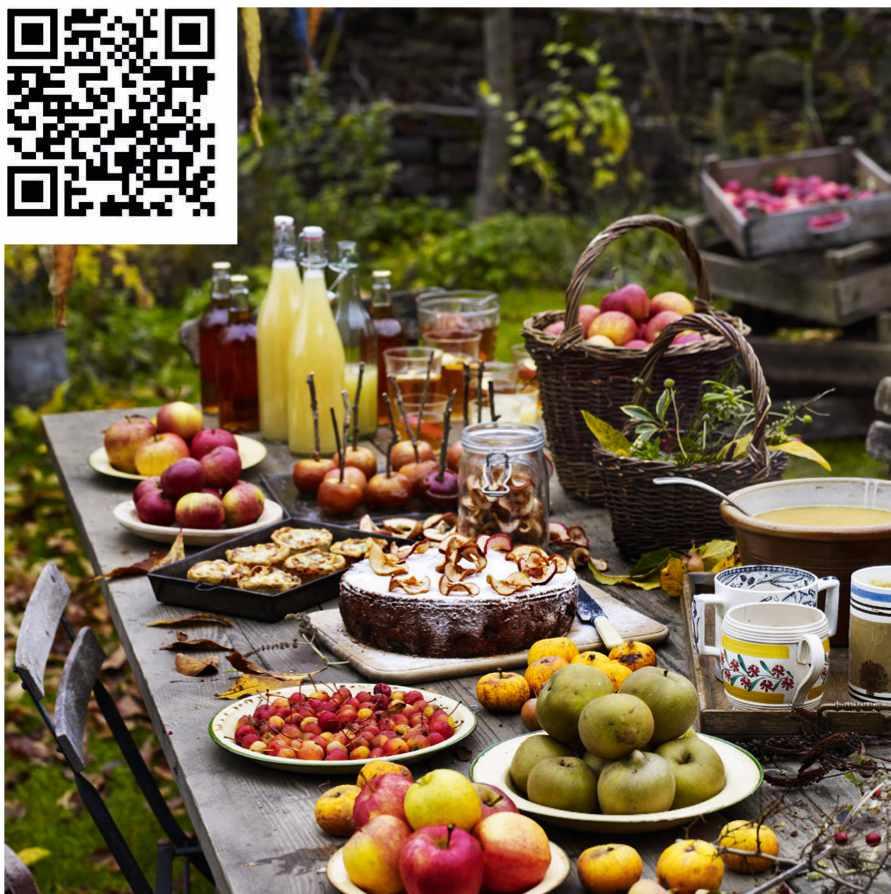

Growers and gardeners recommend 52 plants that continue to perform even as the days draw in.
Find out how head gardeners and bulb experts prevent squirrels from eating their precious bulbs.


As AI encroaches on all aspects of our lives, Ken Thompson considers the role of garden robots – and finds them wanting.
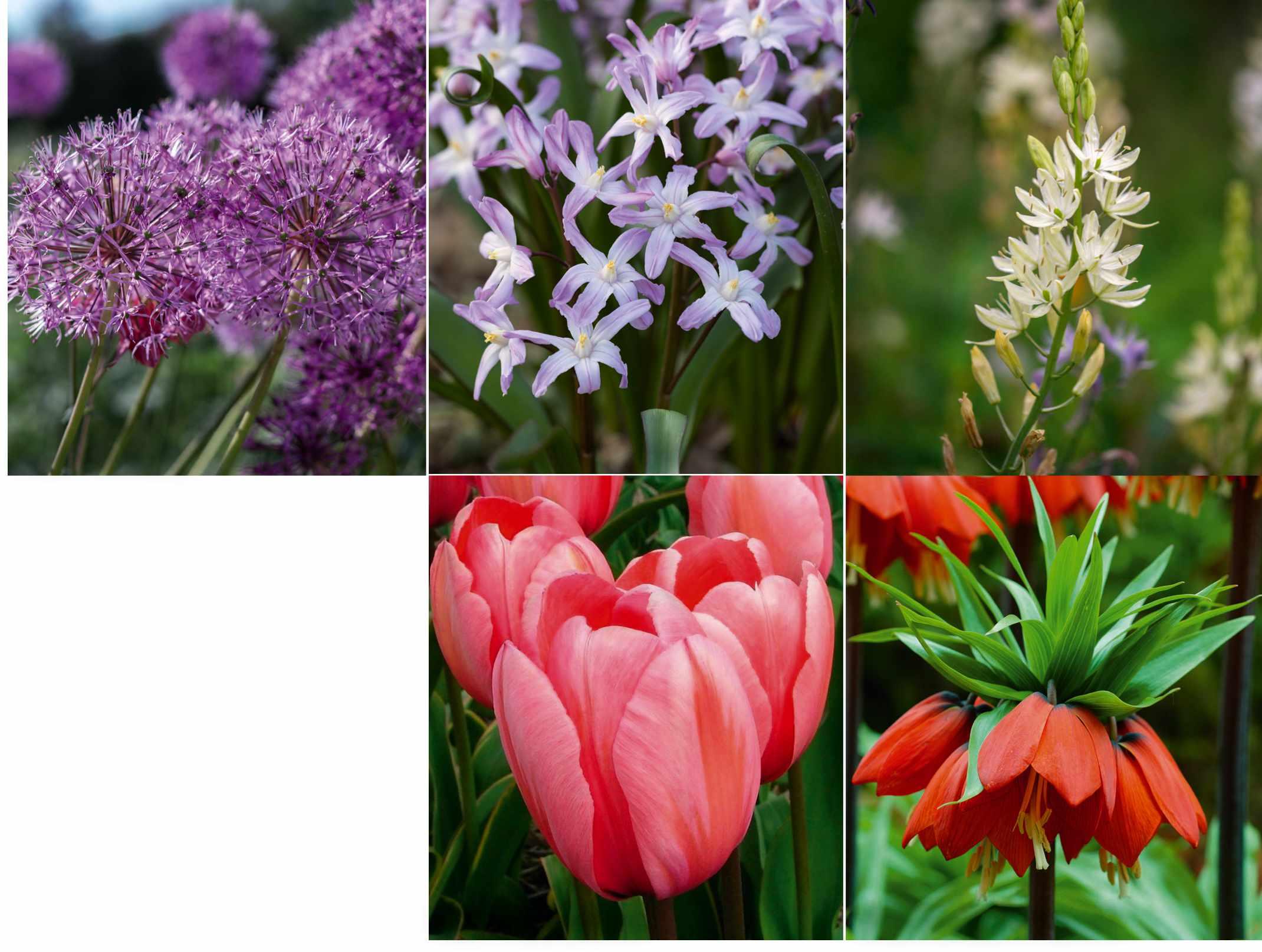
Organically grown bulbs offer an ecological step in the right direction for gardeners. These spring-flowering perennial bulbs are nurtured to the highest Soil Association-certified organic standards. The selection is curated by award-winning designers Lulu Urquhart and Adam Hunt, Best Show Garden winners at the 2022 Chelsea Flower Show. The bulbs will come back every year, bringing colour and interest to the garden from early to late spring. You can order the individual cultivars shown here or buy the whole selection together as the Habitat Enhancing Collection for £46.75 (RRP £55).

Scan the QR code or go online to organicbulbs.com/ gardensillustrated
Make your selection and apply code GIOB23 at the checkout to claim your 15% discount.
Offer closes 10 November 2023.
Allium ‘Violet Beauty’ x 7
This lovely allium will provide a sanctuary for bees. Sweetly scented, it makes an ideal choice for the cutting garden, and is also excellent at attracting pollinators. Flowers June.
RRP: £7.95. Offer price: £6.75 plus p&p†
Chionodoxa forbesii ‘Pink Giant’ x 10
Also known as Scilla ‘Pink Giant’, this delicate bulb has charming bronze stems with buds that reveal a cluster of pale-pink stars. Stunning when naturalised in large groups. Flowers March – April.
RRP: £8.95. Offer price: £7.60 plus p&p†
Camassia leichtlinii ‘Sacajawea’ x 3
A camassia that naturalises well through wetland meadow schemes and makes a wonderful border addition. Flowers May – June.
RRP: £9.95. Offer price: £8.45 plus p&p†
Tulipa ‘Design Impression’ x 14
This strong and sturdy Darwin hybrid tulip with soft coral-pink petals, and large, long-lasting blooms with a salmon-flushed centre, as well as unique, variegated foliage. It is not unusual to see them producing smaller flowering offsets from the mother plant. Flowers April – May.
RRP: £16.50. Offer price: £14 plus p&p†
Fritillaria imperialis ‘William Rex’ x 1
A tall, eye-catching show-stopper, producing a ring of terracotta-red, bell-like flowers. Great for bringing height to a spring border. Flowers April – May.
RRP: £9.95. Offer price: £8.45 plus p&p†
*Offer available to UK readers only, excluding Northern Ireland.
†P&P will be calculated by weight with a standard starting cost of £6.95.
Name Elemental House.
What A robust, wind-tolerant landscape.
Where Victoria, Australia.
Size One acre of landscaping on a 101-acre property.
Soil Heavy clay with little topsoil. Climate Hot, dry summers reaching 40°C; experiences heavy frost and snow, and annual rainfall of 480mm per year. Hardiness zone USDA 9.
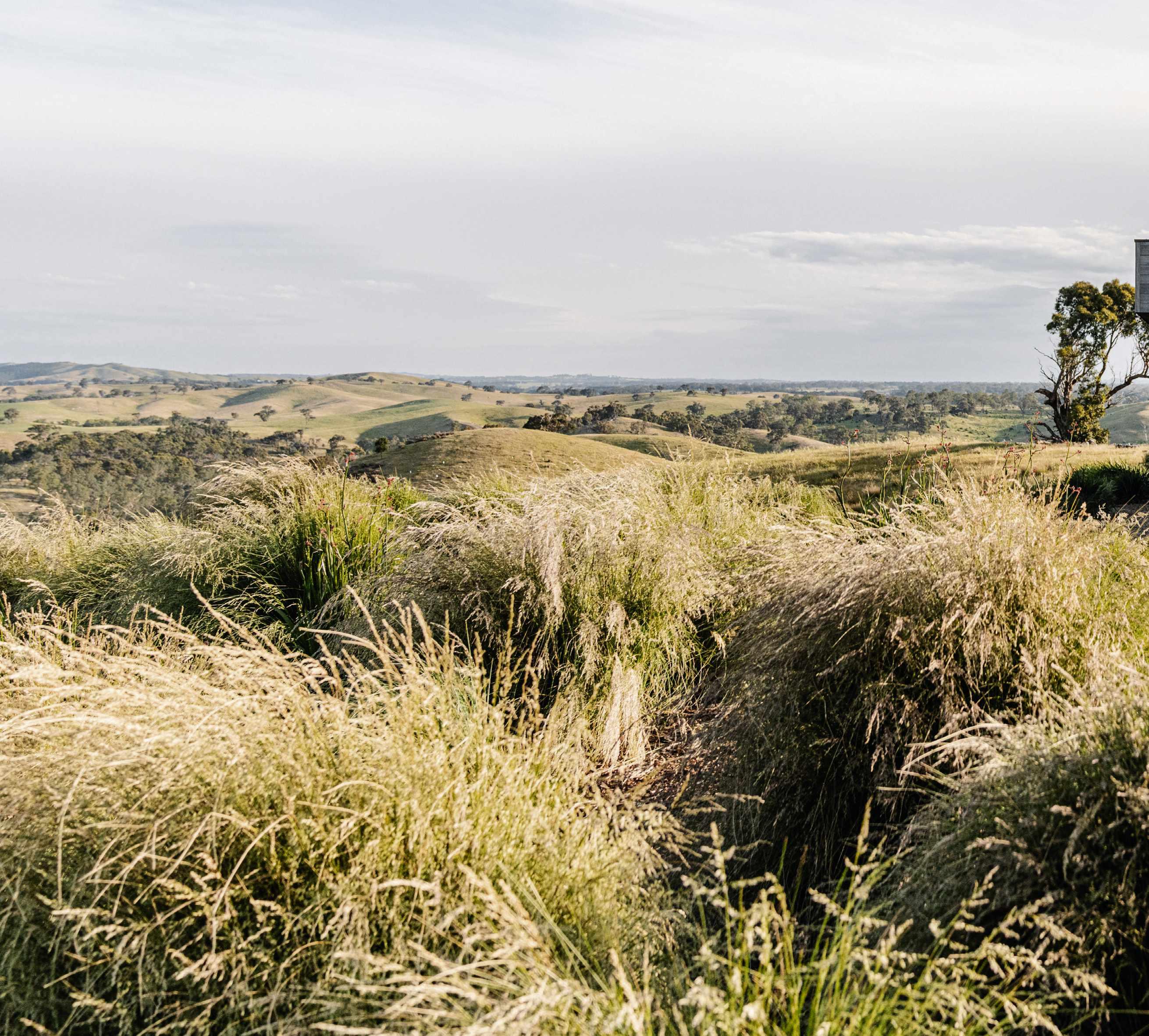
High on an exposed ridge in rural Australia, designer Kathleen Murphy has used a tonal palette of hardy natives to connect an off-grid retreat with the wider landscape
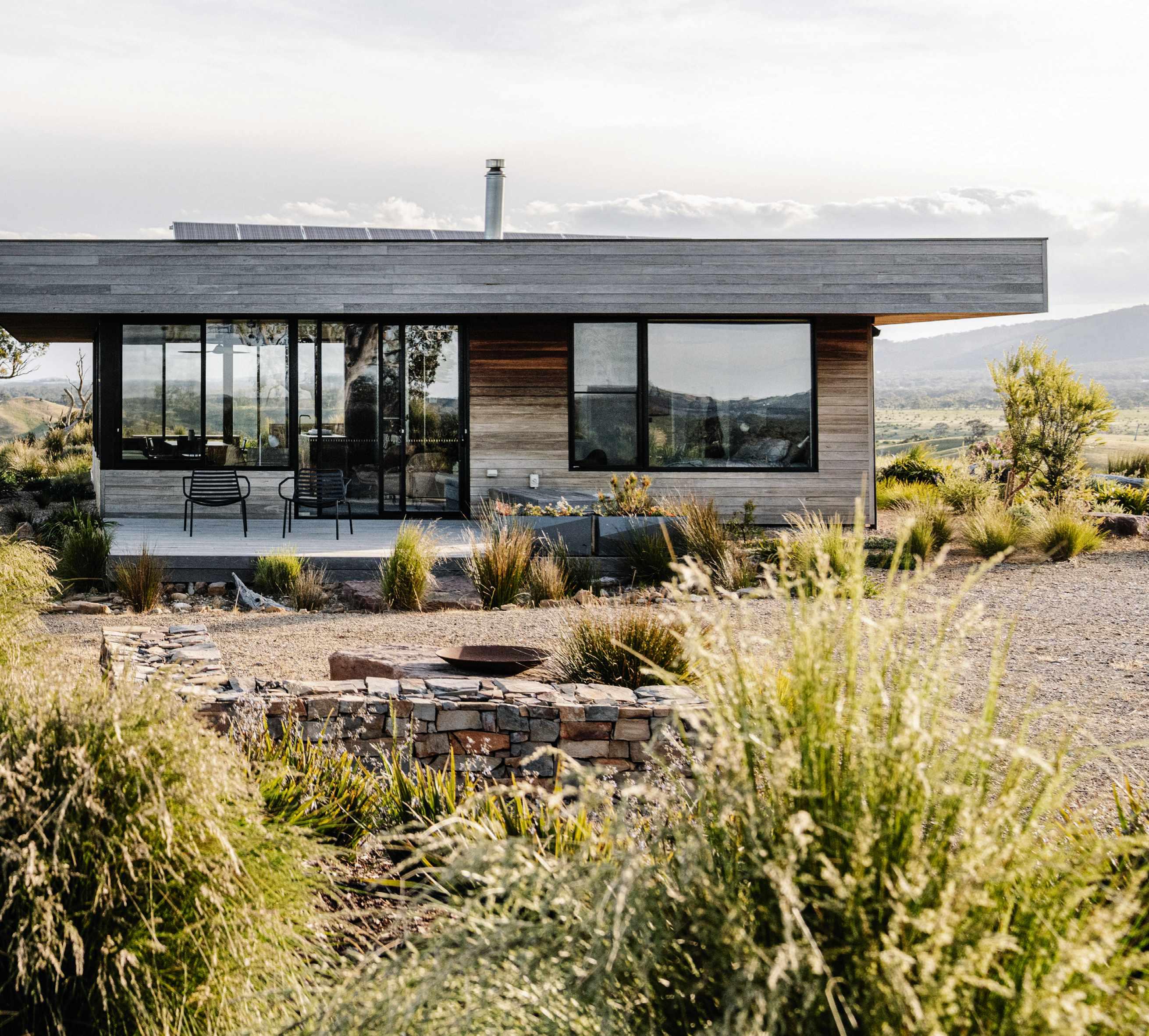
From its elevated position overlooking the rolling, sun-scorched hills and sweeping grasslands surrounding High Camp, Victoria, a minimalist dwelling and an equally restrained garden blur the boundaries between interior and exterior. This borderless interplay was the intention of landscape designer Kathleen Murphy, whose brief wasn’t for a garden, as such, but rather a landscape treatment that would provide a sense of cohesion by connecting the home with the greater surroundings.
“The owners already had a city garden, and didn’t just want a house plonked on to a site that didn’t have any softening around it,” says Kathleen. Situated on a 101-acre former sheep property, on the traditional lands of the Taungurung people, Elemental House takes its name from the site’s exposure to harsh sun, low-level cyclonic winds and the
Above Given the exposed setting, the treatment of the site called for a robust yet considered approach, much like the construction of the house itself. “The key challenges when revegetating a site like this are managing the wind and selecting the right plants to handle extreme conditions without any irrigation,” says designer Kathleen Murphy.
Risk of bushfire meant that no trees were allowed near the house. The plant selection had to be robust and sustainable
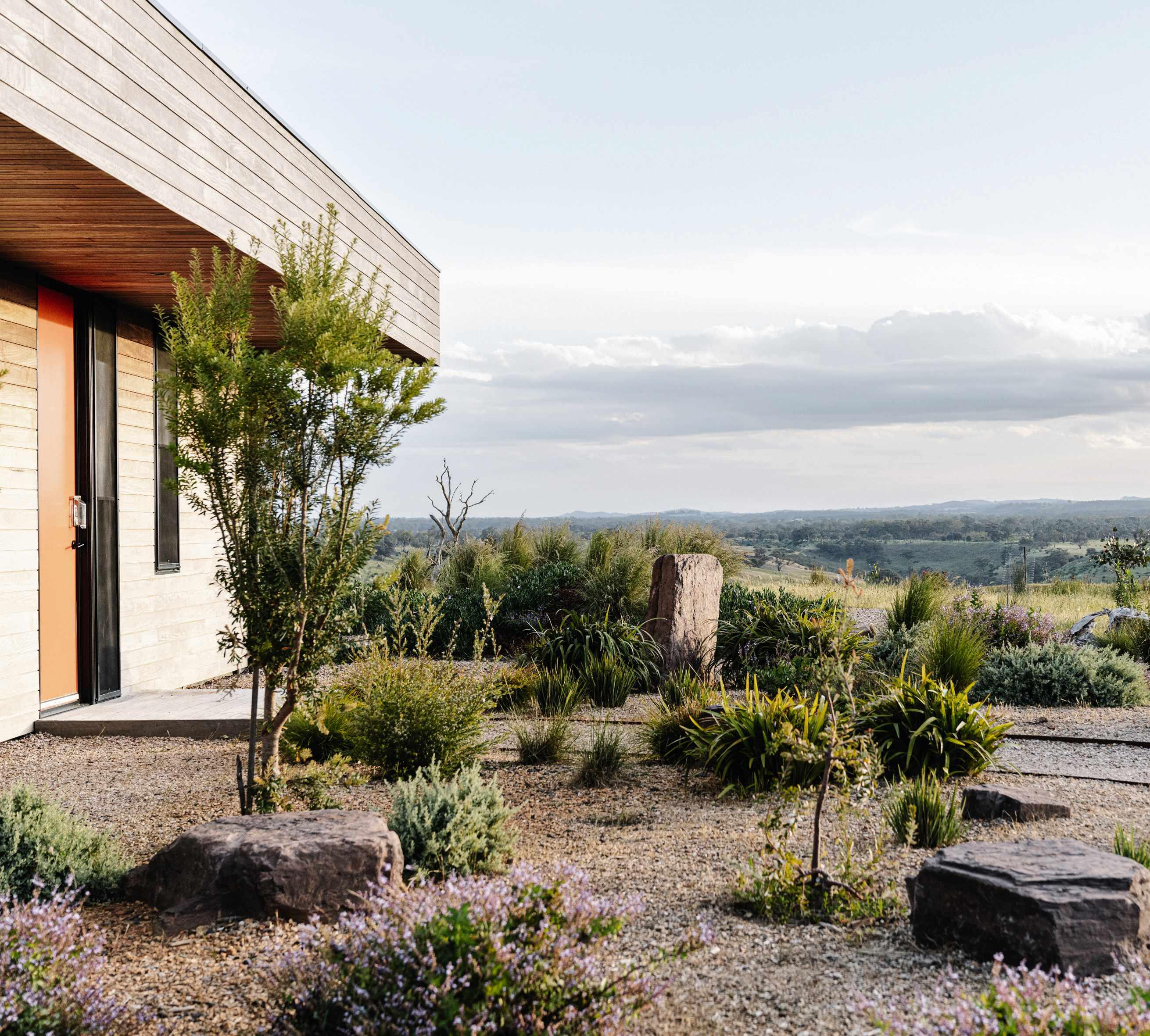
Above Being more of a landscape than a traditional garden, the plant selection surrounding the house is very simple and relies on rainfall alone as irrigation. “Everything can handle being eaten by kangaroos and other wildlife,” says Kathleen.
high threat of bushfire. While it was a decidedly challenging setting, the owners, a semi-retired couple who live an hour’s drive away in Melbourne, saw in it the potential for a weekend retreat after being drawn to the breathtaking views, resplendent light and open space.
“The clients came to me when the house was still being constructed, which was great, as I was able to work closely with the architect from the very beginning,” says Kathleen. The compact home, designed by Ben Callery Architects, was to be entirely off-grid and applying passive solar design, including deep eaves to offer shade, a burnished concrete floor to provide thermal mass and using native fire-resistant spotted gum tree timber. “When you know which materials are being used and what is trying to be achieved, you can then tie that in with the landscaping,” says Kathleen.

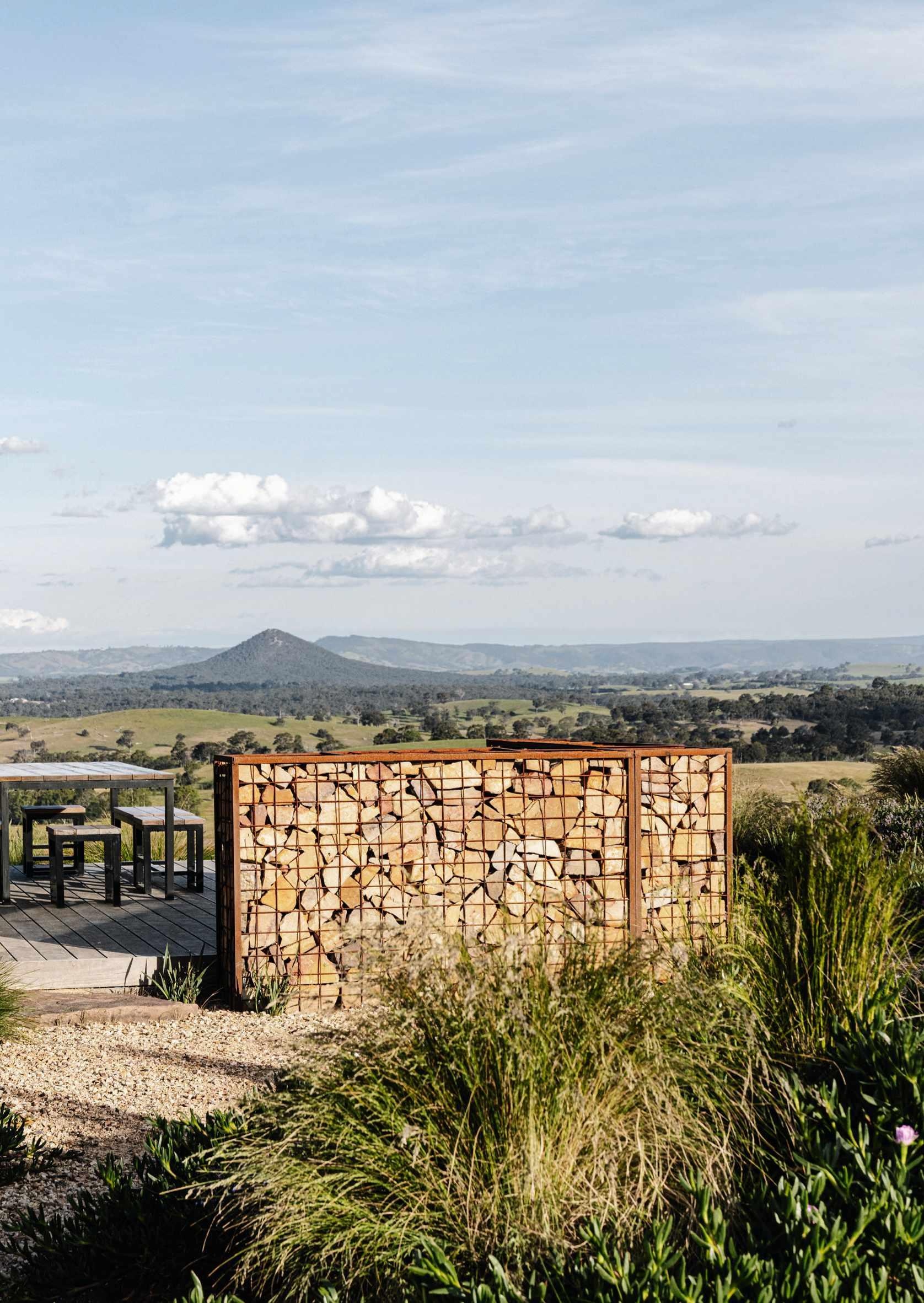
Since the region’s devastating Black Saturday bushfires in 2009, new builds in the Australian state of Victoria require a bushfire attack level (BAL) rating, which informs the design of both the home and garden. In this instance, a BAL rating of 29 – considered to be at the high end – meant no trees were allowed near the house, while the plant selection had to be as robust and sustainable as the building itself. This, coupled with the windy location and searing, dry summers, led Kathleen to choose low-lying plants that could endure the elements and survive on rainfall alone, while gravel from a local quarry was used to minimise erosion.
After the initial site cut removed the small amount of topsoil present and left what Kathleen describes as a “barren moonscape”, the aim was to revegetate some of what was lost, as well as amplify that with a few extra species. Planting includes colourful kangaroo paw, Anigozanthos flavidus ‘Yellow Gem’, amid the muted greens and greys. “While not necessarily indigenous to
Above A gabion wall, designed by Kathleen and offering protection to the barbecue area, was filled with rocks collected on site by the clients. “I think it’s really important for the owners to be involved and feel that sense of connection to the design,” she says.
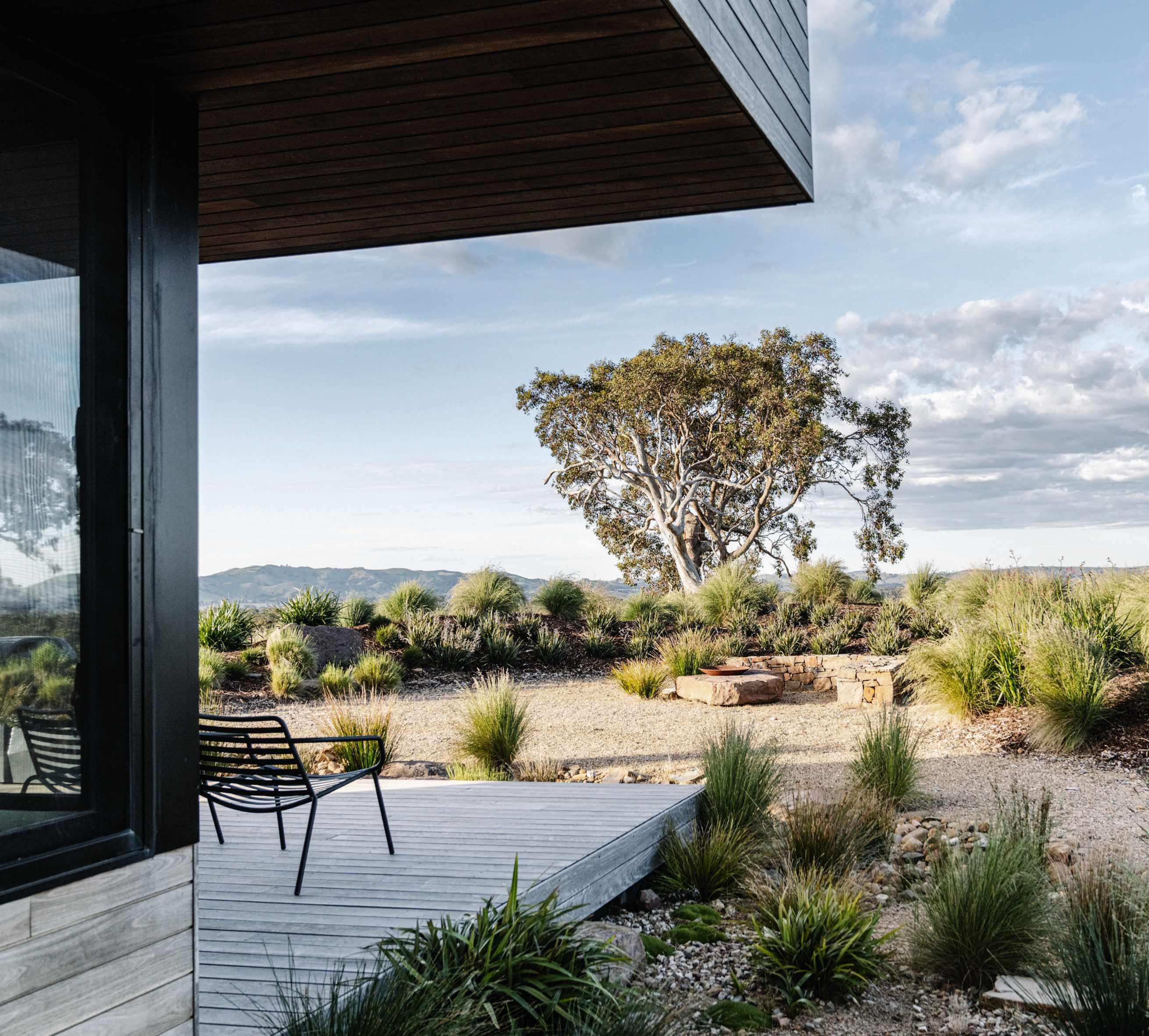
the top of that hill, it is a worthwhile plant that has some seasonal interest,” says Kathleen. “All of the plants chosen would do well just about anywhere in Australia.” A mass of native grasses and grass-like plants, including Dianella caerulea Cassa Blue (= ‘Dbb03’), Lomandra confertifolia ‘Crackerjack’ and Poa labillardierei, were planted in autumn and winter in order to get established before the summer heat. “There were few specimens used as only so many would look natural and be hardy enough to survive without irrigation,” says Kathleen. Consideration of colour was essential, with minimal rainfall resulting in a distinctly brown palette that blankets the backdrop at certain times of the year. “A lush garden at the top would look disjointed,” she says. “The muted tones were used to keep a connection to the surrounding landscape, regardless of the seasons.”
Taking cues from the encompassing mountain ranges and granite boulders, mounds were built with excavated subsoil to create a link to the undulating landscape beyond,
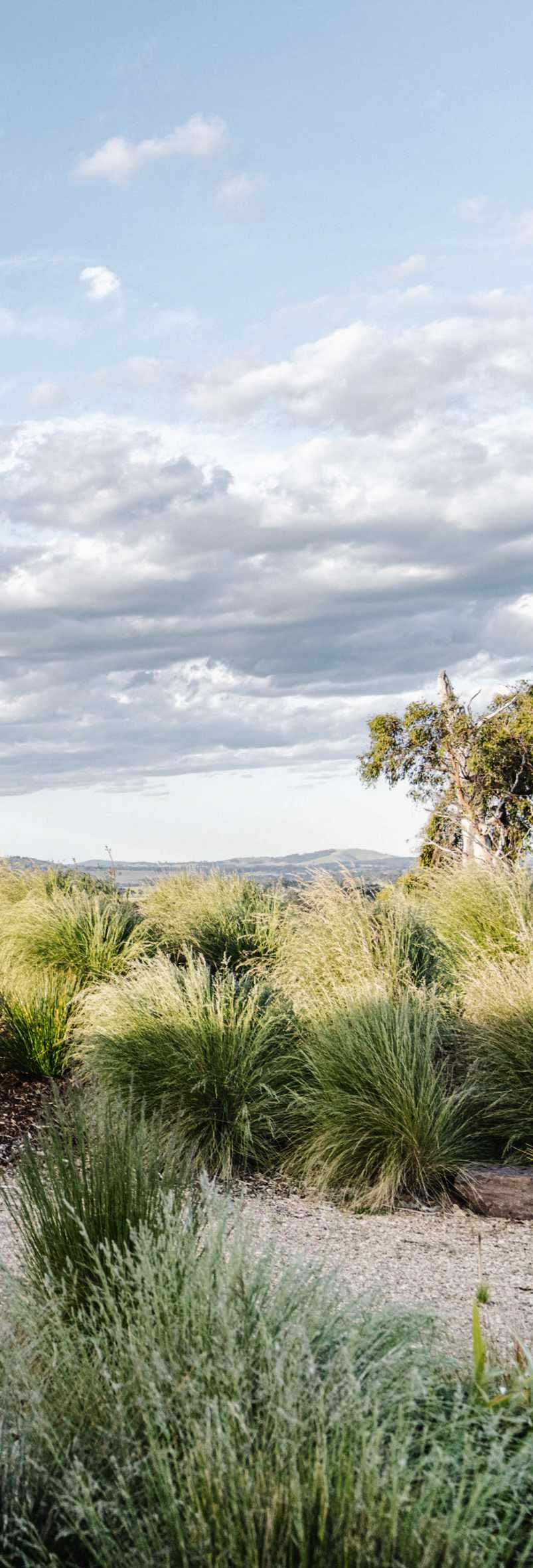
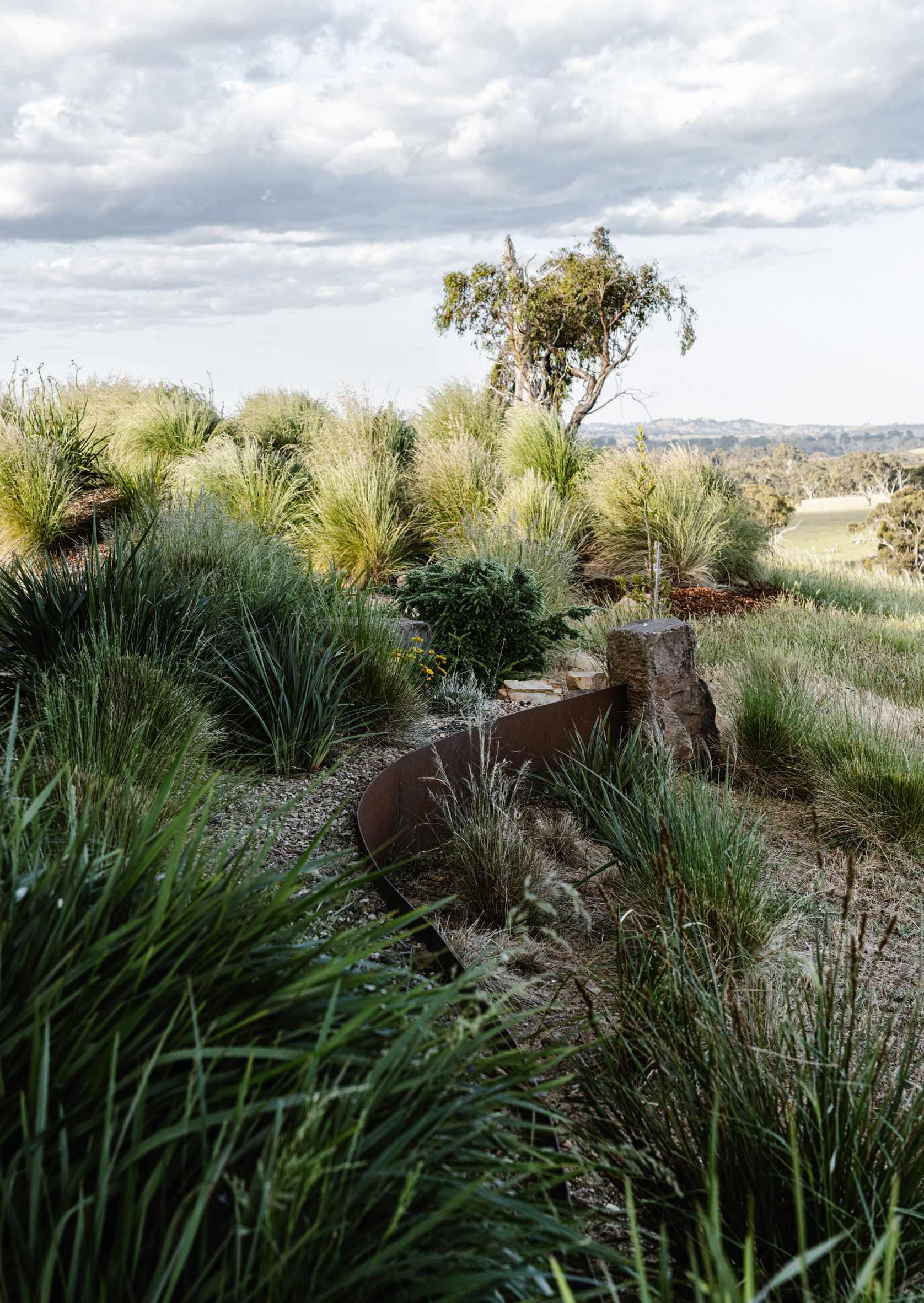
Landscape designer Kathleen Murphy shares her tips on creating a garden that can withstand the elements.
1 Use gravel to minimise erosion (or any kind of stone aggregate that is suitable) near buildings in bushfire-prone areas, because of its fire-resistant quality. “Bark mulch gets picked up by birds and flicked on to paths, so using stone as mulch saves a lot of maintenance as well,” says Kathleen.
2 Overplant on a windy site to allow plants to protect one another.
3 Select low-lying specimens that don’t get too leggy and won’t topple over in the wind. “We included plenty of groundcovers and grasses, and apart from the kangaroo paw, nothing is very tall,” says Kathleen.
4 Build mounds to help buffer strong winds. “Here they create a sense of
protection from the exposed site,” says Kathleen, who used excavated subsoil for the foundations as well as 250mm of imported soil and 75mm of ‘bush mulch’ sourced from a local green-waste facility.
5 Use tree guards to protect young plants from wildlife. Here, the guards were made from chicken wire, allowing the wind to pass through without them becoming dislodged and littering the countryside.
Key to designing the outdoor spaces was ensuring there would always be a sheltered spot to sit and enjoy the panoramic views
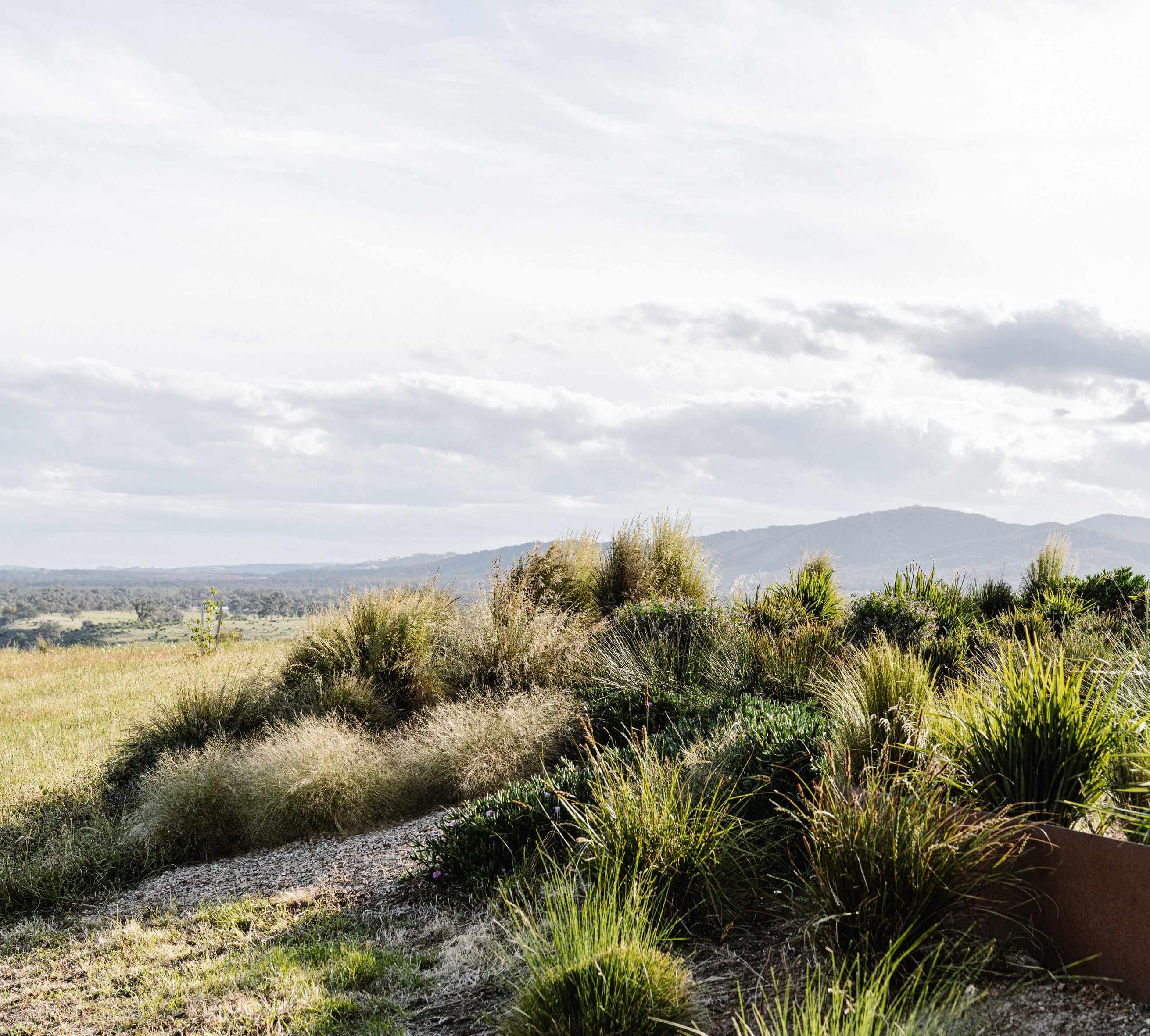
bringing a sense of movement closer to the house. “They mimic the far-off hills and soften the profile of the home, helping to anchor the building to the site,” says Kathleen. The mounds also serve a practical purpose, helping to buffer the winds and hold water, while enabling more topsoil to be added for nutrition.
Key to designing the outdoor spaces was ensuring there would always be a sheltered spot to sit and enjoy the panoramic views, no matter the weather. “As the winds are so frequent, different parts of the site get hammered at different times,” says Kathleen. The owners can take their pick of a deck on either side of the house, while a gabion wall filled with rock found on site offers protection to the barbecue area. When conditions are such that it becomes necessary to seek shelter inside, extensive glazing frames the views of the mountains, valleys and grasslands. “There’s something comforting about being

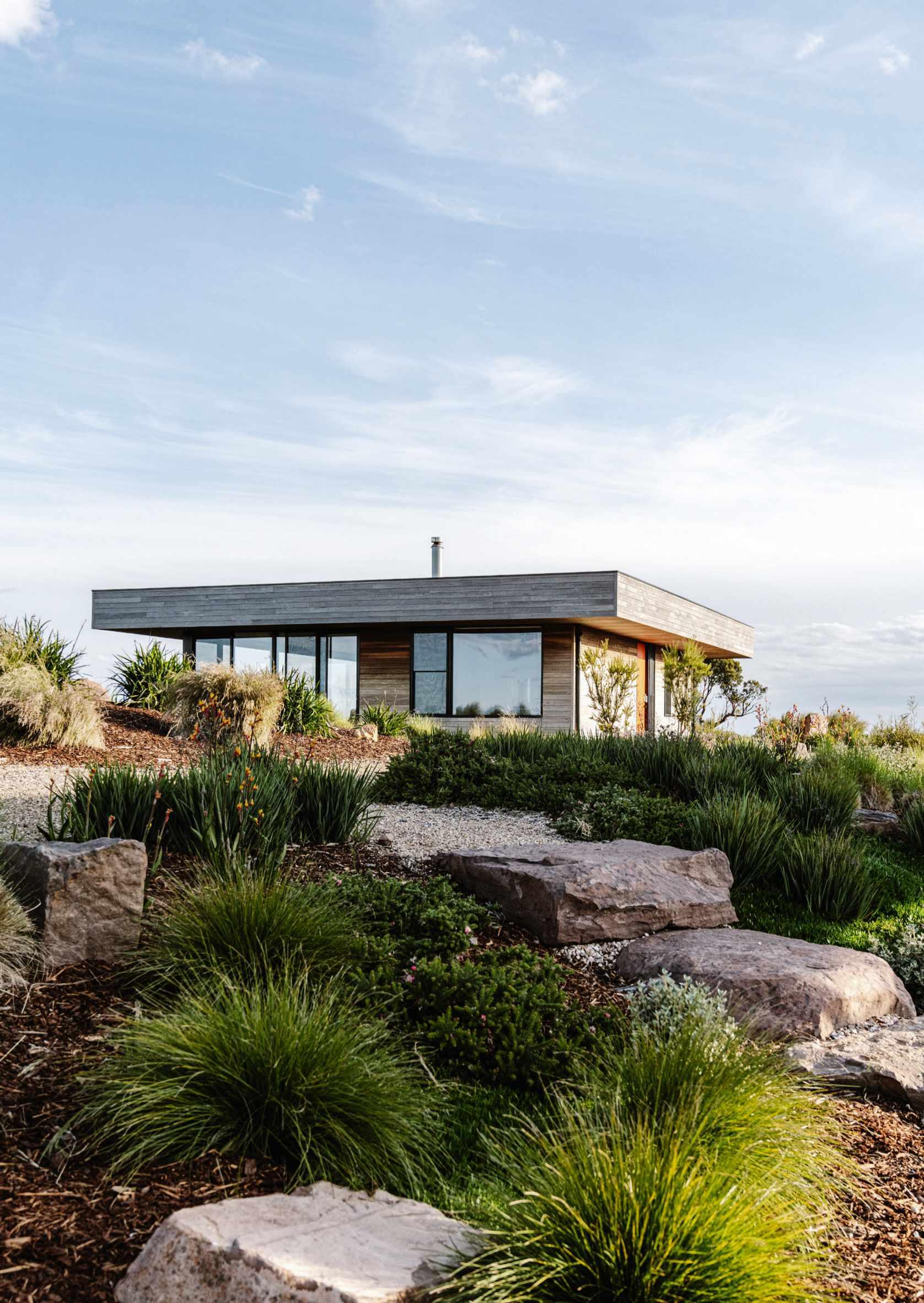
inside when it’s blowing a gale, because it feels really anchored down and protected,” says Kathleen. Further outdoor seating is provided by flat areas that are bordered by gently wending Corten-steel retaining walls. The burnt-orange patina of the weathered steel connects with the earthy colour tones beyond, while the organic curves lend subtle structure to the soft, fluffy grasses. “We were mindful to avoid using any treatments that felt suburban; for example, a concrete sleeper retaining wall,” says Kathleen. “It was important that every material we chose felt rural and natural.” The result is a space that doesn’t just endure the elements and its special site, but embraces them. ■
USEFUL INFORMATION
Find out more about Kathleen’s work at kmldesign.com.au
Above The materials used for hard landscaping, such as the stone pathways, were chosen to reflect tones and textures similar to those found in the wider landscape, whose features include a smattering of granite boulders and surface rock in the hills.

News, garden design insight and sourcebook
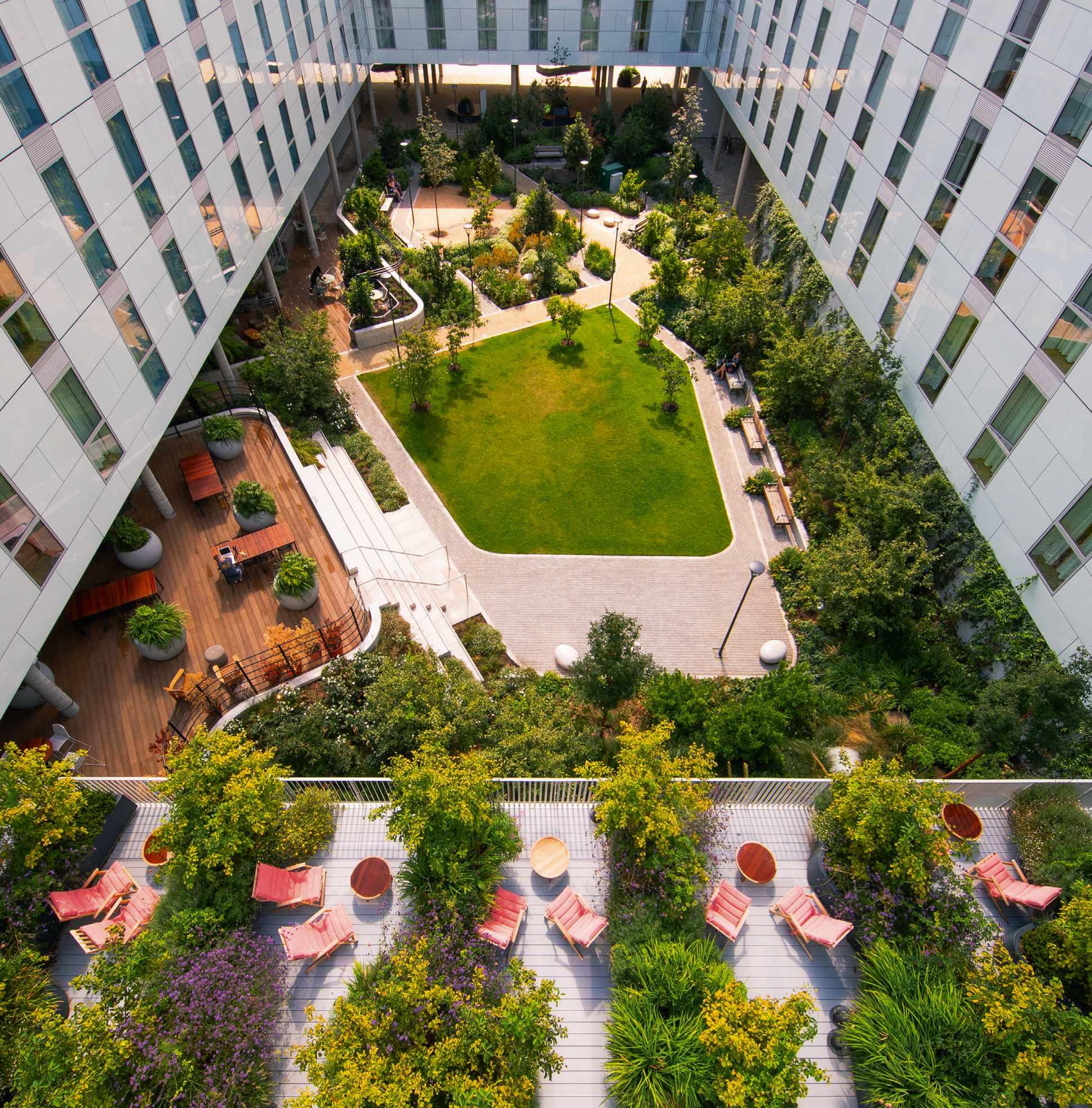
A new courtyard garden has been created by Robert Myers Associates, working with architects dRMM, for a Turing Locke and Hyatt Centric hotel complex in Cambridge. Lush woodland planting and open lawns, along with dining terraces and entertainment spaces, make up the central courtyard. A series of seasonal rooftop terraces and green
roofs have also been incorporated into the design. Raised planters containing a mix of colourful, aromatic flowering shrubs and herbs will enhance the site’s biodiversity and provide habitat and a food source for wildlife. The project forms part of the University of Cambridge’s Eddington Development. robertmyers-associates.co.uk
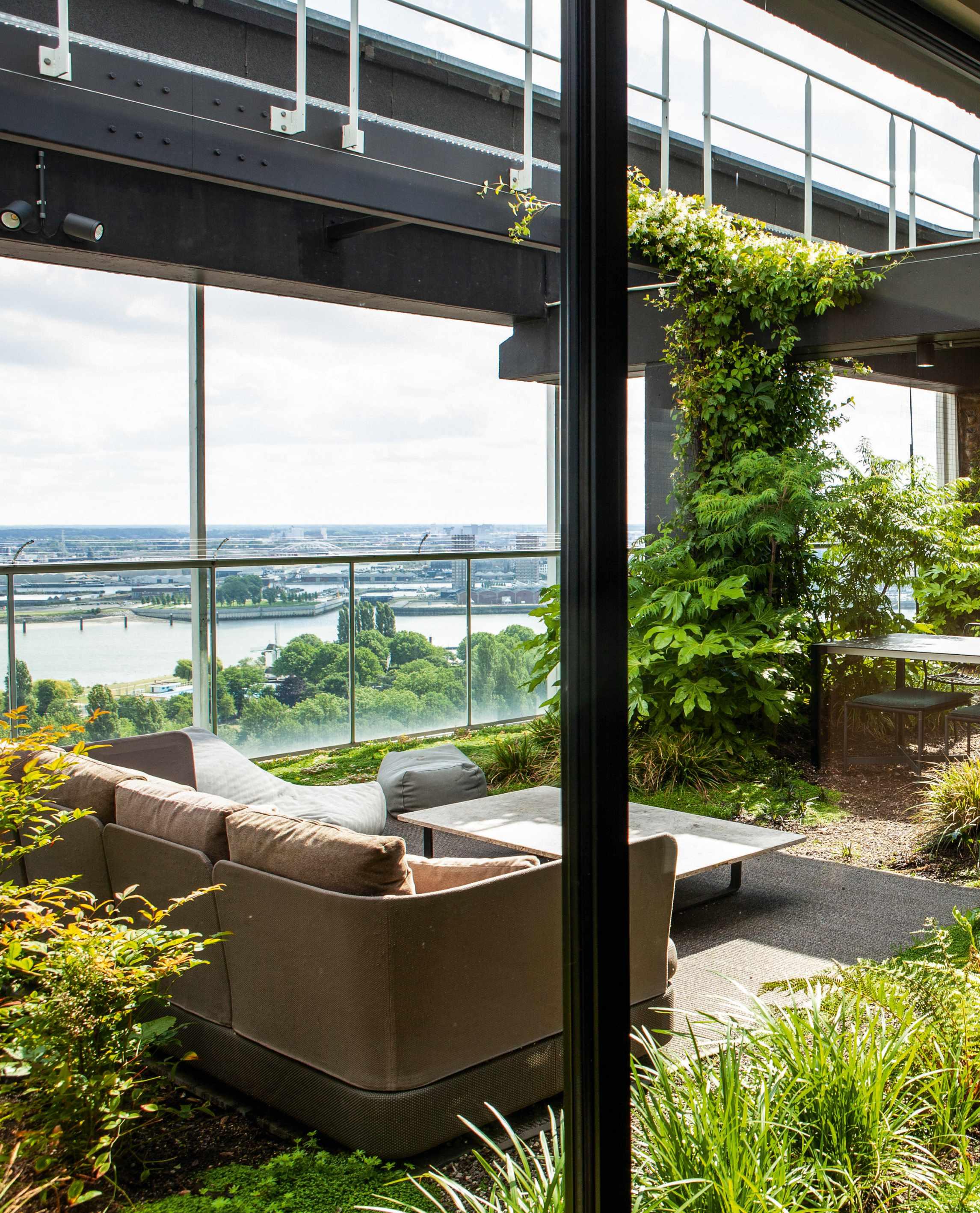
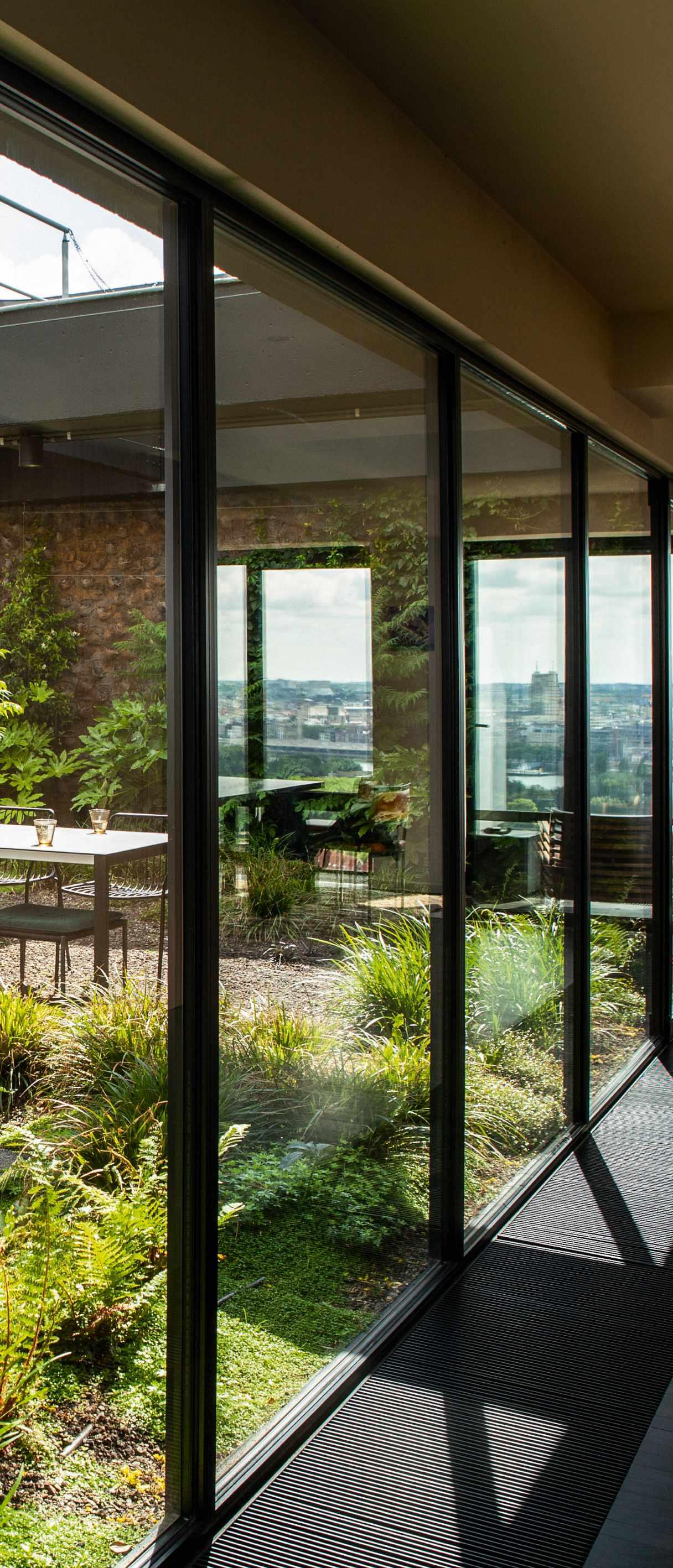
Belgian garden architects Bart & Pieter have created a cosy green terrace on the 20th floor of an apartment building in Antwerp to take advantage of the views
WORDS VERONICA PEERLESS PHOTOGRAPHS ANOEK LUYTEN
Bart Haverkamp and Pieter Croes specialise in roof gardens, so they were the obvious designers to approach about greening this terrace on the 20th floor of one of the tallest buildings in Antwerp. The space already had a concrete tiled floor, outdoor sofa and rug, but it was stark and uninviting and devoid of any greenery, apart from a green wall that was in poor condition. Many of the living spaces in the apartment look directly out on to the terrace, so the clients wanted something that was permanently green to enjoy. However, they didn’t want to lose the spectacular view over Antwerp harbour, so requested low-level planting and, unusually, they did not want any flowers. As this is a concrete 1960s building, with no original plans still available, to engage a structural engineer would have been expensive and potentially inconclusive. So the pair would need to be careful not to add any extra weight. Another consideration was access – everything had to be brought up to the terrace via an exterior lift.
Bart and Pieter work in quite an unusual way: they create lists of plants and materials, and a rough hand-drawn plan, but they lay out the garden on site, in conjunction with the client. The resulting garden has paths that meander organically around the space from the kitchen. The concrete tiles were removed from everywhere except the seating area, and the mostly evergreen plants were planted directly into lightweight soil. “Every structure that you put in, such as a container, makes a space look less like a garden,” explains Pieter. The planting was kept low so as not to obscure the view as requested, but a concrete pillar was clad in plants to soften it. Bart and Pieter had asked the clients to paint the walls grey-black before they started work, to unify the interior and exterior and to show off the plants. This is a garden that is mostly viewed from the inside, through the huge floor-to-ceiling windows. “There is no real division between the inside and the outside. The plants frame the view.”
Turn the page for more roof garden solutions
Left The roof terrace is on the 20th floor, with stunning panoramic views over Antwerp harbour. In order not to lose the view, the planting was kept low, and all of the plants used are evergreen, for year-round interest, and chosen for foliage rather than flowers.


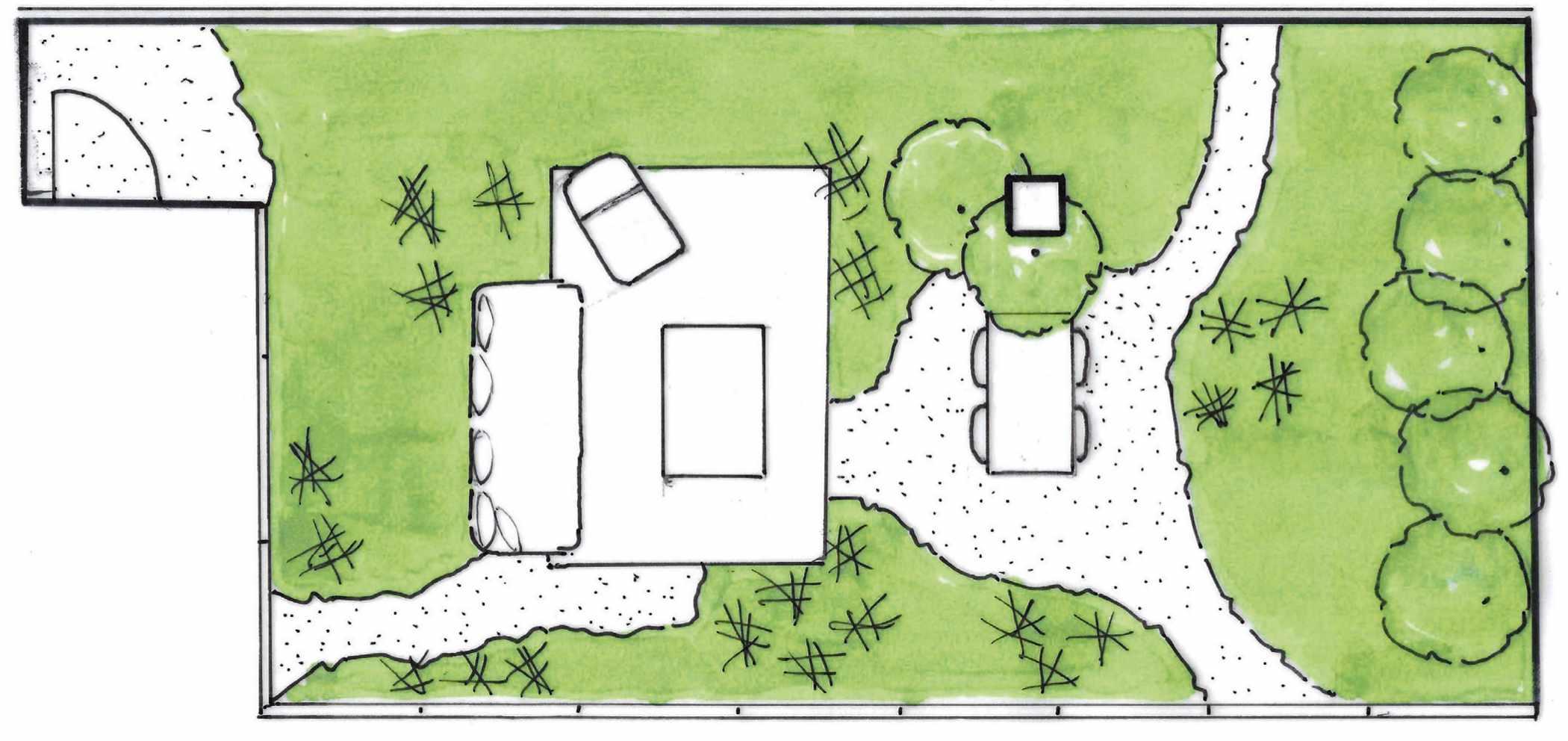
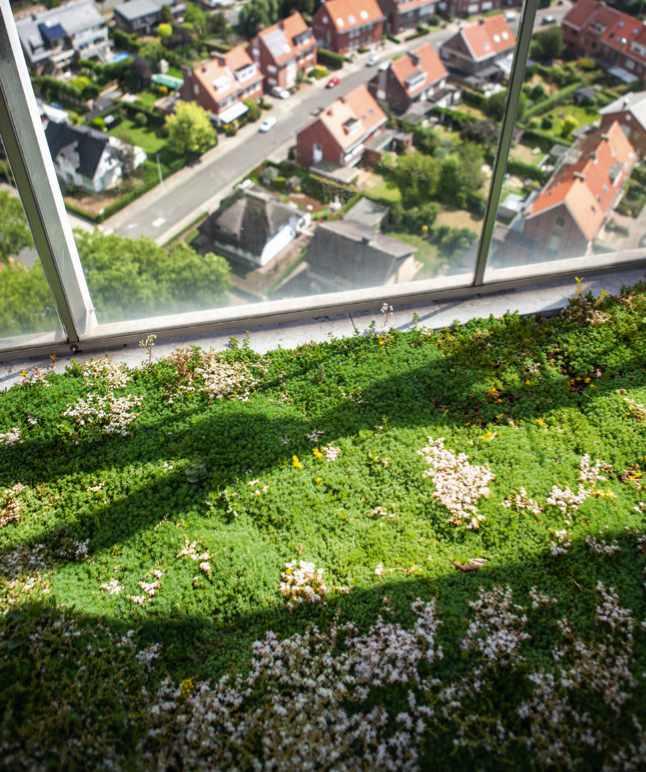
The clients requested that the planting be kept low so as not to obscure the panoramic views. Near the balustrades, the weight restriction was very strict, hence the use of a variety of low-growing sedums, commonly used in mats for green roofs, growing in a thin layer of soil. A similar technique was used near the windows, as the base of the floor-to-ceiling windows is 6cm deep. As there is no path edging, the sedums spread into the space, giving an organic feel.

The client wanted to keep the seating area exactly where it was already positioned – the terrace doesn’t get a huge amount of sunshine, and this is the sunniest spot to sit in. The tiles beneath it and the outdoor rug were retained. The seating area is now anchored by the low-growing sedums around it. The sofa is backed by three Mahonia eurybracteata subsp. ganpinensis ‘Soft Caress’ to give a feeling of enclosure.

The paths and area around the dining table are made with lightweight soil commonly used on roof terraces, on top of a black stabilisation grid. The look was inspired by a visit to Tenerife’s Botanical Gardens, where the pair noticed that the dark, volcanic soil showed off the plants to great effect.“The soil is an interesting colour – it’s warmer than dark brown, with a touch of aubergine.” It’s also cost effective, and is the quickest way to create a usable outdoor surface.

Bart and Pieter used a palette of tried-and-tested evergreen plants, able to cope not only with the salty winds that come off the sea here but also the lightweight but fertile soil used, at a depth of only 6cm in places. The roof-garden plants Bart and Pieter usually turn to have to cope with strong sun, but here the plants were chosen for shade or semi-shade. As for the request for no flowers, Pieter points out: “Flowers cannot be totally avoided. Trachelospermum jasminoides, for example, does flower – it’s inevitable. But many of the plants, such as the ferns, do not.”An irrigation system was put in place, which the designers consider essential on any roof terrace.
They decided to keep the existing, somewhat unsuccessful, vertical garden, but gave it a fuller look by planting up and in front of it. Parthenocissus quinquefolia and Trachelospermum jasminoides climb up it, with Fatsia japonica and Rhus typhina – a tree that Bart and Pieter often use on roof terraces, as it can cope with windy conditions – at the base. Similar plants also disguise the pillar in the middle of the terrace. Lower plantings of Carex morrowii ‘Mosten’, along with Liriope muscari, ferns and sedums, have been planted close to the interior: “We always plant greenery next to the window,” says Bart.
“There’s a lot of building work going on in Belgium at the moment and the buildings are getting higher,” says Pieter. “The terraces have good views, but they can be windy, and people want that nice, cosy space. Here, if you’re inside, it’s like you’re sitting outside, and vice versa”. ■
USEFUL INFORMATION
See more of Bart and Pieter’s work on Instagram @bartandpieter
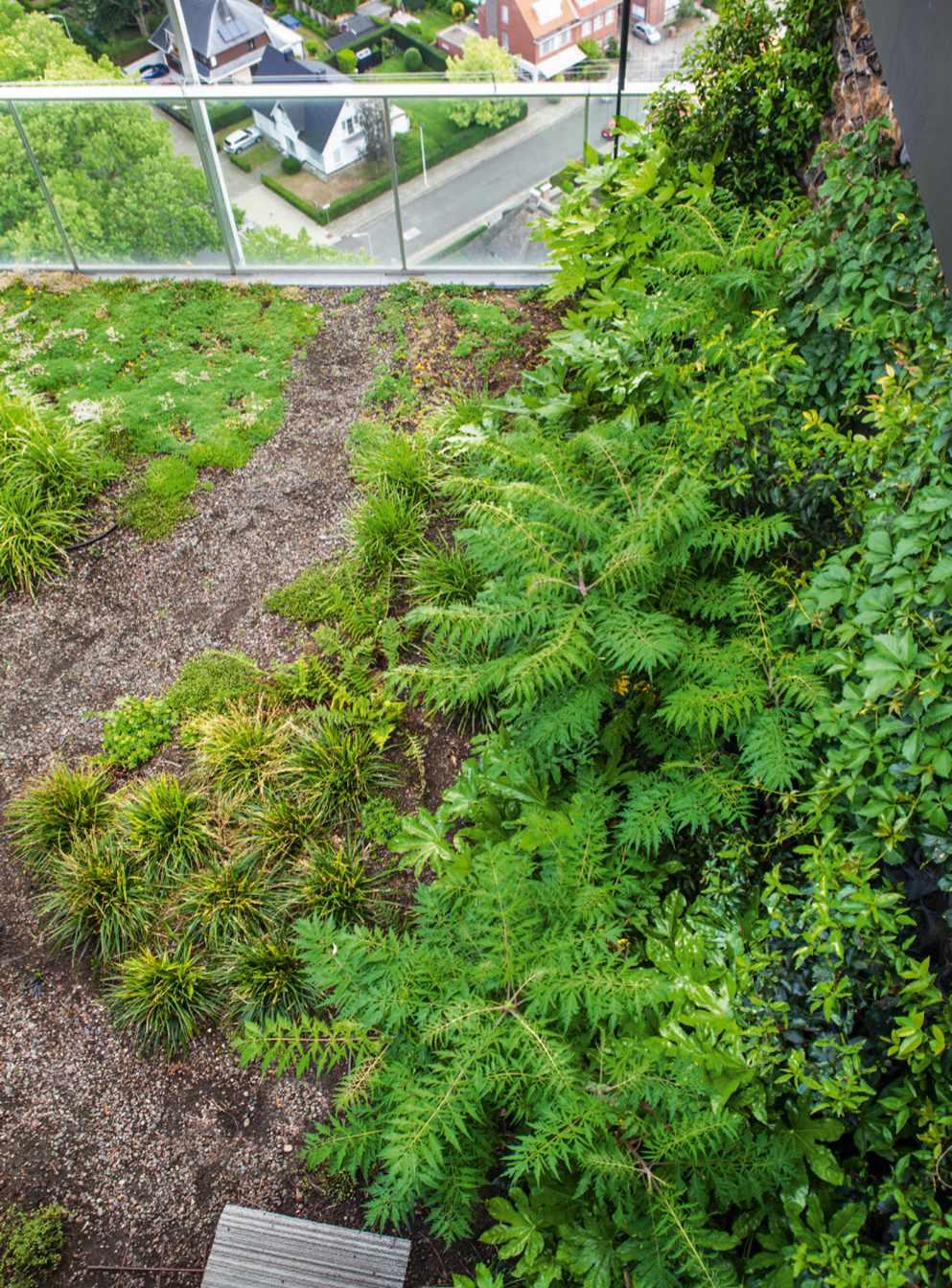


Relax under the canopy with one of these wrap-around seats
COMPILED BY MOLLY BLAIR

TAKE A BREAK
Round Tree Bench, from £2,500, The Oak & Rope Company, 01227 469413, theoakandropecompany.co.uk
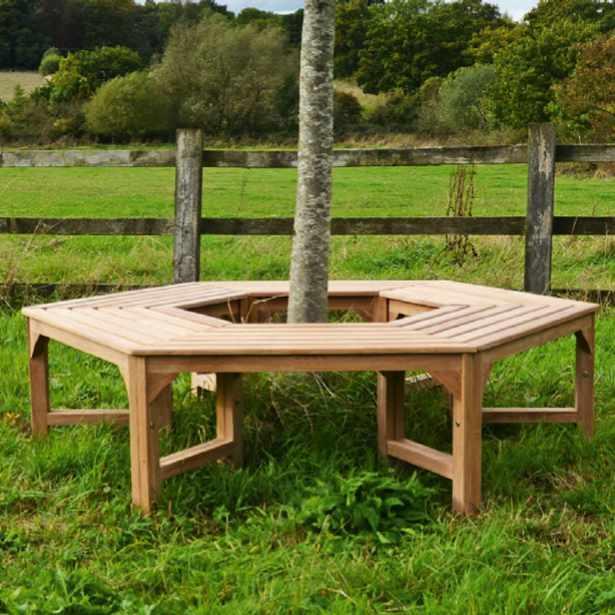
DURABLE
Hexagonal Backless Teak Tree Bench, £1,149, Sloane & Sons, 01283 576812, gardenbenches.com
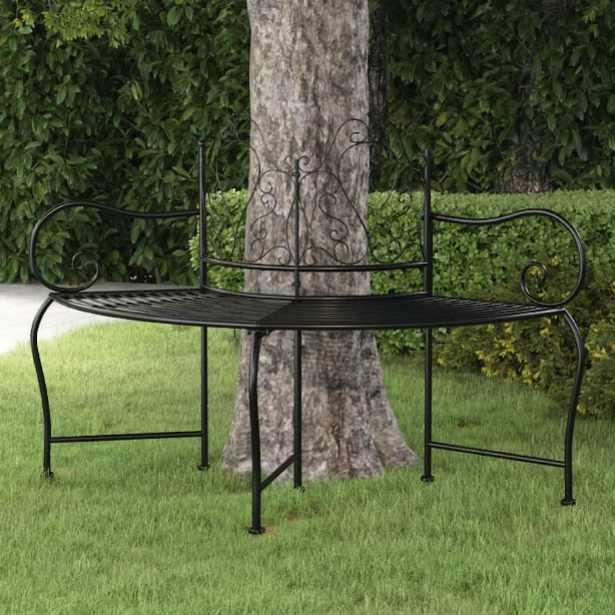
SIMPLY STYLISH
Salpeter Steel Tree Seat, £139.99, Wayfair, wayfair.co.uk

SCULPTURAL
Broadwalk Tree Spiral Bench, from £19,380, Gaze Burvill, 01420 588444, gazeburvill.com
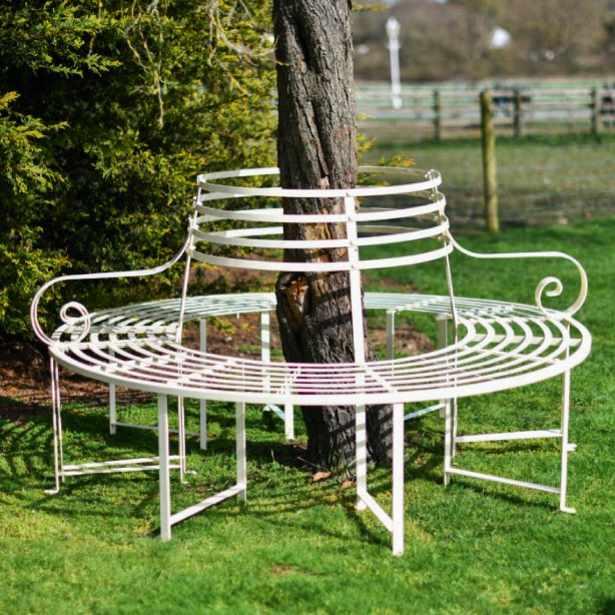
VINTAGE CHARM
Monmouthshire Wrought Iron Deluxe Tree Seat, £599, Black Country Metalworks, 01691 610952, blackcountrymetalworks.co.uk
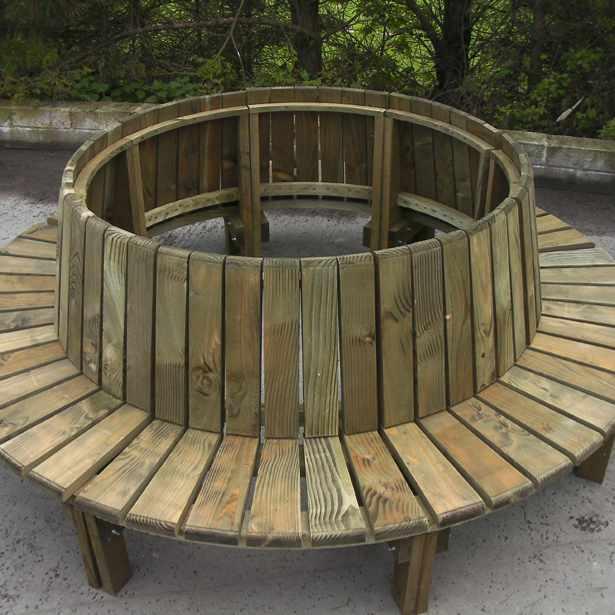
RUSTIC TIMBER
Douglas Fir Circular Tree Seat with Backrest, £2,540, Sustainable Furniture, 01726 884123, sustainable-furniture.co.uk

CONTEMPORARY
Weybridge Bench, steel and iroko wood, from £2,468 (excl. VAT), Broxap, 01782 564411, broxap.com

MADE TO MEASURE
Oak & Hazel Tree Seat, £900, Natural Fencing, 01379 588370, naturalfencing.com

MODERN METAL
Discover a wider range of benches by scanning this QR code with your phone camera, or visit gardensillustrated. com/benches
Hay Palissade Park Bench incl Middle Leg, £935 per section, Innes, 01482 649271, innes.co.uk
Check out the latest discounts available with the Gardens Illustrated Reader Rewards scheme to save on gardening, travel, food & drink and more
20%

ENJOY HOLIDAY INSURANCE WITH UP TO 20% DISCOUNT
Cover your dream holiday with the UK’s best travel insurance, as voted by the public at the British Travel Awards – six times in a row. Staysure offers you award-winning travel insurance tailored to your needs, which includes covering pre-existing medical conditions.
Visit staysure.co.uk to claim up to 20% off your travel insurance, and use code GRDL20 when you get a quote online
SAVE 15%
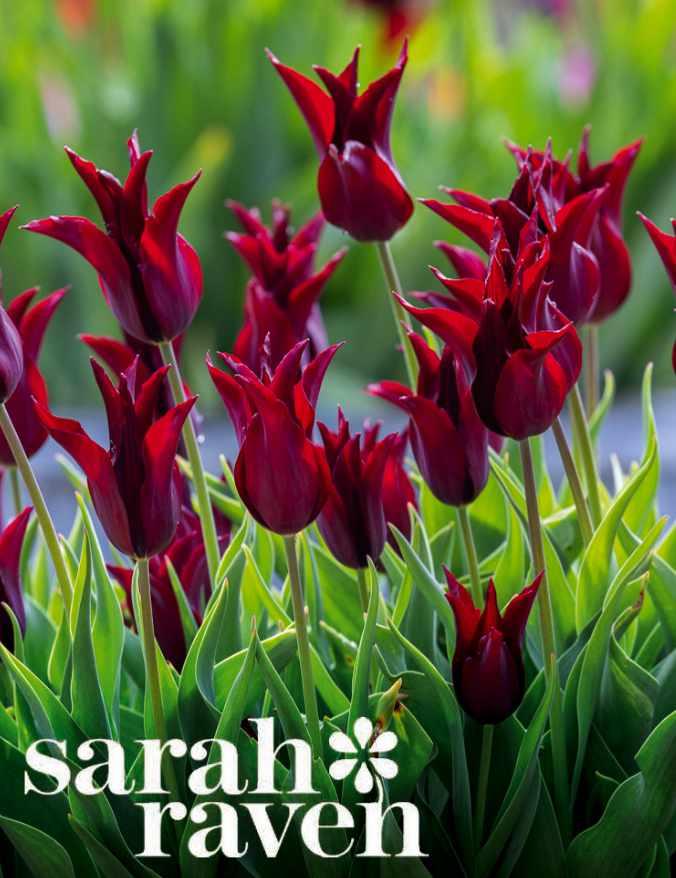
1Browse
Take a look at some of our latest fantastic offers, covering gardening, lifestyle, travel, food and drink, and more.
2 Redeem
Follow the link provided in each offer and apply the offer code when placing your order.
3 Find even more
Go to gardensillustrated.com/offers to find the full range of discounts, deals and competitions available to you.

5%
SAVE 5% WHEN YOU BOOK WITH BRITTANY FERRIES
From discovering the delights of France to exploring the wonders of northern Spain, Brittany Ferries has the perfect route to get you there.There’s a choice of daytime or overnight sailings from Portsmouth, Poole or Plymouth to Brittany or Normandy, plus the only service between the UK and Spain.
To get 5% off your next booking with Brittany Ferries, head to brittanyferries.com/gardensillustrated or call call 0330 173 2549 quoting code 621591
SAVE 15% ON AWIDE RANGE OF PRODUCTS AT SARAH RAVEN
It’s not too late to sort out your autumn bulbs, so take advantage of this great discount with Sarah Raven to ensure you enjoy beautiful spring flowers next year. You’ll also find a wonderful range of seeds and plants to browse, plus garden tools, accessories, furniture, thoughtful gifts and much more.
Use code GIL23YR at sarahraven.com to get a 15% discount until the end of 2023
A stalwart of the spring garden, the tulip was originally a wild flower in Central Asia. It was first cultivated by the Turks as early as 1000CE.Tulips were introduced into Western Europe in the late 16th century, and became especially popular in the Netherlands, leading to the tulip mania of 1634-37.Throughout the 17th and 18th centuries interest in the tulip remained, but the Dutch became the true connoisseurs and stockists. Today, there are many different tulip varieties and you can still buy some of the original‘wild’species.
To browse our full selection of offers, go to gardensillustrated.com/offers

10%

There are some journeys that have earned iconic status in the travel hall of fame, and a trip on Hurtigruten’s Norwegian Coastal Express is one of them. Dubbed ‘the world’s most beautiful voyage’, this trip takes you past hundreds of fjords and thousands of mountains, stopping at 34 ports along the way. Started in 1893 in order to transport people and goods along the north Norwegian coast, the voyage is now an intrinsic part of Norwegian culture. It still acts as a vital transport link, where locals share the ship alongside tourists looking for the Northern Lights in winter, or enjoying 24 hours of daylight in summer. There’s a wide choice of excursions, plus coastal guides who lead activities and interpret the cultural and natural treasures seen on the voyage, creating memories that you’ll treasure for the rest of your life.
To claim 10% off a trip on Hurtigruten’s Norwegian Coastal Express, head to hurtigruten.co.uk/destinations/norway and use code HRG-GIL at checkout, or call 020 3553 1644
HURTIGRUTEN’S AWARDWINNING GARDEN
Hurtigruten recently won a Silver-Gilt medal at Hampton Court Palace Garden Festival for its Scandinavian-inspired garden, created by award-winning designer Max Parker-Smith.We talk to Max to find out more.
Can you describe the concept and inspiration behind your sustainable show garden for Hurtigruten?
The idea for‘The Relation-Ship’ garden first stemmed from listening to Hurtigruten speak with such passion about the 130-year-long relationship it has with Norwegian coastal farmers.The story of the design formed while hearing how much appreciation and respect the farmers commanded from such a large company and over such a long period of time. Designing a space for such a key character felt like a natural narrative.
What were the main challenges you faced when designing and how did you overcome them?
The main challenge for the time of the year that Hampton is on is the plants. It’s bang in the middle of summer and the temperamental English weather certainly won’t guarantee that the plants you so desperately wanted for months will be in show-worthy condition for when the time comes.There were lots of frantic last minute substitutions, which created a rather different tapestry than originally anticipated, but it was great nonetheless.
GardensIllustratedMembers can read the full interview with Max by logging in at: membership.gardensillustrated.com
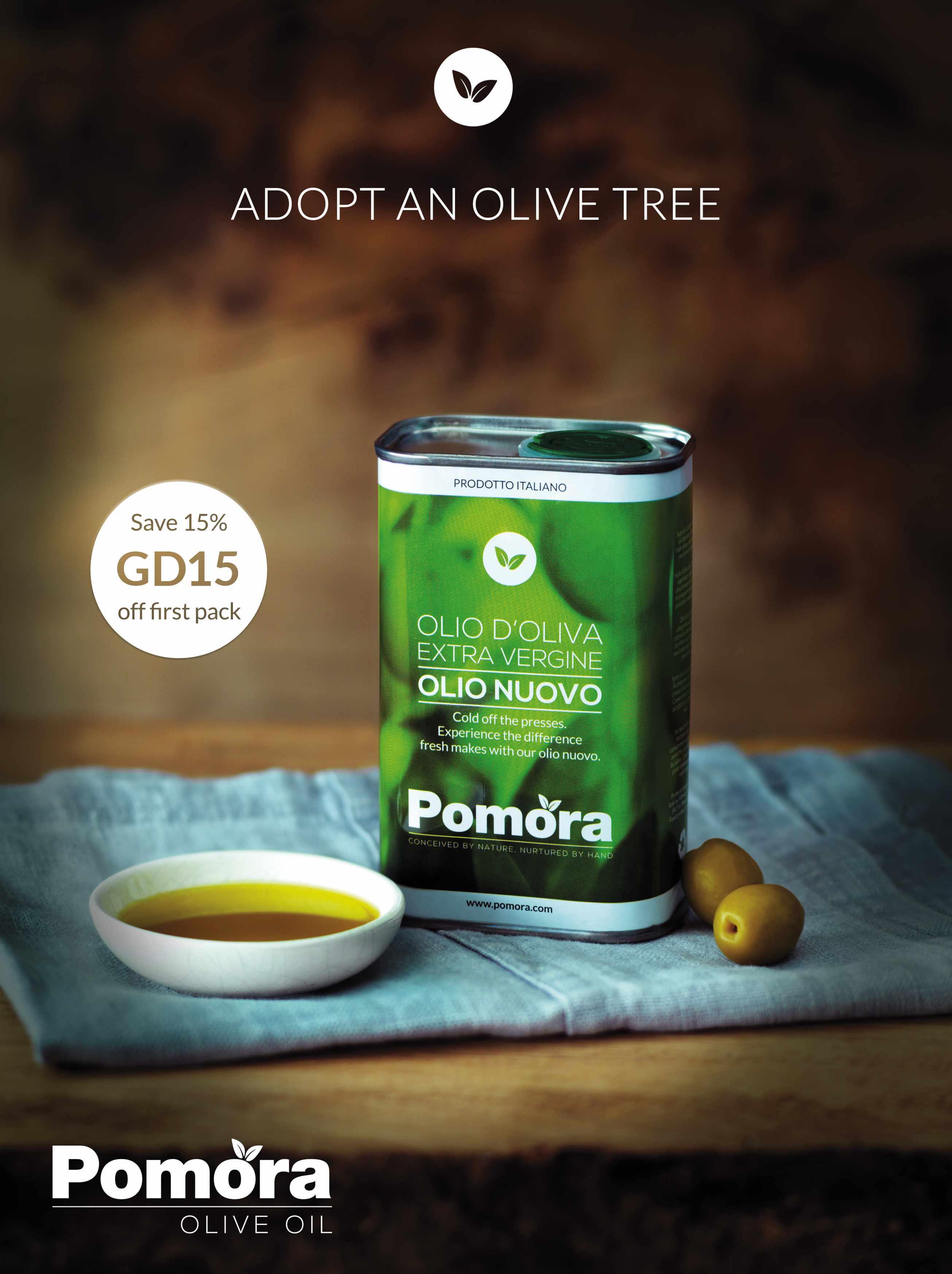
Book reviews, the crossword and Alice Vincent
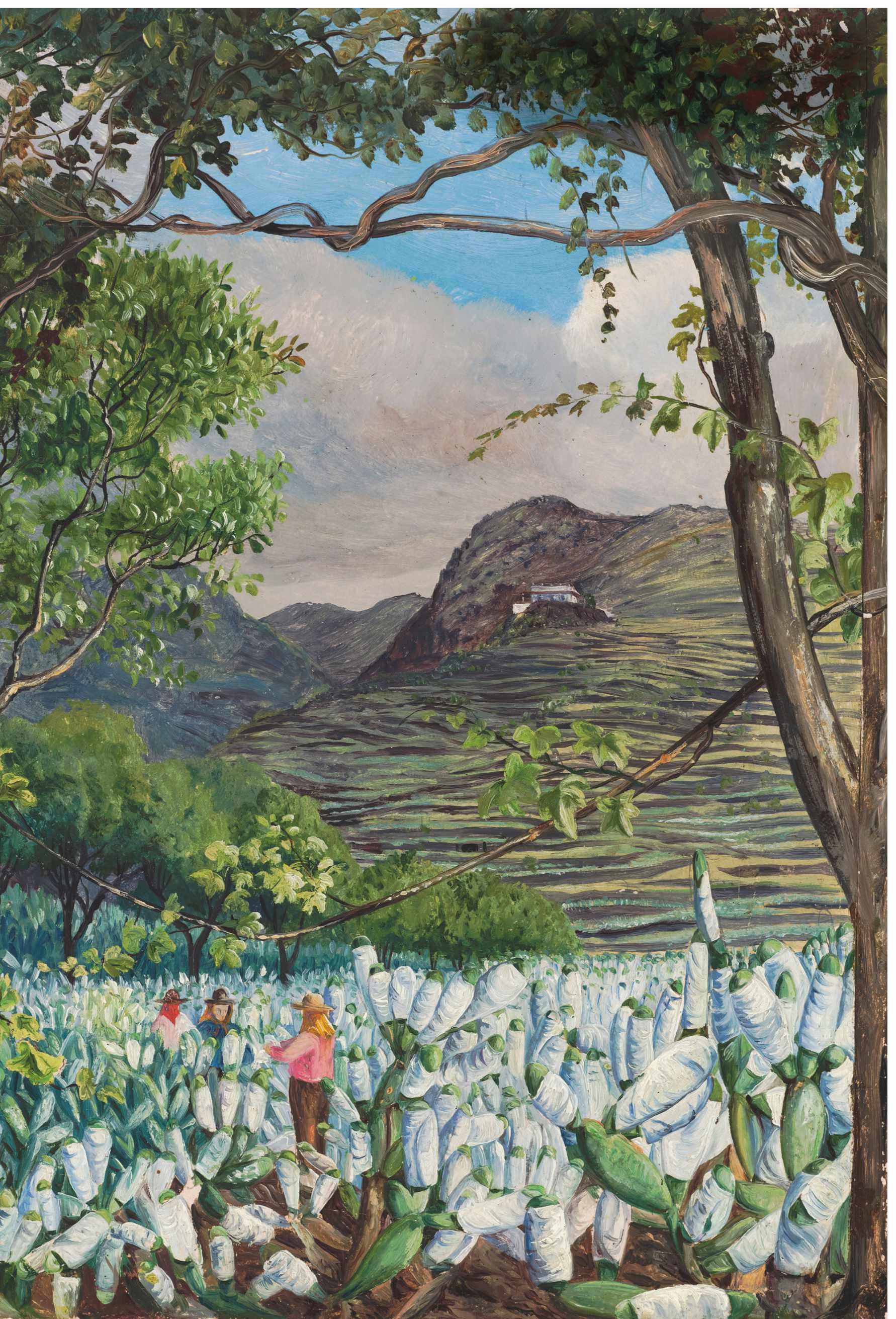
Marianne North’s painting View in the Cochineal Gardens at Santa Cruz shows hillsides cleared of native trees to make way for cacti terraces for cochineal production, and features in Marianne North’s Travel Writing, an unflinching look at the effects of empire on ecology, reviewed on page 105.
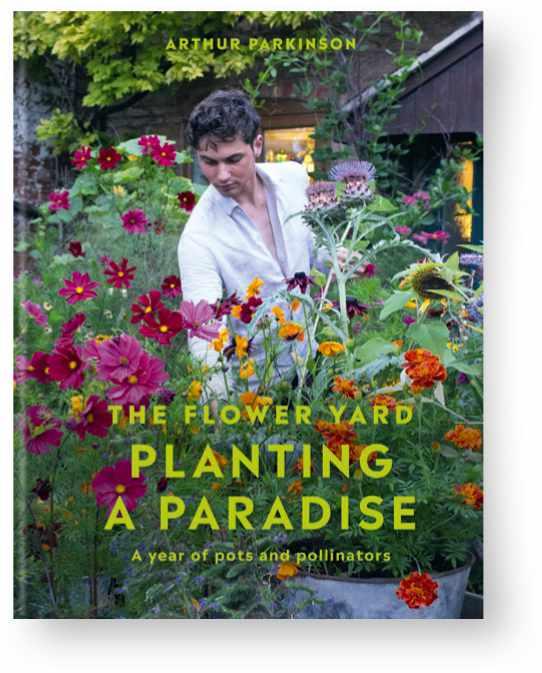
by Arthur Parkinson
K l B k £22

ISBN 978-1914239670
An engaging and personal seasonal guide to planting a container garden, with an emphasis on attracting birds and pollinators.
Reviewer Harriet Rycroft is a gardener and container gardening author.
Gardener and florist Arthur Parkinson’s ‘favourite floral personalities’ guide us through the seasons in the main chapters of this book, including the richly coloured tulips, dahlias, sweet peas and cosmos that have become very much associated with him. Parkinson is an enjoyably opinionated writer, not afraid to be sweary about issues that get his goat (plastic gardens and pesticides among them).
Most of the book is discursively written, touching on wildlife gardening or digressing into television programmes at will, but there are plenty of boxes full of bullet points for readers who prefer to dip in and out. There is sound advice aplenty in both. It is always a privilege to see another gardener’s thought processes, whether you agree with all of their methods or not, especially when that gardener is writing from experience rather than from research, as this one is.
The large and luscious photographs are Parkinson’s
own and give a sense of how immersed he likes to be among his plants and how well he knows them. He paints a good word picture too – his other great love (birds, both domestic and wild) creeps into his imagery; thus the flamboyant Crocus balansae ‘Orange Monarch’ ‘…will sing out on dull days like canary beaks’.
Finally there is a calendar of ‘yearly rituals’ that will be helpful to many. I find it a little strange, however, that a large book on container gardening does not say more about watering, a simpleseeming task that few people do well. The focus is on planting and though the author’s palette is evolving, much will be familiar to readers of his previous book, The Flower Yard. He tells us that he is talking about the plants he knows and loves, which is fair enough, but he has such enormous flair and enthusiasm, I’d love to see what he could do with a wider range of textures and colours.
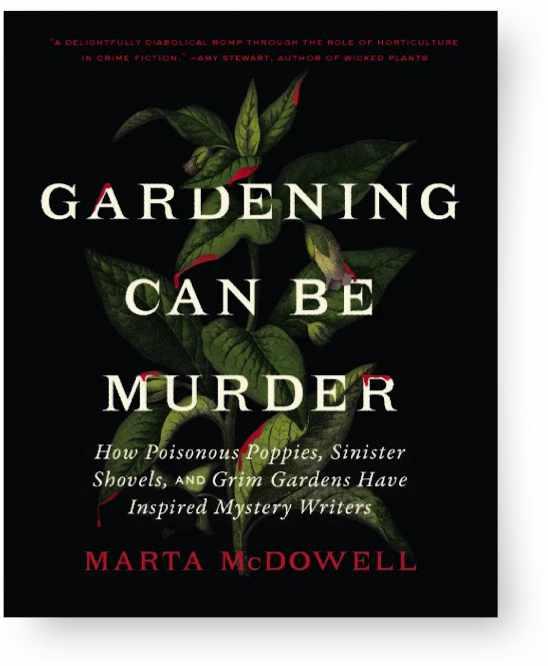
GARDENING CAN BE MURDER: HOW POISONOUS POPPIES, SINISTER SHOVELS, AND GRIM GARDENS HAVE INSPIRED MYSTERY WRITERS by
Marta McDowell
Timber Press, £25
ISBN 978-1643261126
Murder and mystery in garden settings may seem incongruous but it’s worth following the line of inquiry to get the low-down on garden crime scenes.
Reviewer Barbara Segall is a garden writer, author and herb enthusiast.
I am not sure whether I am channelling my inner garden murderer or my inner garden detective, but both have been exercised in equal measure by Marta McDowell’s Gardening Can Be Murder. My inner assassin is close to the surface as pigeons, snails, slugs and aphids bring out the worst in me on a fairly regular basis. And of course a garden is a place where accidents can happen – think rakes, knives, spades and so on. But actual murder?
I learned much about the literary history of garden sleuthing as well as how garden murder might be achieved. In Chapter One, Gardening Detectives, Wilkie Collins is cited as the first author to offer a horticulturally inclined detective in The Moonstone. And throughout there are interesting links to the garden history that threads through the various mystery tales described.
Without revealing too much of individual plots and particularly avoiding denouements, each chapter
looks at the various headings that any amateur sleuth would list for crime-solving: Setting, Motive, Means, Clues and Suspects – the basics of the police procedurals that fill our TV screens. Here the means are sharp weaponry, aka garden tools, and poisonous plants. Particularly interesting is the chapter titled Mystery Writers and their Gardens, although with the exception of Agatha Christie, the chosen writers are probably better known in the USA. Mentions of horticultural detectives and the books they appear in abound and are backed up in a comprehensive book list. Quotes amplify the text and are satisfyingly attributed and listed in Sources and Citations, and a comprehensive index covers plants, garden luminaries, and horticultural mystery writers and their books.
The author’s knowledge of, and enthusiasm for, garden murder settings, weaponry, poisonous plants and motives is infectious… I am off to see what I can kill in the garden today.
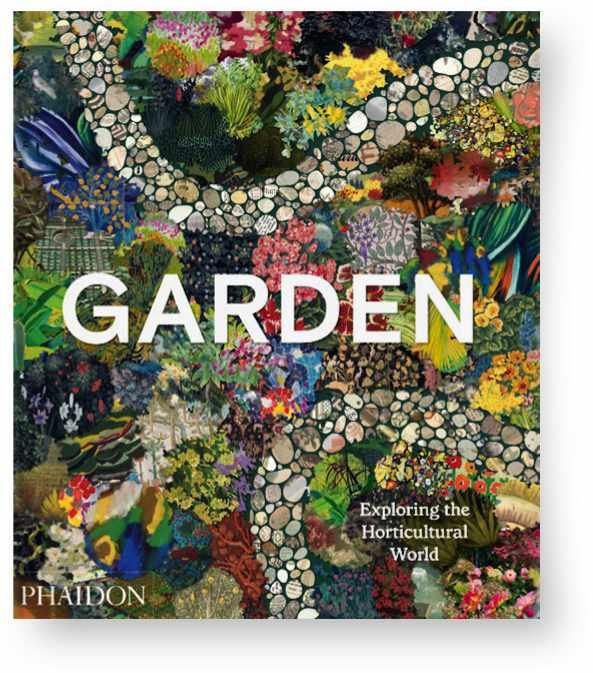
by Phaidon Editors
Phaidon, £44.95
ISBN 978-1838665975
Reviewer Stephanie Donaldson is a freelance garden writer.
When the postman staggered to the front door carrying this huge book my heart sank.
Weighing in at over two-and-a-half kilos and of equally large dimensions, it required considerable upperbody strength just to heave it on to my lap. Opening its vibrantly colourful, textured cover, I was apprehensive about the contents. What is there to say about such a coffee-table book? Of course the images would be beautifully reproduced, but what would it offer beyond that?
I’m delighted to report that I was by turns intrigued and entranced. Each spread features images that bear some relationship to one another, sometimes apparent, sometimes requiring closer examination, or even careful reading of the accompanying text to understand how they relate. It is a horticultural treasure hunt.
The illustrations are hugely diverse – sculptures, paintings, drawings, tapestries, murals, photography, etchings, prints,
products and even the occasional jewel sit alongside one another, each, in some way, enriching the other.
A single spread can cover centuries or even millennia – a Florentine Herbal from 1577 sits alongside an Australian First Nation artist’s 2019 painting of bush medicine plants, while a 2017 Fergus Garrett mind map from Great Dixter faces a Letts Gardener’s Notebook from 1890. The 1942 RHS pamphlet The Vegetable Garden Displayed is accompanied by Peter Rabbit (1902) feasting on the produce of just such a garden.
Great care has gone into the selection of the images –deciding on the relationships of one to another must have been a monumental task. But this is not just a book filled with great pictures; the writing is an essential component, and once you have done an initial exploration of its pages, it is an engaging and informative read – although a Heath Robinsonstyle device (yes, he is also featured) might be useful to take its weight!


MARIANNE NORTH’S TRAVEL WRITING: EVERY STEP A FRESH PICTURE b M h ll P e
Kew Publishing, £28
ISBN 978-1842467954
A richly illustrated travelogue that aims to shine new light on the pioneering English biologist and artist Marianne North.
Reviewer Katy Merrington is cultural gardener at Hepworth Wakefield.
Standing in the Marianne North Gallery at Kew Gardens is an extraordinary experience – more than 800 oil paintings shine out glossily from dark, black frames. Arranged in geographical order, each picture abuts its neighbour firmly, covering the walls with separate scenes of landscape, flower and foliage. North painted each work on location, travelling the globe through networks of empire to bring home dramatic images that Victorian London had not seen before.
A wealthy, tenacious woman, Marianne North (1830-1890) was in her forties when she set out on her first big solo quest to travel and paint. She rejected Victorian standards of botanical illustration, which mostly isolated single plant specimens against blank backgrounds. Instead, she sought to communicate the context – to capture plants within their natural communities and amid man-made settings.
This book presents excerpts from North’s writing, alongside her beautiful artwork, and
seeks to supply new background to her life and work, in much the same way that her paintings provide background to the plants.
I was intrigued to read the words of the painter herself; I wanted to hear her experience as a woman and to get a sense of her creative process. However, these are not North’s priorities when composing her journal and letters. Her writing has a similar consistency of voice to her paintings; it is tonally brisk as it whisks you through the people and places she visits.
Where the book becomes meaty is in its frank eyewitness account of a voyage through the British Empire. It doesn’t excuse nor deny North’s periodically disturbing comments on the enslaved and indigenous people that she meets. Where her lack of empathy towards others can be stinging, her analysis of the damaging effects of empire on ecology is remarkably forward thinking, and so a candid and complex portrait of North emerges.

THE ESSENTIAL TREE SELECTION GUIDE: FOR CLIMATE RESILIENCE, CARBON STORAGE, SPECIES DIVERSITY AND OTHER ECOSYSTEM BENEFITS by Henrik Sjöman and Arit Anderson
Filbert Press, £50
ISBN 978-1739903947
A much-needed and in-depth guide to choosing trees based not only on their appearance but also their resilience to climate change.
Reviewer Joe Perkins is a garden and landscape designer.
I’ve been waiting for something like The Essential Tree Selection Guide for some time. It has a great sense of ambition: to provide us, by which I mean mainly specifiers, with some of the tools needed to make informed choices on tree selection for future resilience – not least the most appropriate species for adapting to the potentially extreme growing conditions they will face, particularly in our urban centres. This is unusual in that the majority of tree and shrub guides to date have tended to focus more narrowly on ornamental, aesthetic attributes.
Aside from being invaluable for professionals, this book will be a useful and insightful guide for enthusiasts, amateur gardeners and people with a keen interest in understanding climate, climate change and the functioning of our ecosystems, albeit perhaps a little too detailed for the general public.
There’s a wealth of information within, beginning with a section on Ecosystem Services (the benefits trees can
provide); through my favourite section on Understanding Trees, which is both scientific and enlightening, and where we learn how trees function, grow and tolerate a range of adverse conditions; to the comprehensive directory of tree genera and selection tables. What sets the directory apart is the accessibility of information: native habitats and growing conditions, crucial for understanding the potential of a particular tree for use in a UK landscape or garden setting, is given alongside particular intolerances or abilities to adapt. The description of the humble Elaeagnus as a versatile and valuable street tree was for me a particular eye-opener.
Above all, it is the authors’ considerable combined experience that enables us to look at these complex organisms in a rather different way from how we have approached them in the past. It is refreshing to begin to understand how, through informed selection, we can support them, and how, in turn, they will support us.
Gain new perspectives on evolutionary botany, indigenous plants and garden design in this month’s pick of other titles.
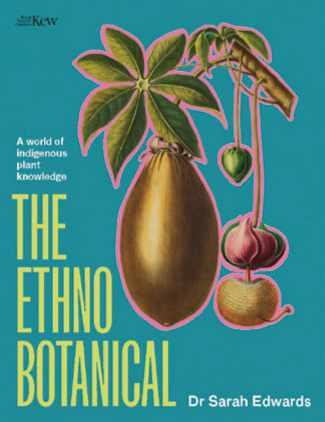
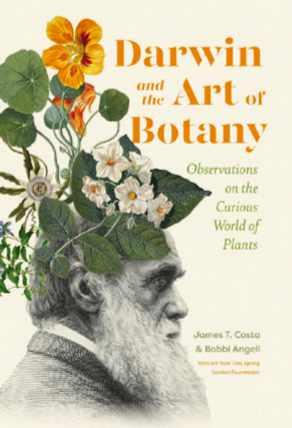
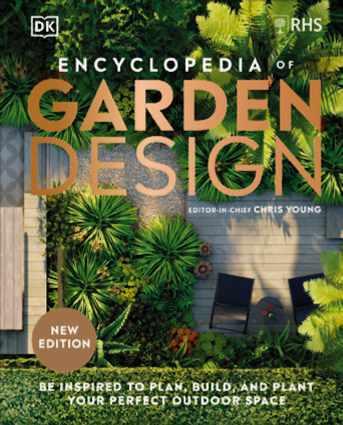
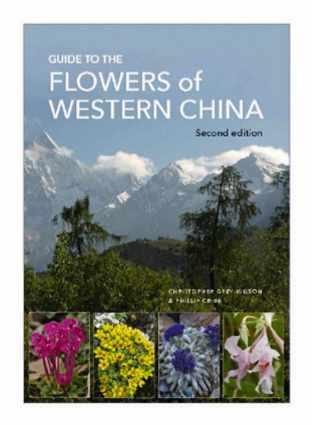

THE ETHNOBOTANICAL: A WORLD OF INDIGENOUS PLANT KNOWLEDGE by Dr Sarah Edwards Greenfinch, £30
ISBN 978-1529427400
Looks at the medical, magical and marvellous histories of plants from around the world.
DARWIN AND THE ART OF BOTANY by James T Costa and Bobbi Angell Timber Press, £25
ISBN 978-1643260792
Writings from six texts devoted entirely to the curious world of plants, paired with beautiful botanical art.
RHS ENCYCLOPEDIA OF GARDEN DESIGN
Editor-in-chief: Chris Young
Dorling Kindersley, £30
ISBN 978-0241593387
A new edition of this practical guide to garden design. Includes planning, landscaping, plant choices and more.
GUIDE TO THE FLOWERS OF WESTERN CHINA by Christopher Grey-Wilson and Phillip Cribb
Kew Publishing, £70
ISBN 978-1842467961
Revised and updated edition of this essential companion to the region, with new data and photographs.
RHS HOUSE PLANT: PRACTICAL ADVICE FOR ALL HOUSEPLANTS, CACTI AND SUCCULENTS
Dorling Kindersley, £20
ISBN 978-0241634165
More than 330 houseplant profiles, along with essential care and propagation advice to help you grow your collection.
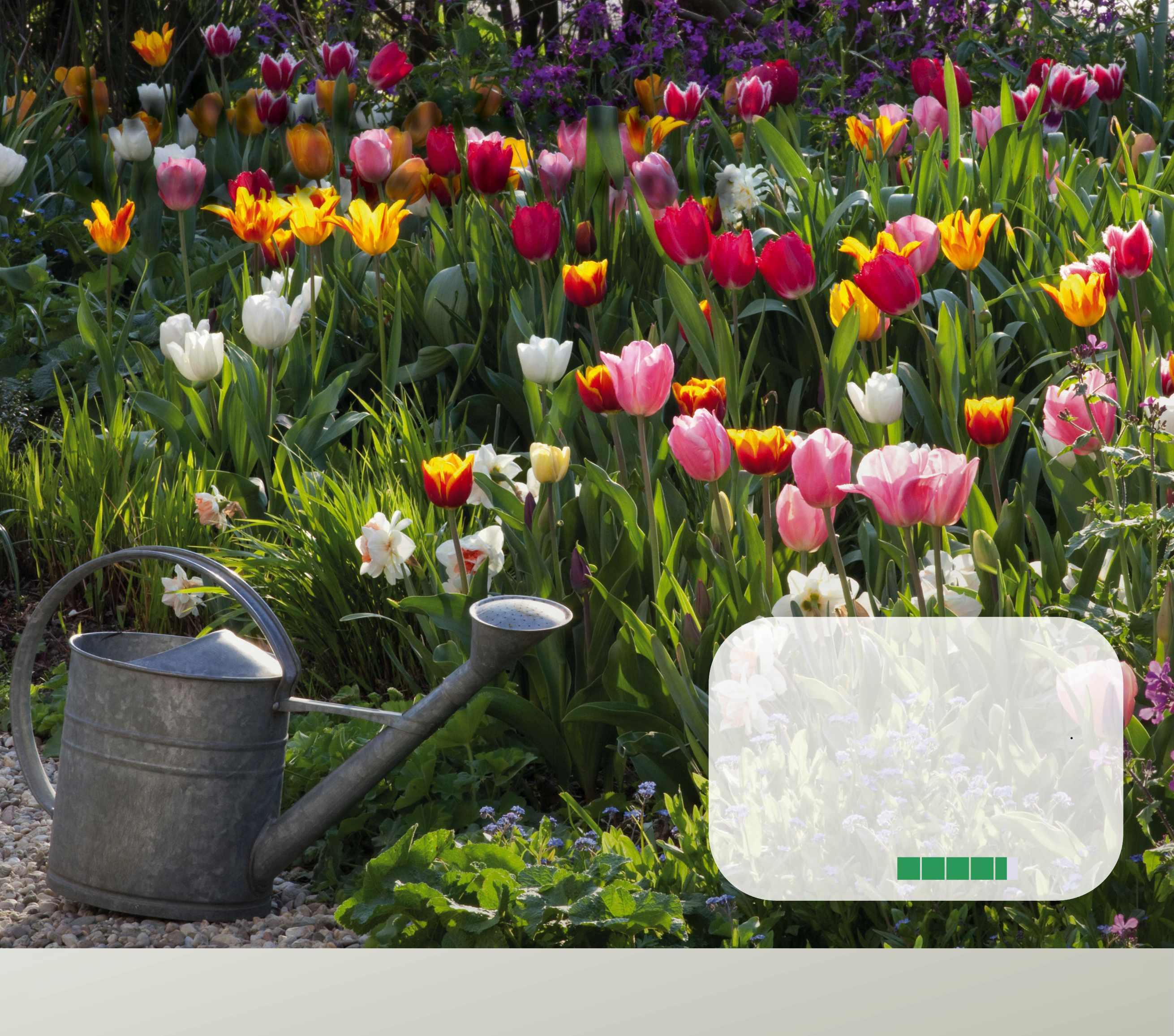

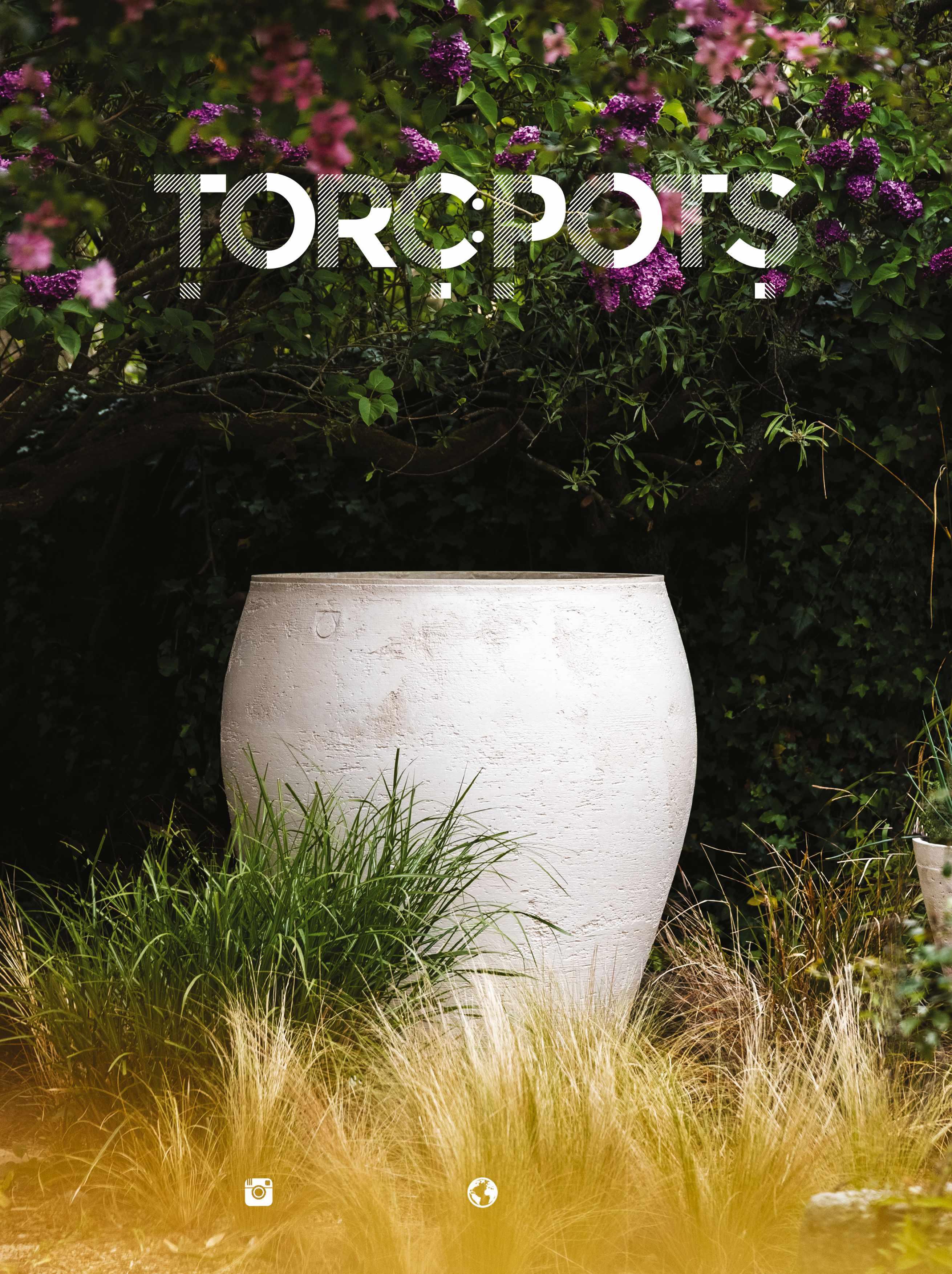

ACROSS
1 A royal-blue gentian hybrid with white striations; also a Highland Games venue (7)
5 Staple cottage-garden plant with exploding seedpods … part global samphire (6)
8 Burgundy-flowering hellebore in Spring Promise Series; ___ de Thame, TV gardener (6)
9 Genus of plants commonly called speedwell (8)
10 An ash tree’s winged fruit –essential (3)
11/12 A creamy iris with blue-spotted yellow falls – ‘Polaris’? (5,4)
13 Hydrangeas with flat heads of tiny central flowers in a ring of showy florets (8)
15 Emphasise: a plant may suffer this if grown in poor conditions (6)
17 Tutu-like parts of fuchsia flowers hanging beneath sepals (6)
19 Yellow-flowering (non-culinary) herb, wildly roaming at end of shrubbery (8)
21 Latin species epithet meaning ‘white’ … in annual barberry (4)
23 Heart removed … from Granny Smith, say? (5)
24 The genus of meadow grass … OAP confused! (3)
25 Bulbous root vegetable, genus Apium – cold, rice ale mixture (8)
27 Eg thickets of plants or clods of soil (6)
28 A story about the hop-hornbeam’s genus (6)
29 Genus of yellow ox-eye daisy – like tea variety (7)
DOWN
1 Dark-flowered agapanthus, Chelsea Flower of the Year 2023; a casino card game (5,4)
2 A deep-pink, crimson-hearted pelargonium – say HB, possibly (5)
3 The genus of moor grasses – main oil production (7)
4 If a variegated plant ____, its leaves become plain green again (7)
5 Flogs trees of Betula genus! (7)
6 A vigorous, early-flowering snowdrop … found in deadly nightshade (3)
7 Hollyhock genus – a lace variety (5)
12 Cut grass in awkward place: street edge (5)
14 japonica, a white-flowering Asian shrub – held by amateur, Yarmouth (5)
16 Genus (formerly Helipterum) of white ‘everlasting’ flowers – makes pansy arch (9)
18 pratensis, devil’s-bit scabious –sort of capsicums MP removed! (7)
19 Prunus armeniaca fruit – might be associated with brandy (7)
20 Fundamental … little root, it’s said (7)
22 Onion relatives – house ones are sempervivums! (5)
24 Detach a fruit from its stalk? Courage! (5)
26 Common name of Alocasia is ‘elephant’s __’ (3)
• Solutions to this issue’s crossword will be printed in the November
You can buy printed issues of the magazine published up to six issues ago at buysubscriptions.com or see below for details.
Save money when you subscribe to the digital edition –see page 28



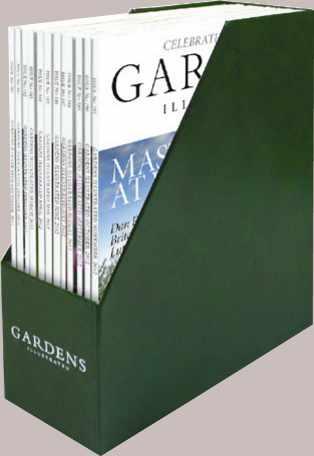
Cost from £9.99 each (inc p&p). Subscriber discounts available – see below for details.

Autumn is a great time to visit this collection of glorious gardens

1
Autumn is the season when Hever’s striking trees come to the fore. Colour abounds with vivid maples and brilliant beech. Boston ivy scrambles up the Castle walls, while Vitis coignetiae clothes bridges and pergolas with crimson. Visit on a still day for the very best views of reflections in the moats and lake. Hever, Edenbridge, Kent TN8 7NG | 01732 865224 | hevercastle.co.uk
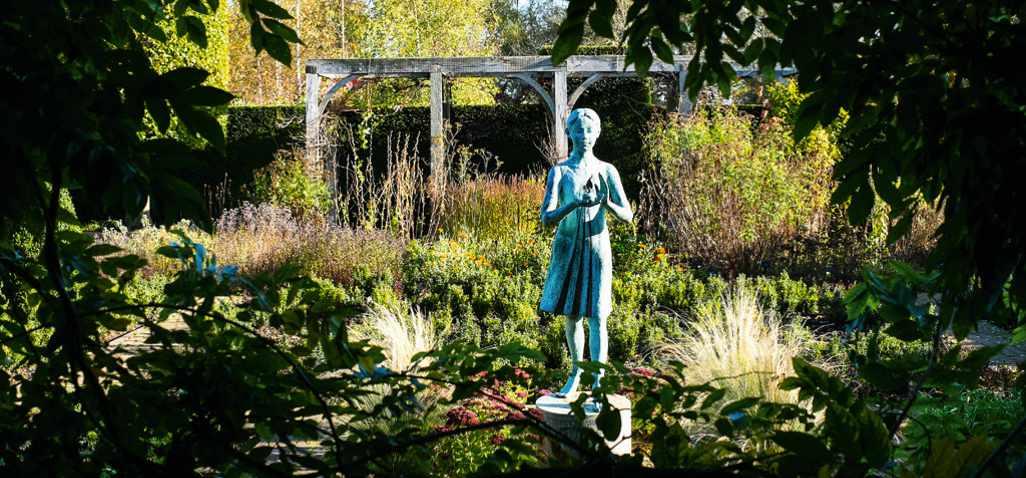
2
A place to explore, relax and shop in beautiful surroundings. The gardens are ablaze with colour over the crisp autumn months. Shades of gold and red on shrubs and trees surrounded by chilly, blue skies! Halloween trail for children 21 October to 5 November (£3pp), and we also have Grounddog Day 12 November, 10am-5pm. Nr Wheatley, Oxfordshire OX33 1LA | 01844 339254 | waterperrygardens.co.uk
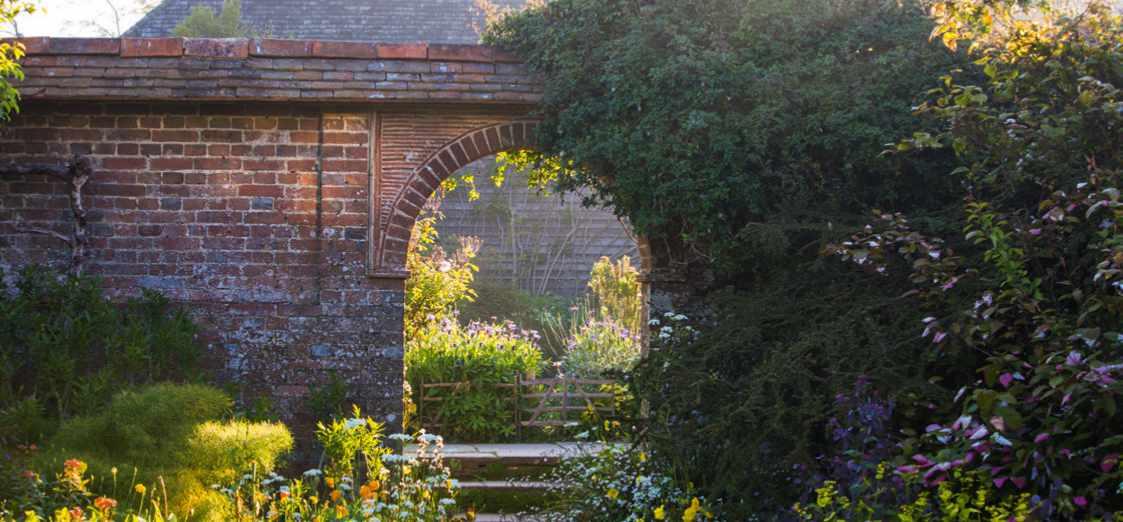
4
GREAT DIXTER HOUSE & GARDENS
Nestled in the East Sussex countryside is a garden that inspires horticulturists across the world as it marries the natural with the gardened. Wander the swathes of wildflower meadows before stepping into this multi-layered garden, which provides interest throughout the year and mixes the exotic with the conventional. Northiam, East Sussex TN31 6PH | greatdixter.co.uk


3
Explore the enchanting 20-acre woodland garden with hidden sculptures and enjoy a fantastic display of autumn colour. Experience the unique 120-year-old avenue of maples which burst into life with coppery orange and vibrant reds. Open 10am-5pm until 12 November (Thursdays, Fridays & Weekends). Tea House on site. Chiddingfold, Surrey GU8 4SN | ramsterevents.com
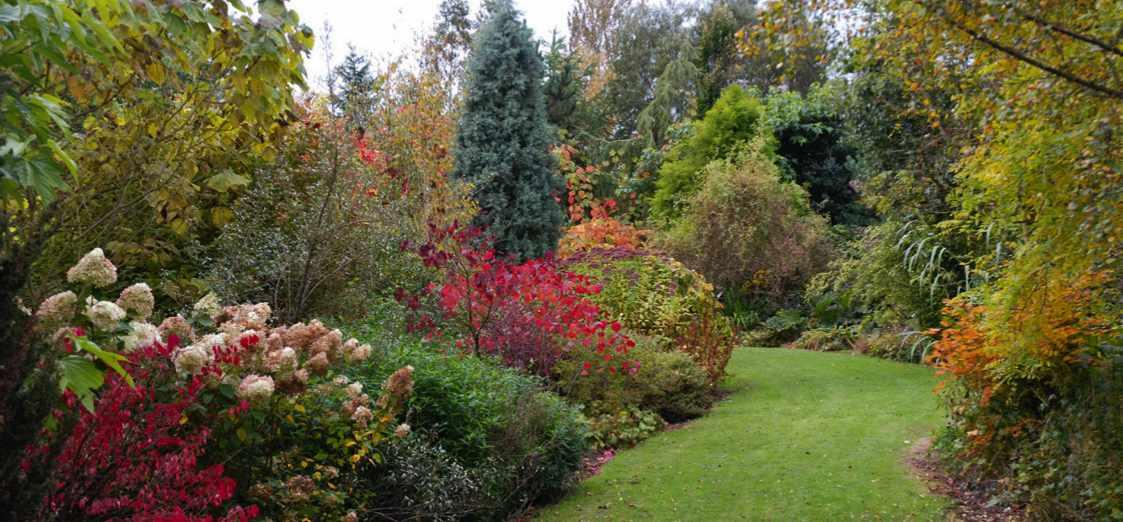
5
BLUEBELL ARBORETUM & NURSERY
Visit our tranquil, nine-acre, woodland garden full of unusual trees and shrubs, many of which have been planted for their superb autumn colours. Many of the rarities on display are available for sale from our adjoining specialist plant nursery. RHS Partner Garden.





• Geometric structure meets soft planting in the rural garden of Cristina Mazzucchelli
• A man-made mountain stream brings sound and movement to a modern rock garden
• Late-season perennial planting lifts a contemporary house in southern Australia
• Classic structure and autumn colour create a feeling of quiet calm in a Cumbrian garden
• PLUS Trees for the future and expert sweet pea tips
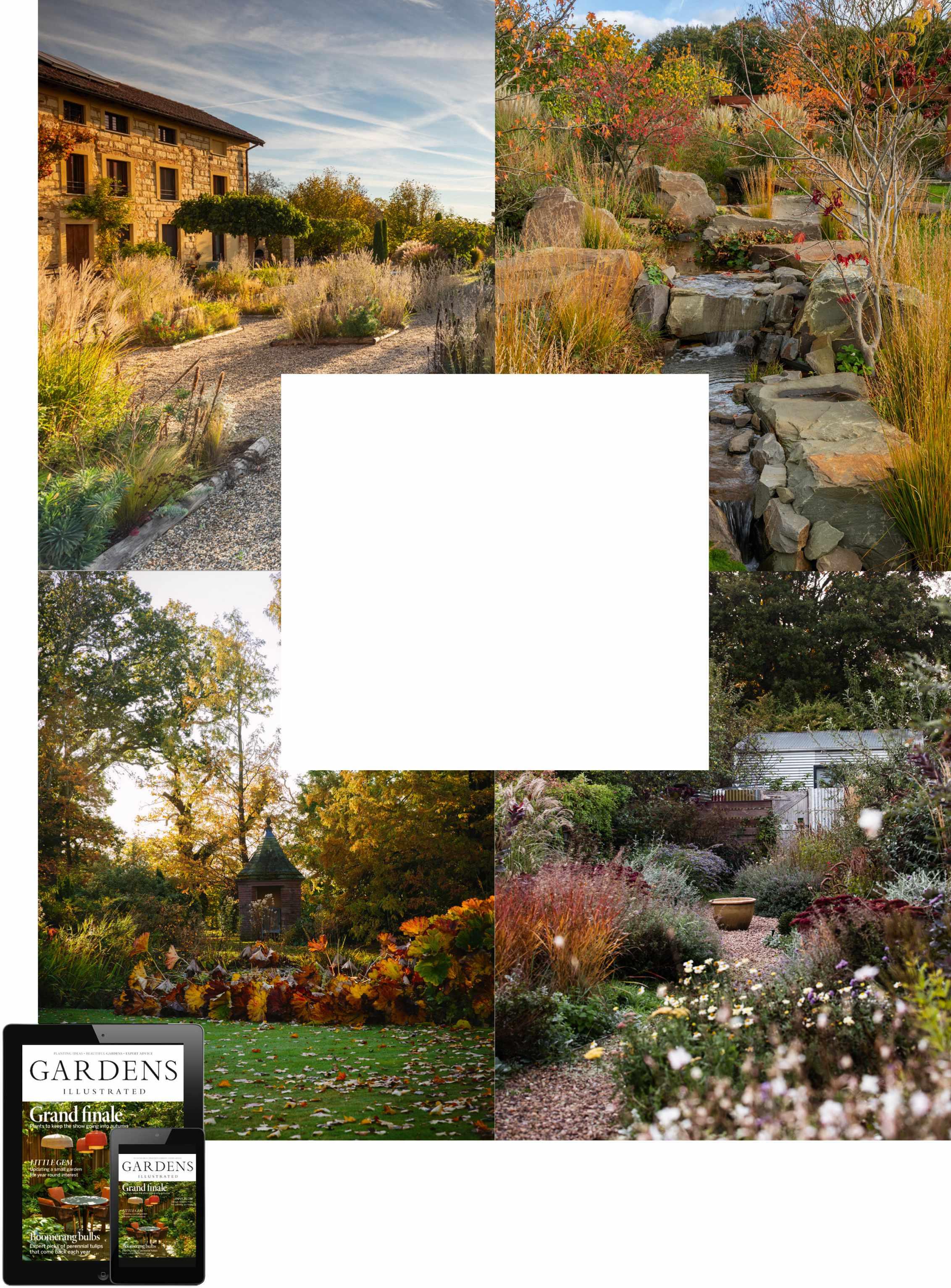
Save money when you subscribe to the digital edition – see page 28. Also in selected Waitrose, Sainsbury’s and Tesco stores, as well as WHSmith, and all good magazine retailers.
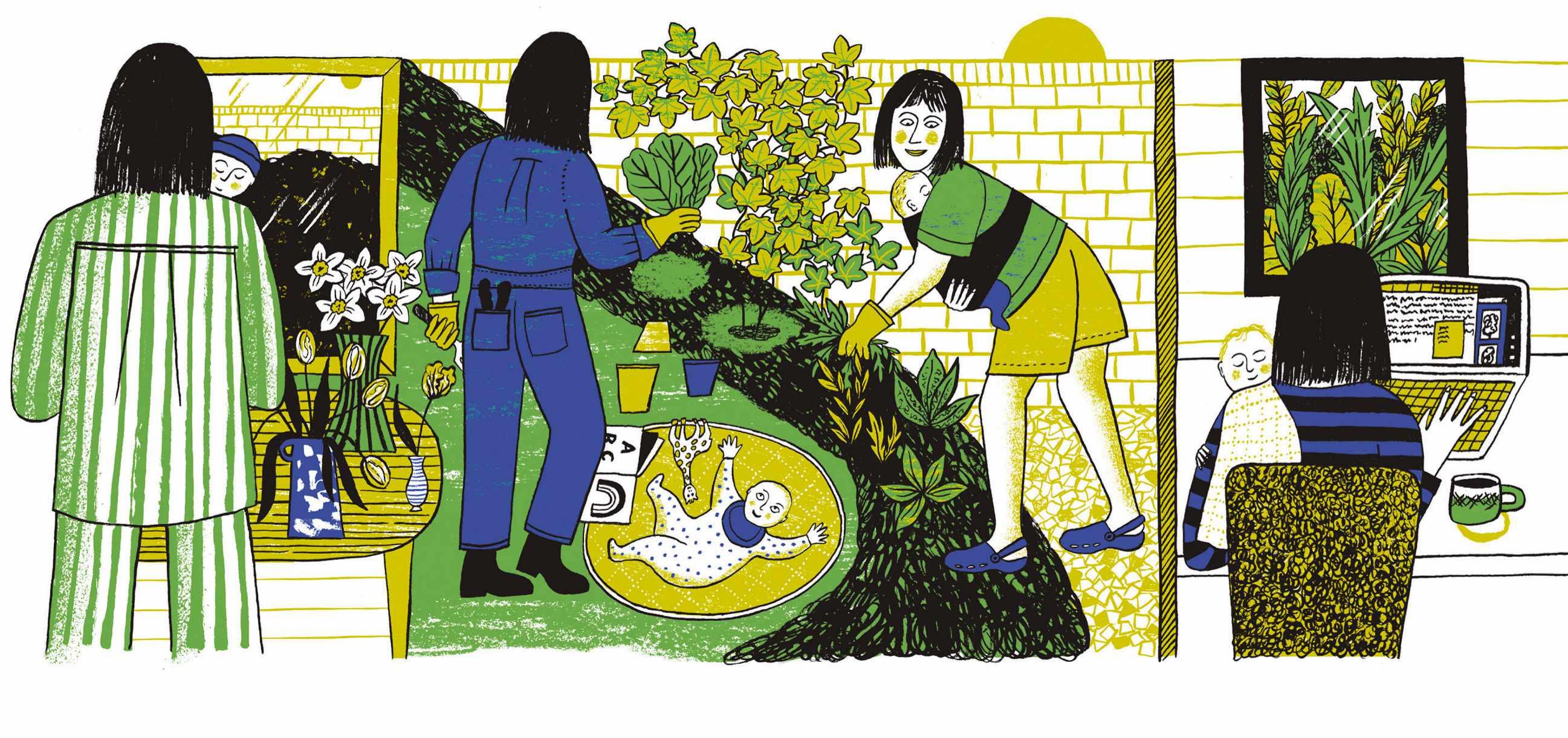
With a young baby in tow, there are changes afoot for Alice Vincent as she looks at her garden, and her ways of gardening, with fresh eyes
ILLUSTRATION ALICE PATTULLO
The contractors arrived when the baby was three weeks old. I cut all the tulips and narcissi that were in, or about to, bloom and filled the kitchen table up with vases. Then I stood at the kitchen window, newborn slung around my body, and watched as the garden I’d spent nearly three years making was unearthed into a mountain of soil.
Perhaps the timing was mad, but it made sense to me: I wanted the garden to work for this new phase of my life. I wanted somewhere to sit in dappled sunlight with the baby. I wanted flowerbeds that would look cohesive, with a limited plant palette that was straightforward to maintain. I needed a space to write in, now that the baby slept where my desk used to sit. I admitted that having a lawn was probably a good idea. The baby was tiny. My body was still healing. My garden was having its own kind of rebirth.
We didn’t have the kind of balmy, laid-back summer I envisaged when I thought I’d be sitting outside with him, but I am writing this in the garden studio – and he’s still slung around my body, asleep if considerably heavier. Five months in and the most I’ve learned about gardening with a baby is that it must happen in snatches.
He was small and conveniently immobile when the heatwave struck, and as he lay on a playmat or sat in a bouncer on the lawn, I’d manage 40 blissful minutes nearby – perhaps cutting back the ivy I should have attended to weeks earlier, or planting up the bare new beds. Deadheading was done after bedtime, and I enjoyed the meditative pause of it as I shook off another day of jiggling and feeding and playing and singing. I’d weed with one hand, his body curled against my other arm, a few square centimetres at a time.
I feel naive writing about motherhood and gardening – I’m pretty new at this whole thing, and I know from others that it soon becomes more challenging, when there are determined toddlers and, later, when ball games are involved. When I shared snippets of the new garden design on social media people were swift to point out all the challenges I had ahead of me: the baby would eat the gravel, the lawn will soon become a football pitch.
But what they didn’t tell me was how my garden would change in meaning. I had some expectations of this – I spent months interviewing women, some of them mothers, in and about their gardens for my book Why Women Grow – but the reality has, as with so many things to do with this
whole parenting lark, surprised me. I now undertake my morning inspections of the garden with him in tow; his body stills in wonder as he takes in the sounds and smells of the outside and encourages me to notice more, too. My garden has become a baby sensory playground; I clock the sky through the slats in the arbour, the dance of a hollyhock stem in the wind, the tickle of long grass in his tight little fists. Slugs are no longer just irritants, but something else to teach him about.
And yet, the garden is somehow still my space, for all that we must share it. It is out here that I claw back minutes to work, let the frustrated tears out and – one day, I hope – enjoy the steam from a cup of tea on a crisp, cool morning, alone. Babies don’t particularly need gardens – they can have as much stimulation in a park – but I’ve never craved mine more.
I suspect the years to come will see only more of this uneasy balance: how to enable curiosity and play at the expense of beloved flowers, how to impart my love of the outdoors without dictating his, how to sit back and release yet more control in a space I’ve created. But gardens hold things well, and grow into the new challenges we offer them. I hope I can do the same. ■

